Wir haben ein paar Tage gebraucht, bis wir uns in Kanada wieder richtig wohlgefühlt haben. Wobei, dass ja eigentlich so nicht ganz richtig ist. Wir fanden es von Anfang an atemberaubend. Gerade die ersten Tage in Waterton waren bei meist herrlichem Wetter großartig und landschaftlich sind wir tief (oder sagt man bei Bergen eher hoch) beeindruckt. Was uns ein wenig verwirrt hat, war die von uns empfundene Überregulierung – gerade in Alberta. Es gibt einige verschiedene Parksysteme mit verschiedenen Permit-Systemen – also das in Verbindung mit den zum Teil notwendigen Reservierungen haben uns (am liebsten recht planlos Reisenden) etwas überfordert. Was uns auch ein wenig verwirrt, ist, dass die Nationalparks hier teilweise eher Amusementparks sind (so empfinden wir es auf jeden Fall) – also nicht wirklich aus der Idee des Naturschutzes, sondern mehr zur Entspannung gestresster Stadtmenschen gedacht. Entsprechend große Menschenmassen werden durch die Hauptattraktionen Banff, Lake Louise und Jasper durchgeschleust. Doch inzwischen, wir sind gerade in Jasper, fühlen wir uns so richtig angekommen. Die Wander- und Fahrradmöglichkeiten sind endlos, das Wetter ist allermeistens fantastisch, die Natur großartig und wir genießen es einfach.
It took us a few days to really feel at home again here in Canada. Actually, that’s not quite right. We thought it was stunning from the start. The first few days in Waterton in particular were great, with mostly glorious weather and we are deeply (or rather highly) impressed with the landscape. What confused us a bit was the over-regulation we felt – especially in Alberta. There are a few different park systems with different permit systems – in connection with the sometimes necessary reservations, we (preferably quite haphazard travelers) were a bit overwhelmed. What also confuses us a bit is that some of the national parks here are more like amusement parks (that’s how we feel) – so not really with the idea of nature conservation, but more intended to relax stressed city people. Correspondingly large crowds are channeled through the main attractions of Banff, Lake Louise and Jasper. But now that we’re in Jasper, we really feel like we’ve arrived. The hiking and cycling opportunities are endless, the weather is mostly fantastic, nature is great and we just enjoy it.
Aber von vorne. Es geht echt gut voran durch die hügelige Prärielandschaft von Montana. Wir fahren über die US 2, der nördlichsten Ost-West Verbindung in Montana, und Ewald fliegt mit knapp 90 km/h nur so dahin. Es begegnen uns nur wenige andere Fahrzeuge und auch Behausungen sind rar. Eigentlich ist es ein wenig öde aber lustigerweise ist es uns nicht langweilig. Aber Langeweile ist uns eh ein Fremdwort. Ab und zu landen wir, so alle 100 km, in einem Ort, wie zum Beispiel Havre. Havre bietet als Touristenattraktion eine „Beneath the streets“ Tour an und da nehmen wir natürlich teil. Die Geschichte dahinter ist, dass im Jahre 1904 die gesamte Stadt abgebrannt ist und sich bis zum Wiederaufbau einige findige Unternehmer in den „Untergrund“ verzogen haben. In der Innenstadt wurden kurzerhand die Keller erweitert und miteinander verbunden und dort waren dann eine Bar, eine Fleischerei, eine Bäckerei etc. direkt neben dem Bordell mit 27 Betten in einem Zimmer (!) und der an die chinesische Wäscherei angeschlossene Opiumhöhle. Sehr Interessante Mischung und wir wollen uns gar nicht so genau die Gerüche, Geräusche und Beengtheit in der Zeit vorstellen.
Now from the beginning. It’s going really well through the hilly prairie landscape of Montana. We drive west over US 2, the northernmost east-west connection in Montana, and Ewald just flies along at about 55 mph. We meet only a few other vehicles and towns are rare. Actually it’s a bit dull but funnily enough we’re not bored. But boredom is a foreign word to us anyway. From time to time we, about every 65 miles, end up in a town like Havre. Havre offers a “Beneath the Streets” tour as a tourist attraction and of course we take part. The story behind it is that in 1904 the entire city burned down and a few resourceful entrepreneurs went “underground” until it was rebuilt. Downtown, the cellars were quickly expanded and connected with each other and there was a bar, a butcher, a bakery, etc. right next to the brothel with 27 beds in one room (!) and the opium den connected to the Chinese laundry. Very interesting mix and we don’t even want to imagine the smells, sounds and confinement in that time.
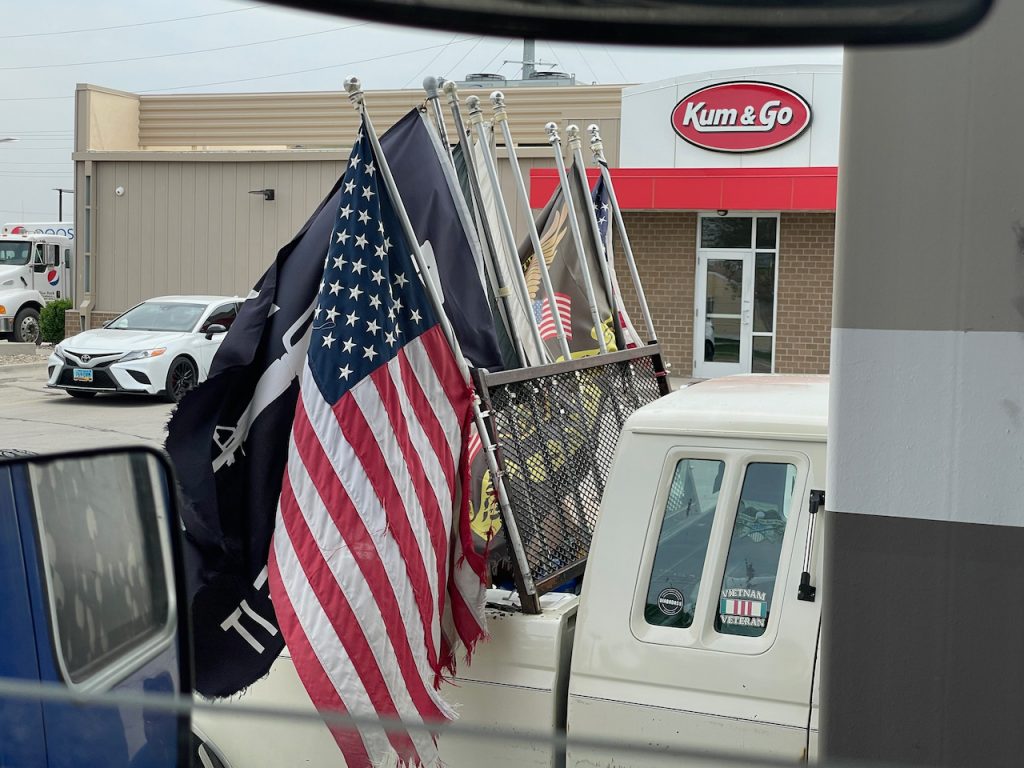
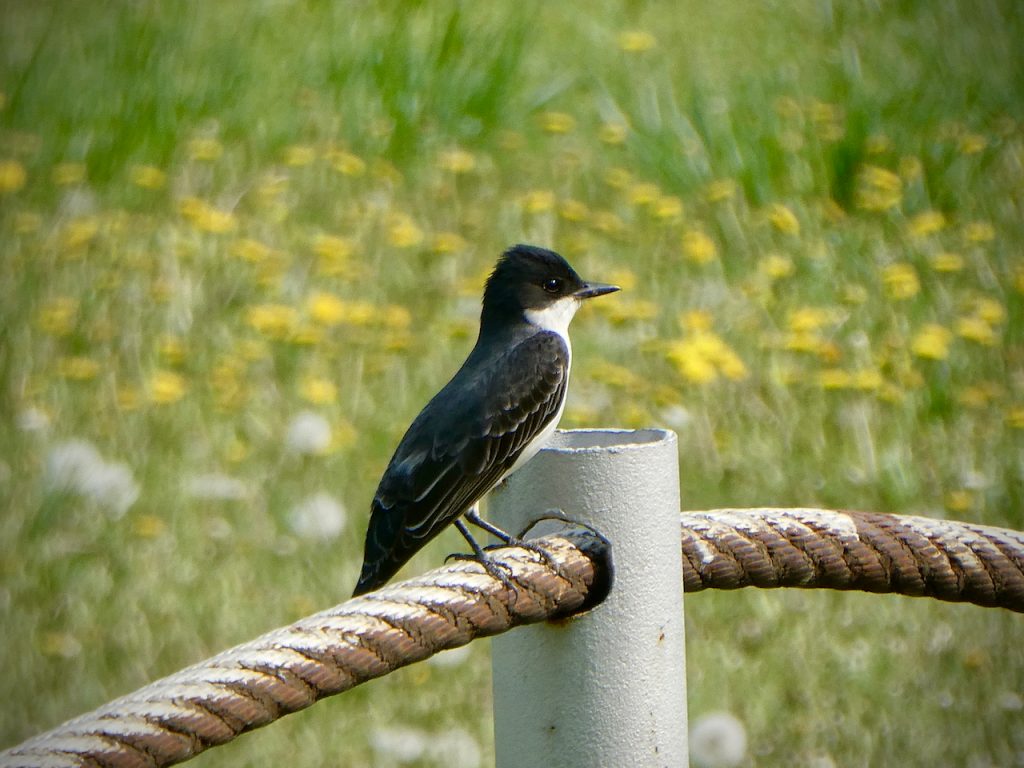
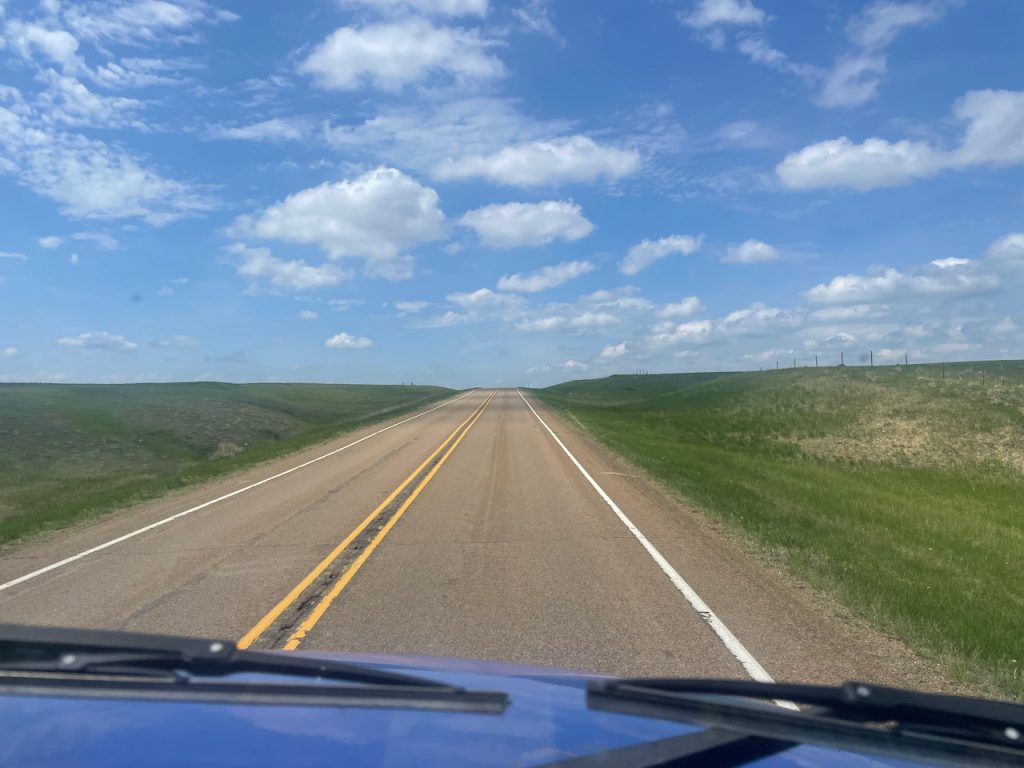
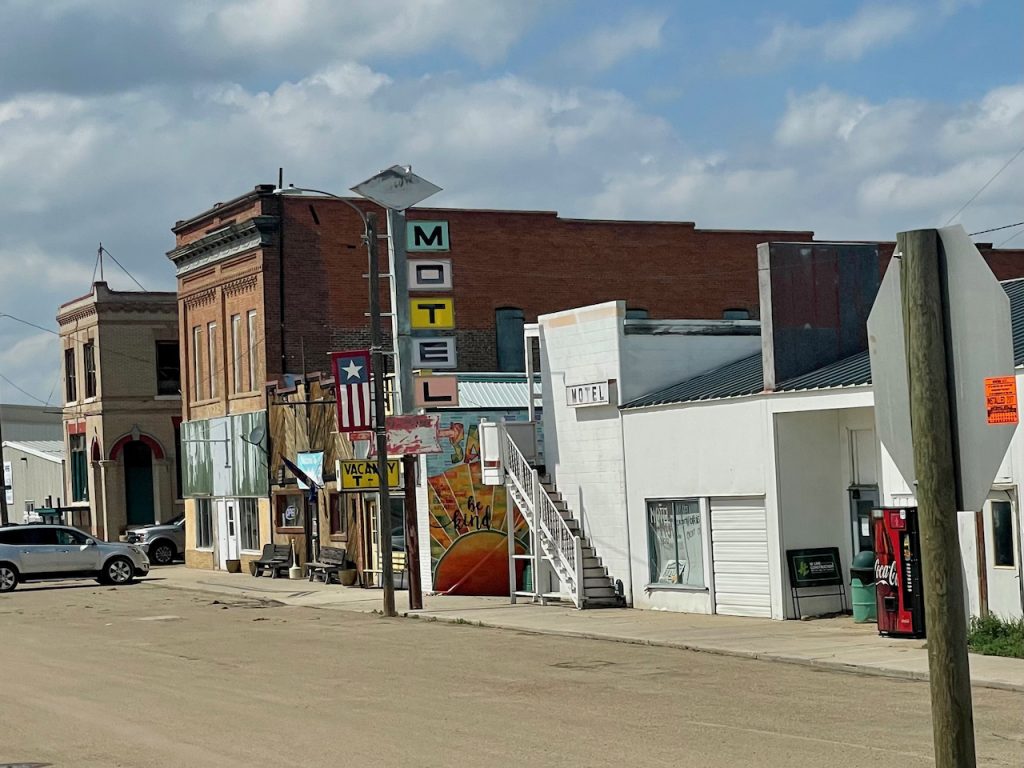
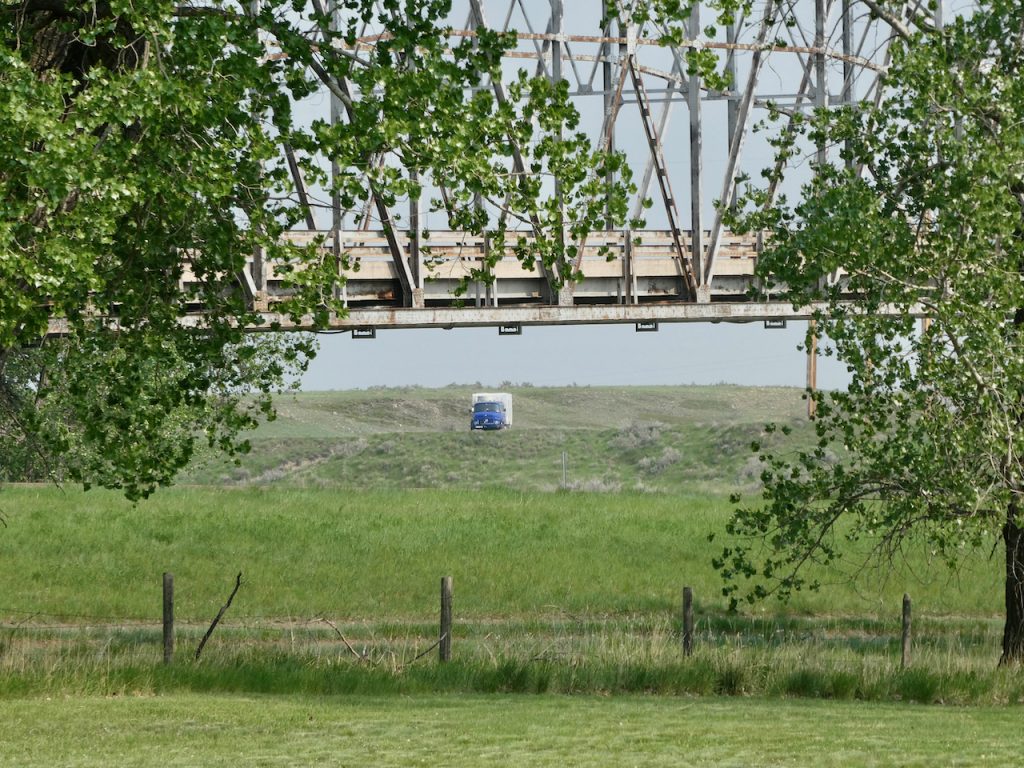
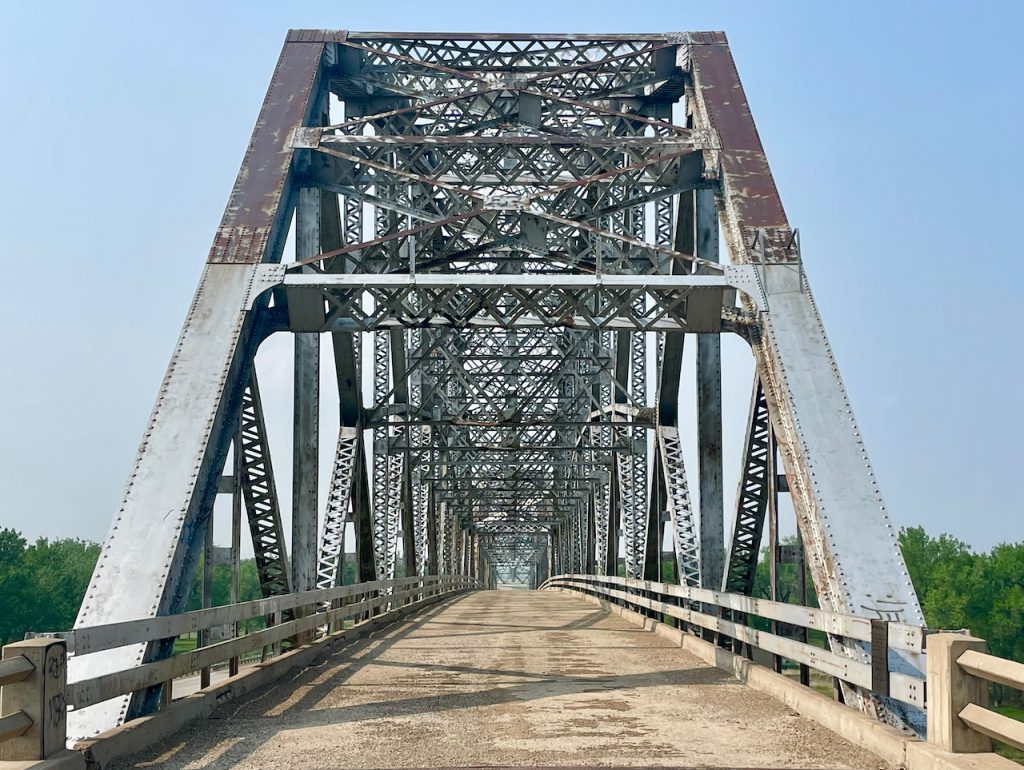
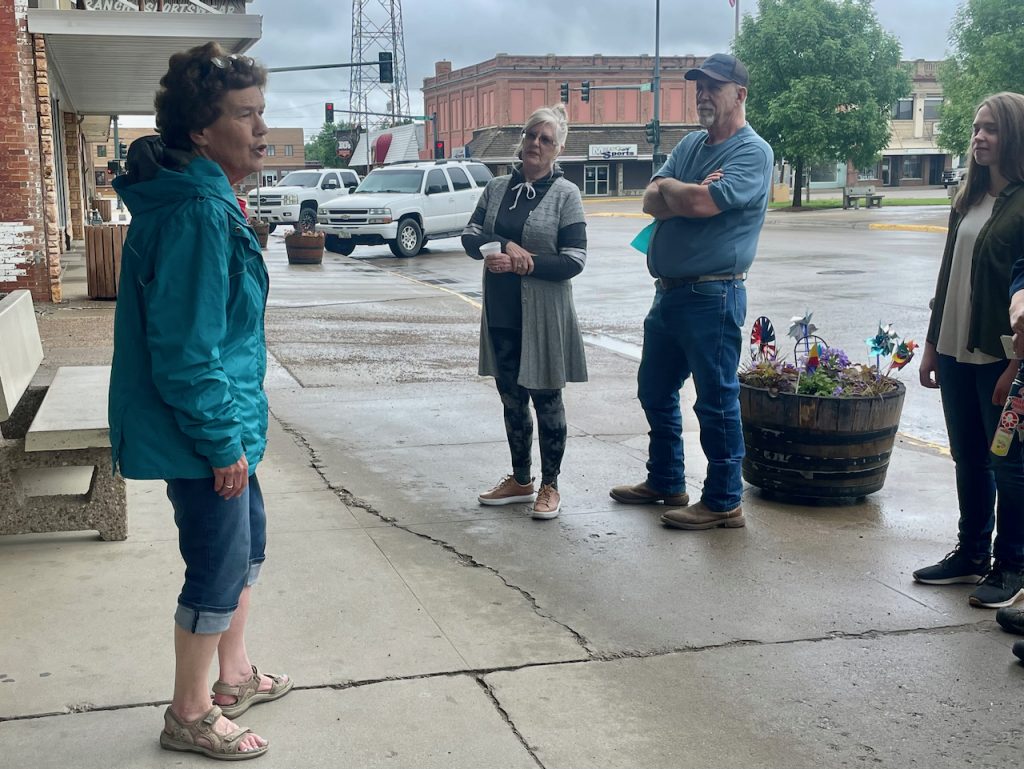
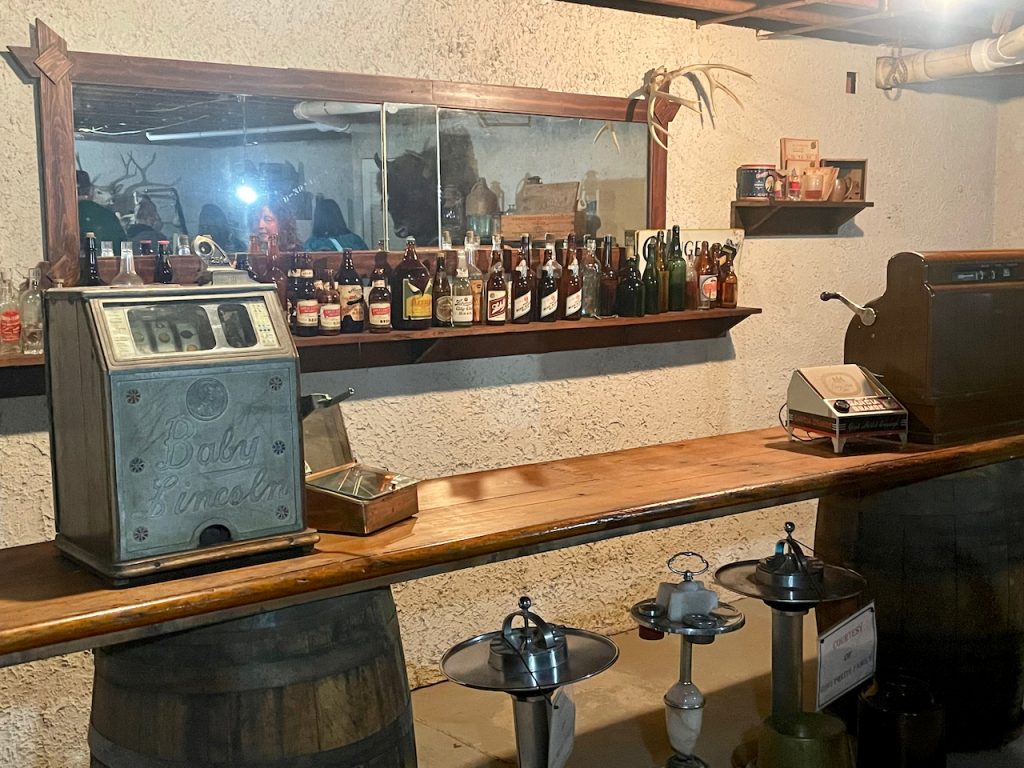
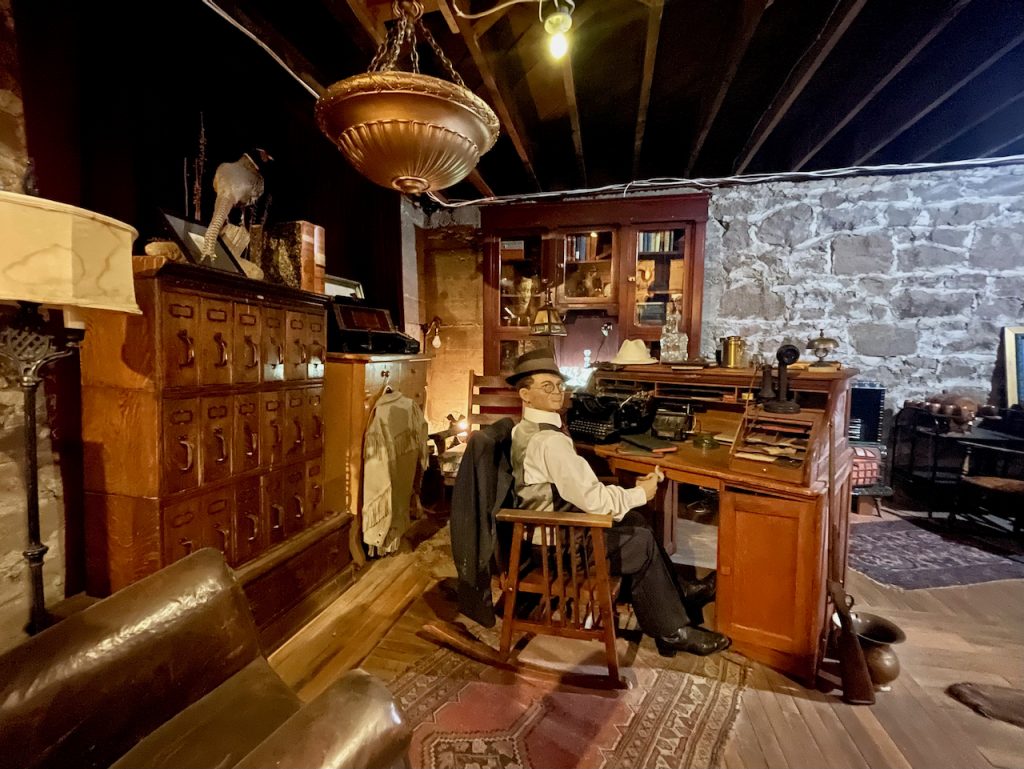
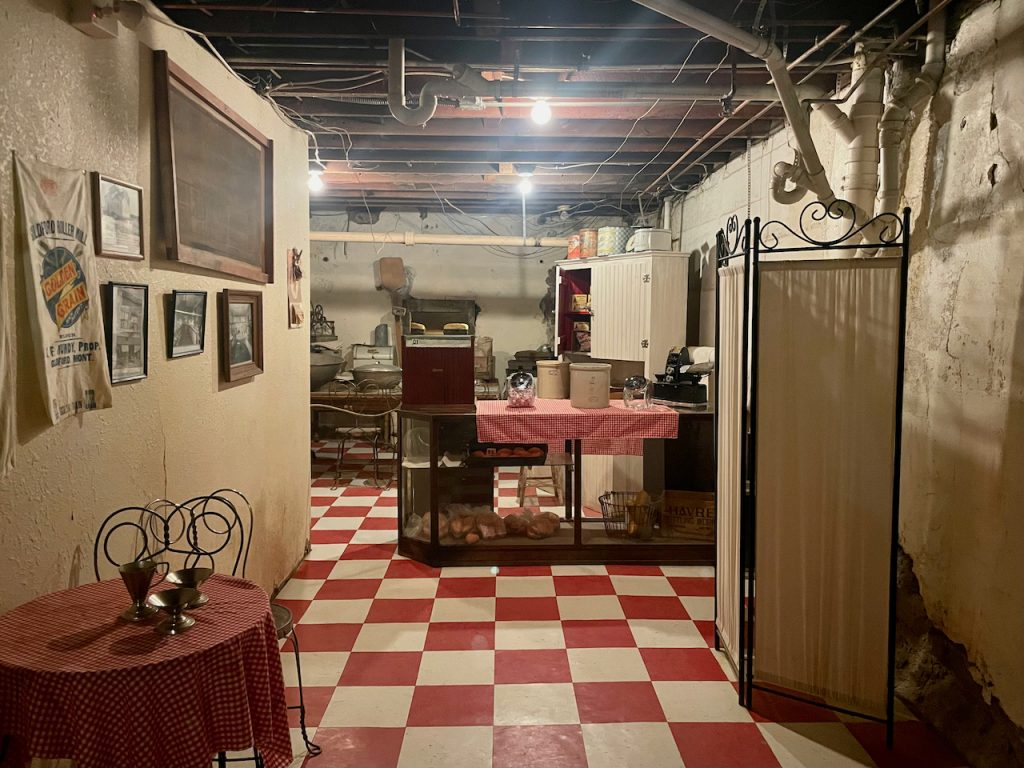
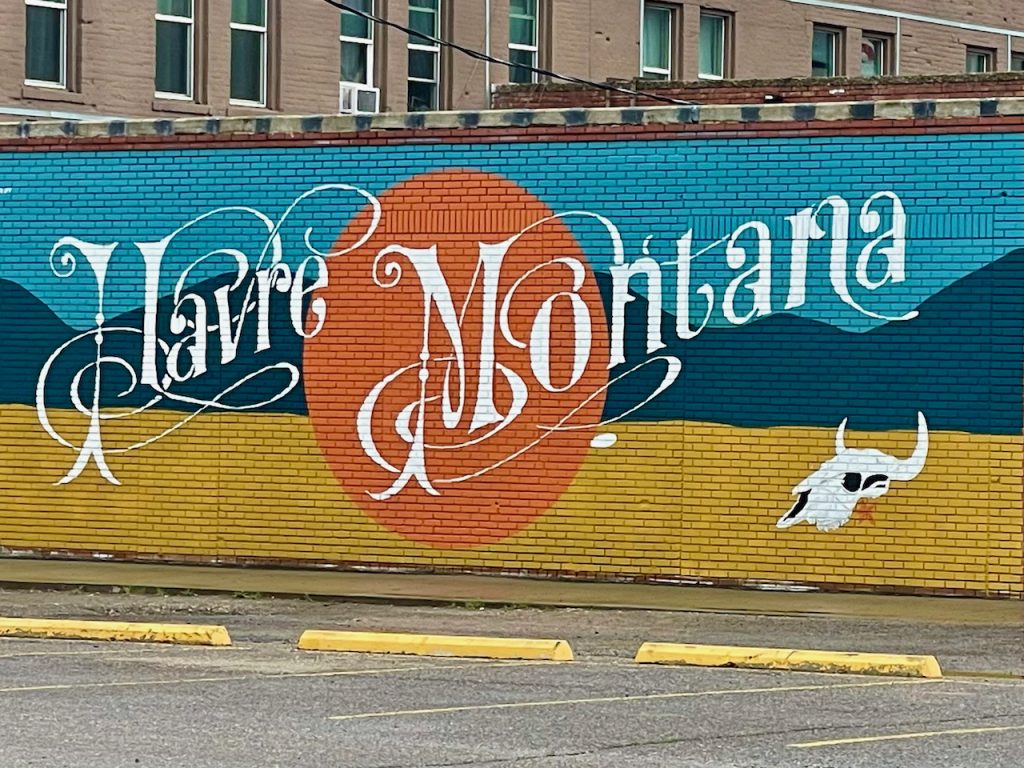
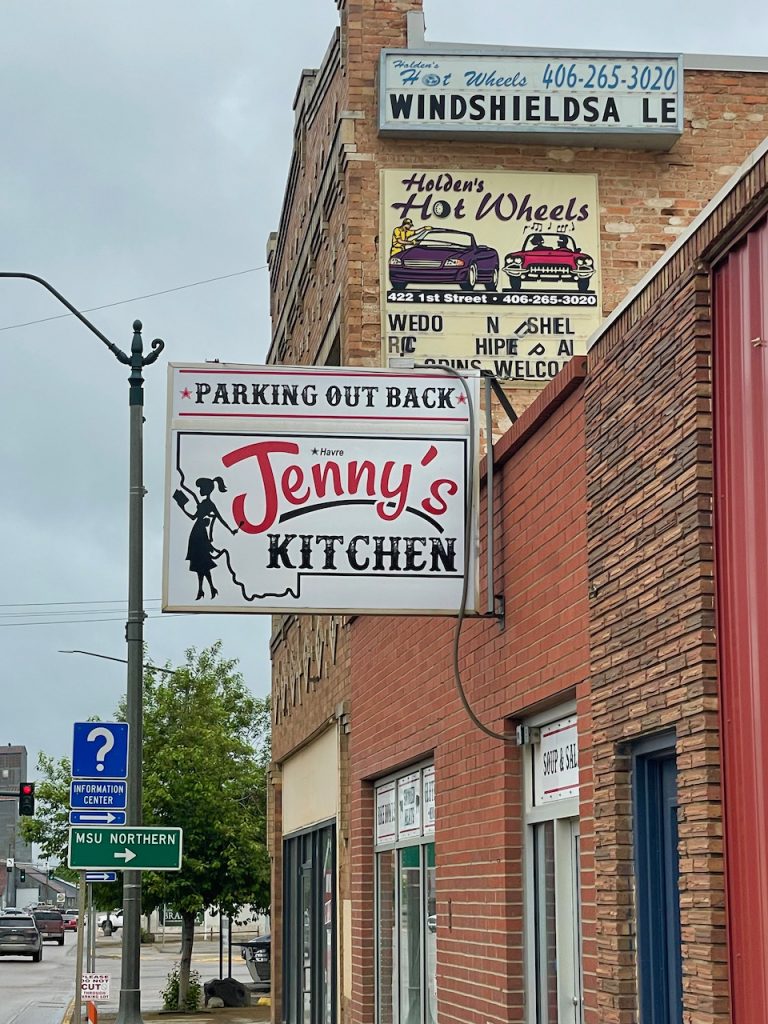
Unser nächster Halt ist Cut Bank, wie die anderen Orte hier entlang der 2 ein Eisenbahner Ort. Heutzutage meist etwas heruntergekommen und auch ein wenig traurig. Wir finden jedoch einen ruhigen Stellplatz direkt am Sportplatz. Im Sportanlagen bauen sind die US-Amerikaner einsame spitze. In jedem noch so kleinen Ort sehen wir fantastische Sportanlagen mit allem Drum und Dran. Die tolle 400m Laufbahn nutzen wir dann auch für unseren Frühsport. Und gleich nebenan ist ein Öl-Fördermuseum. Wir erkunden ausgiebig die Freifläche mit allerhand Exponaten und genießen die Ruhe.
Our next stop is Cut Bank, like the other towns here along the 2 a railroader town. Nowadays mostly a bit run down and also a bit sad. However, we find a quiet parking space directly at the sports field. When it comes to building sports facilities, the Americans are the best. In every small town we see fantastic sports facilities with all the trimmings. We also use the great 400m track for our early morning exercise. And right next door is an oil exploration museum. We extensively explore the open space with all kinds of exhibits and enjoy the peace and quiet.
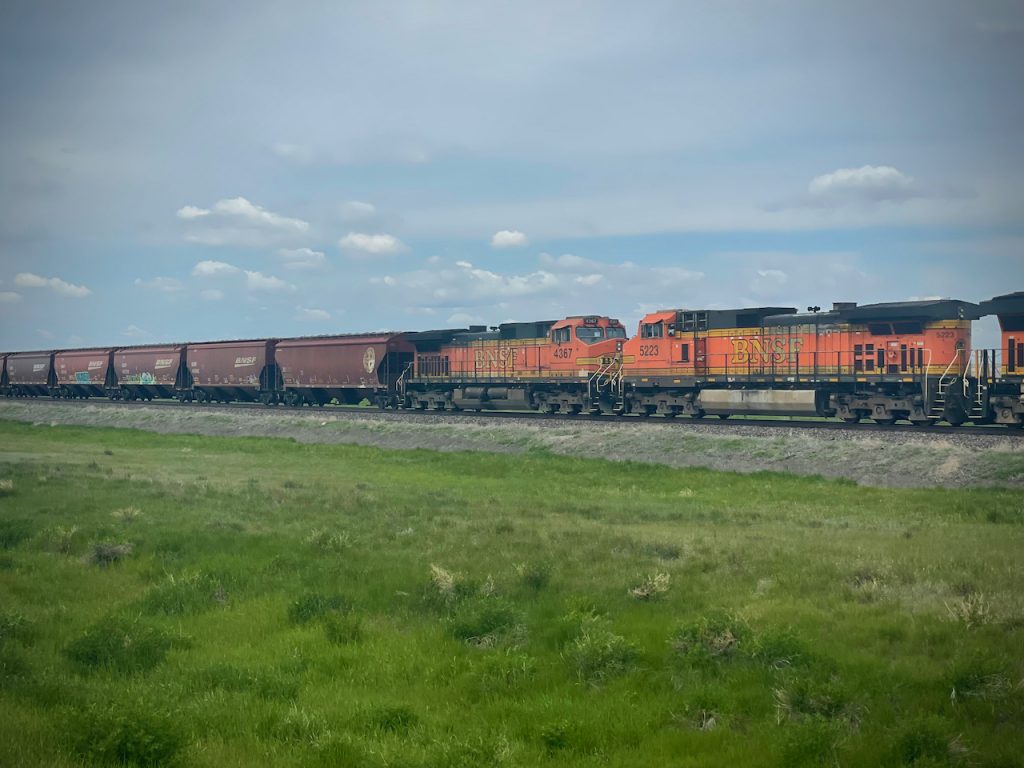
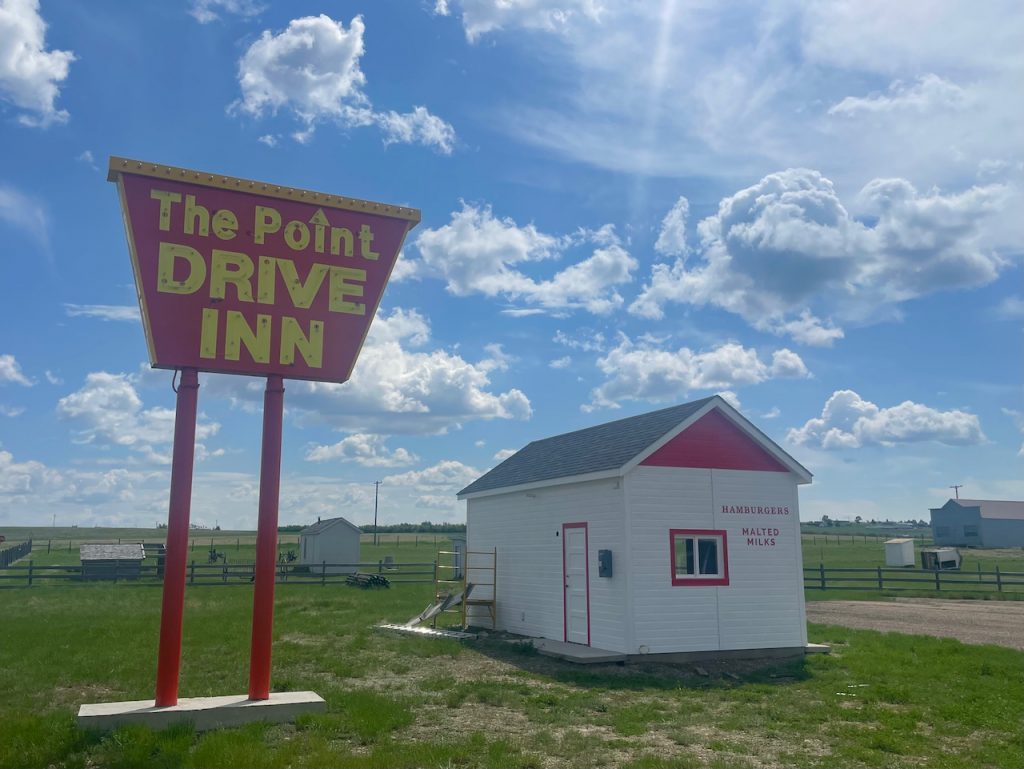
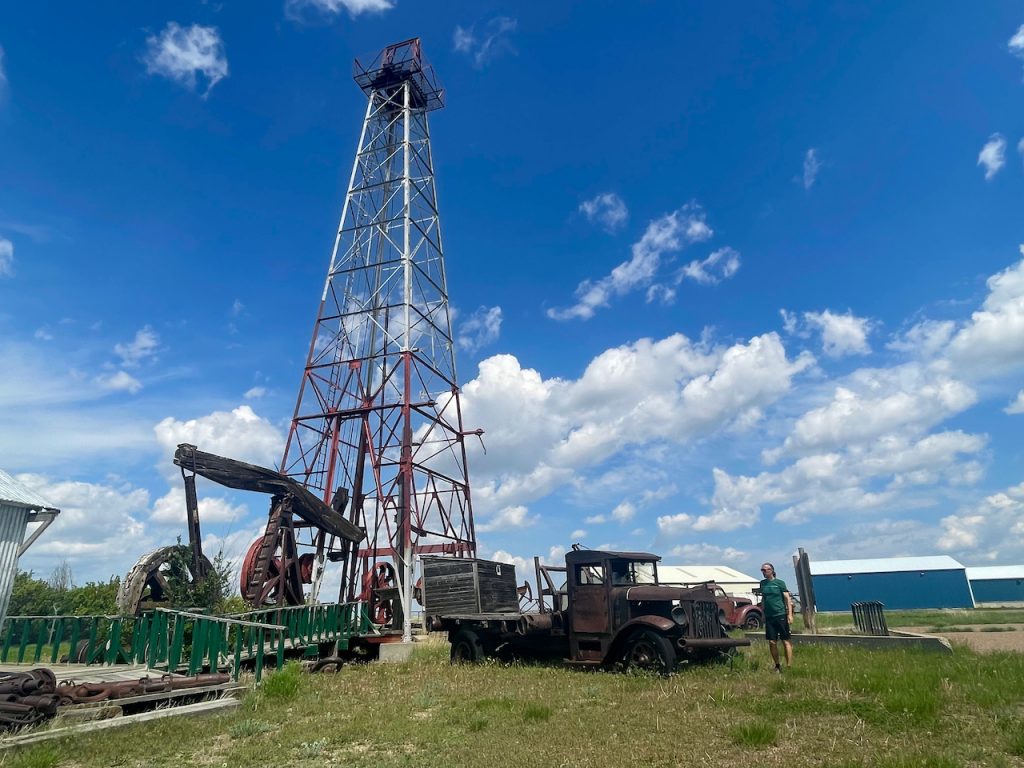
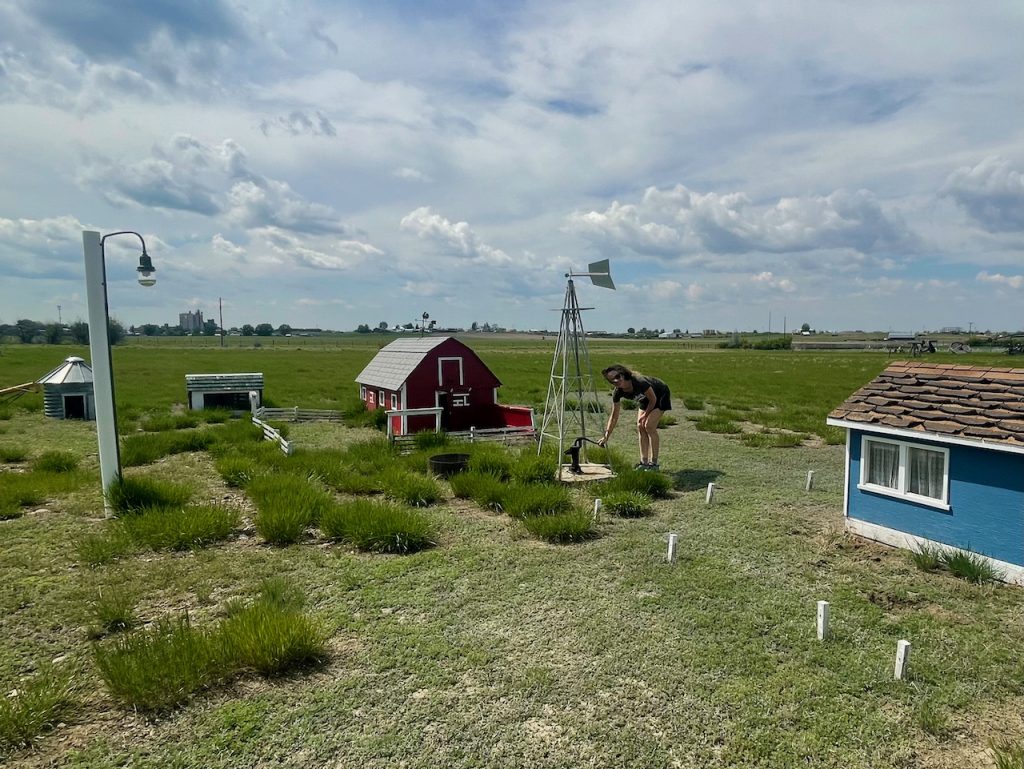
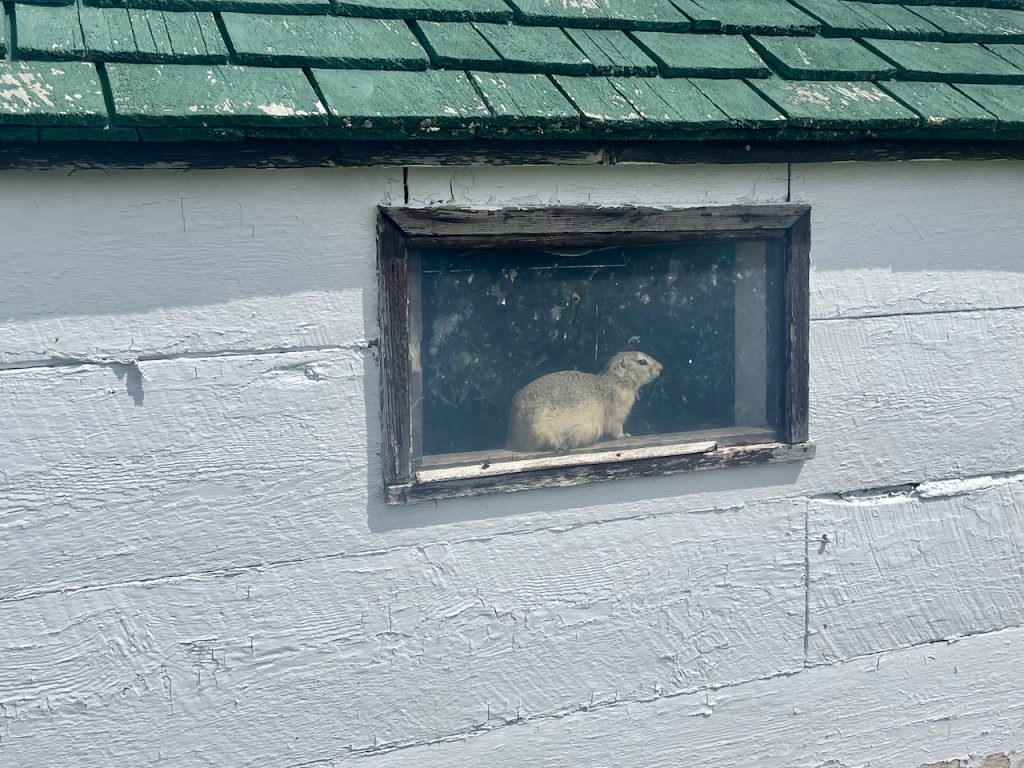
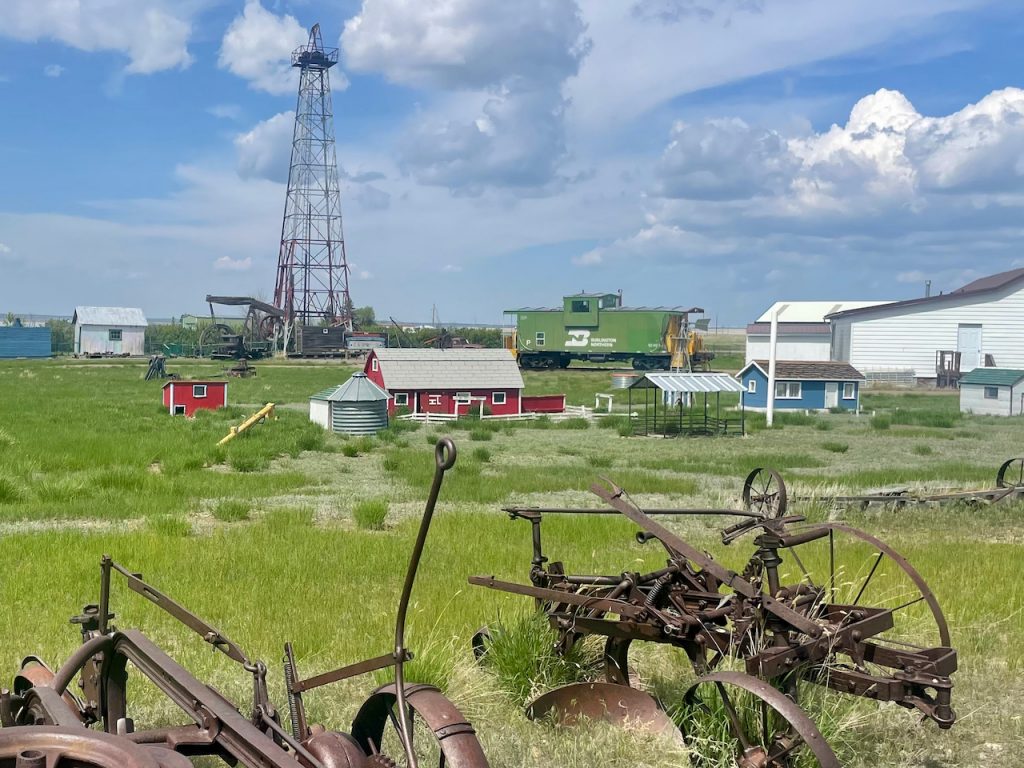
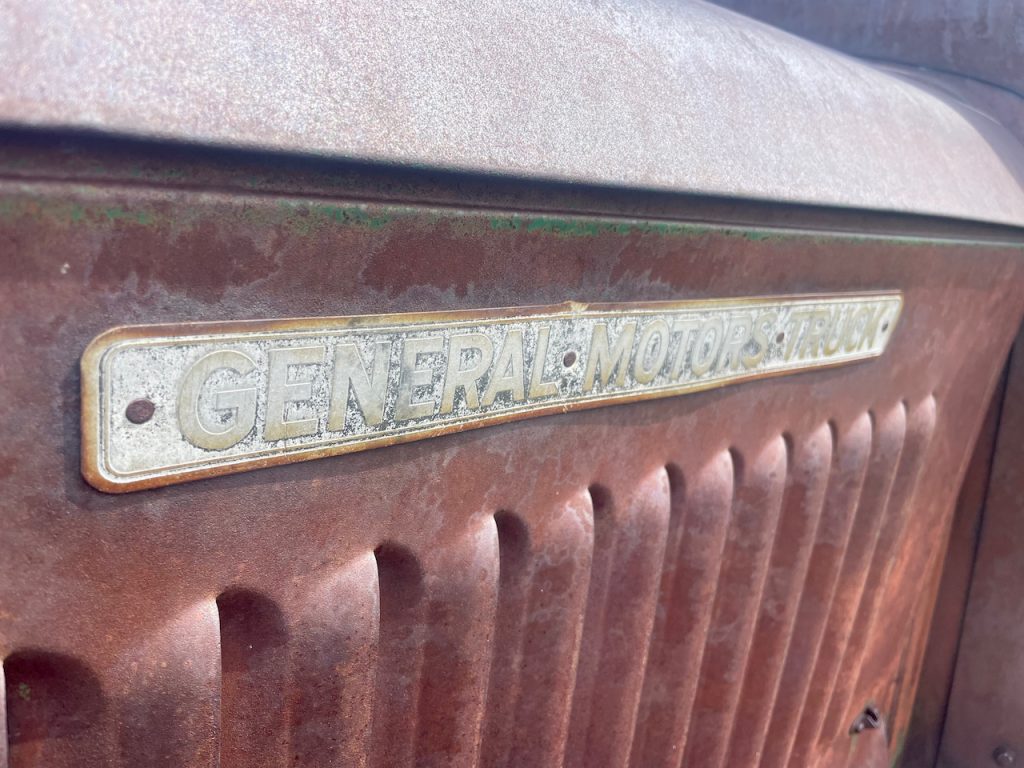
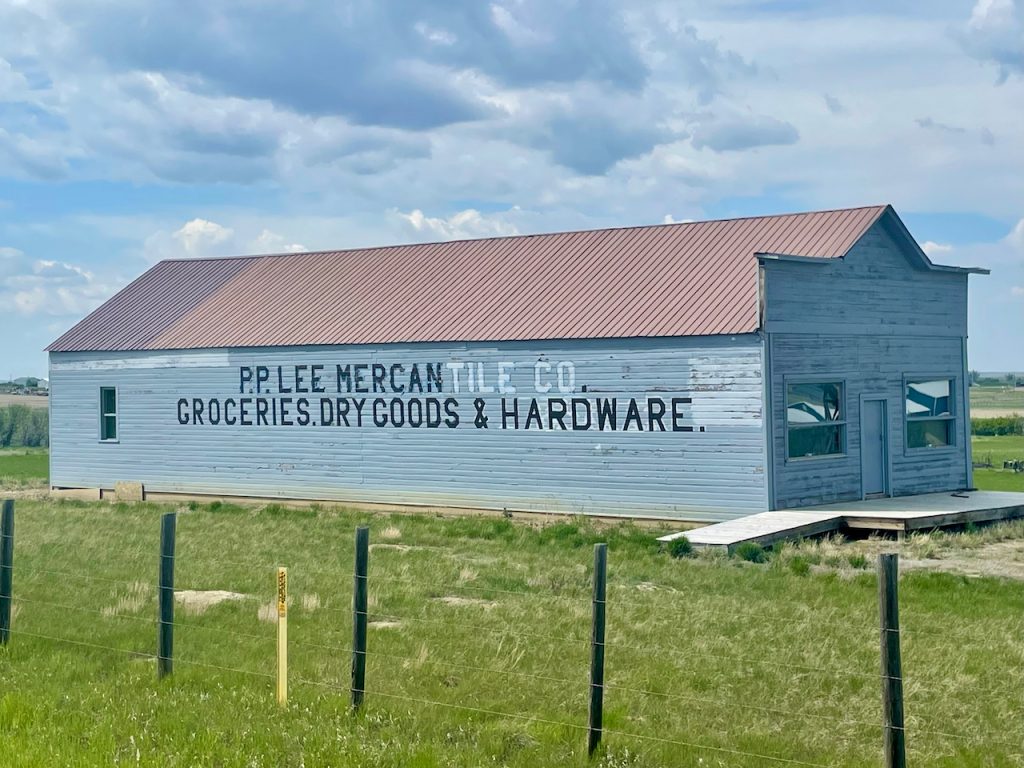
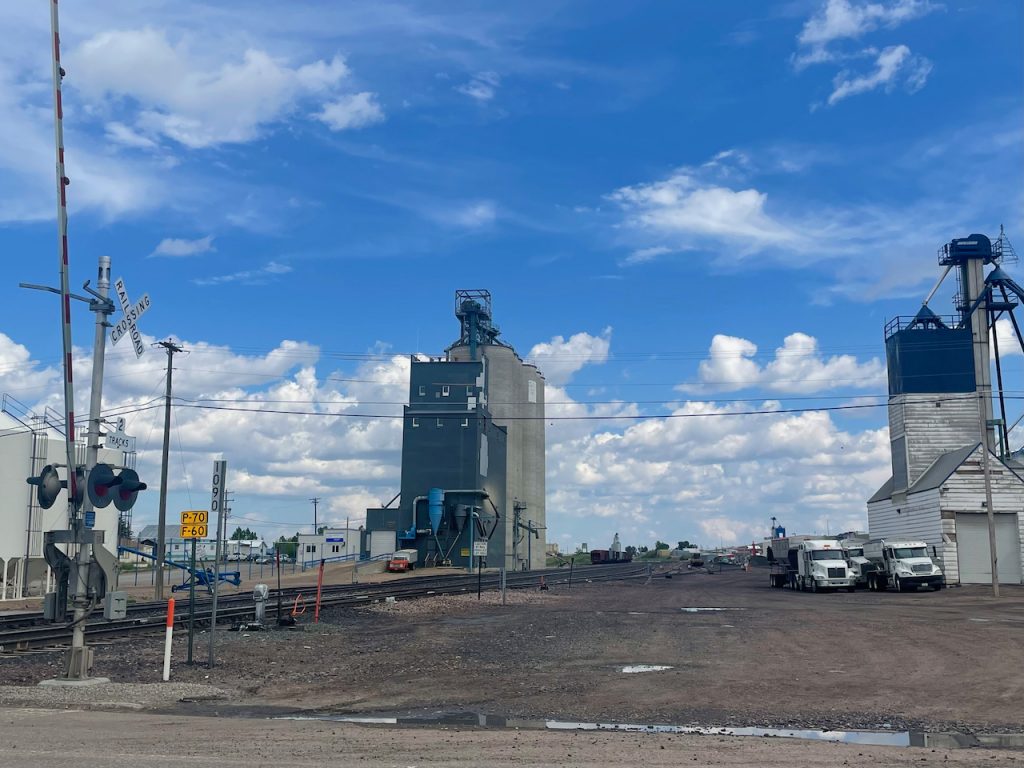
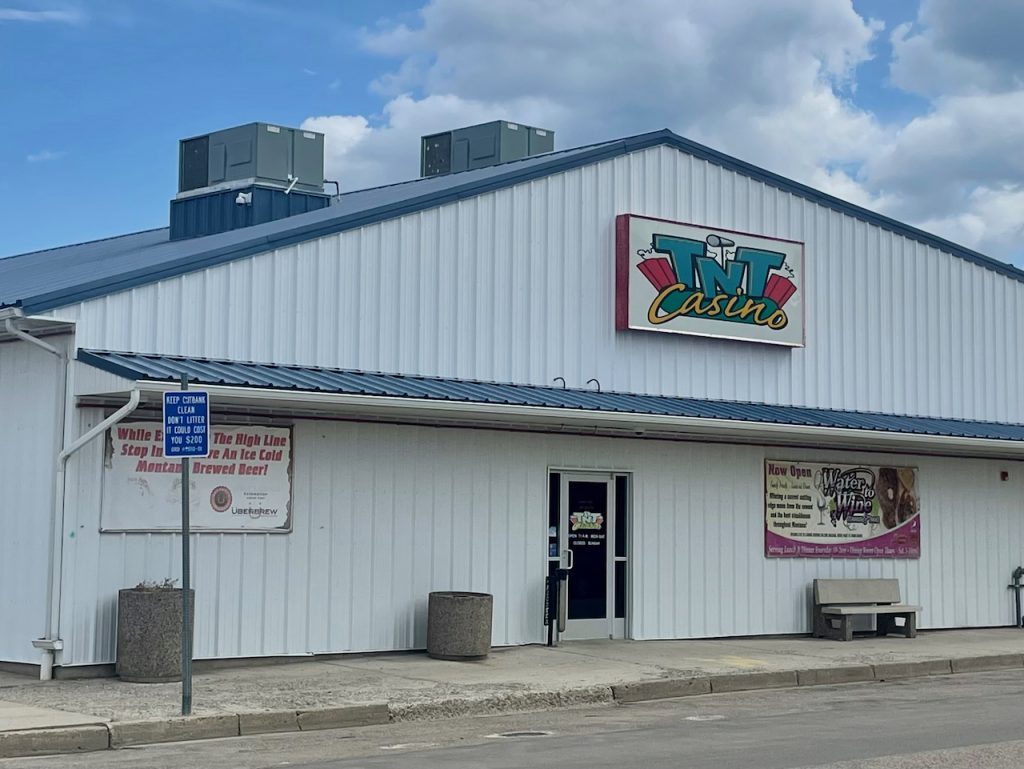
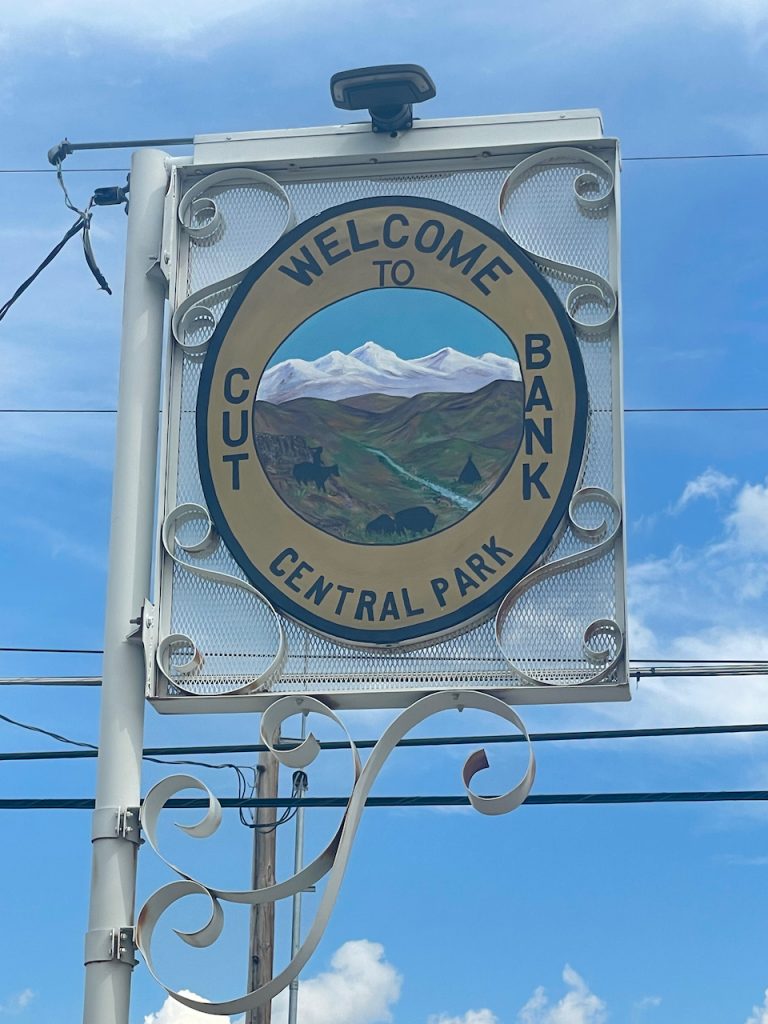
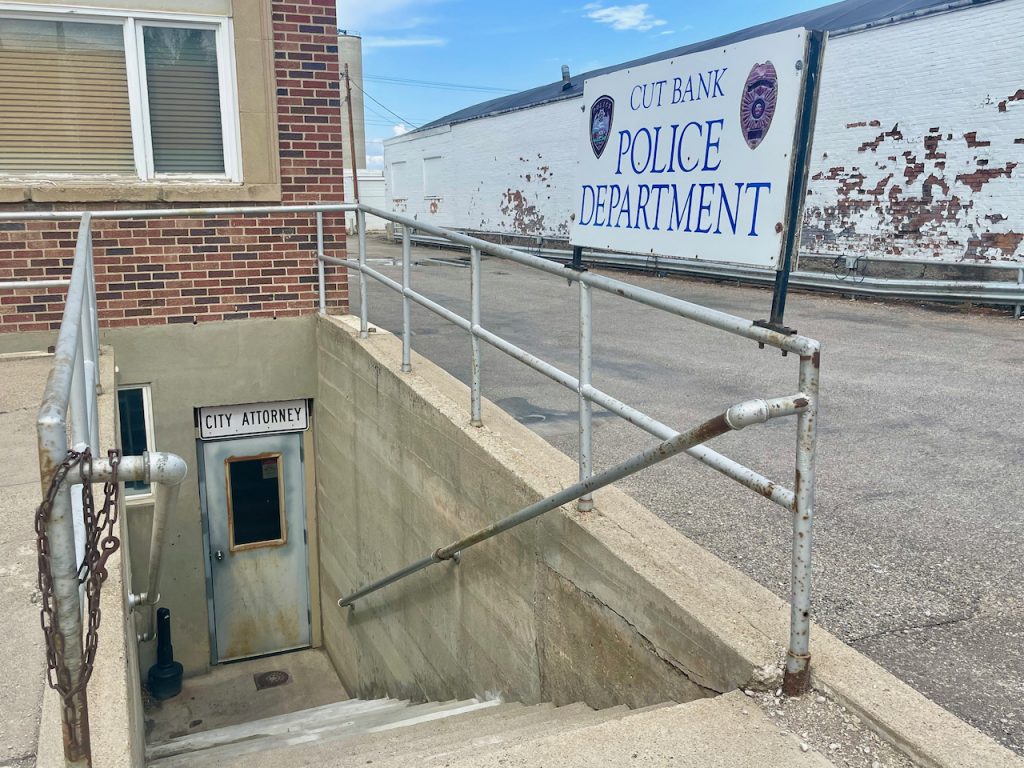
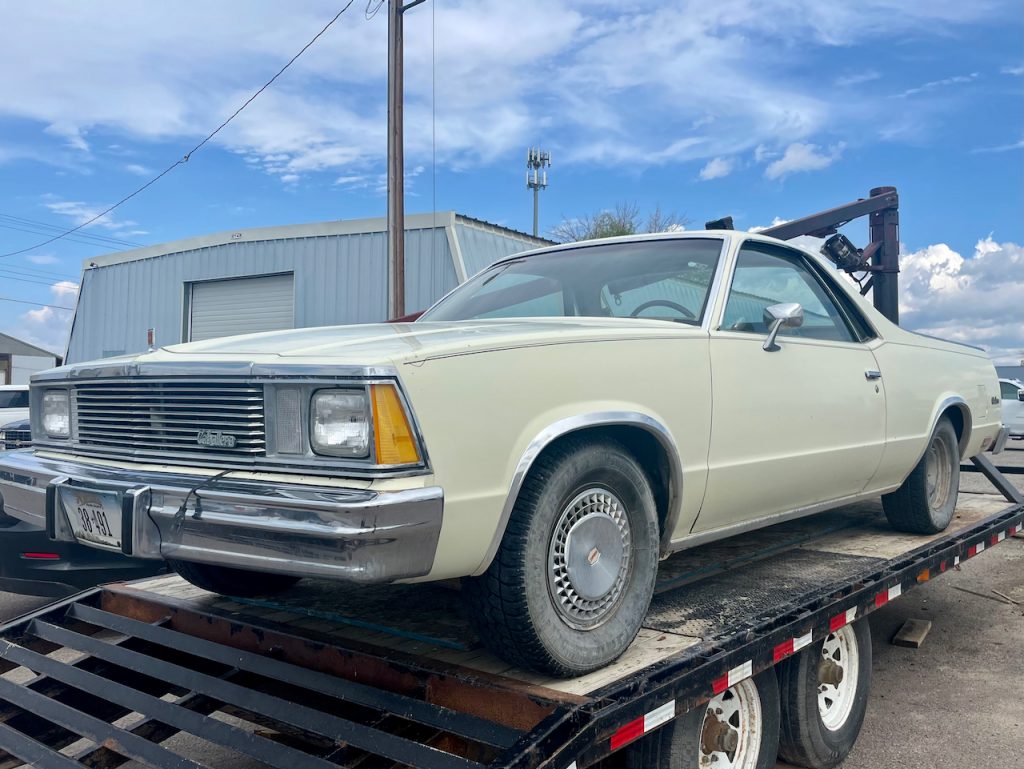
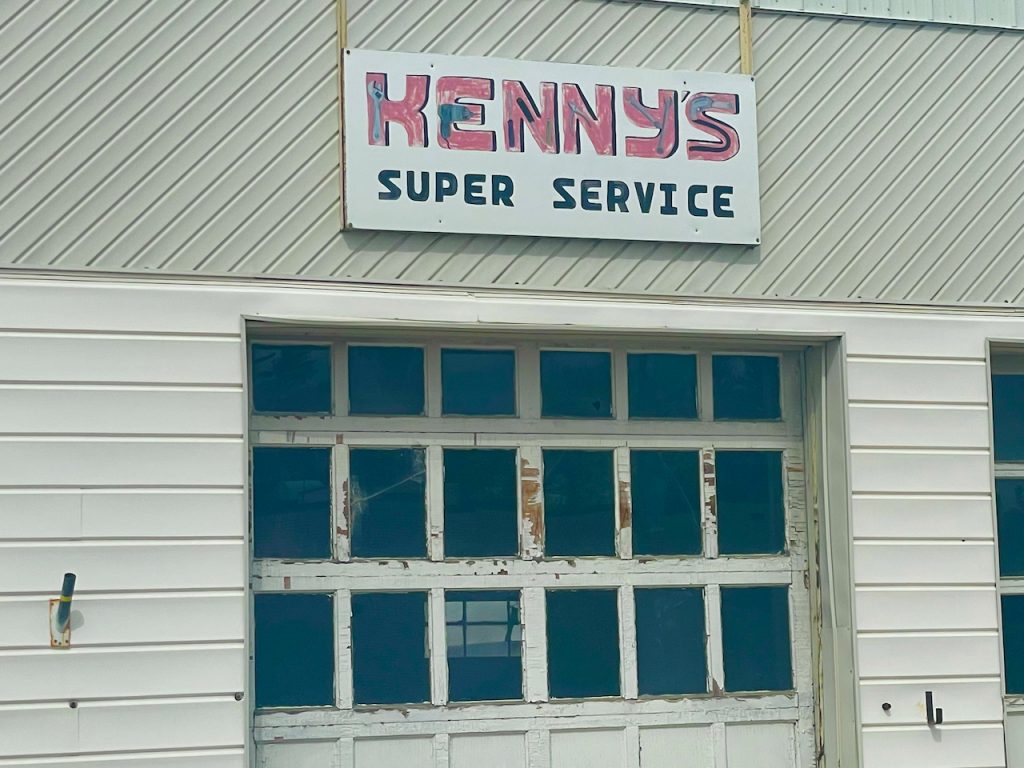
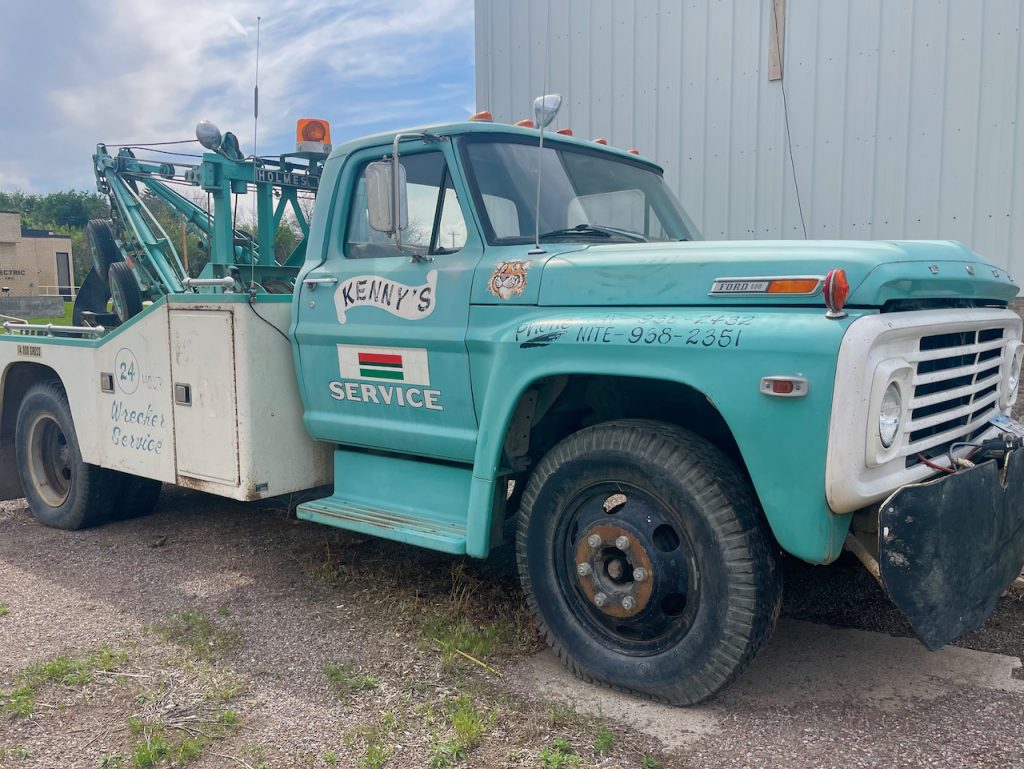
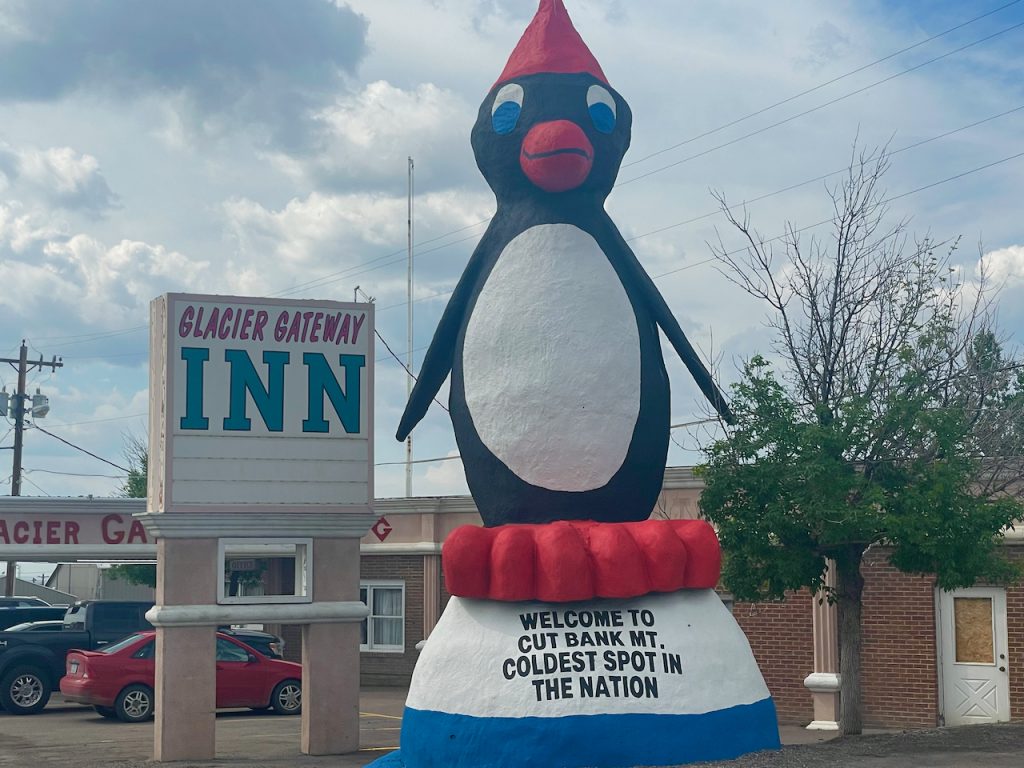
Am nächsten Tag sehen wir SIE dann wieder, die Rocky Mountains! So ein schöner und auch erhabener Anblick. Seit Tagen fahren wir durch den flachen, Prairie artigen östlichen Teil von Montana und erwarten sehnsüchtig diesen Anblick. Schon kurze Zeit später erreichen wir den Glacier National Park und dort quartieren wir uns für die nächsten Tage auf dem St. Mary Campground ein. Wir wollten eigentlich auf den Many Glacier Campground, mitten im Park, doch es ist noch Nebensaison und in den Höhen liegt noch zu viel Schnee, somit ist noch vieles geschlossen.
The next day we see THEM again, the Rocky Mountains! Such a beautiful and also uplifting sight. For days we have been driving through the flat, prairie-like eastern part of Montana and longingly await this sight. A short time later we reach the Glacier National Park and there we stay for the next few days at the St. Mary Campground. We actually wanted to go to Many Glacier, but it’s still the off-season and there’s still too much snow at the higher altitudes, so a lot is still closed.
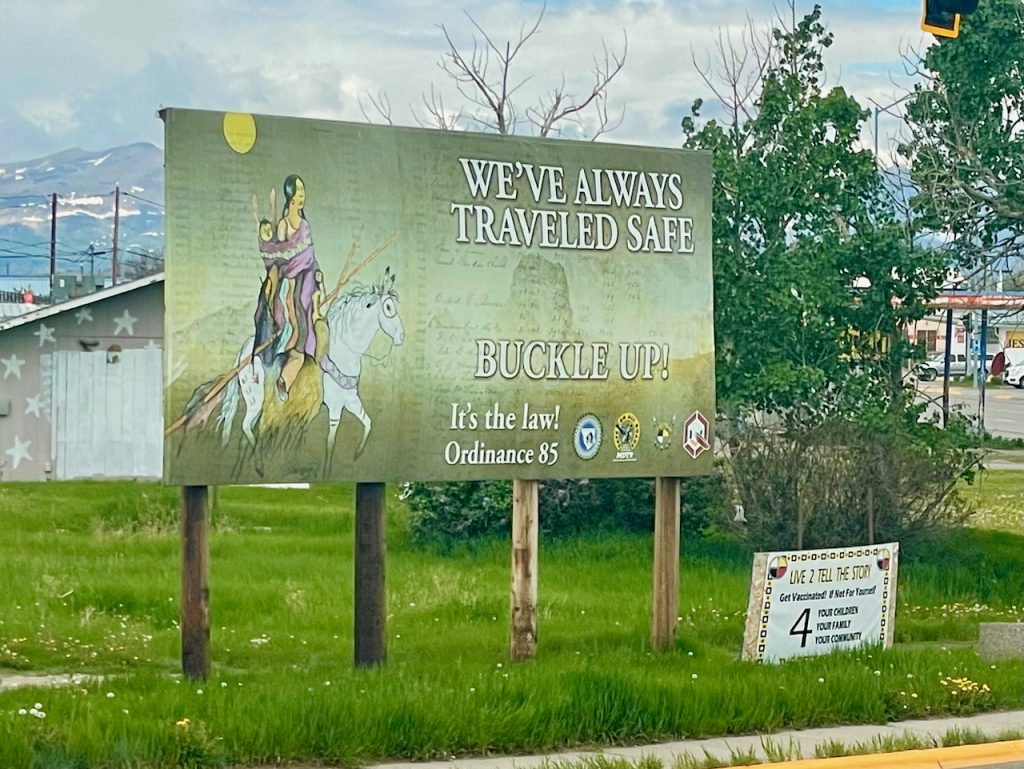
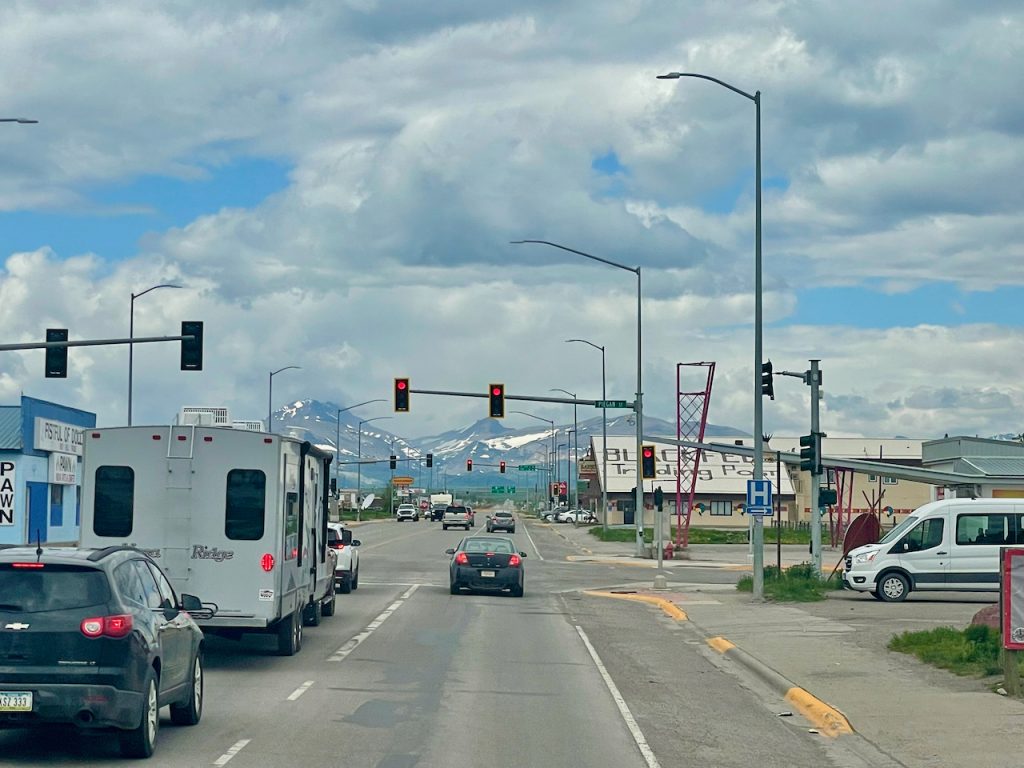
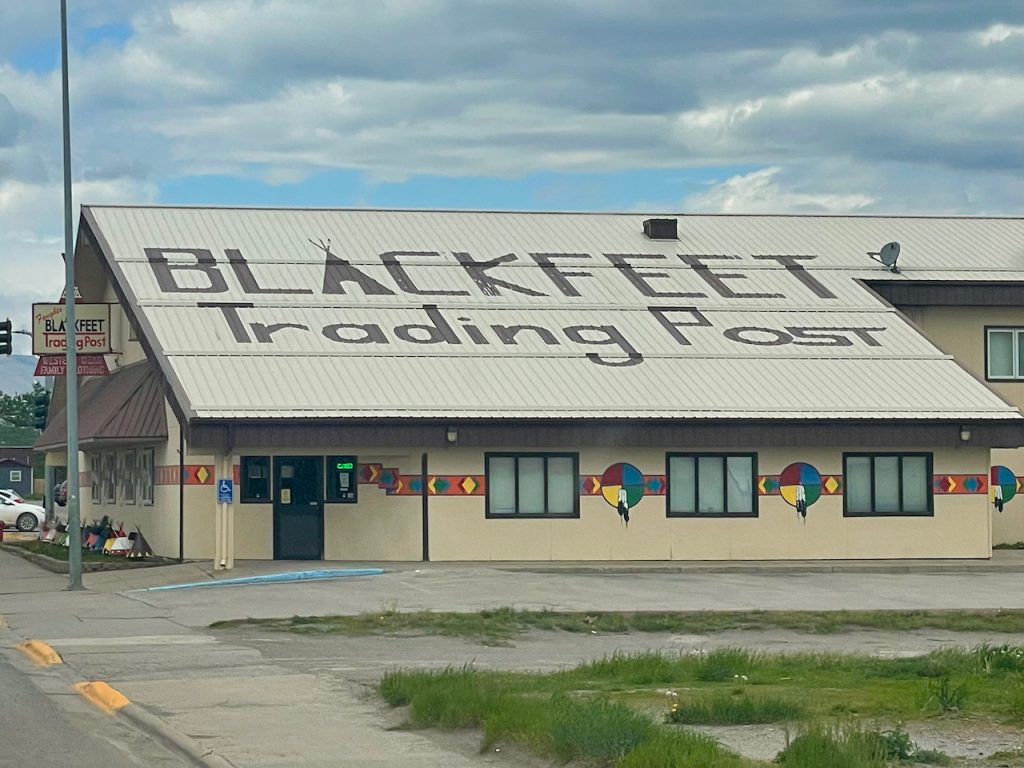
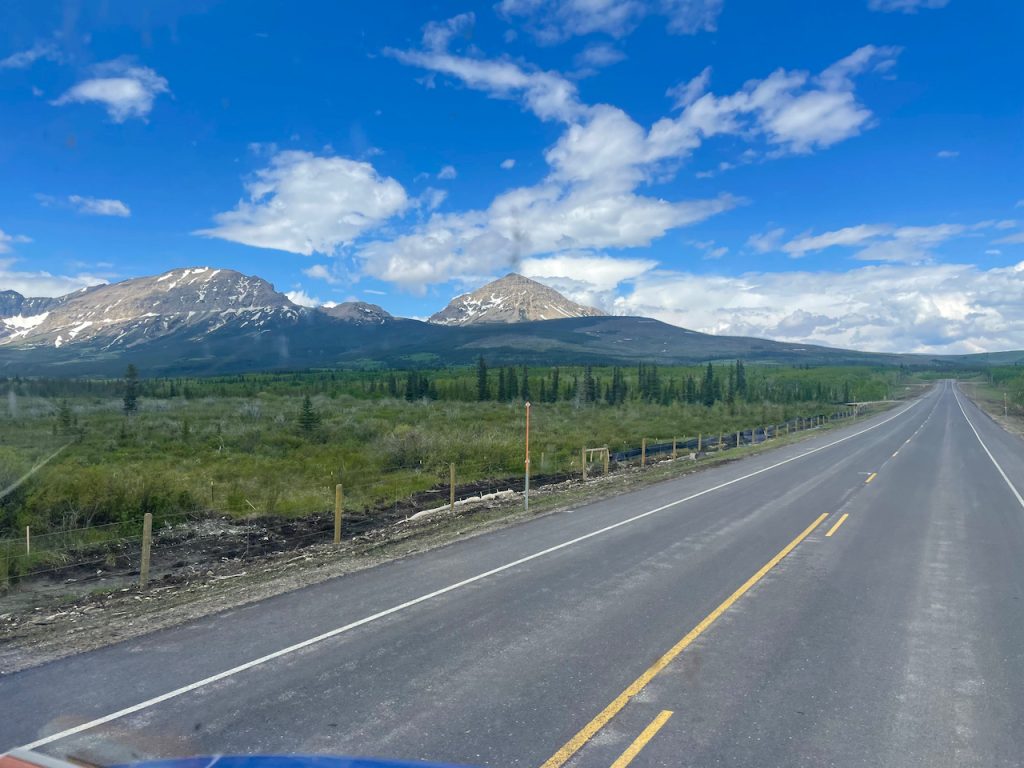
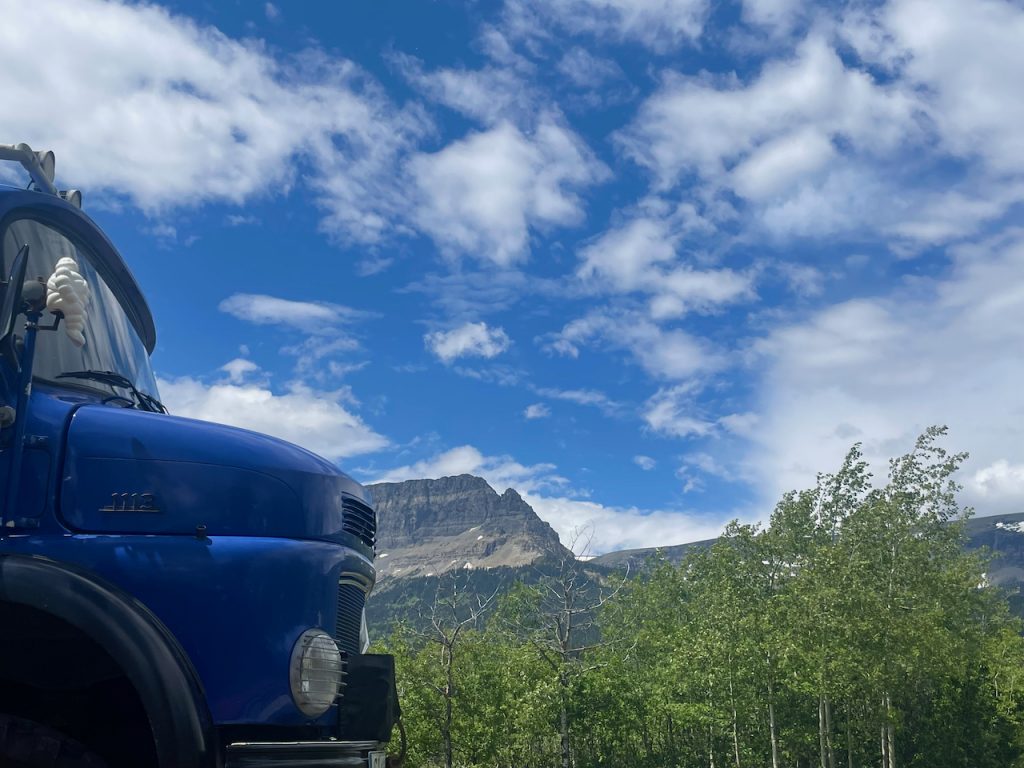
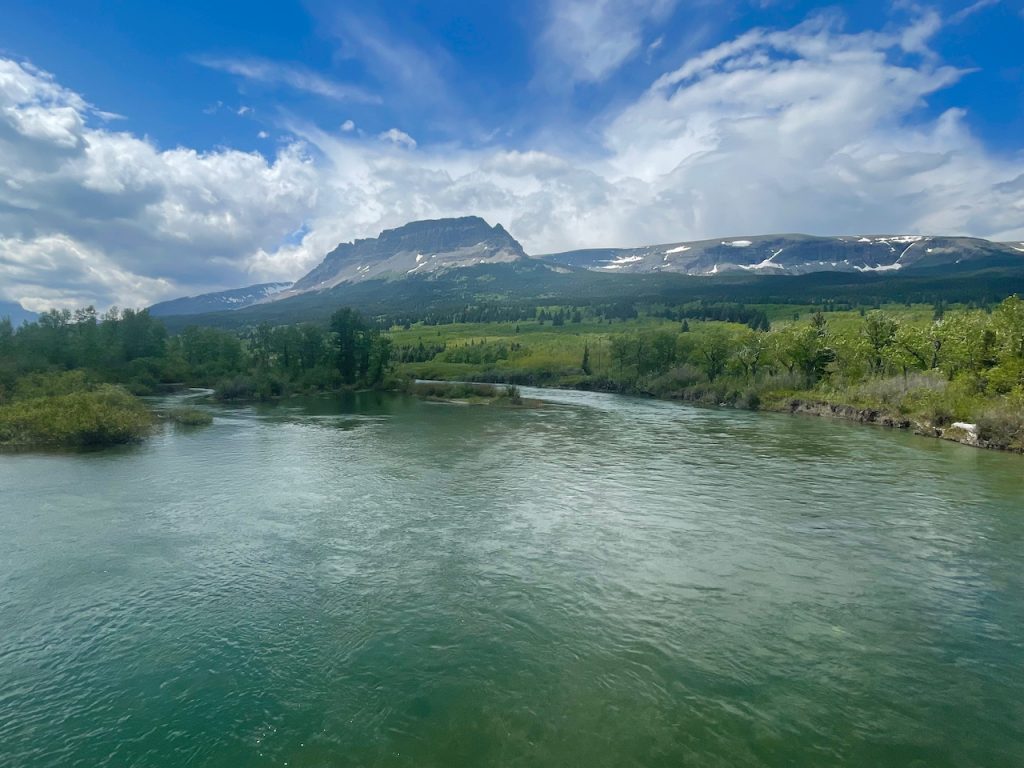
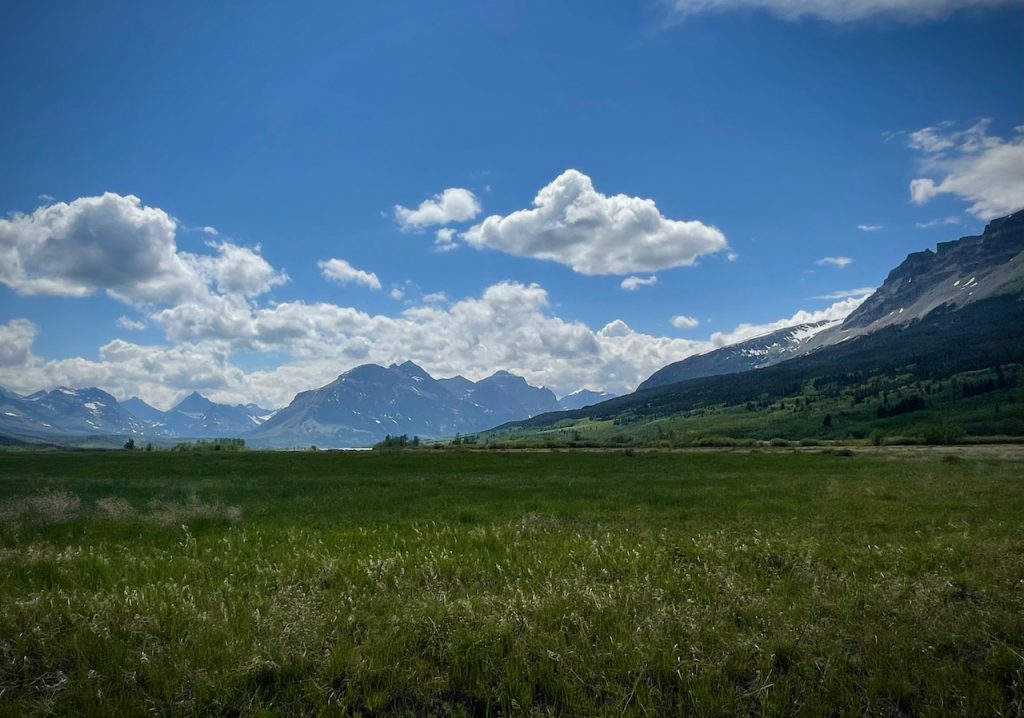
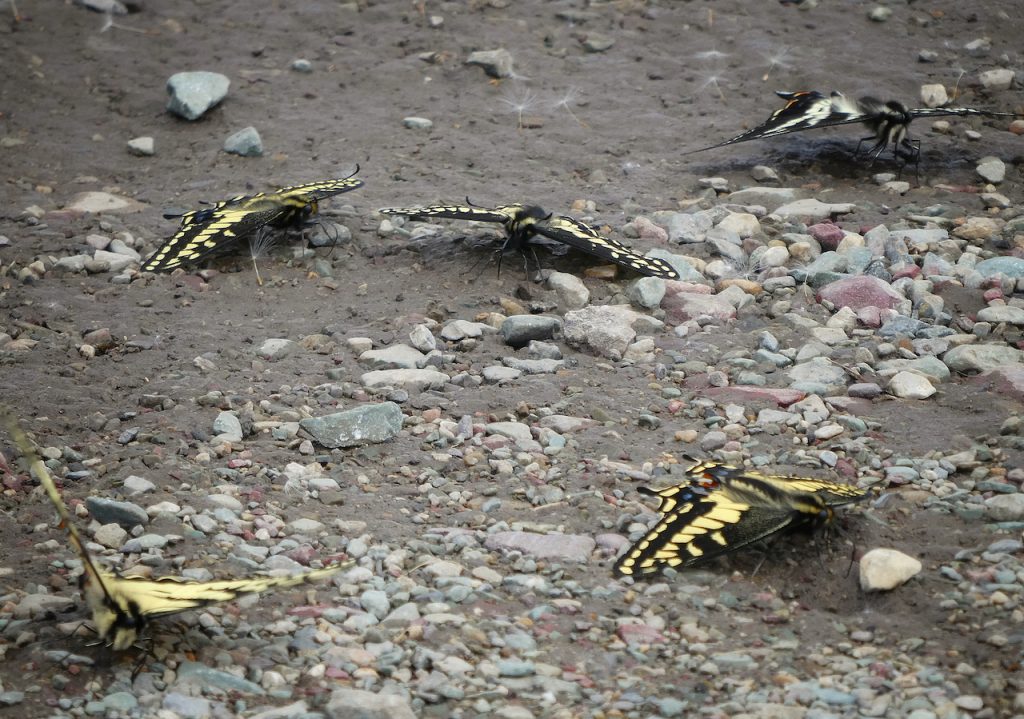
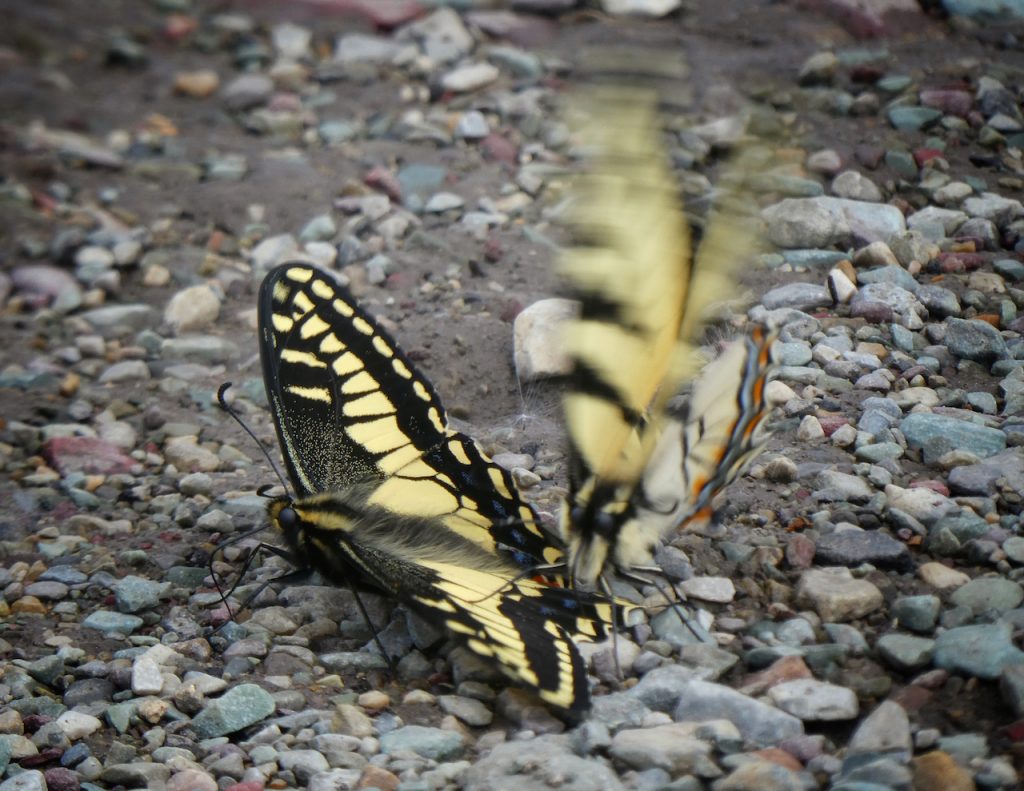
Das stellt sich aber als Glücksfall heraus. Es sind noch nicht viele Besucher im Nationalpark UND das Wetter ist perfekt. Nach unserem obligatorischen Besuch im Visitor Center haben wir mal grob unsere Wander- und Fahrradtouren geplant. Die Ranger, das Center hat erst vor 3 Tagen geöffnet, sind erstaunlich schlecht informiert, aber wie immer unglaublich höflich. Begeistert und betroffen sind wir über die First Nations Ausstellung. Die Rocky Mountains waren früher mehr oder weniger komplett Blackfeet Ureinwohner Gebiet. Auch waren andere Stämme anzutreffen, die jedoch nur temporär ansässig waren. Und man muss es einfach sagen wie es ist: Ende des 19. Jahrhunderts wurden die First Nations von den eingewanderten Europäern total verarscht und abgerippt. Nicht nur hier – überall auf dem Kontinent – aber hier wird uns das alles wieder mal richtig klar. Die Stämme wurden aus „ihrer“ Heimat vertrieben, da beispielsweise Bodenschätze gefunden wurden. Versprochen wurden ihnen Reservate, die ebenso gut sein sollten – das war aber eher ein schlechter Witz. Schaut Euch mal die Karten mit den eingezeichneten Reservaten an – meist recht trostloses Land. Wenn dort jedoch auch Bodenschätze gefunden wurden, wurden die First Nations dann entweder wieder vertrieben, oder diese Gebiete wurden aus den Reservaten herausgenommen. So nett waren wir Weißbrote!
But that turns out to be a stroke of luck. There are not many visitors in the national park yet AND the weather is perfect. After our obligatory visit of the Visitor Center, we roughly planned our hiking and cycling tours. The rangers, the center only opened 3 days ago, are surprisingly poorly informed but, as always, incredibly polite. We are excited and concerned about the First Nations exhibition. The Rocky Mountains used to be more or less completely Black Feet territory. Other tribes were also found, but only temporarily. And you just have to say it like it is: At the end of the 19th century, the First Nations were totally screwed and ripped off by the immigrating Europeans. Not only here – everywhere on the continent – but here it all becomes really clear to us again. The tribes were expelled from „their“ homeland because, for example, mineral resources were found. They were promised reservations that were supposed to be just as good – but that was more of a bad joke. Take a look at the maps with the reserves marked – mostly quite desolate country. However, when mineral resources were also found there, the First Nations were either „thrown“ out again, or these areas were „taken out“ off the reservations. That’s how nice we white breads were!
Die Blackfeet bezeichnen die Rockies als ihr Rückgrat und die Seen und Flüsse mit all dem Wasser als das Lebensblut der Erde. Sie lebten nachhaltig und komplett im Einklang mit der Natur. Und dann kamen die Europäer und haben das wertvolle Land ausgebeutet. Zum Glück ist dies in diesem Teil der Rockies nicht lange passiert, da bereits 1910 der Glacier Nationalpark gegründet wurde. Erneut Theodore Roosevelt sei Dank. In unseren Augen ein sehr kluger, weiser und vorausschauender Präsident. Und doch sind wir etwas hin- und hergerissen. Nationalparks sind gut und wichtig – aber was ist mit der Geschichte dieses für die First National heiligen Landes? Umso mehr freuen wir uns, eine so informative und auch kritische Ausstellung vorzufinden.
The Blackfeet First Nations call the Rockies their backbone and the lakes and rivers with all the water the lifeblood of the earth. They lived sustainably and completely in harmony with nature. And then the Europeans came and exploited the valuable land. Thankfully, this didn’t happen for long period of time in this part of the Rockies, as Glacier National Park was established here back in 1910. Again thanks to Theodore Roosevelt. In our eyes a very wise and foresighted President. And yet we are a little torn. National parks are good and important – but what about the history of this land sacred to the First Nations? We are very pleased to find such an informative and critical exhibition.
Die nächsten Tage sind großartig und das Wetter perfekt. Schon unsere erste Wanderung am Rose Creek entlang hoch zum Otokomi Lake begeistert uns. Es ist herrlich einsam, wir begegnen nur 4 anderen Menschen, und überall blüht es. Es ist ein Genuss für unsere Sinne. Wir, als überhaupt nicht religiöse und ganz und gar kirchen-abgewandte Menschen, haben das Gefühl die Spiritualität der Berge zu spüren – und das fühlt sich gut an. Und dann, als wir wieder mit unseren Rädern die 10 km zurück zum Campingplatz fahren, sehen wir auch noch einen Grizzlybär gemütlich in der Wiese grasen. Wunderbar.
The next few days are great and the weather is perfect. Already our first hike along Rose Creek up to Otokomi Lake inspires us. It’s wonderfully lonely, we only meet 4 other people, and it’s blooming everywhere. It is a treat for our senses. We, as not at all religious and completely „unchurched“ people, have the feeling to sense the spirituality of the mountains – and that feels good. And then, when we ride our bikes the 7 miles back to the campsite, we see a grizzly bear grazing comfortably in the meadow. Wonderful.
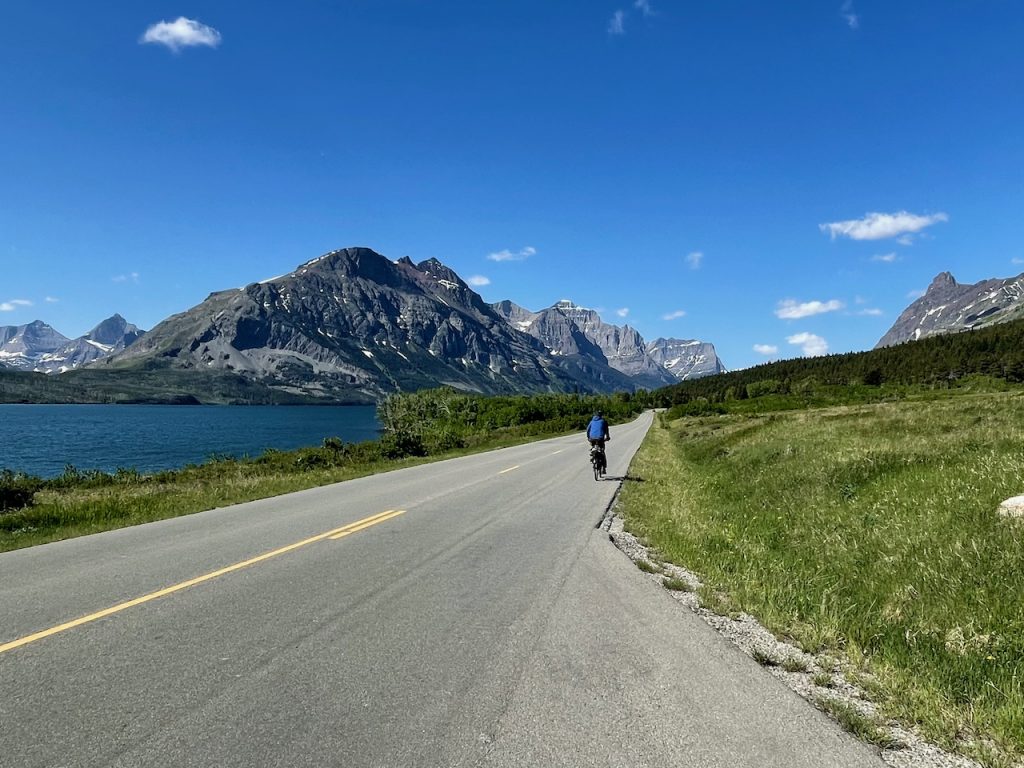
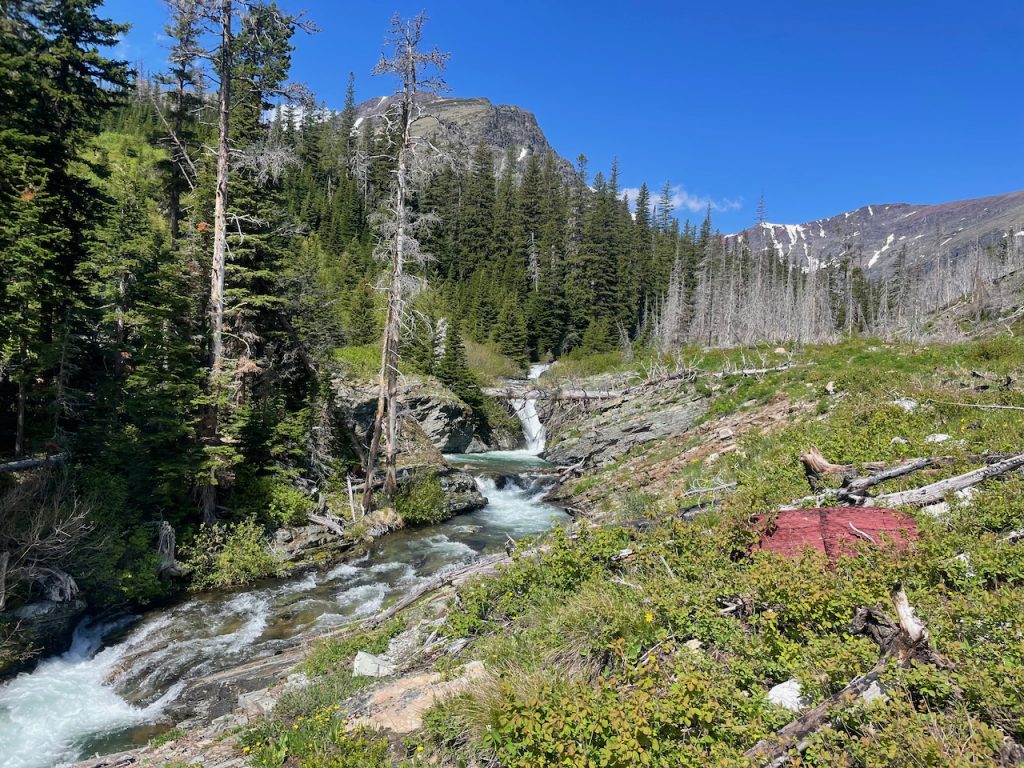
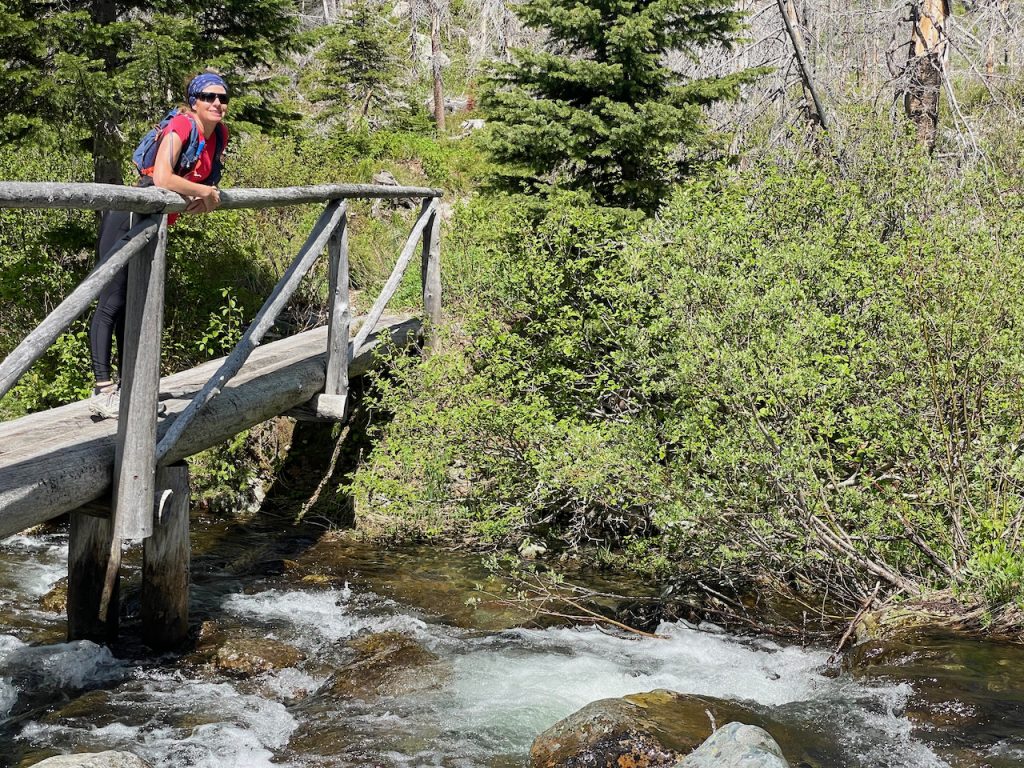
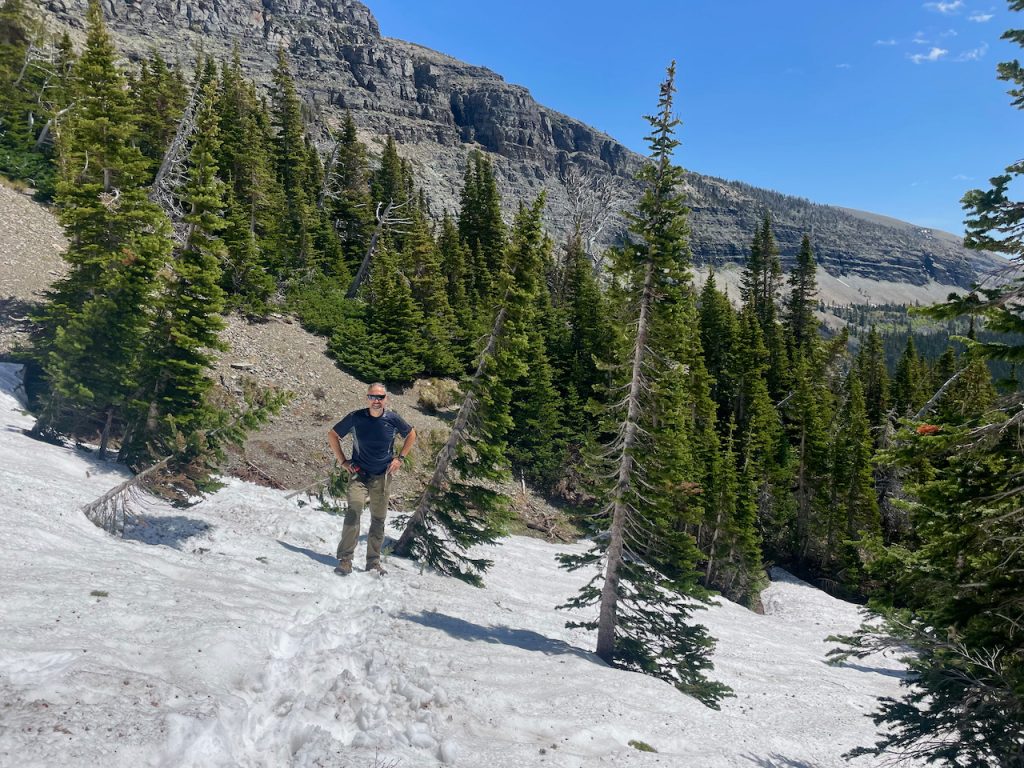
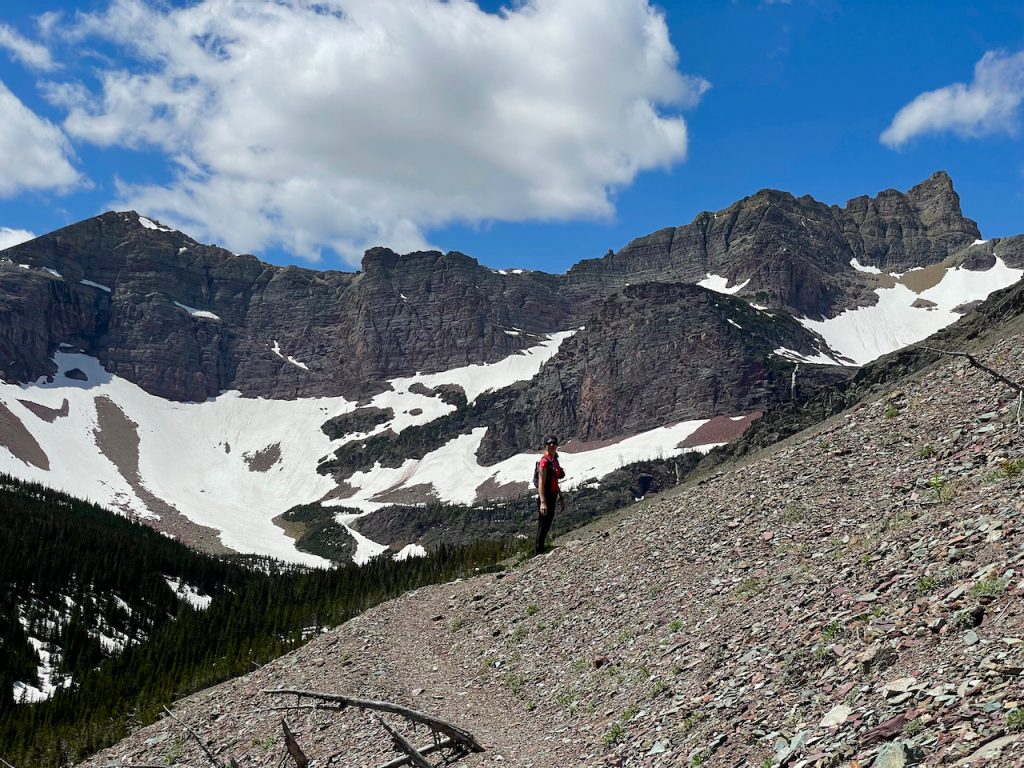
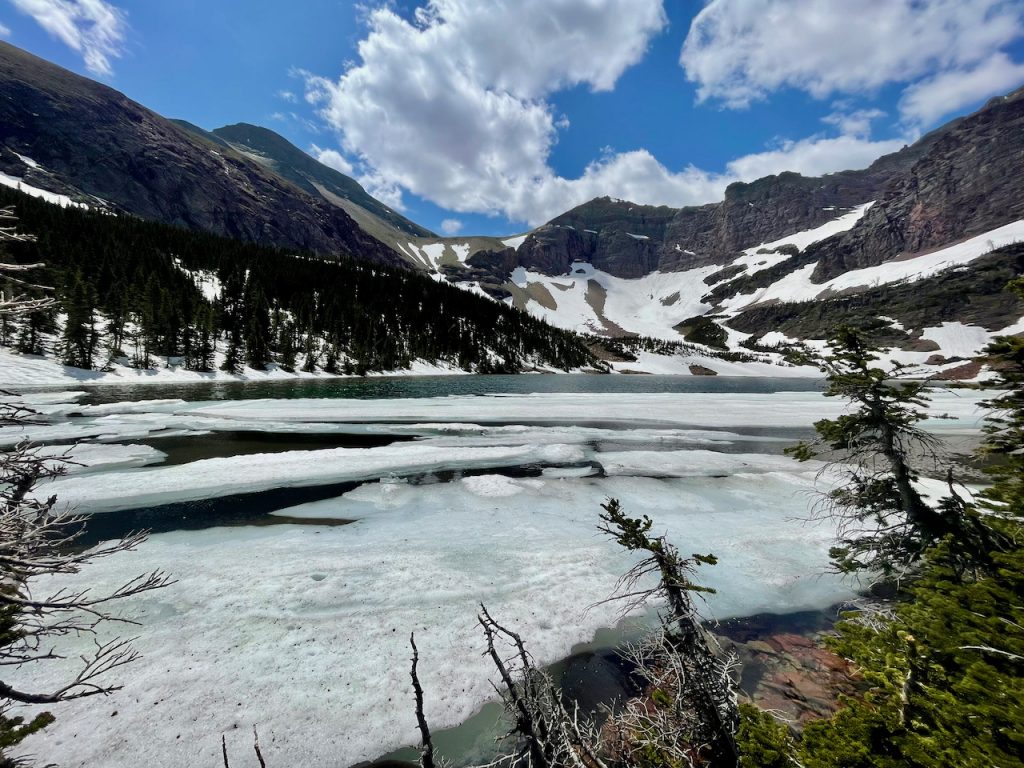
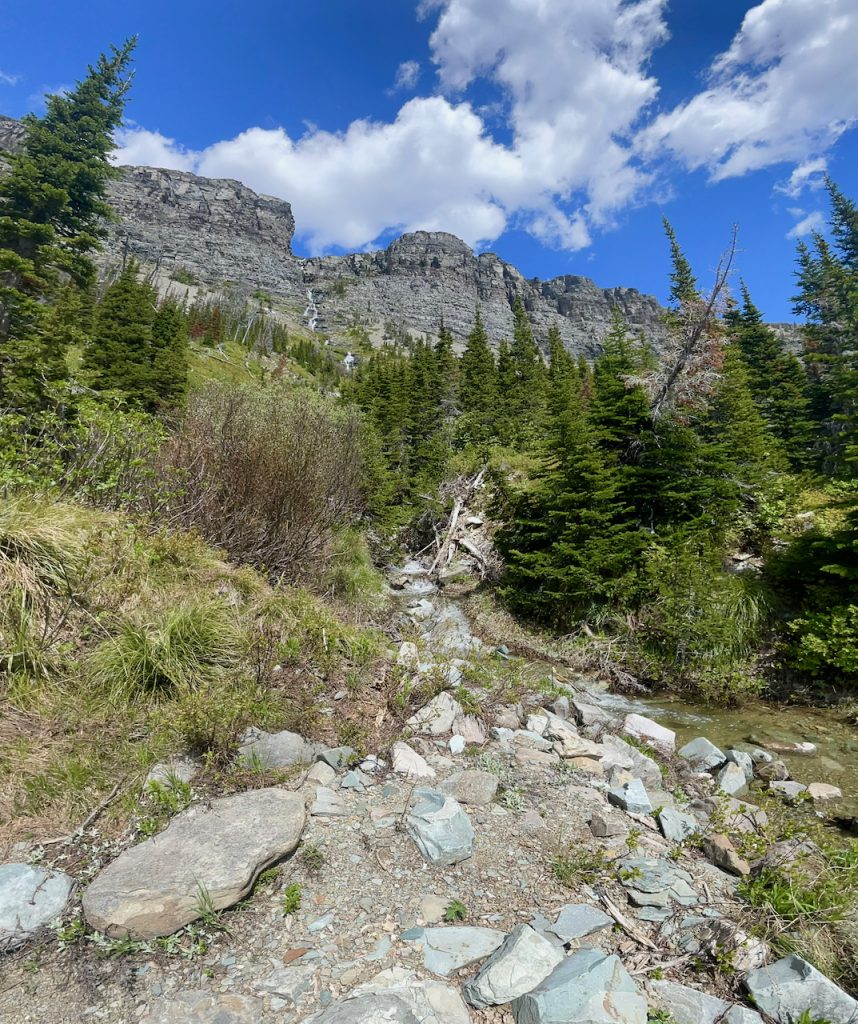
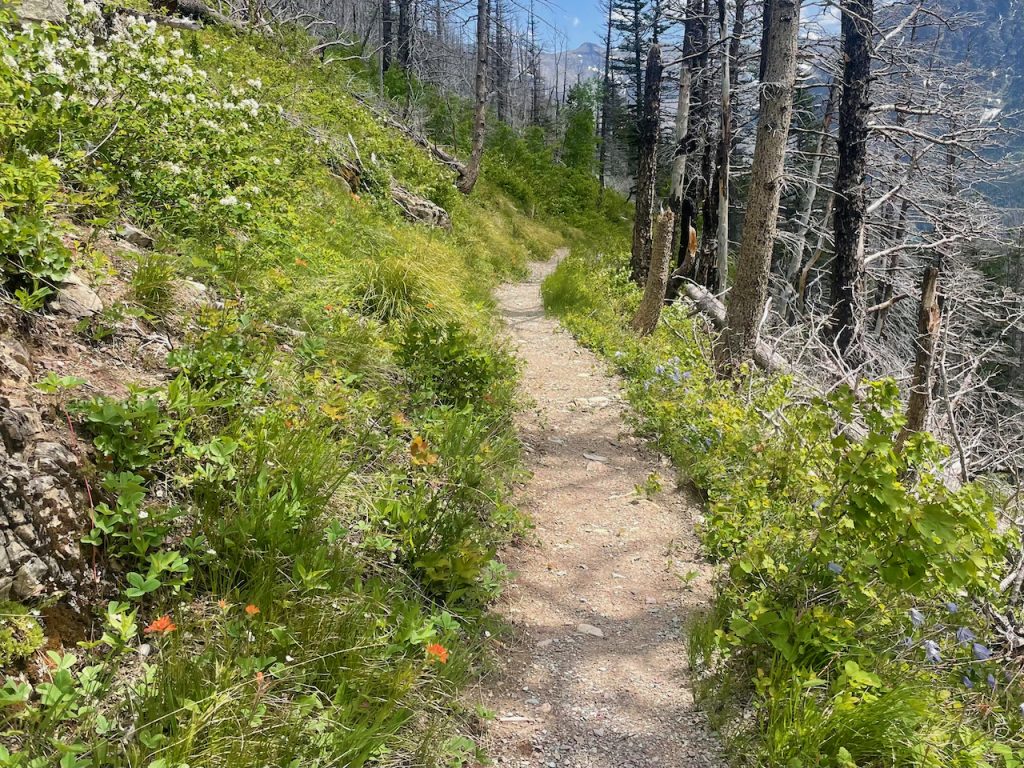
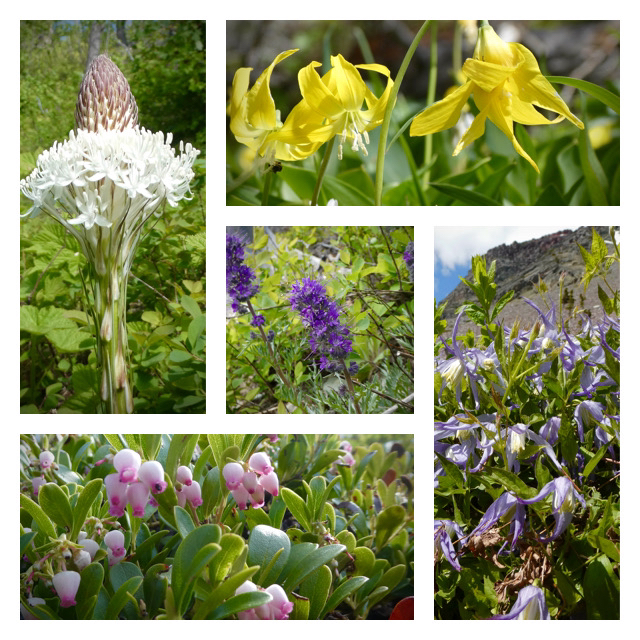
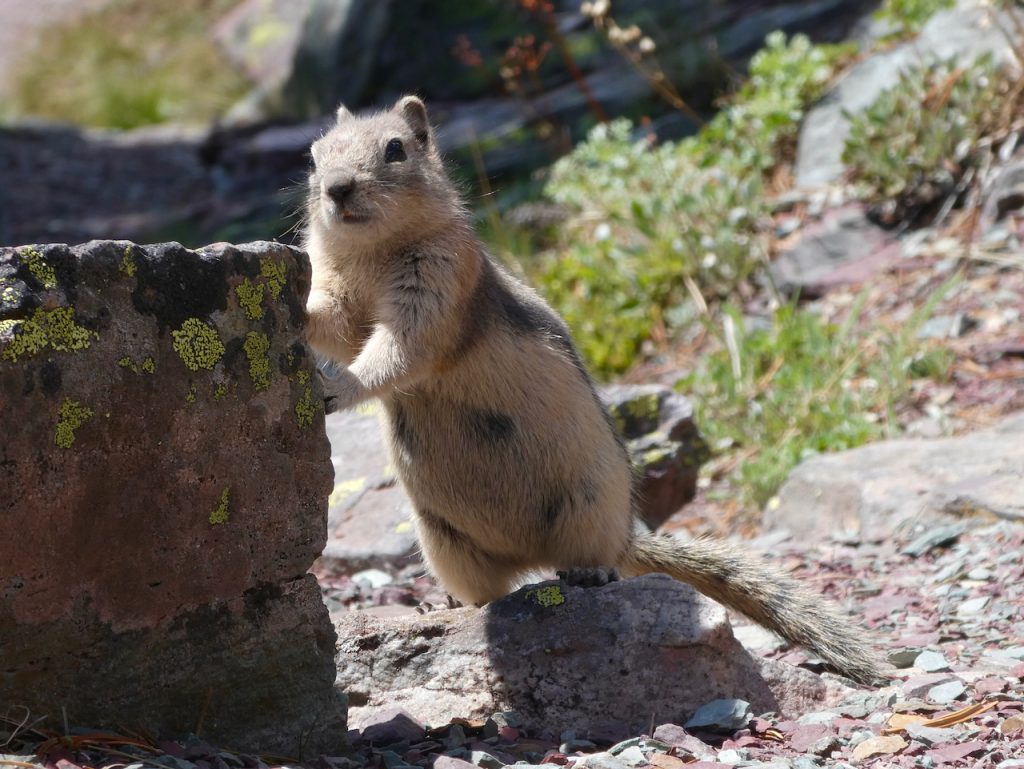
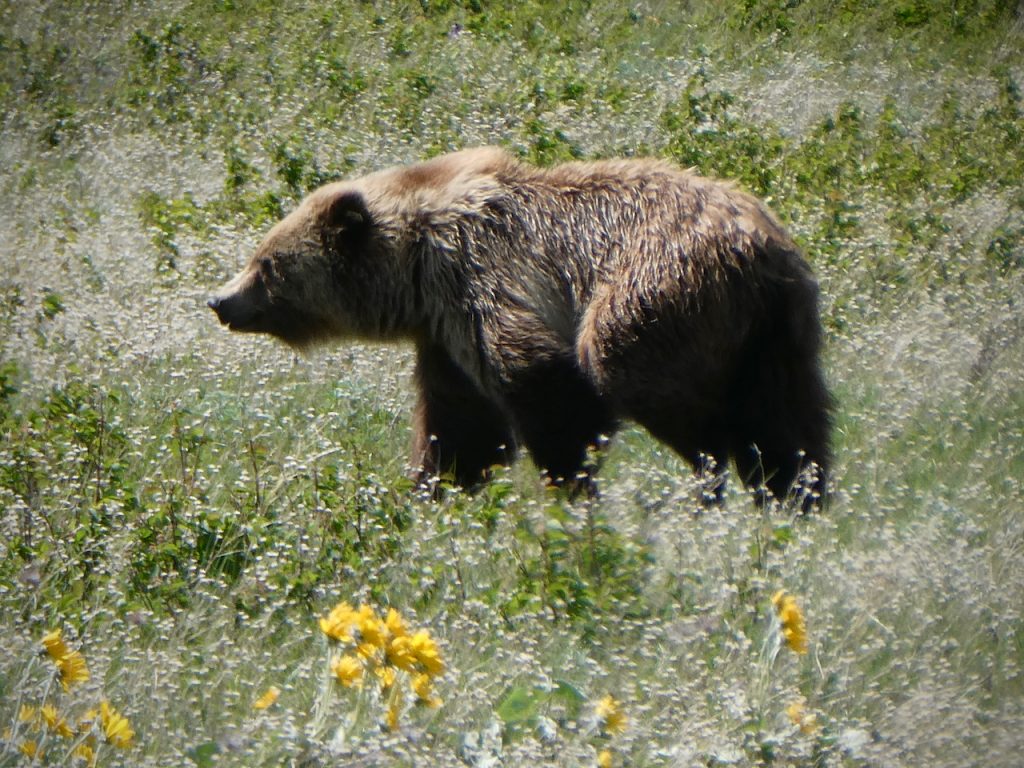
Wir unternehmen noch weitere Radtouren. Die erste Hälfte ist immer recht anstrengend, dafür macht dann die zweite Hälfte umso mehr Spaß und wir lassen es bergab ordentlich „krachen“. Auch unseren Freund, den Grizzly, sehen wir wieder. Wir fahren dann noch für eine Nacht auf den ziemlich abseits gelegenen Cut Bank Campground. Eigentlich ist Ewald nach den Regularien etwa 1,5 m zu lang, um da hin zu dürfen, aber wir hoffen auf die Milde der Ranger.
We do more bike rides. The first half is always quite exhausting, but the second half is so much fun and we let it roll (really fast) downhill. We also see our friend the grizzly again. We then drive to the rather remote Cut Bank Campground for one more night. Actually, according to the regulations, Ewald is about 5 feet too long to be allowed there, but we hope for the leniency of the rangers.
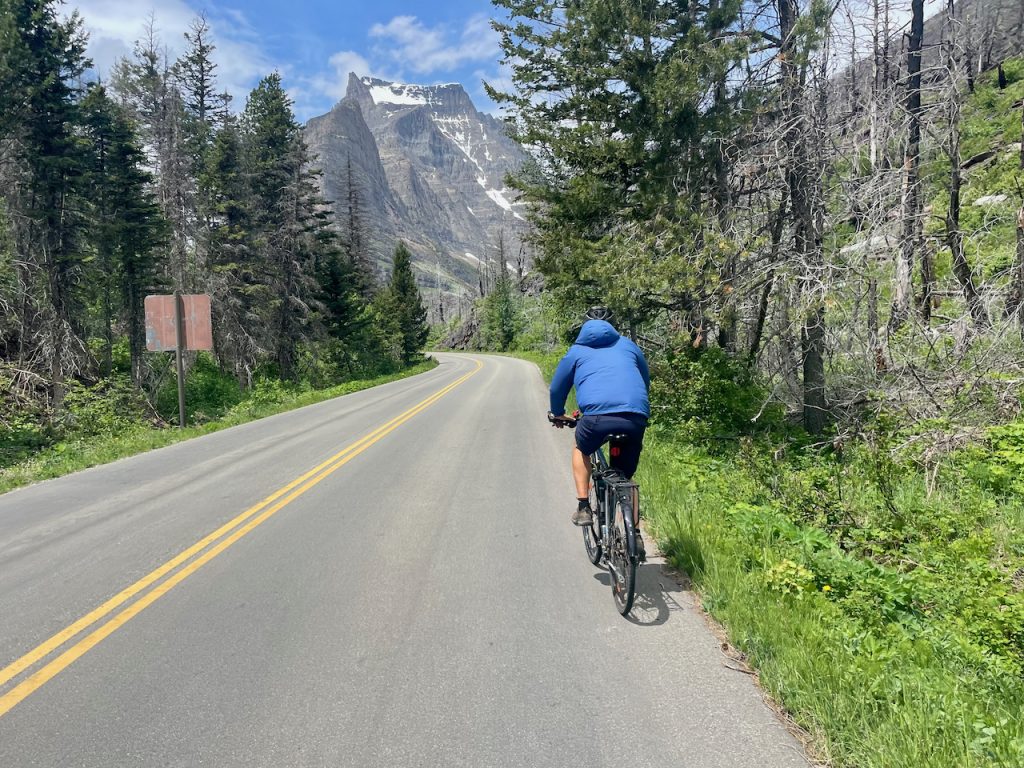
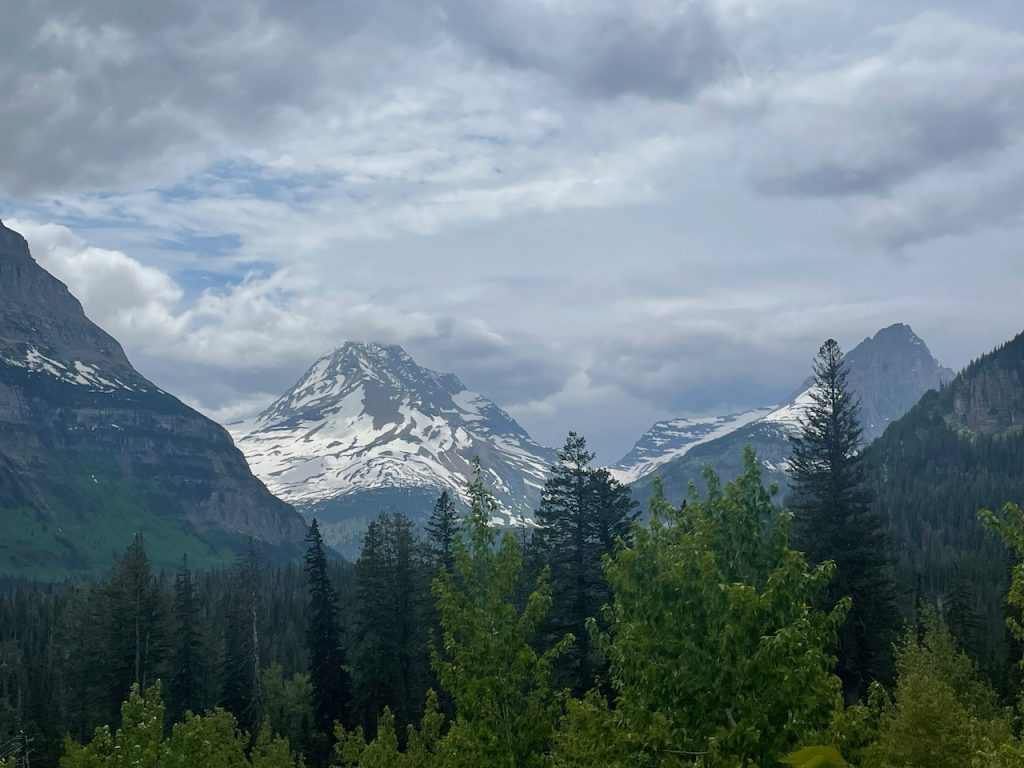
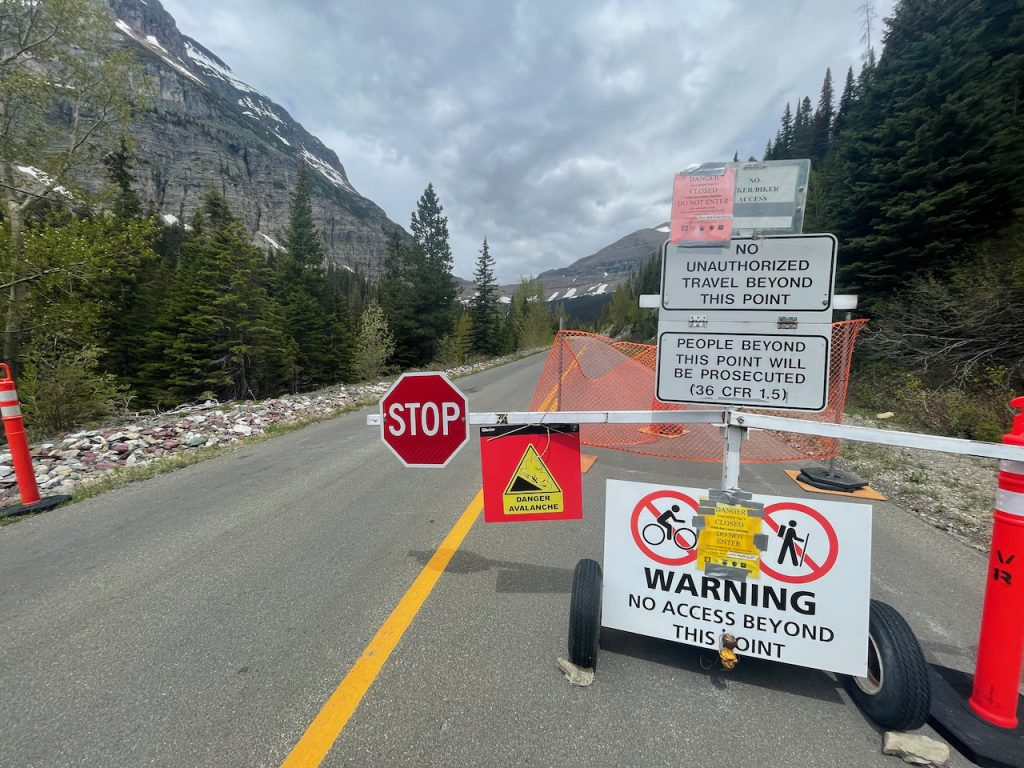
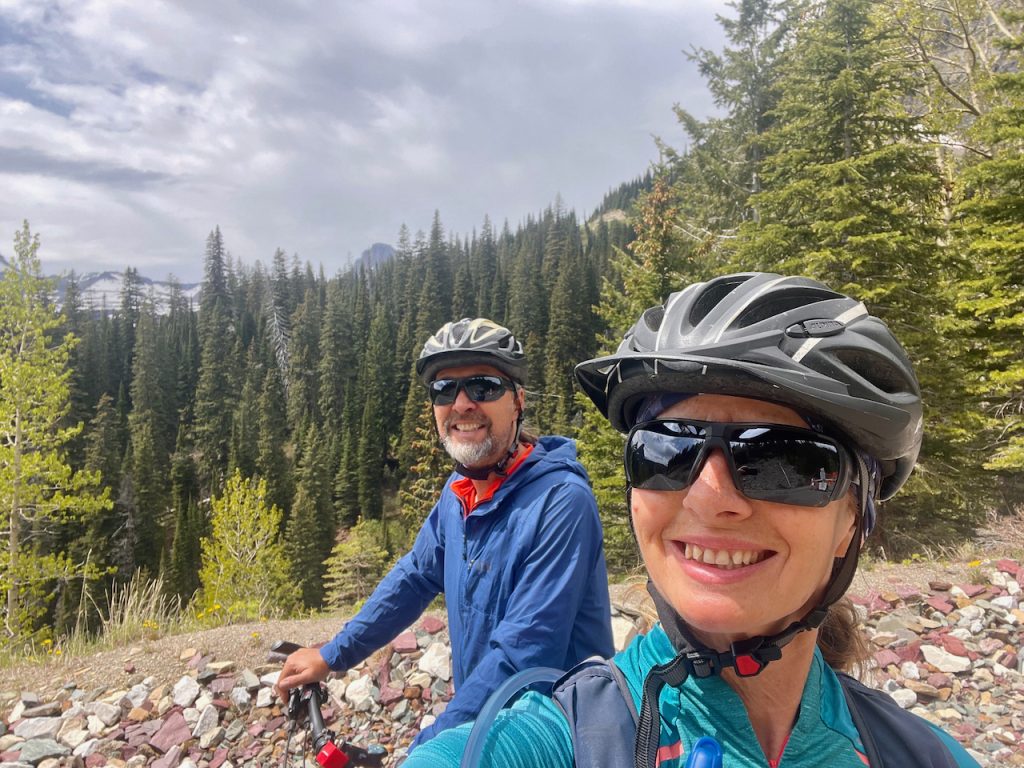
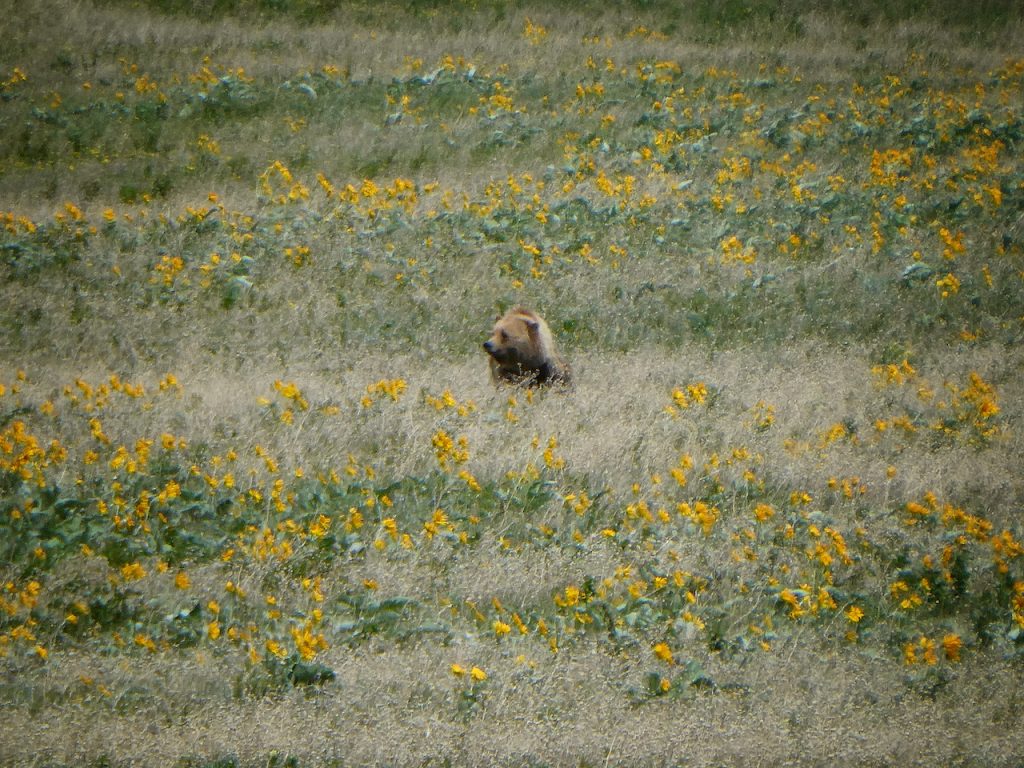
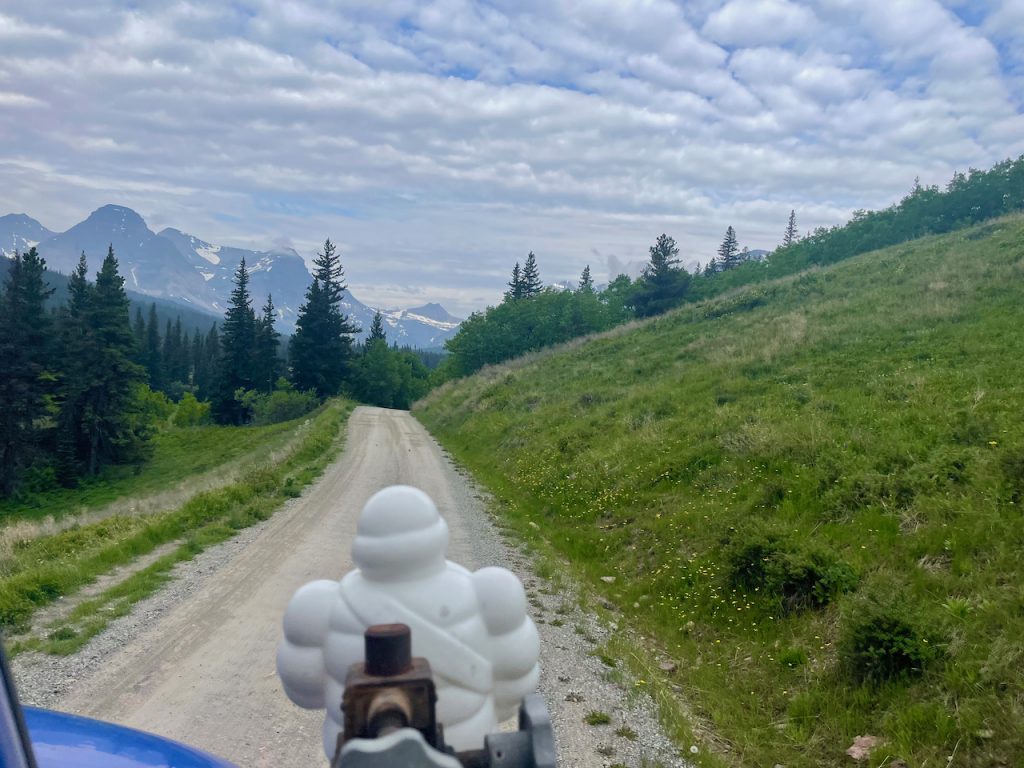
Das Wetter ist jetzt ein wenig durchwachsen aber gerade recht zum Wandern. Außer uns sind nur noch zwei junge Männer aus der Gegend unterwegs. Wir wandern zum Medicine Grizzly Lake (was für ein Name) und sehen unterwegs den „Tripple Divide Peak“. Der 2.444 m hohe Berg ist die weltweit einzige (so lernen wir es) dreifach Wasserscheide. Hier wird das Wasser in drei unterschiedliche Weltmeere abgeleitet, dem Nordmeer, dem Atlantik und dem Pazifik. IRRE! Wir sehen auch jede Menge Bären-Kacke, soviel das es uns ein wenig nervös macht. Wir sehen einen Elch, der ist zu schnell und wir zu erschrocken zum fotografieren. Und auf dem Rückweg treffen wir auch die Jungs wieder, die wegen eines Grizzlies umdrehen mussten. Alles in allem spannend.
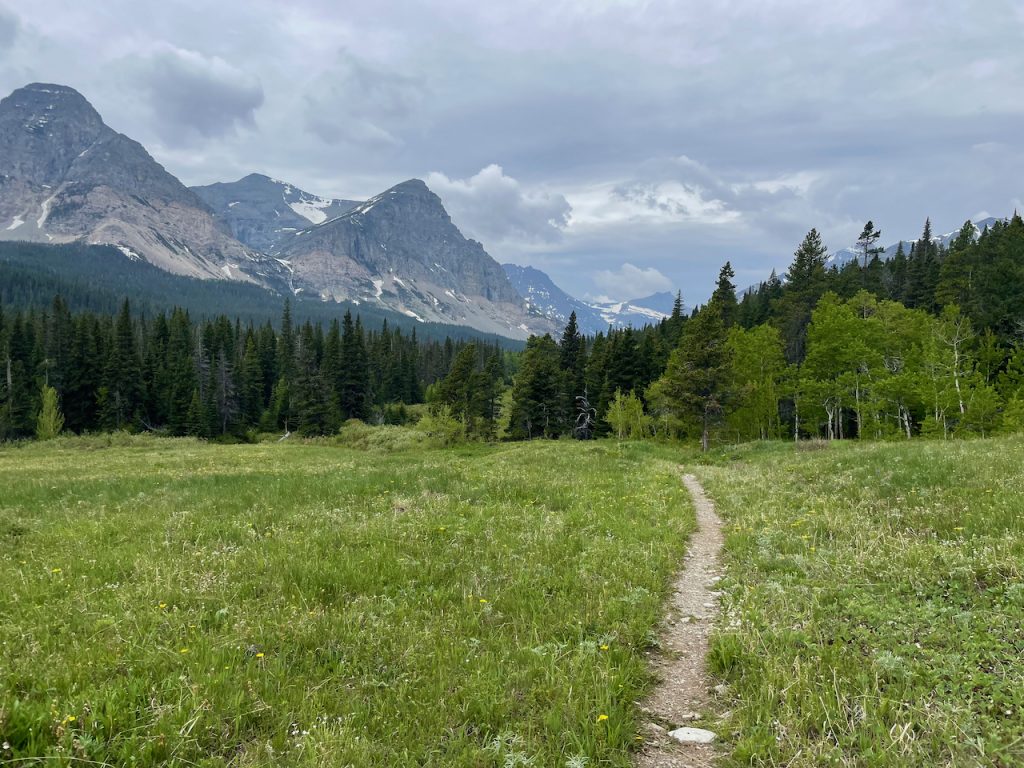
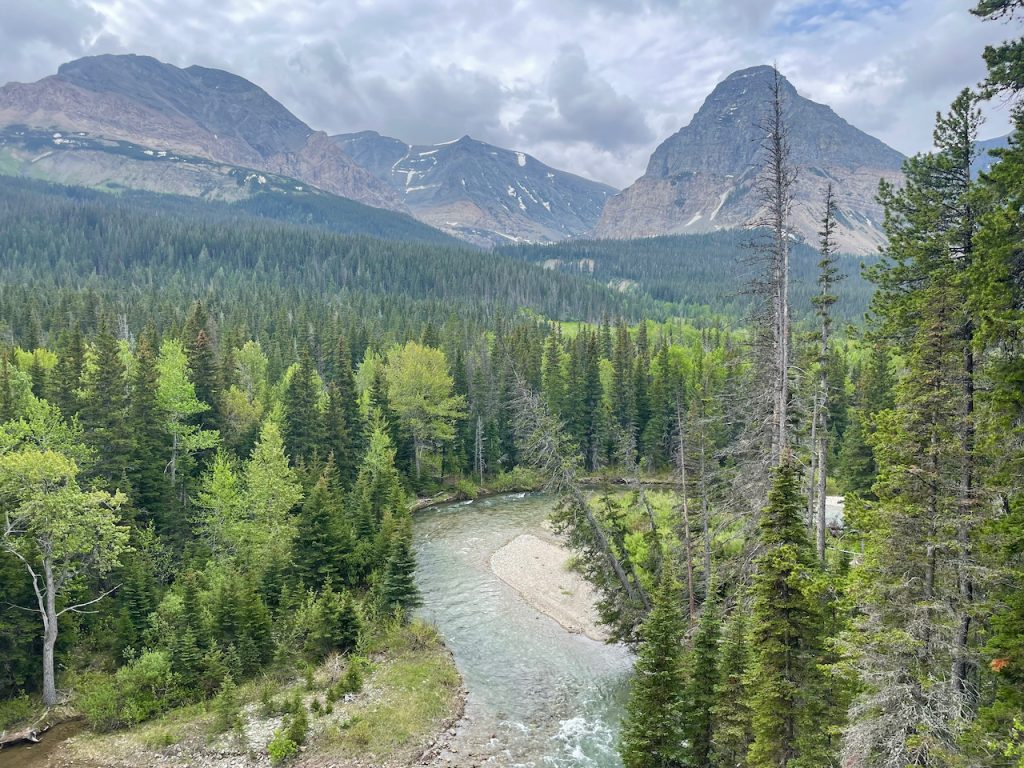
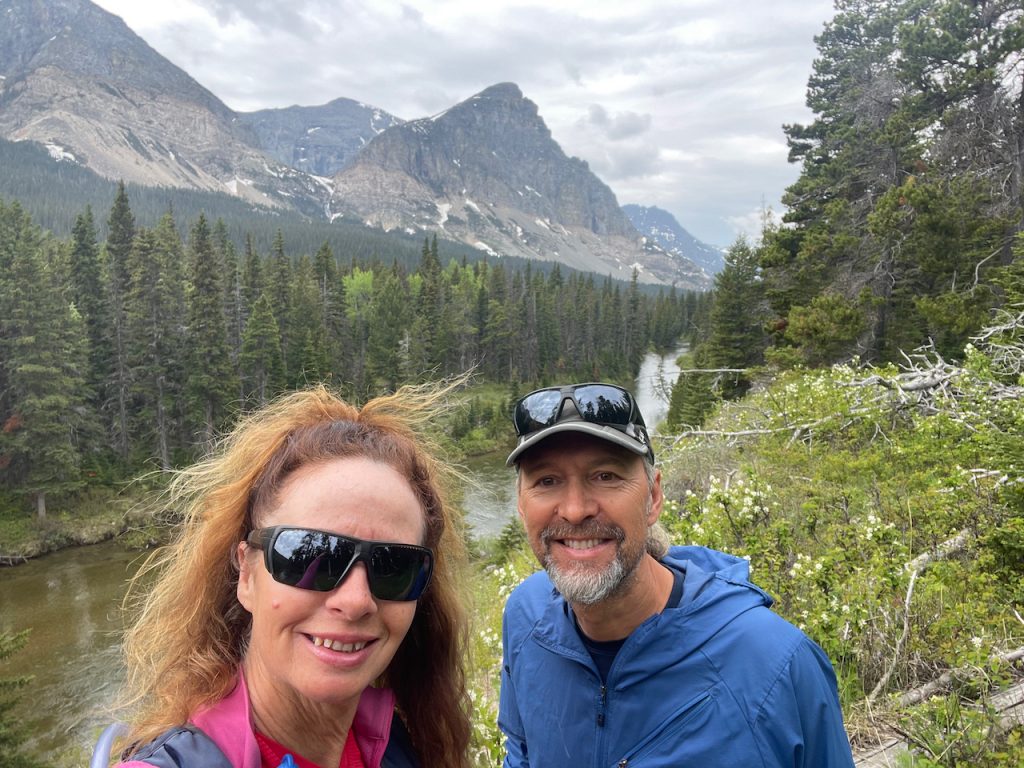
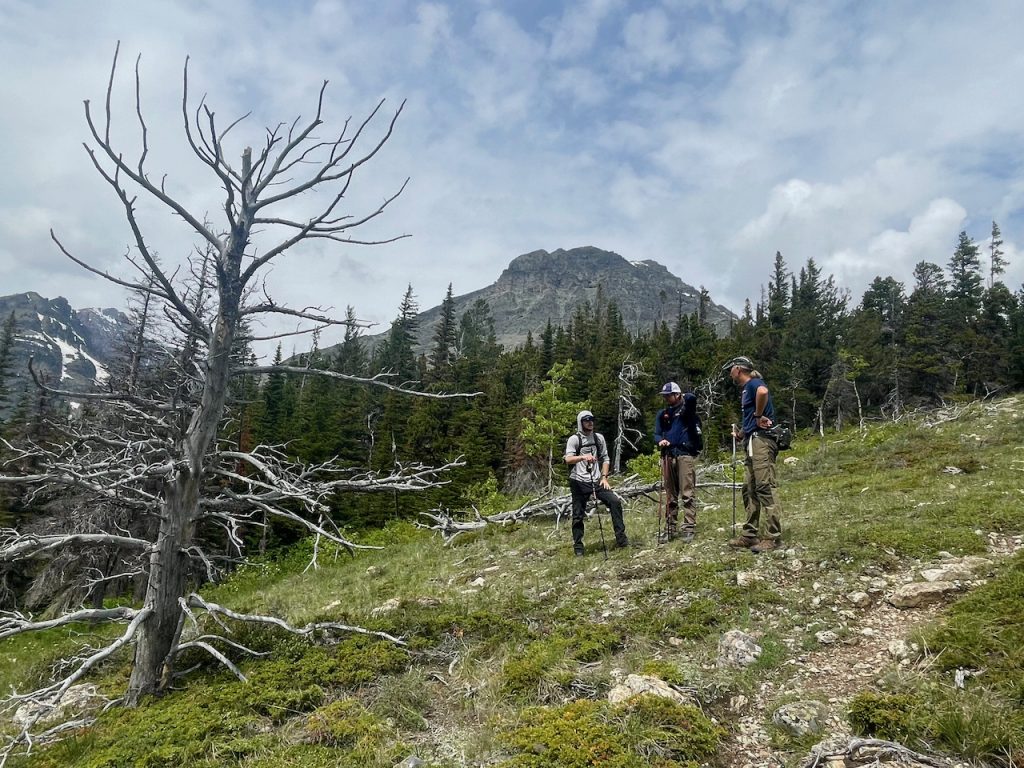
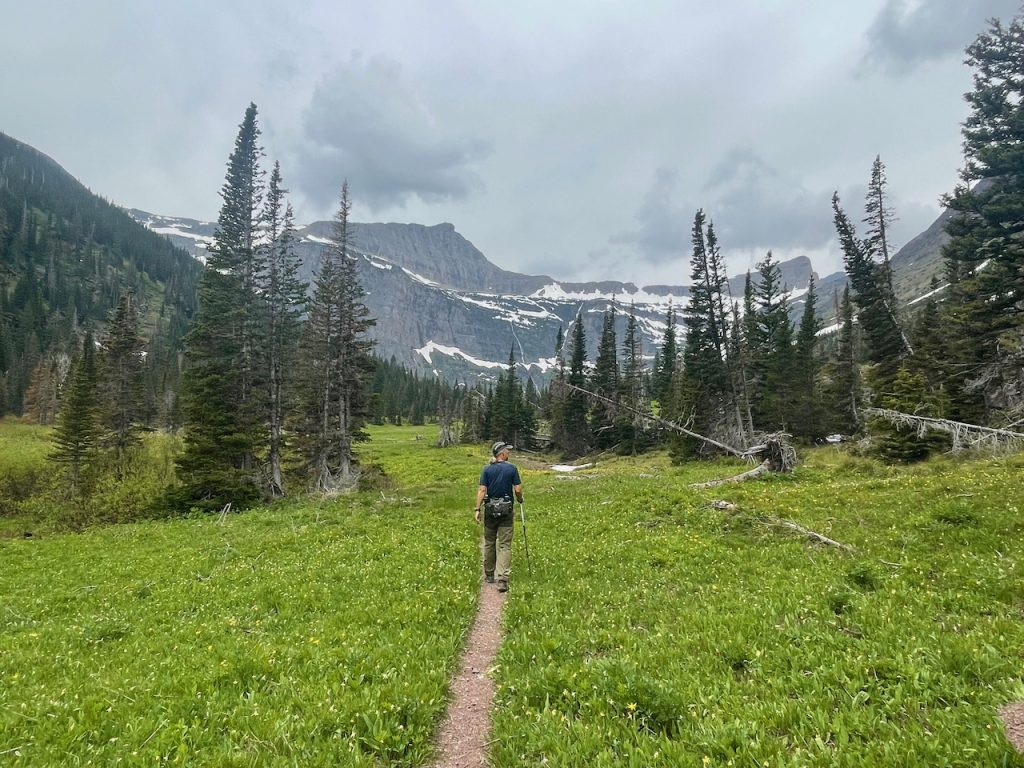
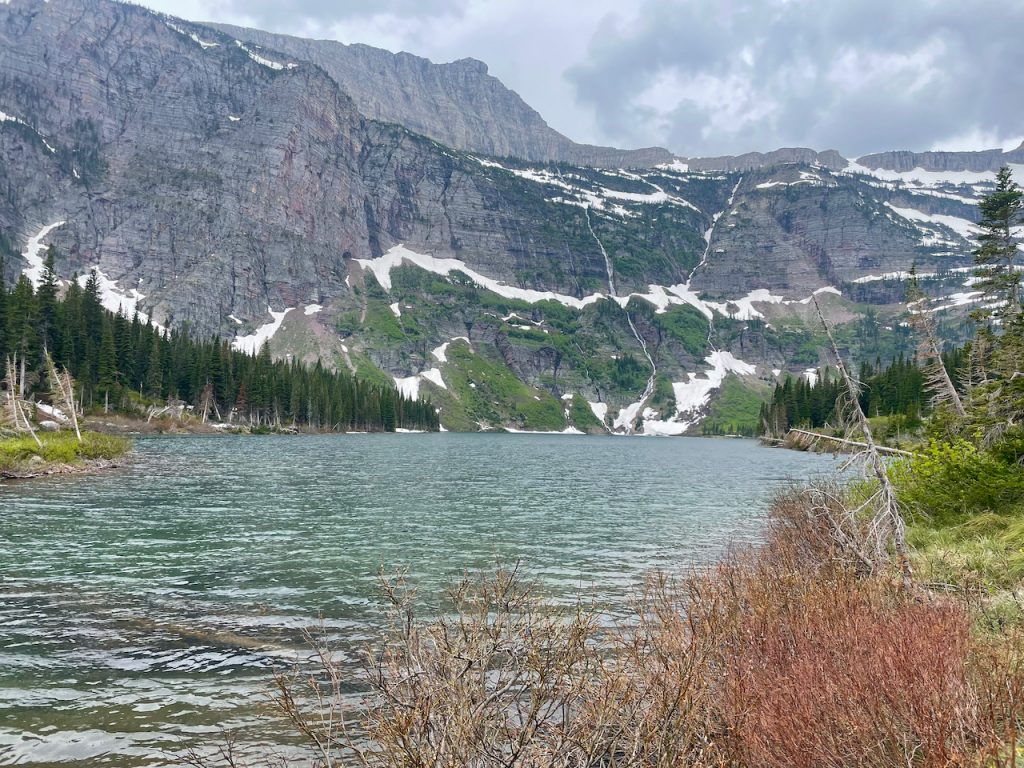
The weather is now a bit mixed but just right for hiking. Apart from us, only two young men from the area are also out for a hike. We hike to Medicine Grizzly Lake (what a name) and see Triple Divide Peak along the way. The 8,018 feet high mountain is the world’s only (as we learned) triple watershed. Here the water is diverted into three different oceans, the Arctic Ocean, the Atlantic Ocean and the Pacific Ocean. CRAZY! We also see a lot of bear poop, enough to make us a little nervous. We see a moose that is too fast and we are too surprised to take a picture. And on the way back we also meet the guys who had to turn around because of a grizzly. All in all exciting.
Spannend sind hier auch die Zecken, die sind etwa 10mal so groß wie die in Europa und es gibt einige davon. Muss man ganz schön aufpassen. Einmal passt Sandie aber nicht gut genug auf und hat tatsächlich eine Zecke am Hinterkopf, vermutlich auf dieser letzten Wanderung eingefangen – vorsichtshalber wird jetzt (2 Wochen später) mal eine kleine Antibiotikum Kur gemacht.
The ticks are also exciting here, they are about 10 times the size of those in Europe and there are quite a few of them. You have to be really careful. But once Sandie didn’t pay enough attention and actually caught a tick on the back of her head, probably on this last hike – as a precaution (2 weeks later) a small antibiotic cure is now being taken.
Wir verbringen den letzten Abend in den USA noch mal auf dem St. Mary Campground und befassen uns gedanklich und internet technisch mit Alberta. Wir wurden ja schon von Freunden vorgewarnt, aber Alberta ist echt verrückt. Sie haben diverse „Systeme“ und für alles braucht man Permits. Dort gibt es einmal die Nationalparks, dann die Alberta Parks und dann noch die Public bzw. Crown Lands. Und für alle braucht man was unterschiedliches. Wir haben uns aber durchgekämpft und (hoffentlich) alles richtig geordert.
We spend the last evening in the USA again at the St. Mary Campground and deal mentally and technically with Alberta. We’ve been warned by friends, but Alberta is really crazy. They have various „park systems“ and you need permits for everything. There are the national parks, then the Alberta parks and then the public and crown lands. And everything needs something different. But we fought our way through and (hopefully) ordered everything correctly.
Am 03.06. reisen wir nach Kanada ein. Es ist nichts los an der Grenzstation und zunächst ist auch gar kein Grenzbeamter anwesend. Lustig. Er taucht dann aber auf und nach 2-3 Fragen sind wir 3 Minuten später in Alberta. Wir steuern zunächst Cardston an, da wir erst mal die Kühlschränke wieder füllen müssen. Am nächsten Tag geht es 60 km weiter nach Waterton Lakes Nationalpark – der kanadischen Schwester des (US) Glacier Nationalparks. Gletscher gibt es hier, wie auch im US Teil nur sehr wenige und sehr traurige Überreste. Der Waterton NP ist ganz und gar bezaubernd. Wir bleiben insgesamt 5 Nächte und fahren eigentlich nur am letzten Tag, weil es da anfängt zu regnen. Wir unternehmen viel und bekommen Besuch von Trish und Doug aus Calgary, die wir vor fast 4 Jahren im östlichen Kanada kennen gelernt haben.
On June 3rd we enter Canada. Nothing is going on at the border station and initially there are no border officials present. Funny. But then an officer shows up and after 2-3 questions we are in Alberta 3 minutes later. We head for Cardston first, because we have to refill our fridges. The next day we drive about 40 miles to Waterton Lakes National Park – the Canadian sister of the (US) Glacier National Park. Glaciers here, as well as in the US part, are very few and very sad remains. Waterton NP is utterly enchanting. We stay a total of 5 nights and actually only leave on the last day because it starts raining. We do a lot and get a visit from Trish and Doug from Calgary, who we met in eastern Canada almost 4 years ago.
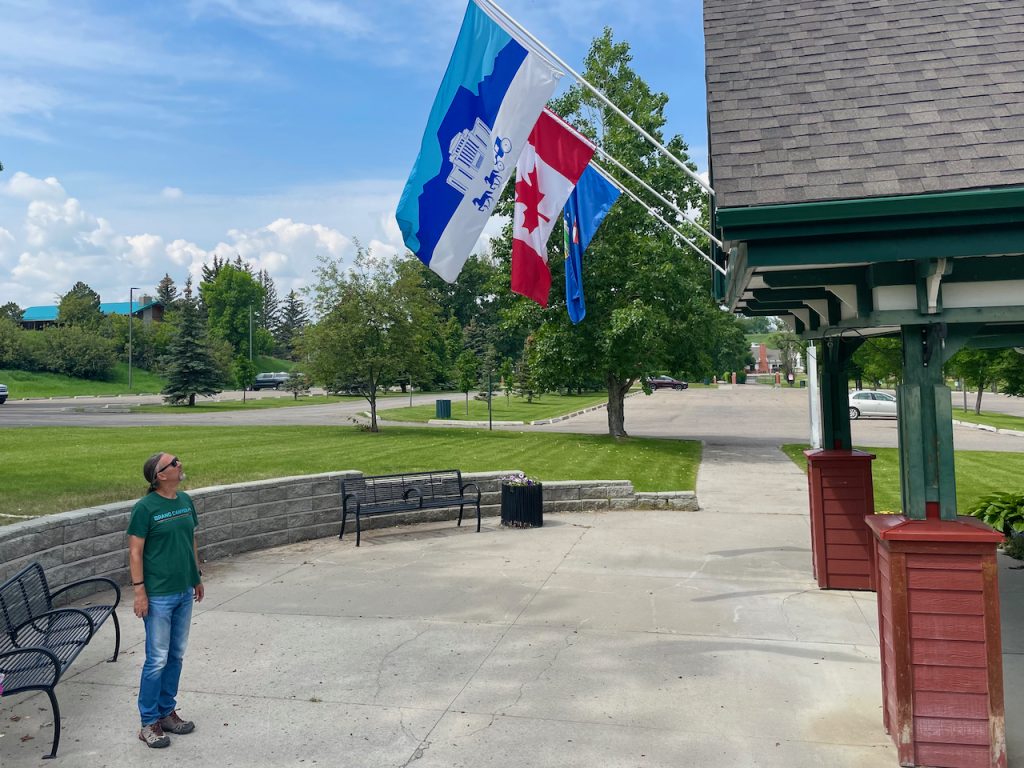
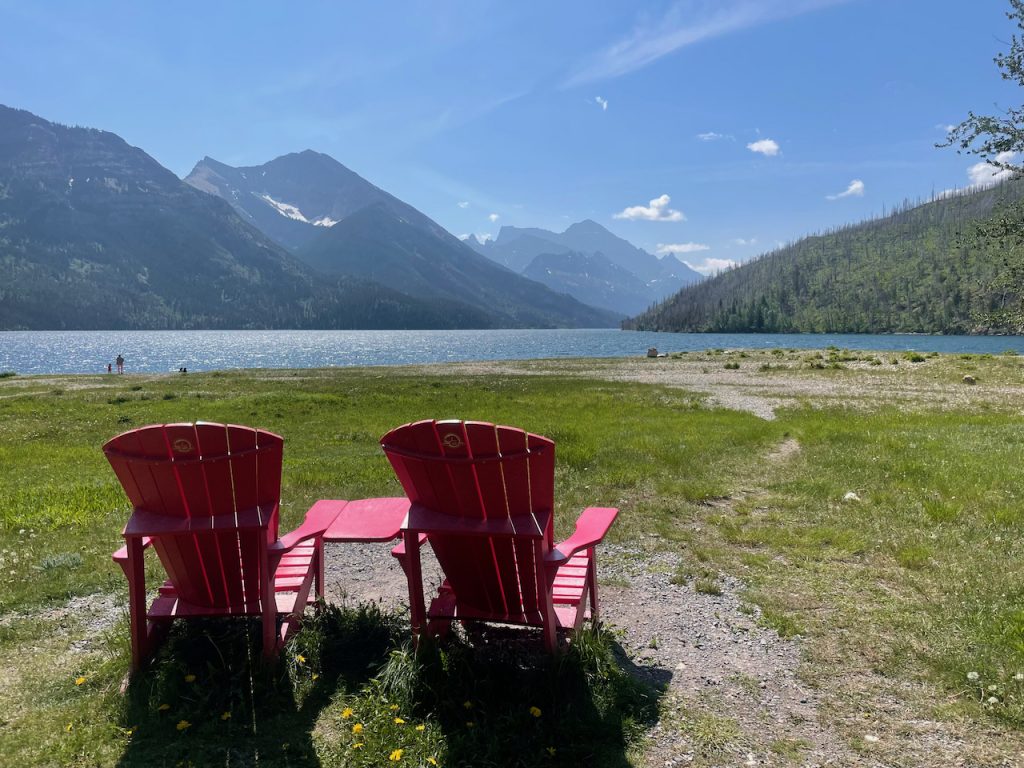
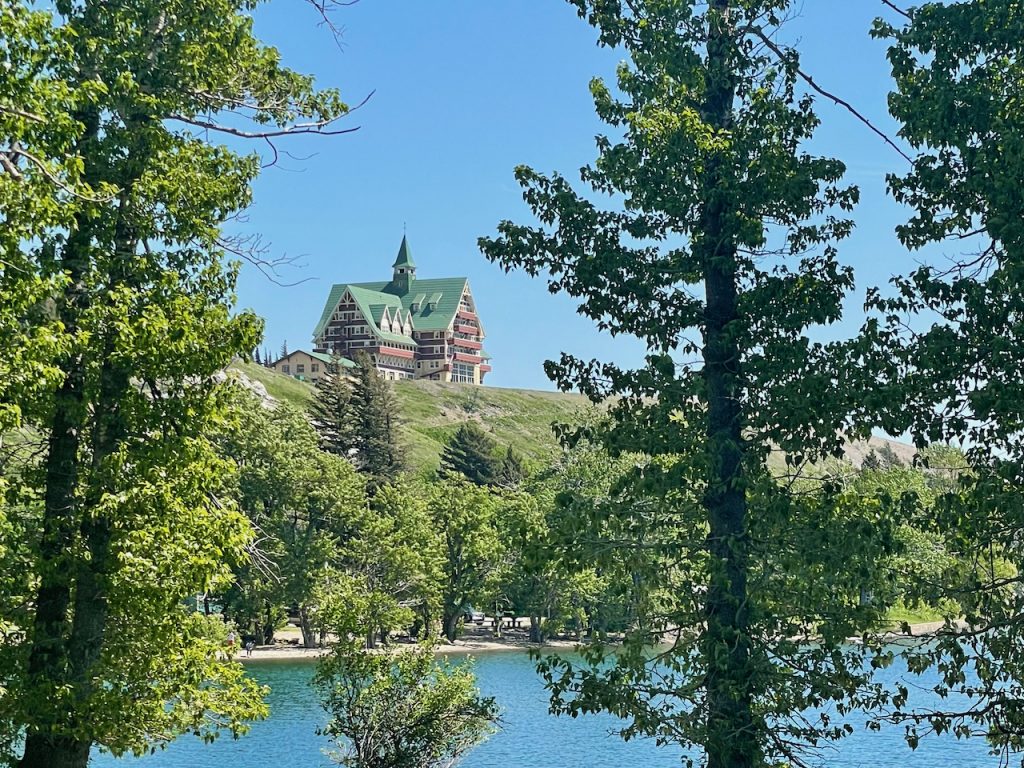
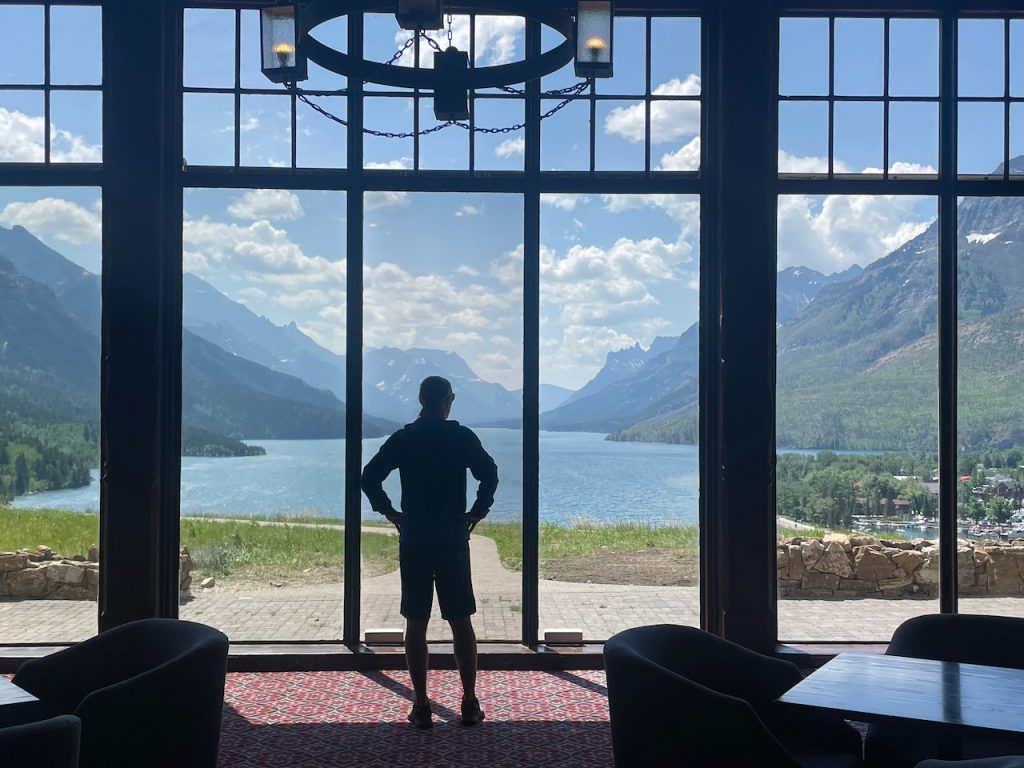
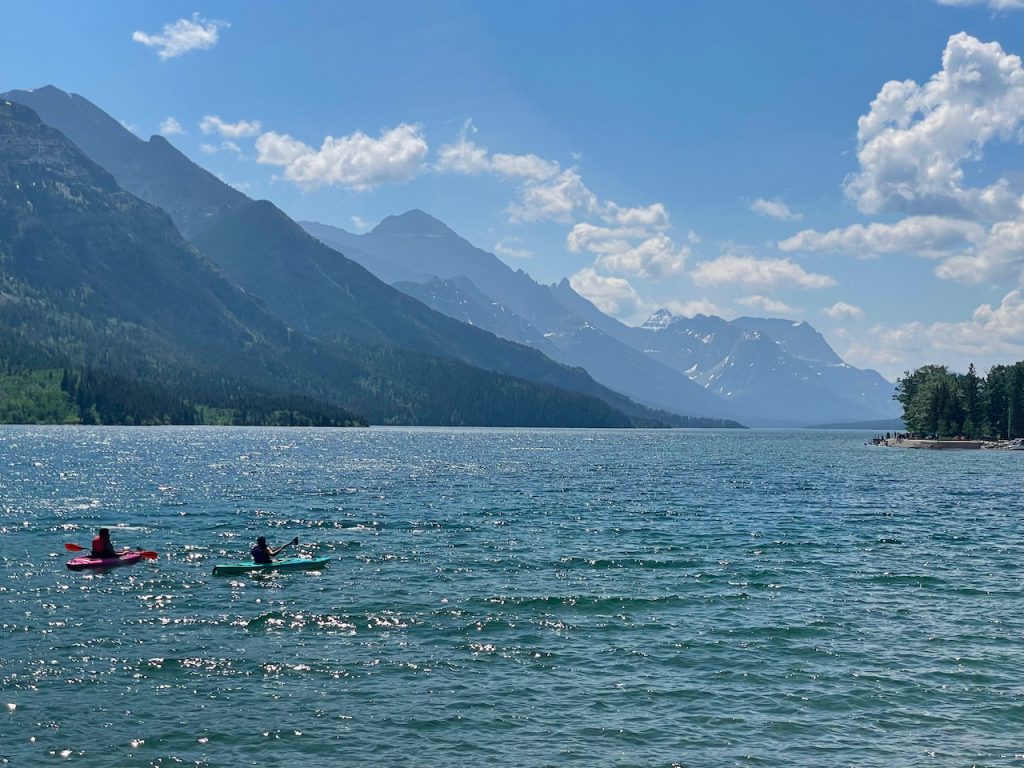
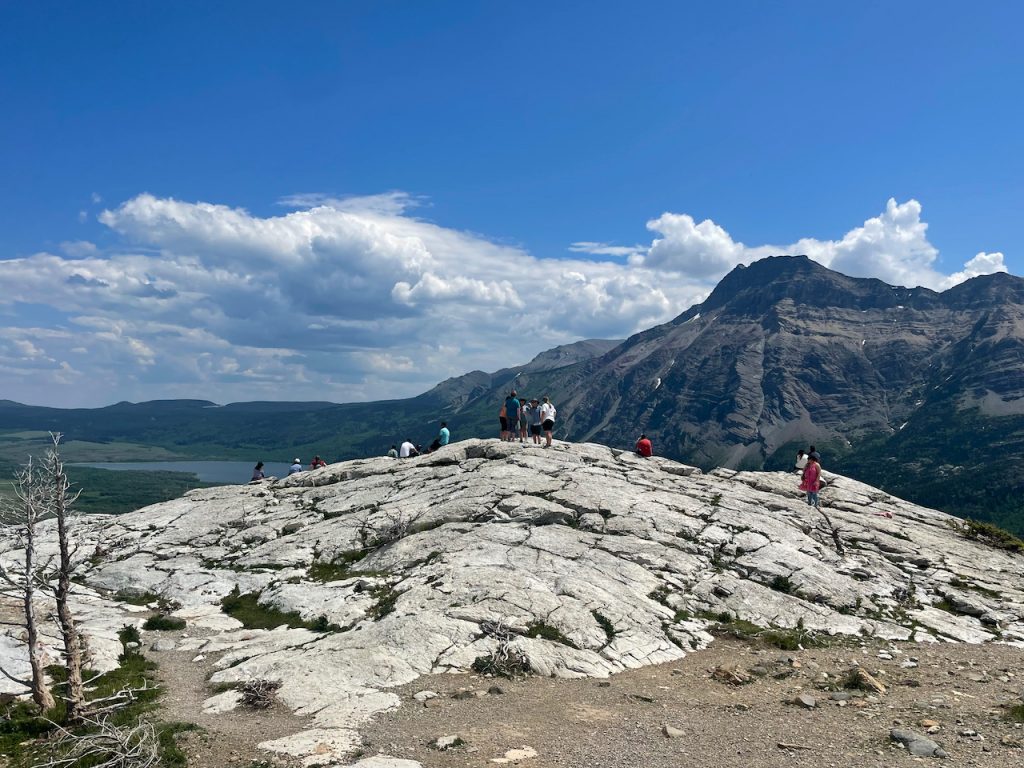
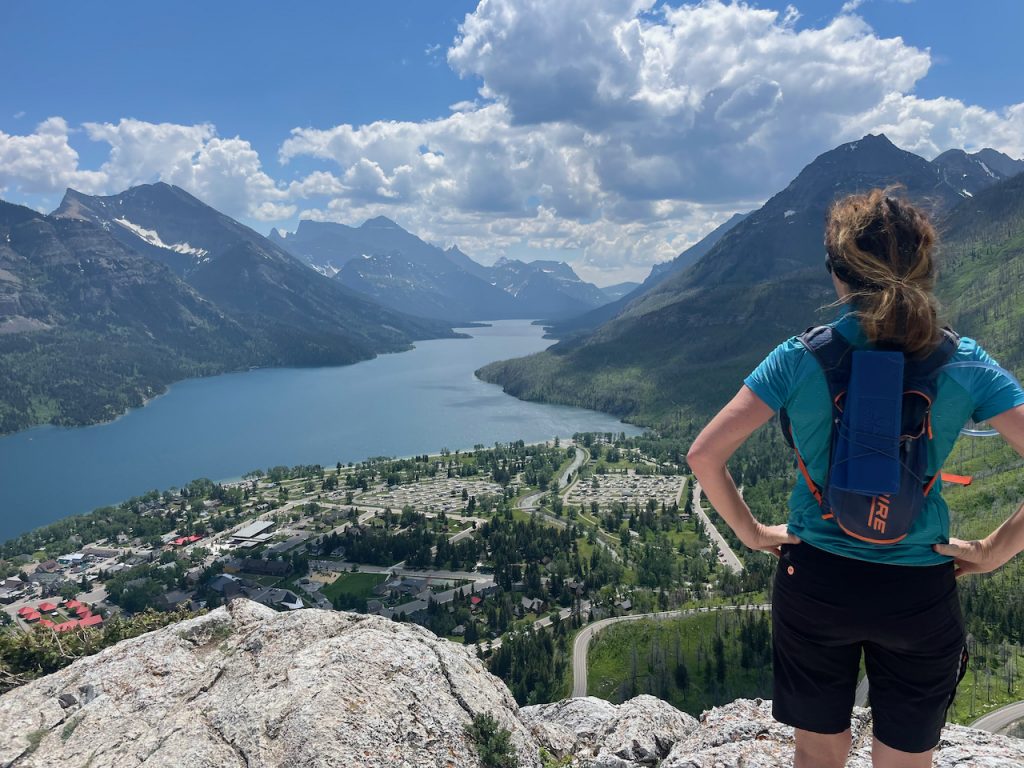
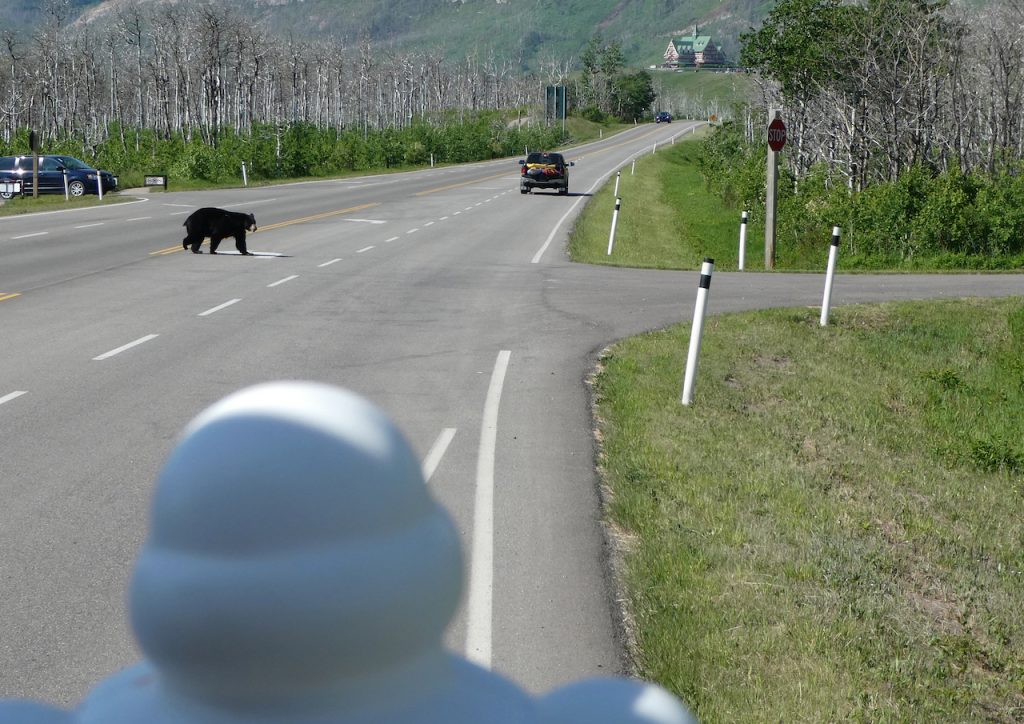
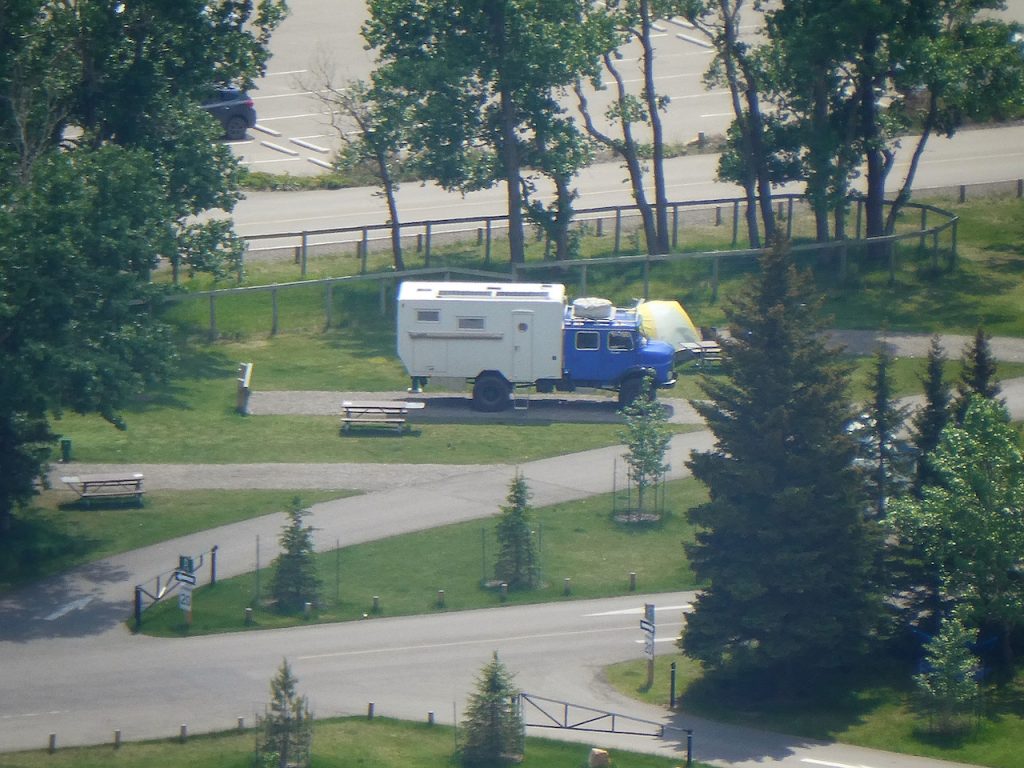
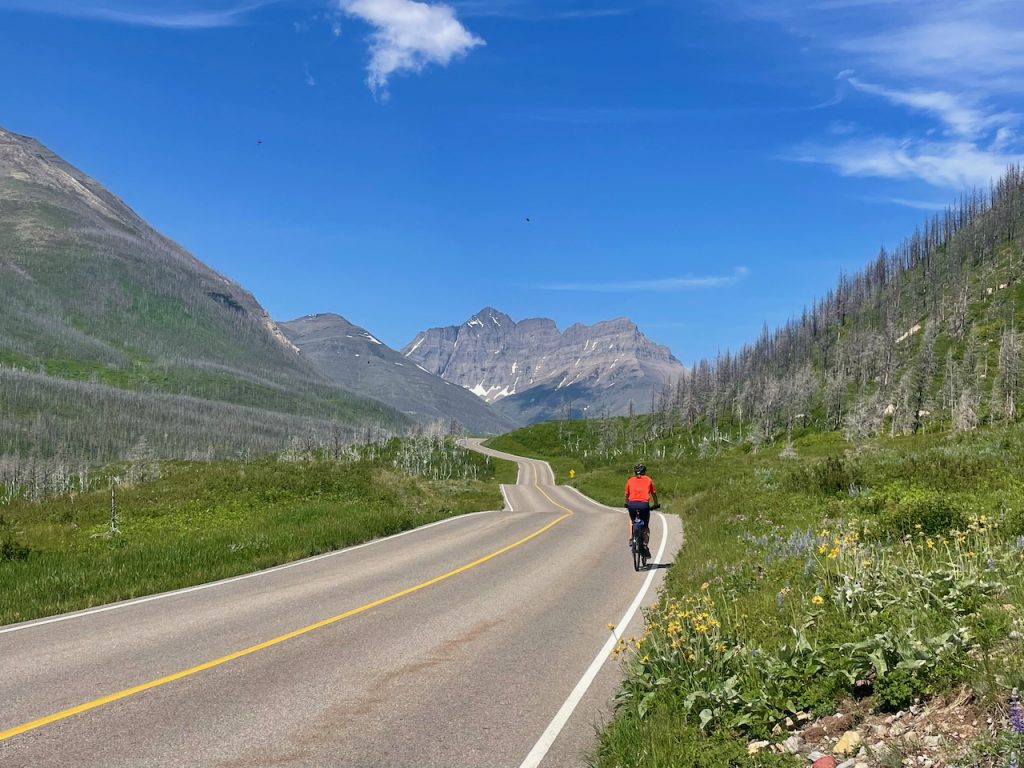
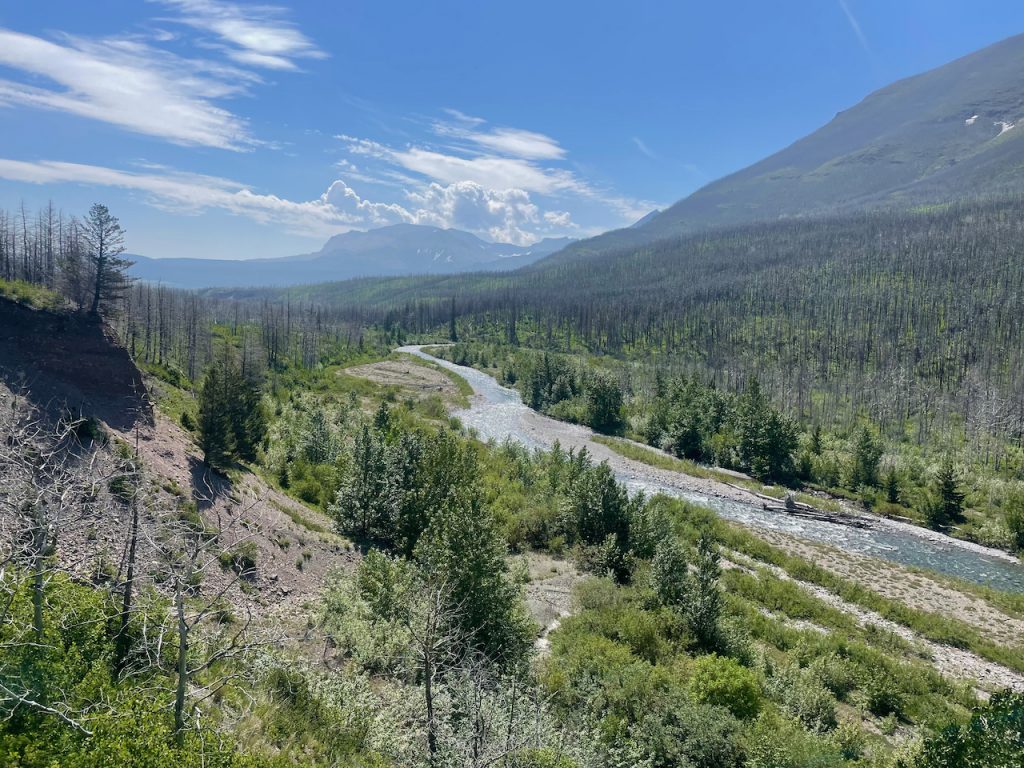
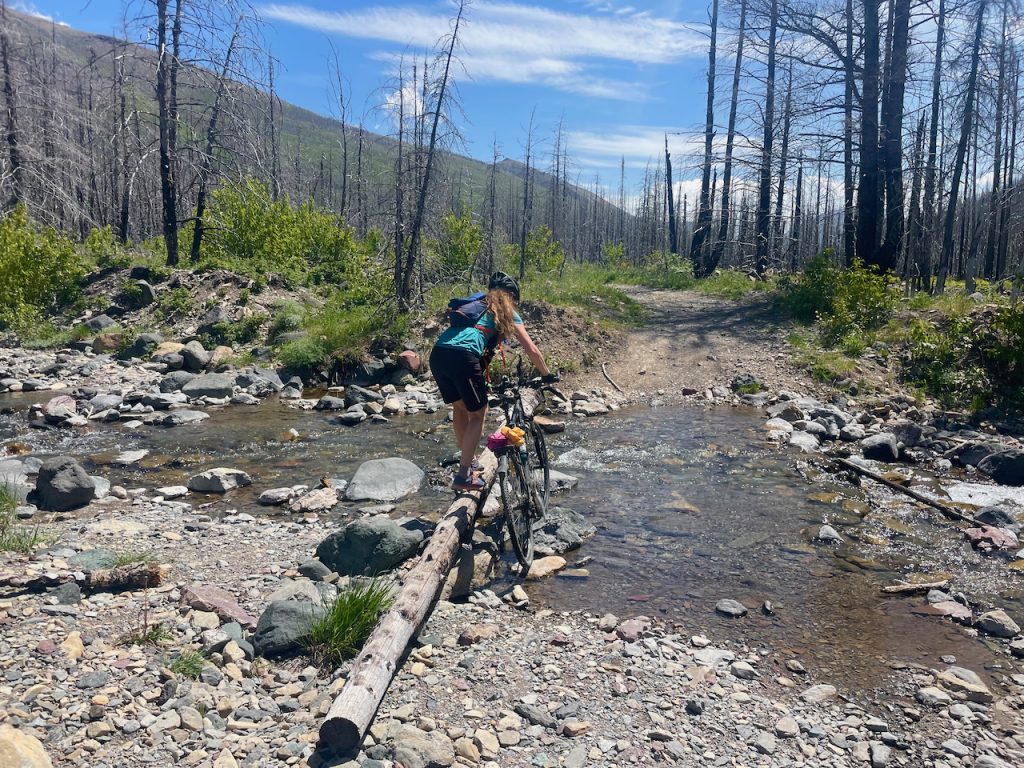
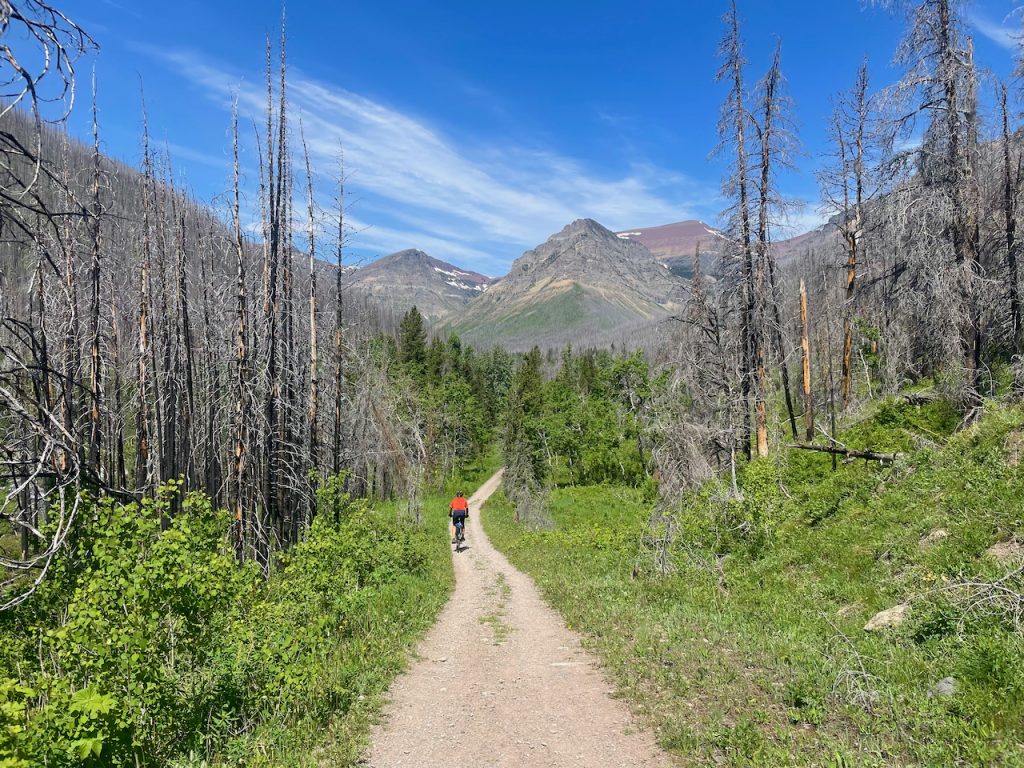
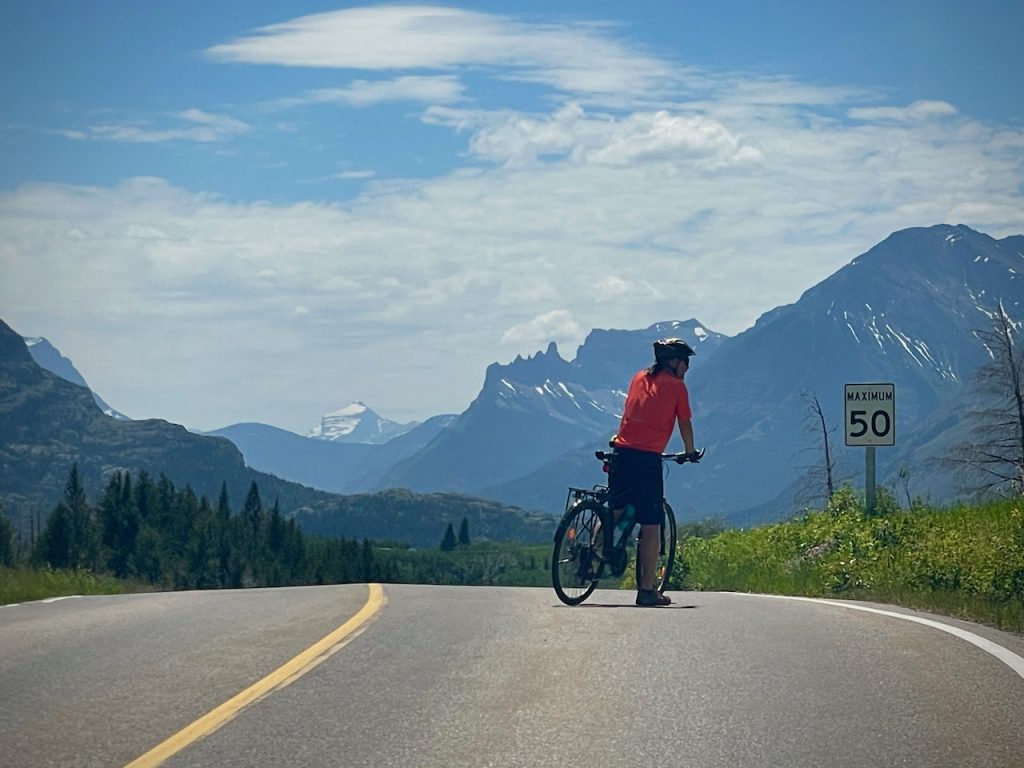
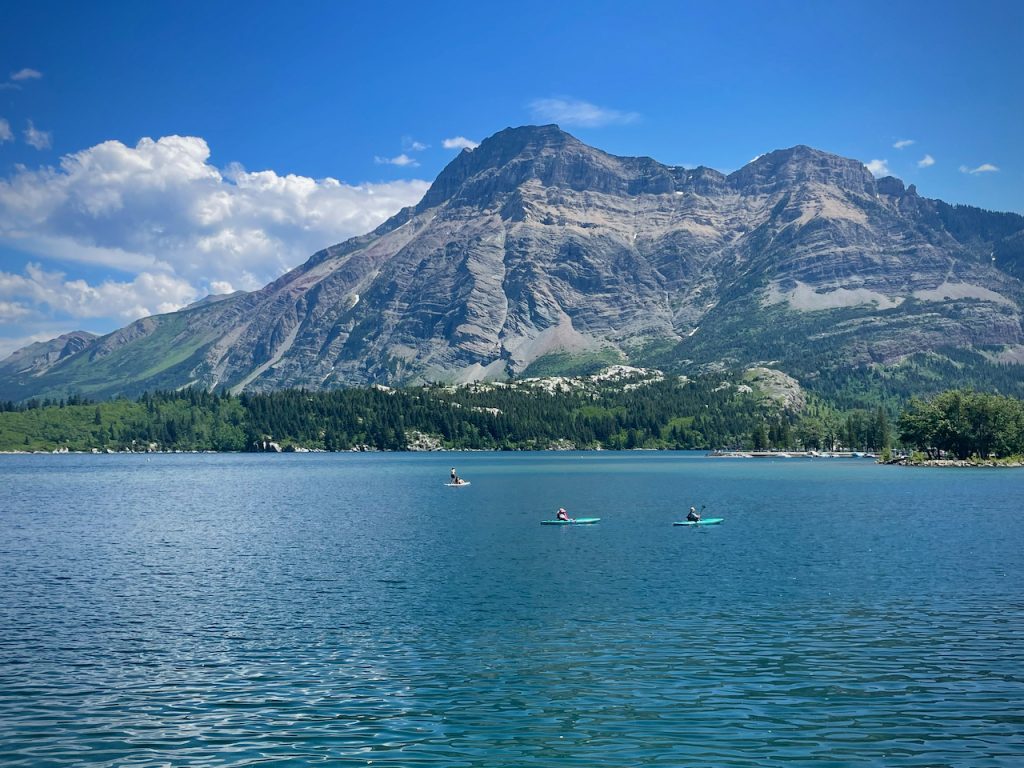
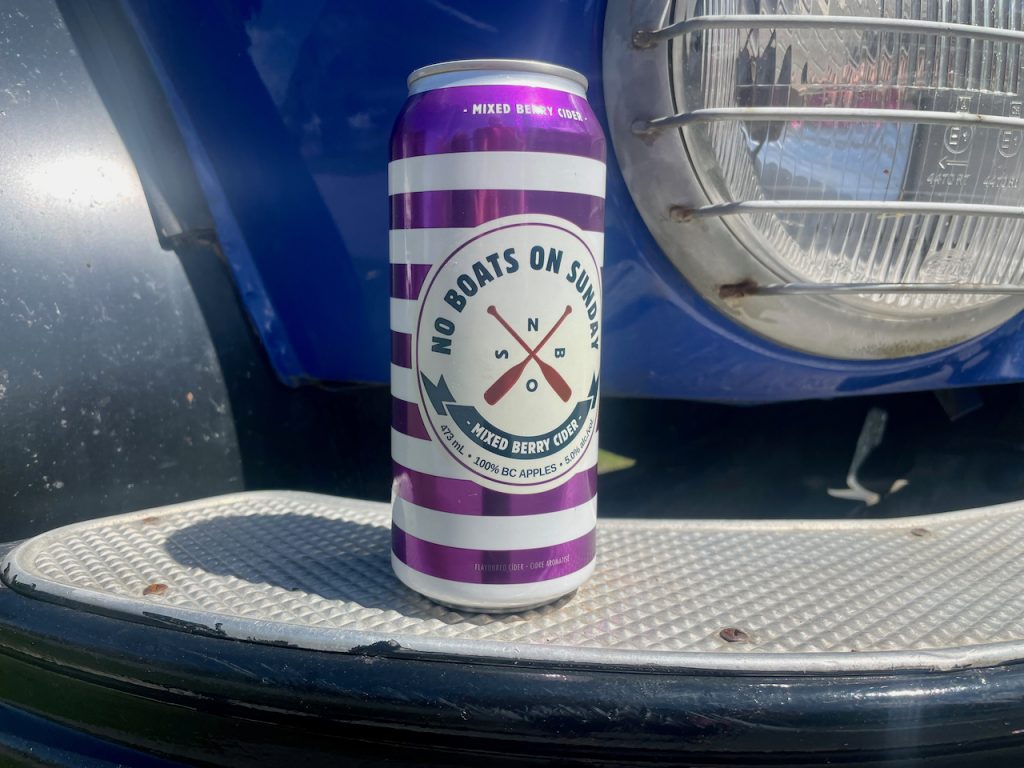
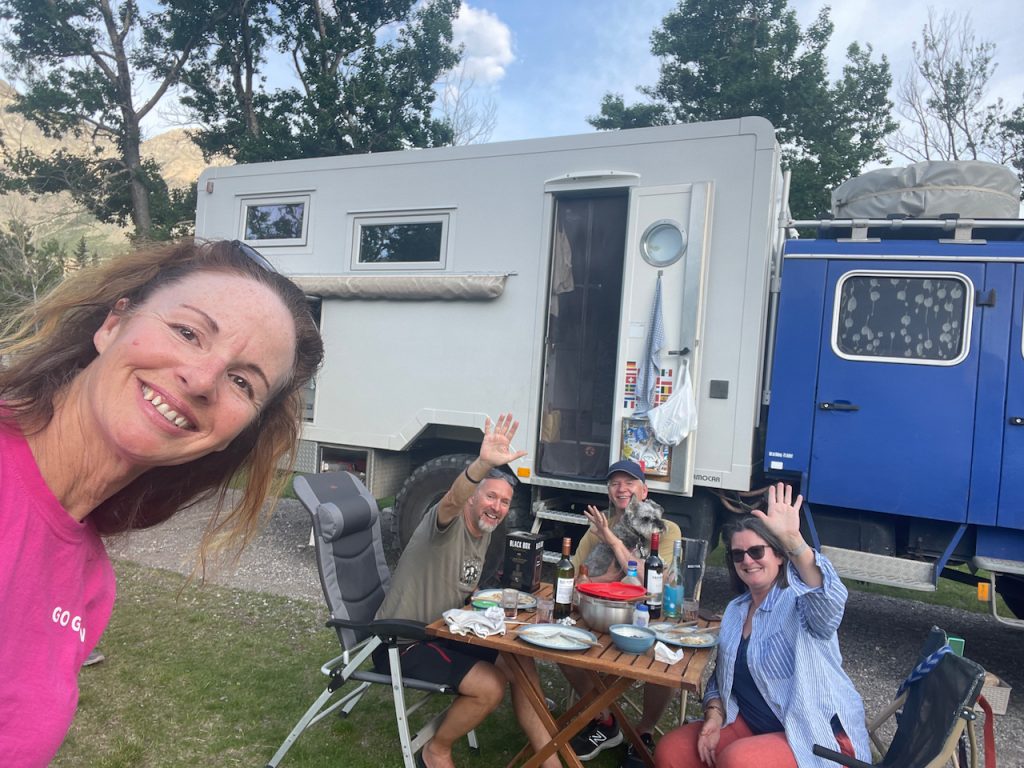
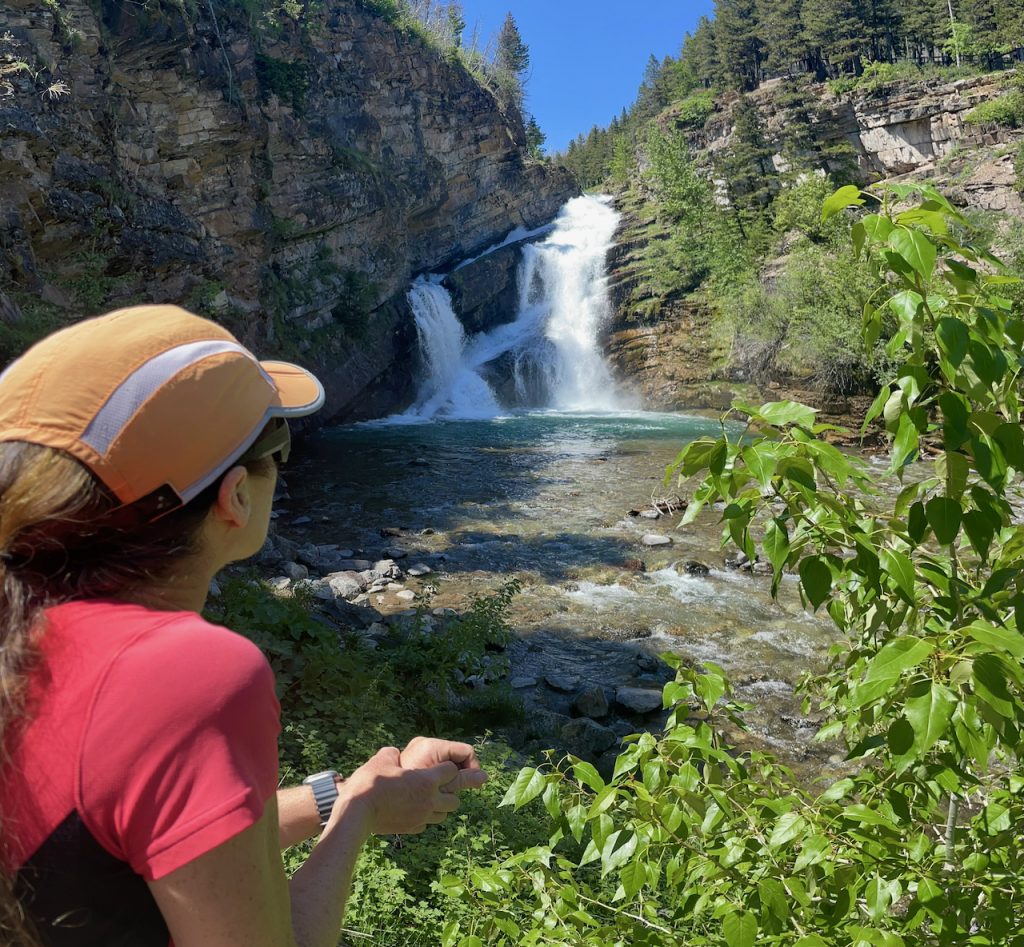
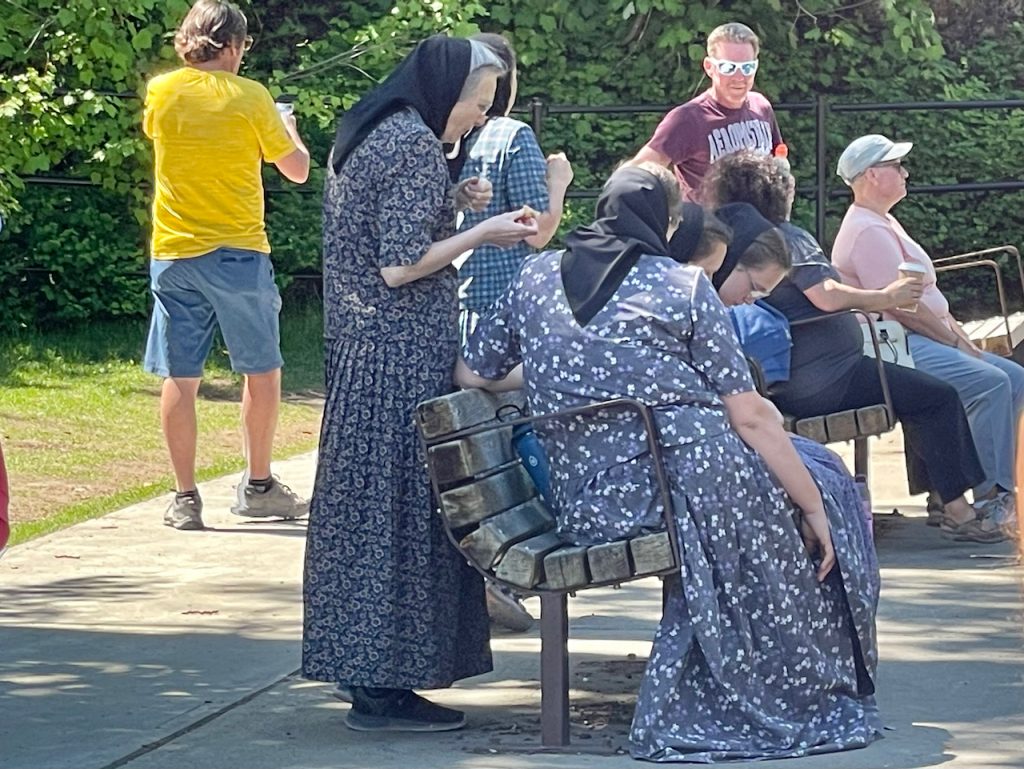
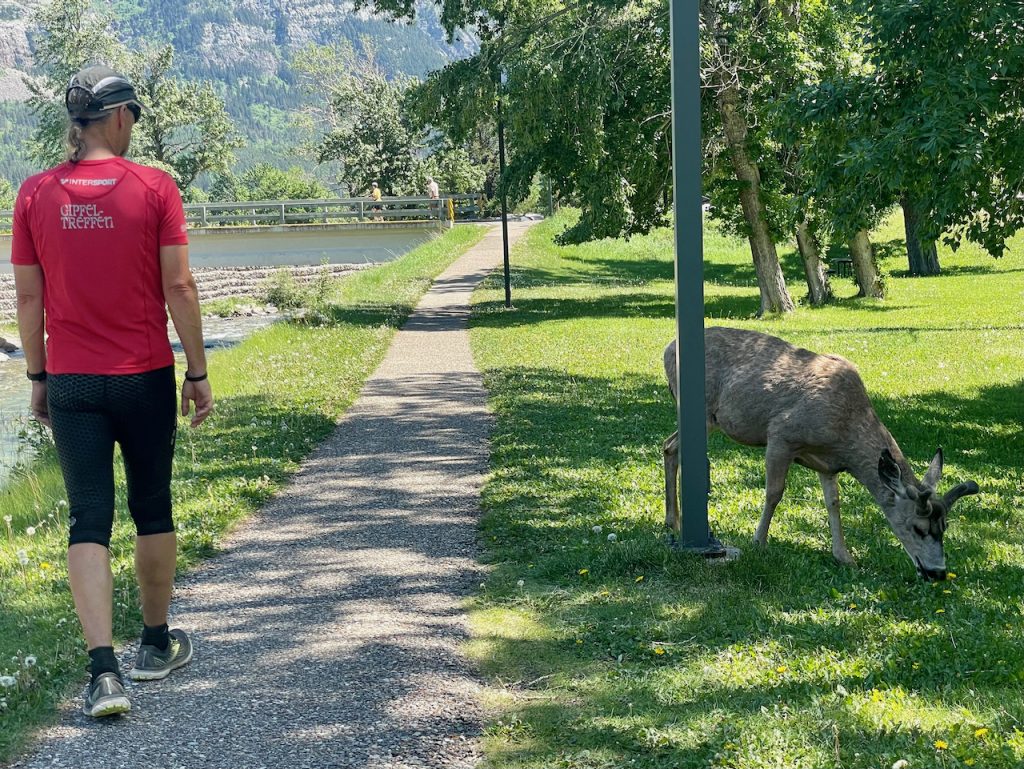
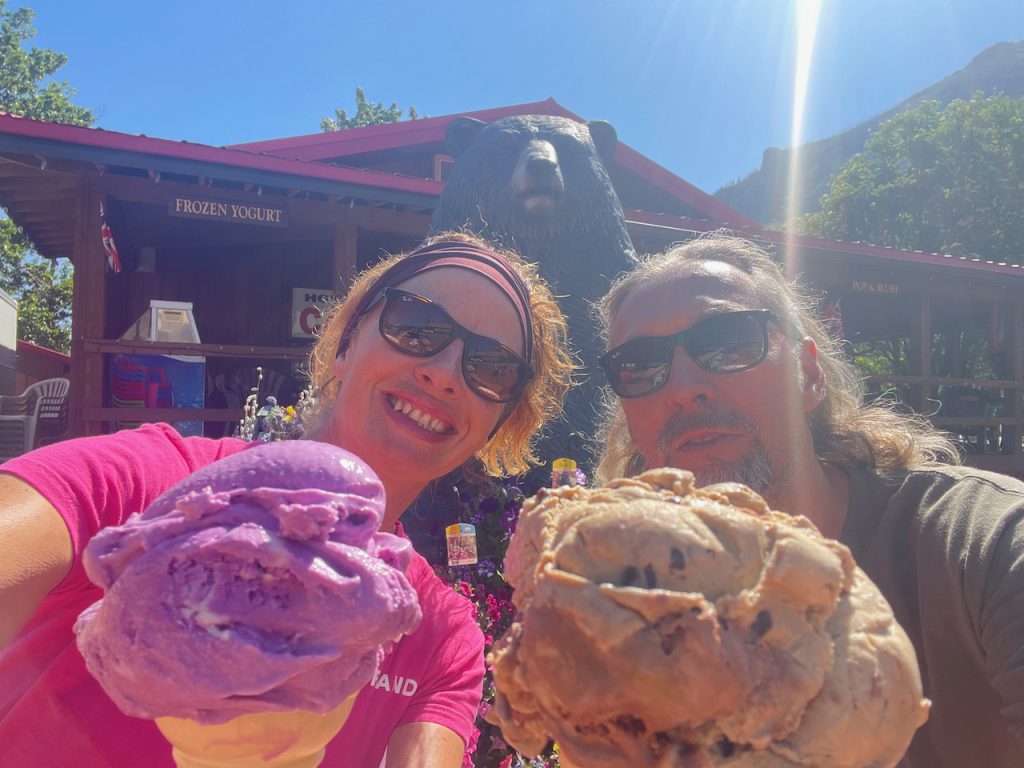
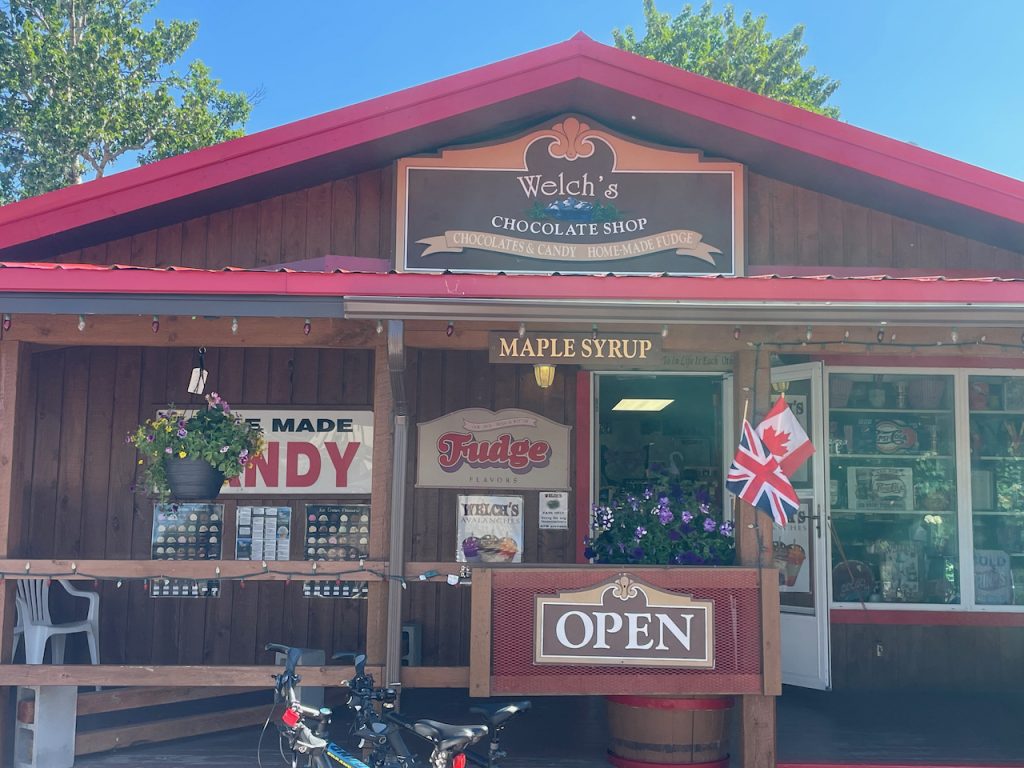
Auch hier ist noch Nebensaison und noch nicht viel los. Wir radeln viel und unternehmen kleinere und größere Wanderungen. Das Highlight ist die 6 stündige und 19km lange Wanderung zum „Crypt Lake“. Morgens um 9 Uhr bringt uns, und 30 weitere Wanderer, ein Boot auf die andere Uferseite des Upper Waterton Sees und schon nach kurzer Zeit auf dem Wanderweg sieht man kaum noch andere Wanderer. Wir kommen an teilweise spektakulären Wasserfällen vorbei und die letzten 1,5 km haben es mit einer Leiter, einem natürlichen Tunnel und einem 200 Meter Abgrund, an dem man sich an einem Stahlseil entlang hangeln muss, echt in sich. Sandie singt viel und laut und gemeinsam meistern wir das Abenteuer. Vielen Dank für den tollen Tip an Christin und Paul.
It’s still the off-season here too and not much going on yet. We cycle a lot and go on short and long hikes. The highlight is the 6 hour and 12 mile hike to „Crypt Lake“. At 9am a boat takes us and 30 other hikers to the other side of Upper Waterton Lake and before long we hardly see any other hikers. We pass waterfalls, some of them are spectacular, and the last mile is really tough with a ladder, a natural tunnel and a 660 feet chasm where you have to shimmy along a steel cable. Sandie sings a lot and loudly and together we master the adventure. Many thanks for the great tip to Christin and Paul.
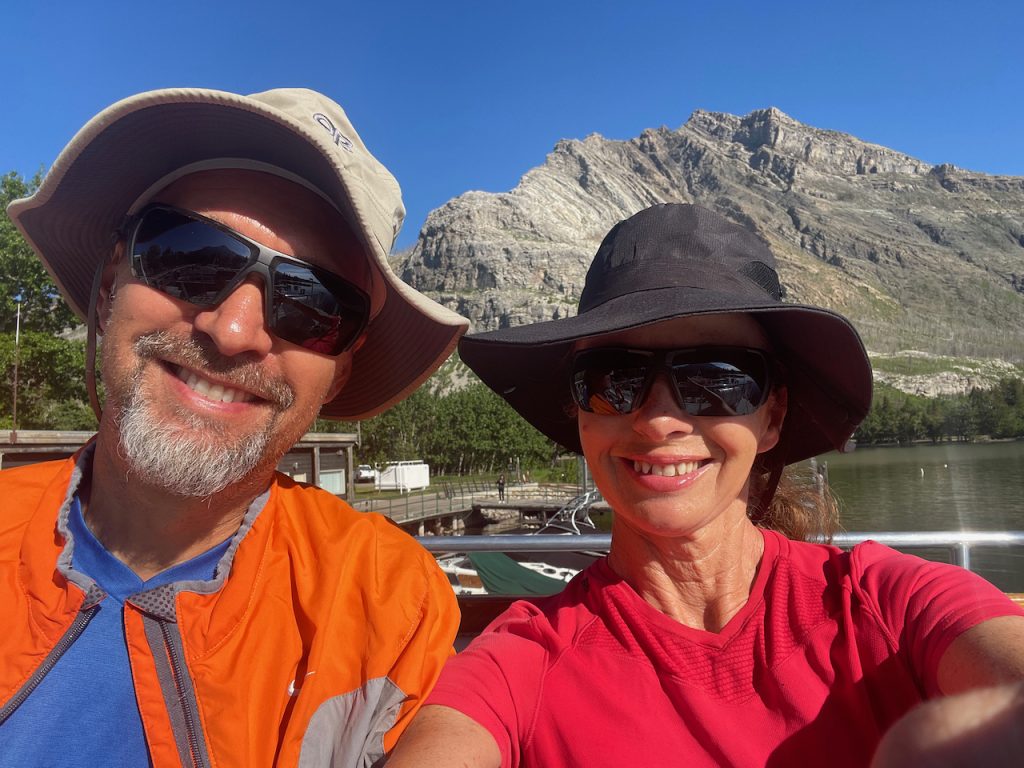
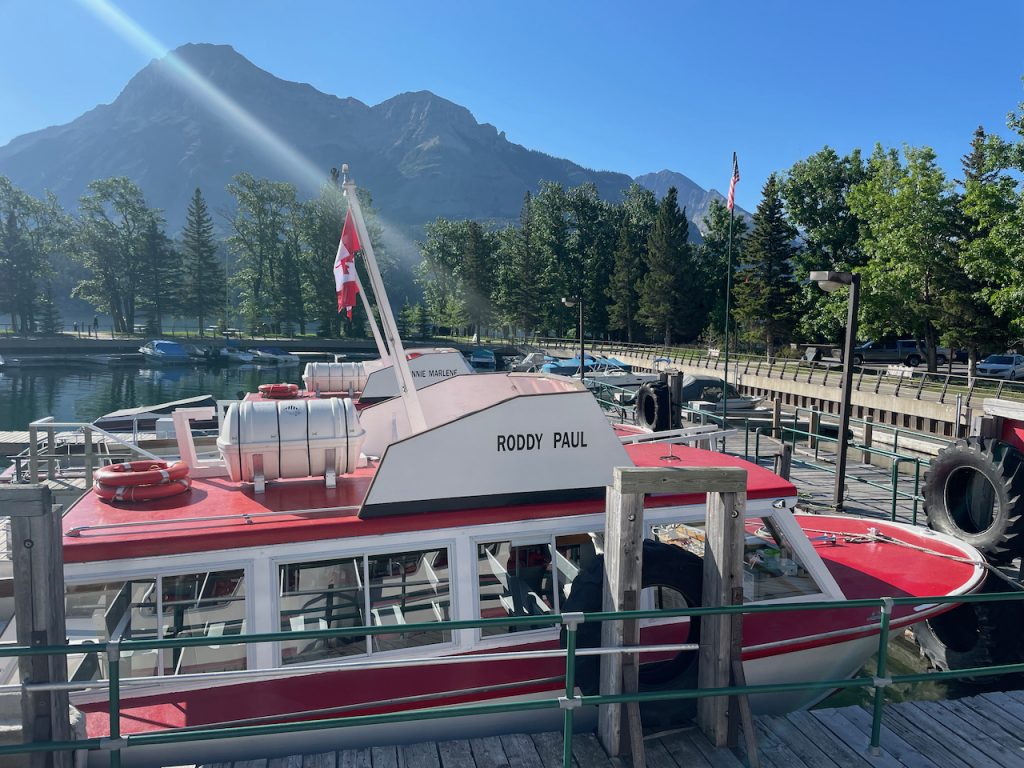
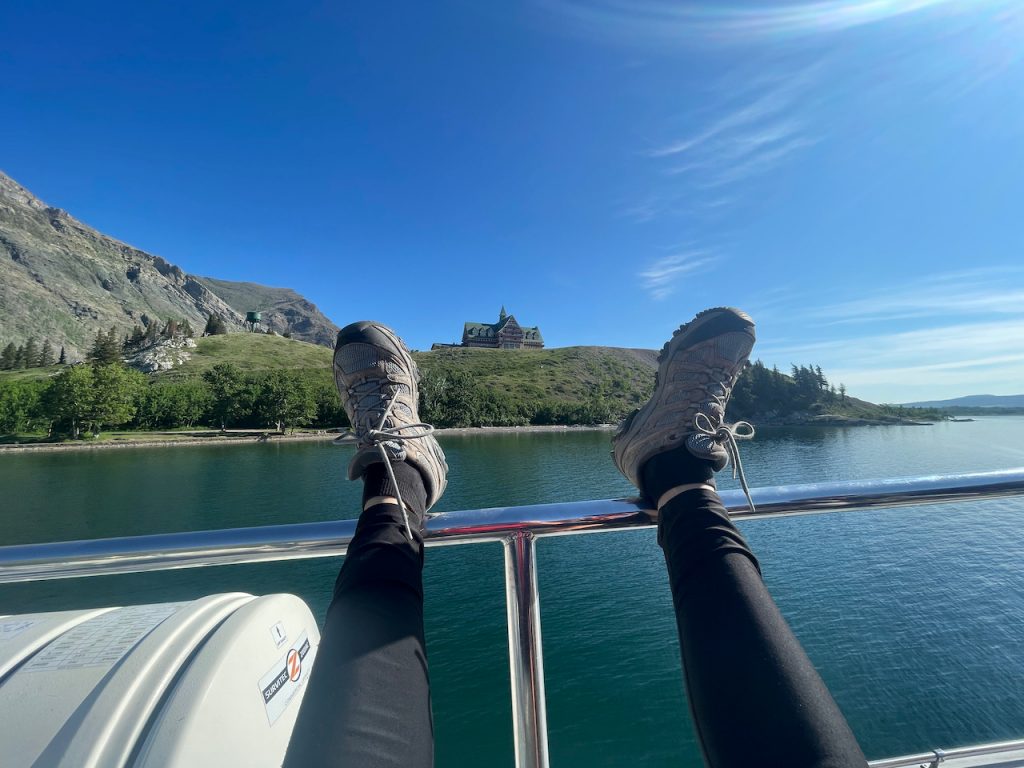
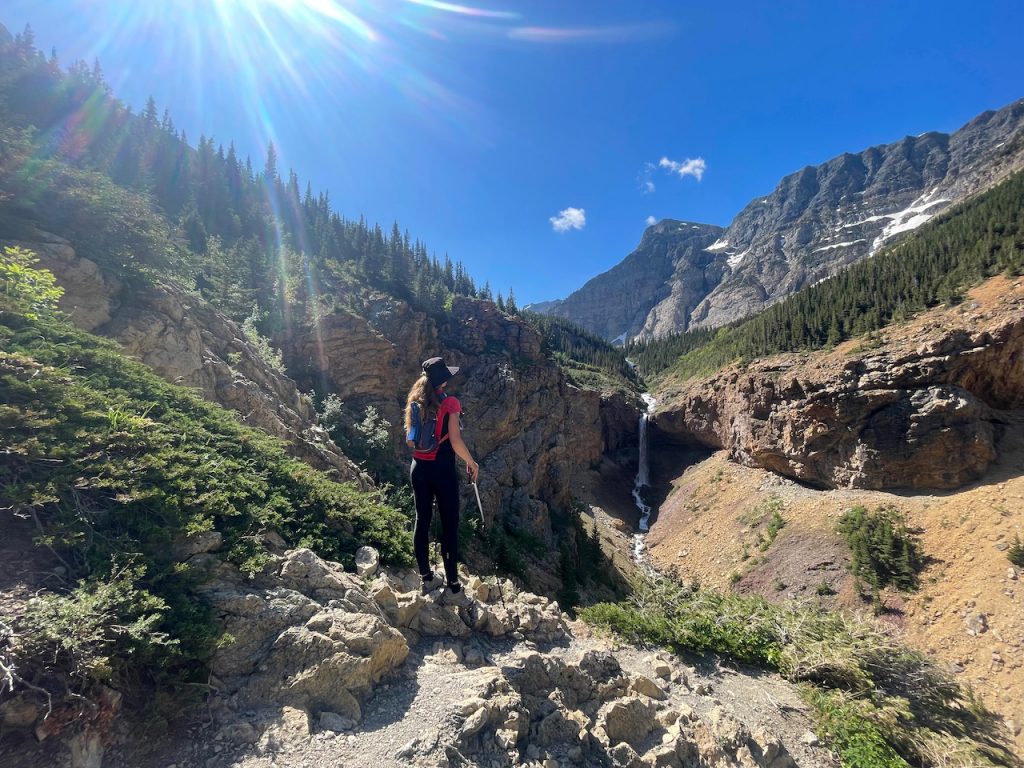
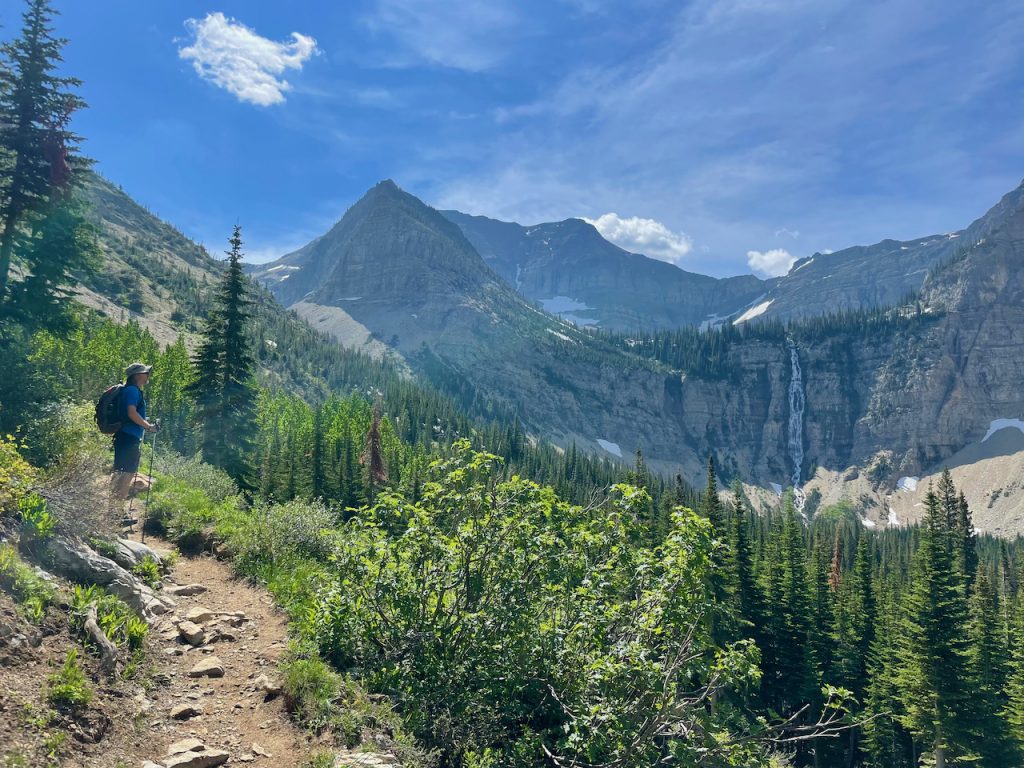
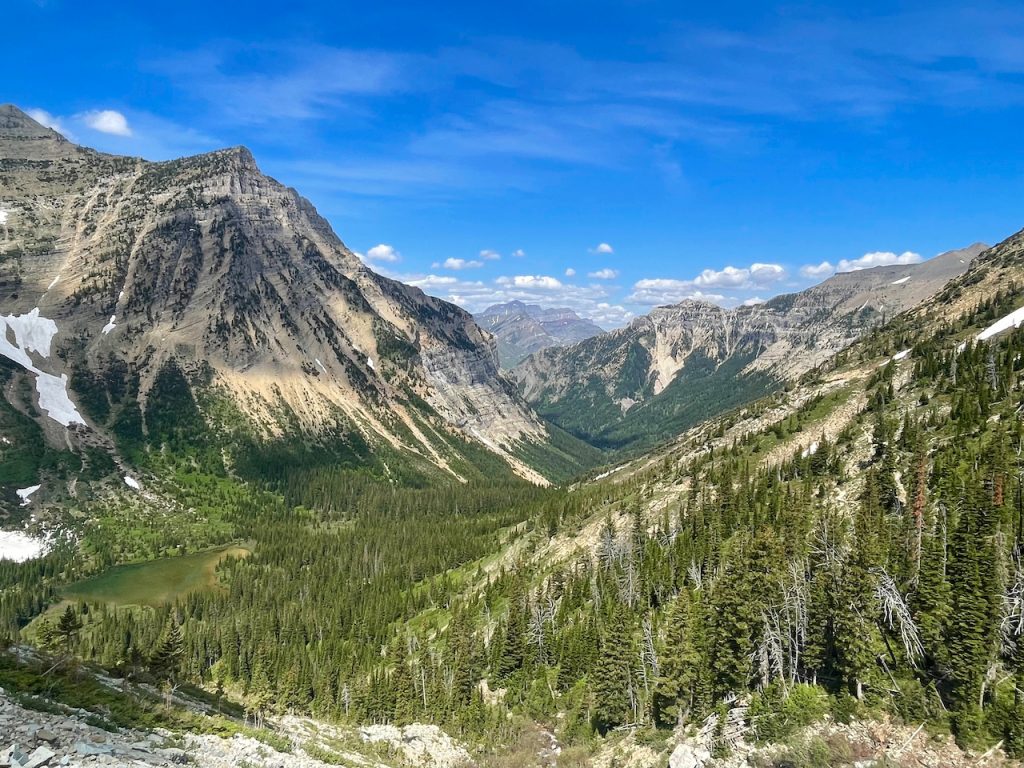
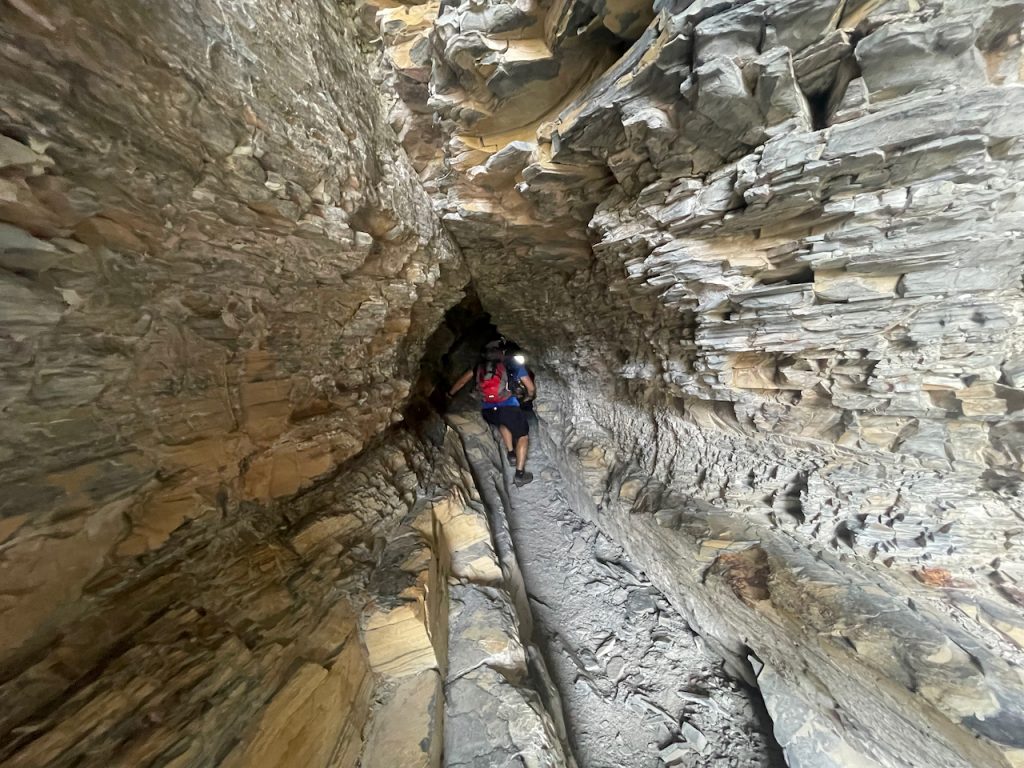
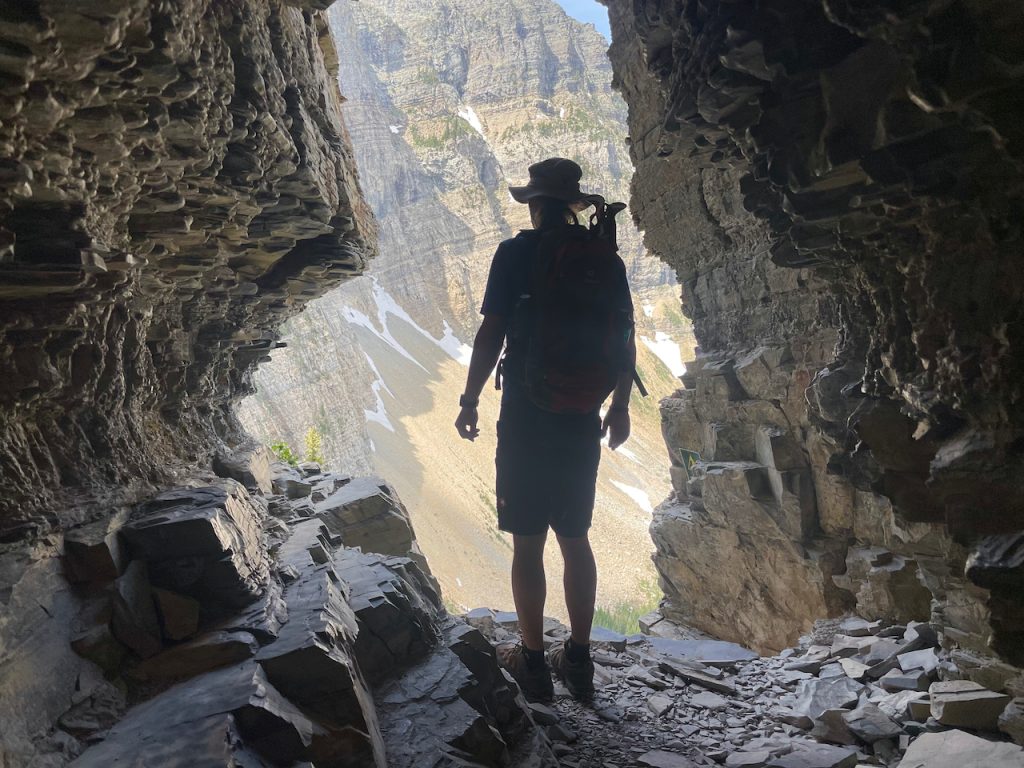
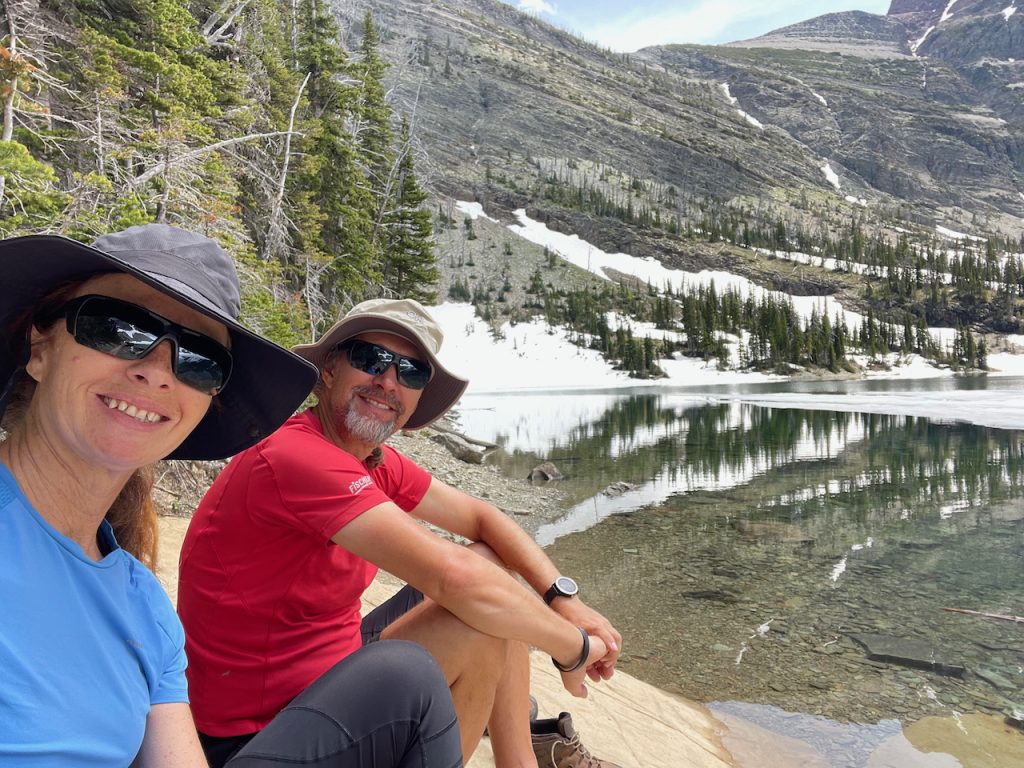
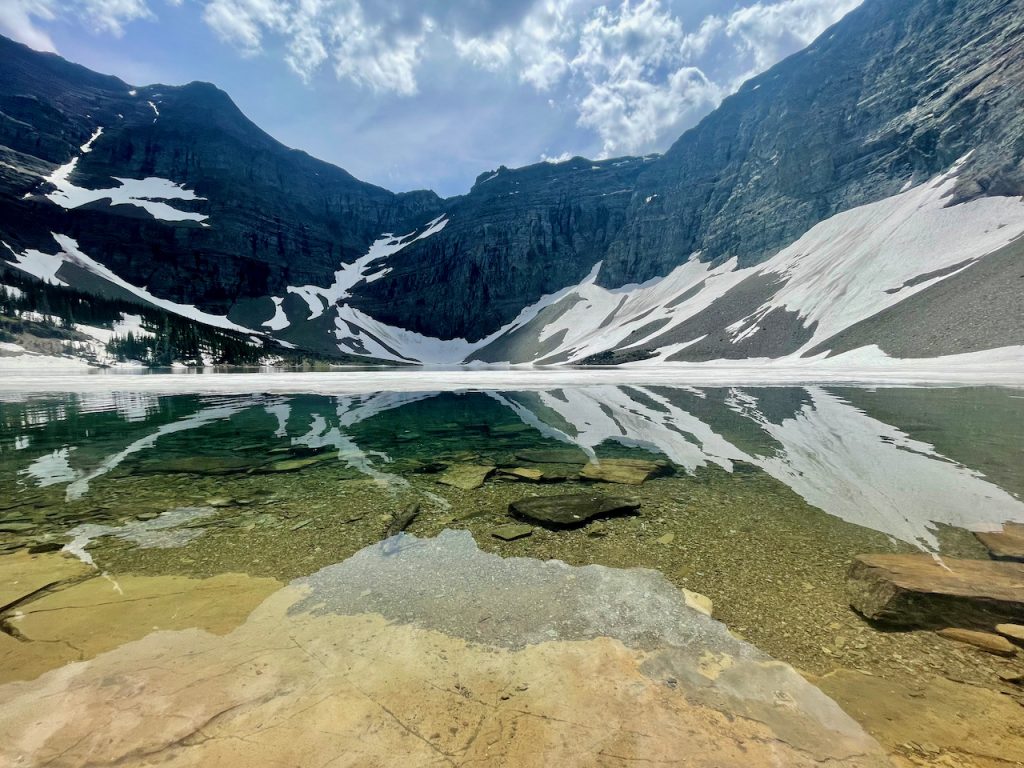
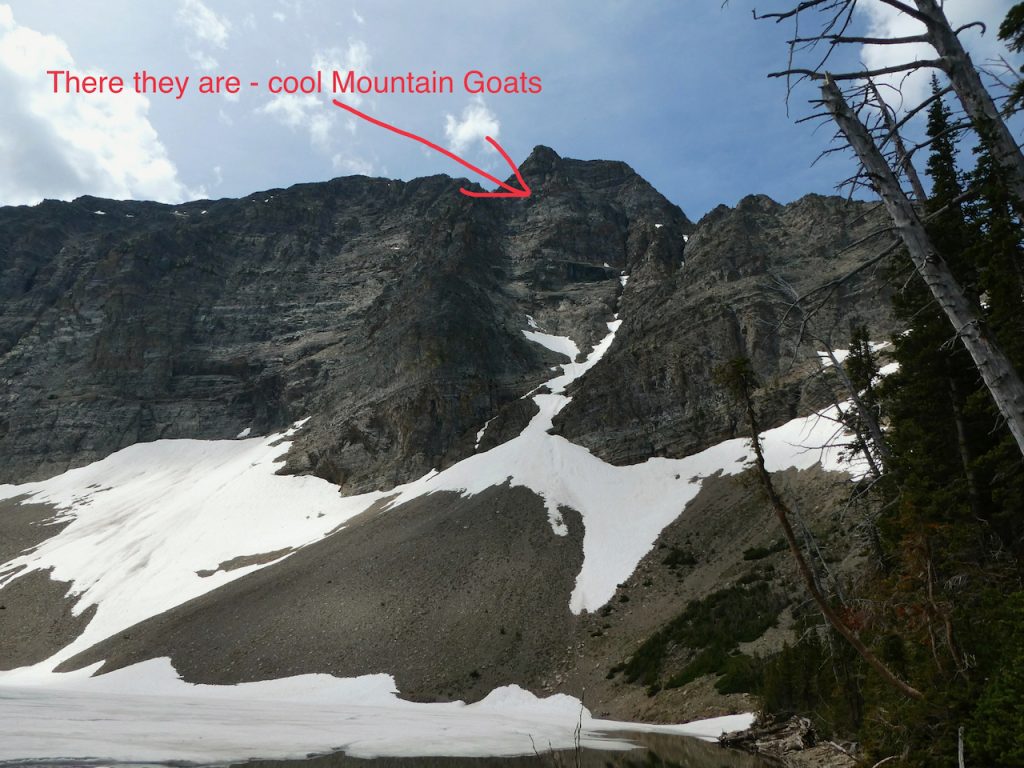
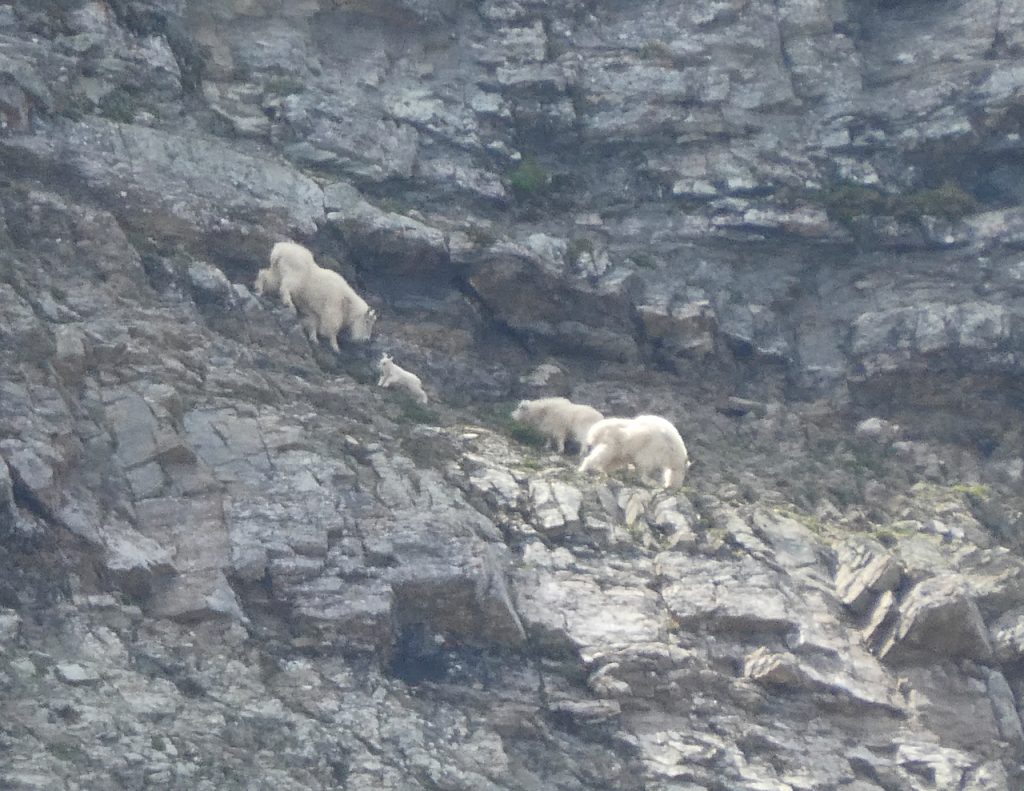
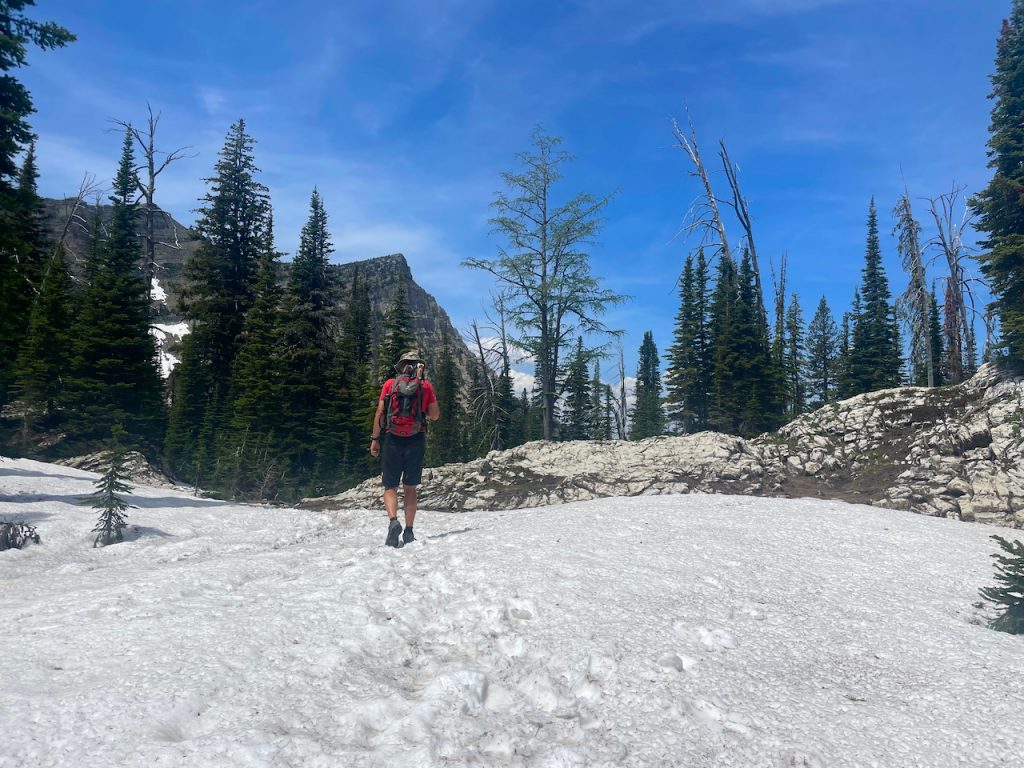
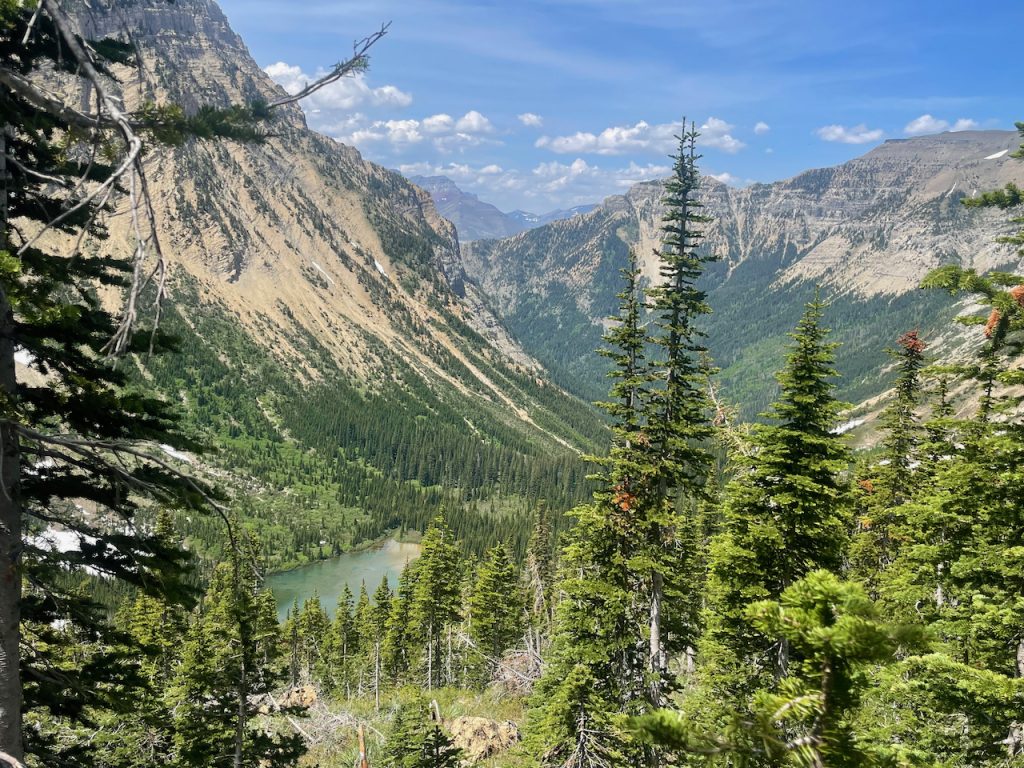
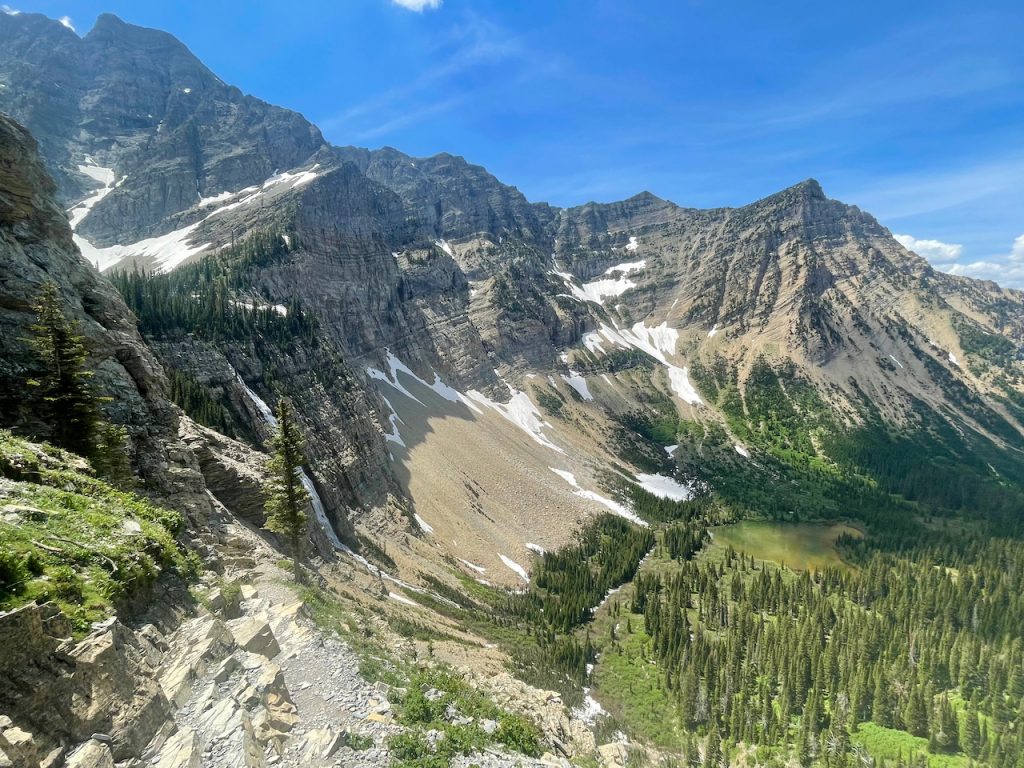
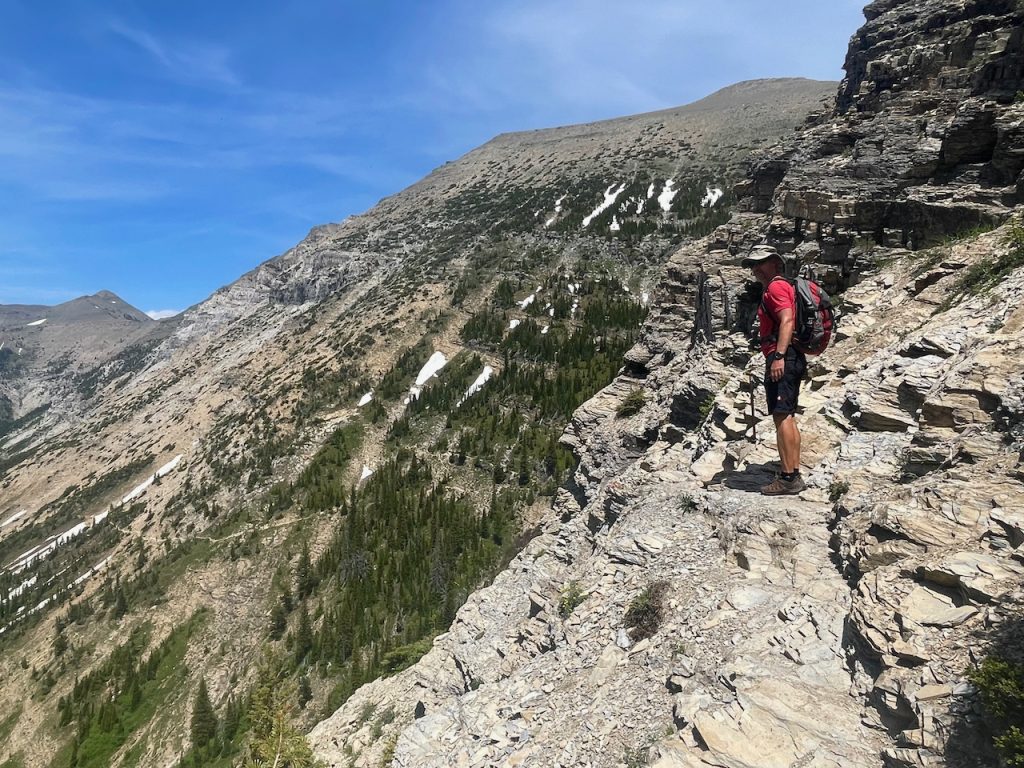
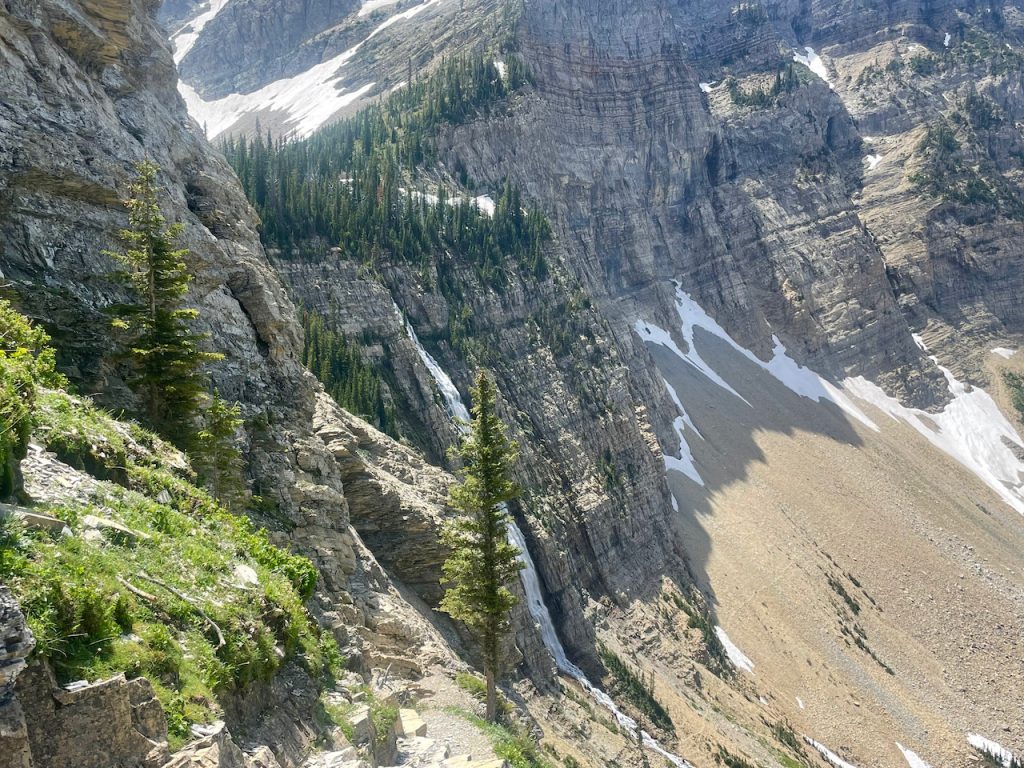
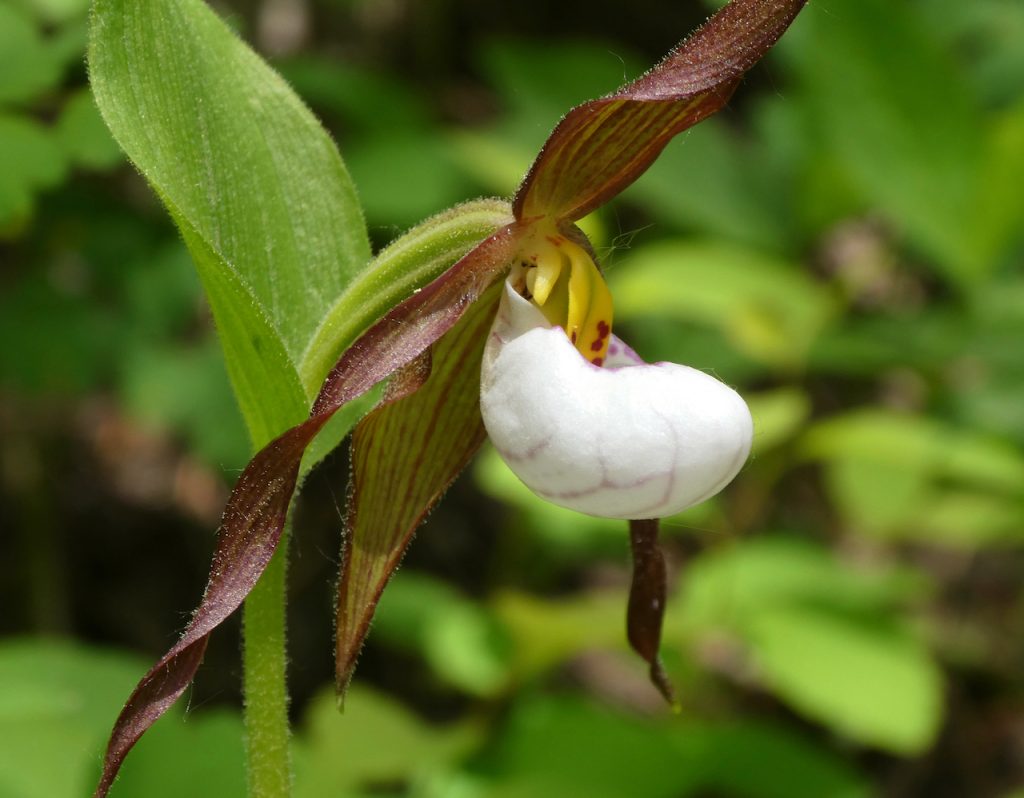
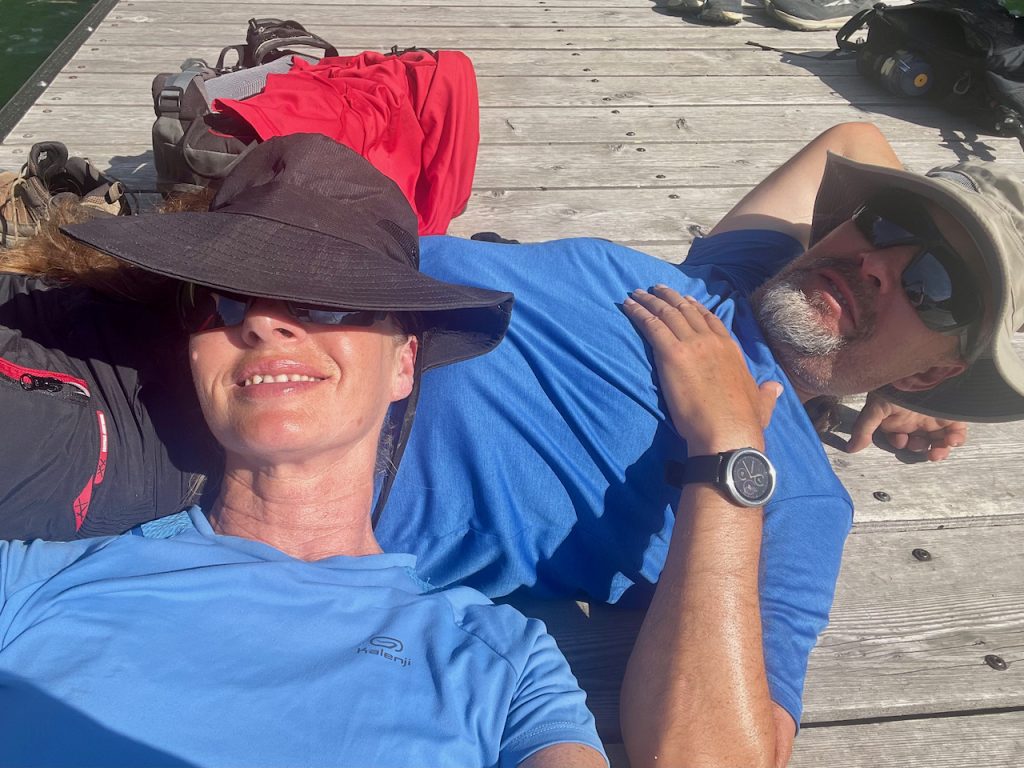
Den Abreise-Regentag nutzen wir um in Blairmore, einem Kohle-Minenort, Wäsche zu waschen und einzukaufen. Dann stellen wir uns zum ersten mal auf Crown Lands und beschließen nach ein wenig Recherche auf die westliche Seite der Rockies zu fahren. Das Wetter ist hier gerade äusserst unbeständig. Und tatsächlich sobald wir auf der anderen Seite sind, scheint die Sonne und es ist heiß. Herrlich!
We use the rainy day to do laundry and some grocery shopping in Blairmore, a coal mining town. Then we go to some Crown Lands for the first time and after a little research we decide to drive to the western side of the Rockies. The weather here on the east side is extremely unstable at the moment. And sure enough, once we’re on the other side, the sun is shining and it’s hot. Splendid!
Auf dem Weg bremsen wir in Sparwood für den größten LKW der Welt, so sagt man. Der Koloss ist aber auch echt unglaublich und schon fast lächerlich groß. Der Titan hat ein Bruttogewicht von 600 to., 16 Zylinder, 3.300 PS, die von vier Elektromotoren an die Räder gebracht werden – und die könnten wiederum 3.200 Häuser elektrisch versorgen. Beeindruckt hat uns auch die Motor-Ölmenge, die 1.262 Liter beträgt. Gigantismus.
On the way we stop in Sparwood to see the biggest truck in the world. The colossus is really incredible and almost ridiculously big. The Titan has a gross weight of 600 tons, 16 cylinders, 3,300 HP, which are brought to the wheels by four electric motors – and these in turn could supply 3,200 houses with electricity. We were also impressed by the amount of engine oil, which is 333 gallons. Gigantism.
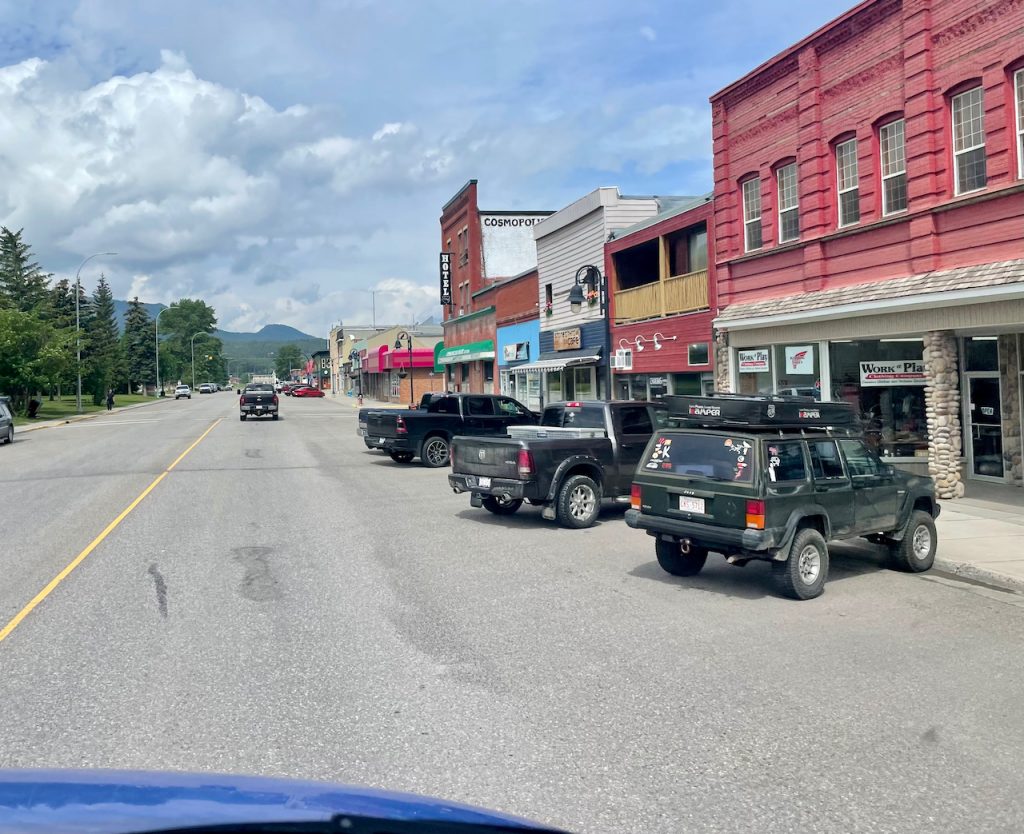
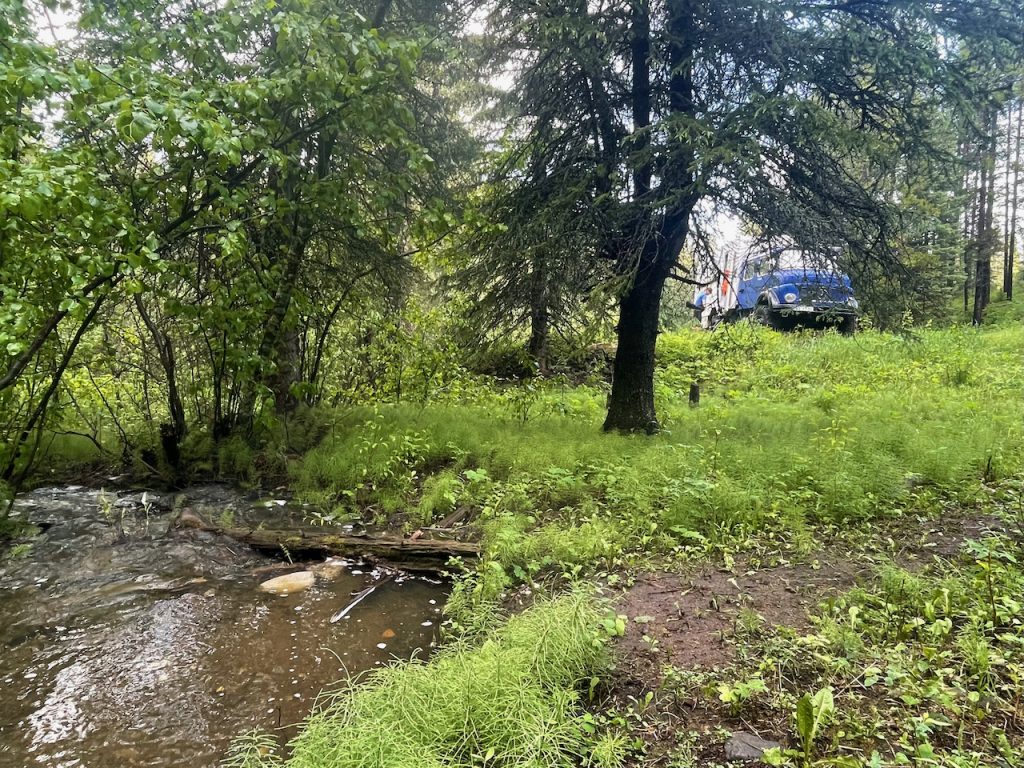
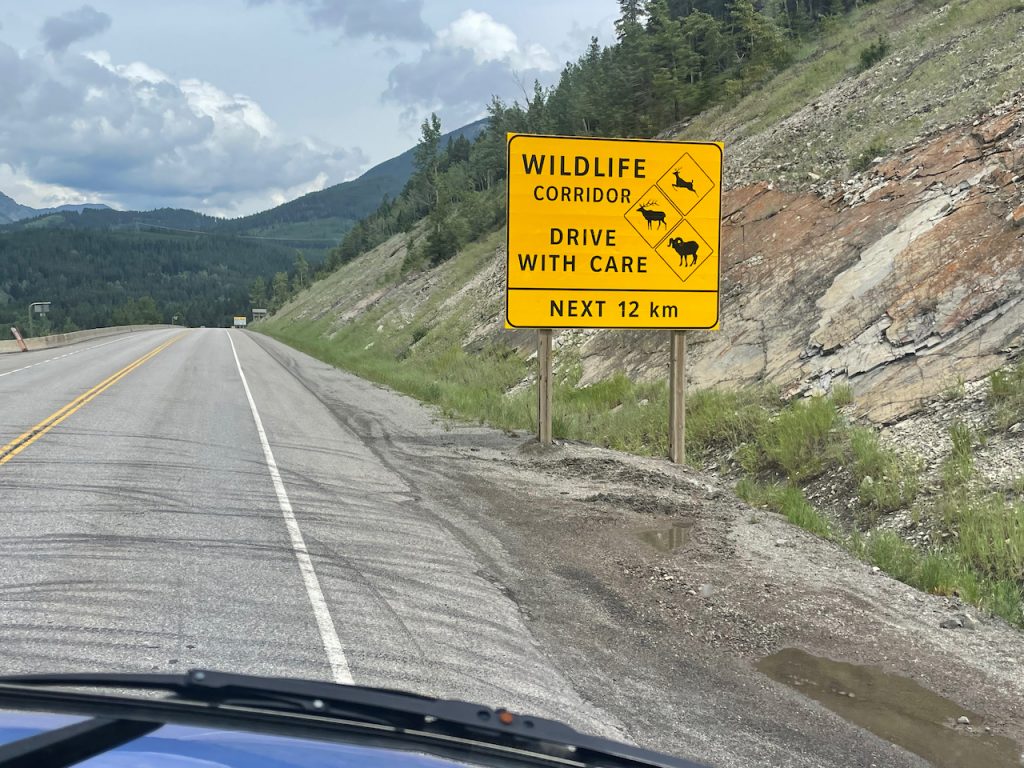
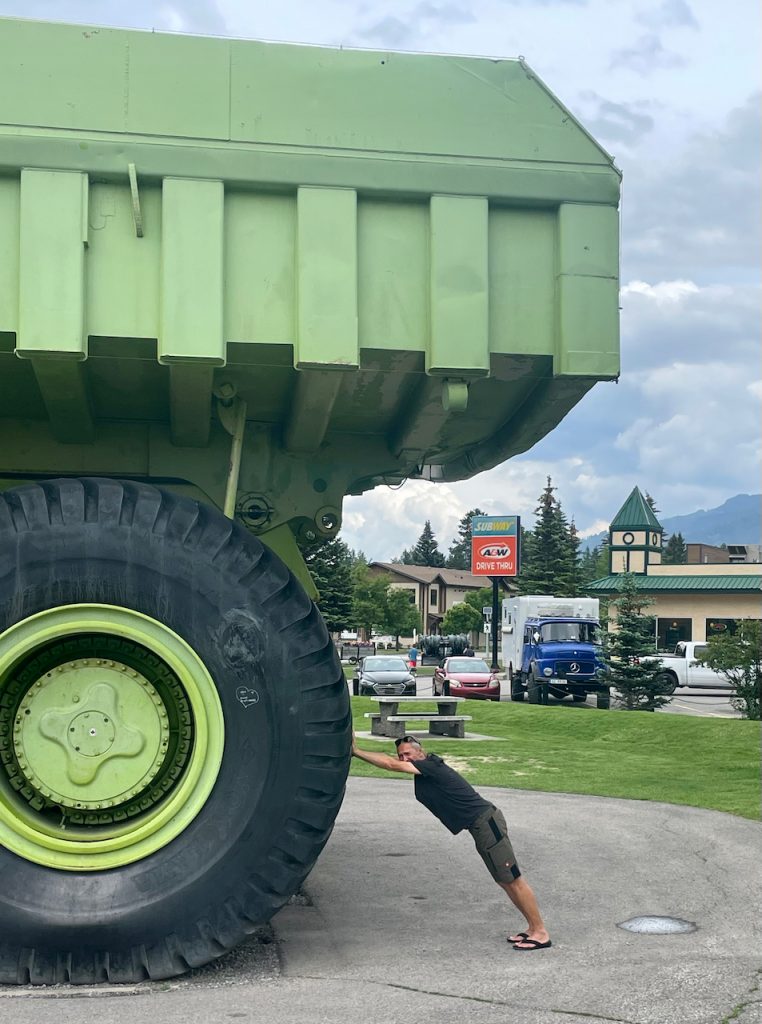
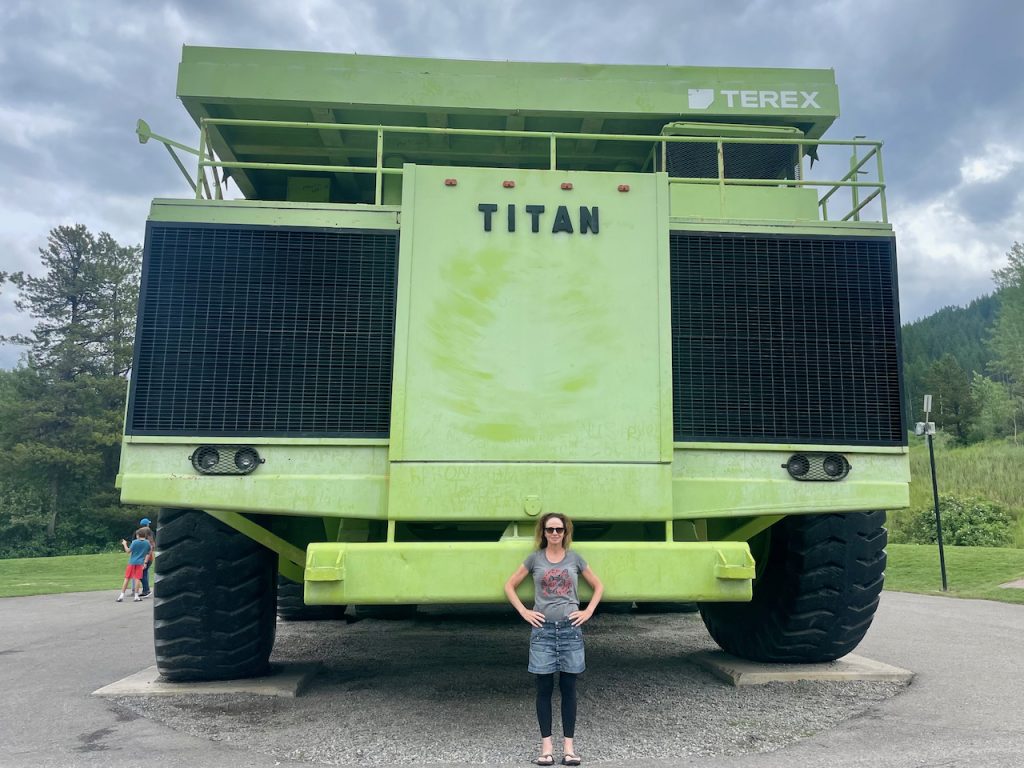
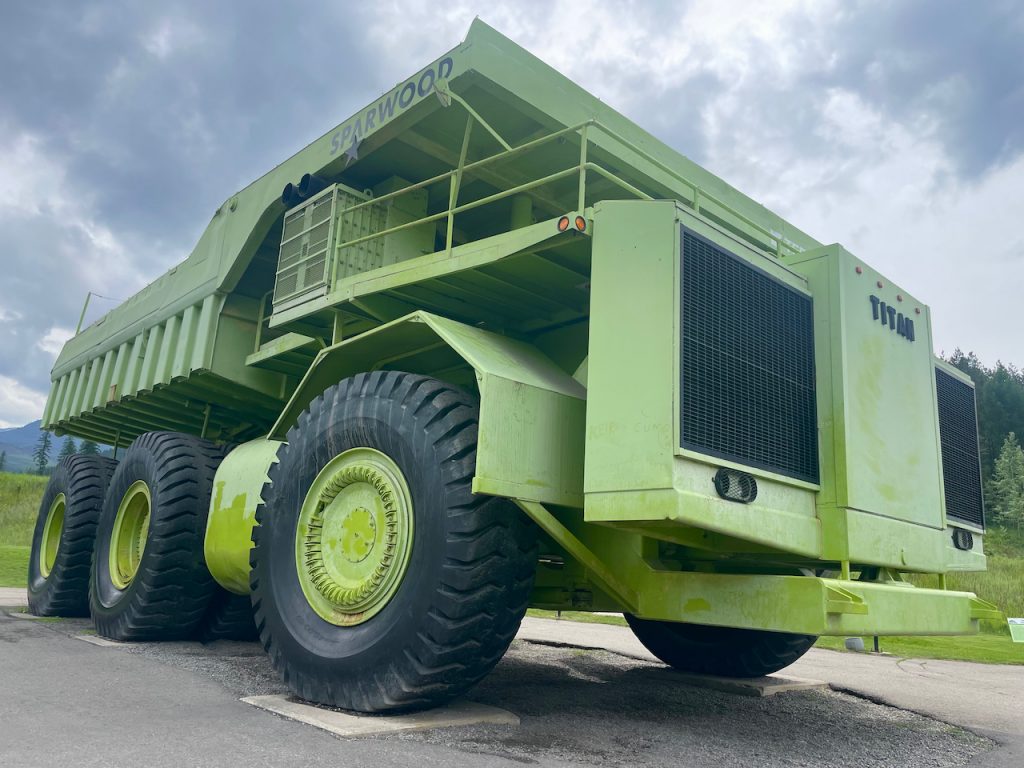
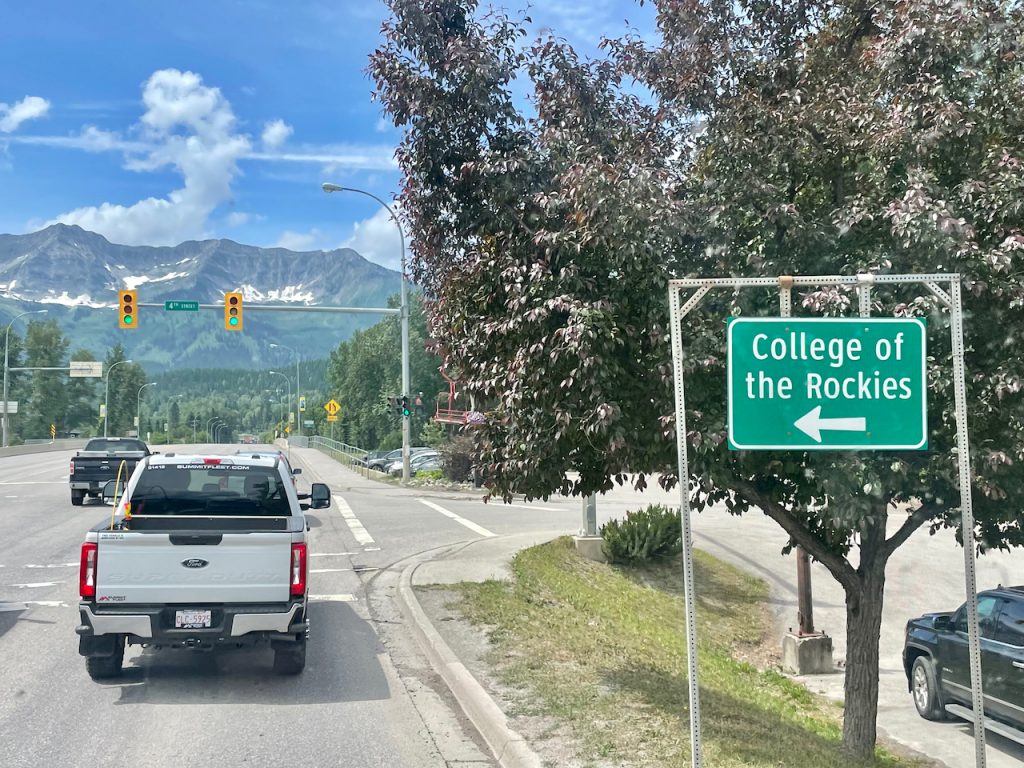
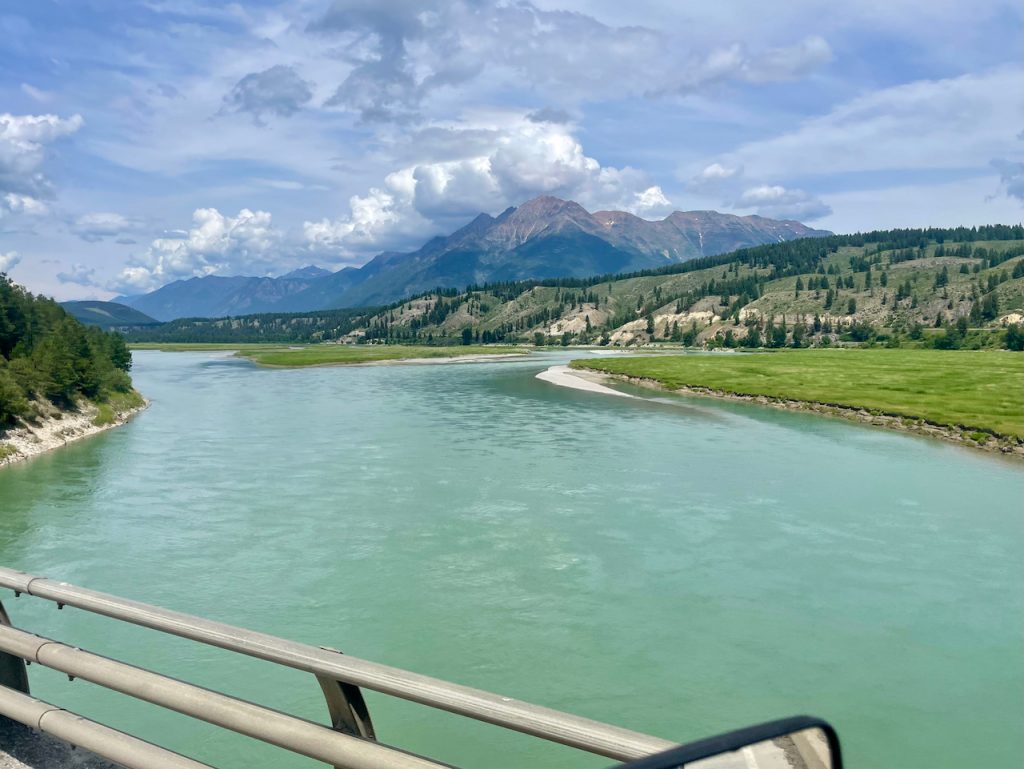
Wir sind mittlerweile in British Columbia, „the beautiful“ genannt, angekommen. Und das können wir SOFORT nachvollziehen. Wir wollen und müssen uns mal wieder ein wenig um Ewald kümmern und somit stellen wir uns ausserhalb von Cranbrook auf die Eager Hills Public Lands. Kein Mensch da, umgeben von einer riesigen Blumenwiese. Wild-romantisch! Hier wird Ewald verwöhnt, wir erkunden die Gegend zu Fuß, duschen draußen und abends beim Einschlafen hören wir das Brüllen der Bären.
In the meantime we arrived in “the beautiful” British Columbia. And we can understand that IMMEDIATELY. We want and need to take care of Ewald a little bit, so we park outside of Cranbrook on the Eager Hills Public Lands. Nobody there, surrounded by a huge flower meadow. Wildly romantic! Here Ewald is pampered, we explore the area on foot, shower outside and in the evening when we fall asleep we hear the bears roaring.
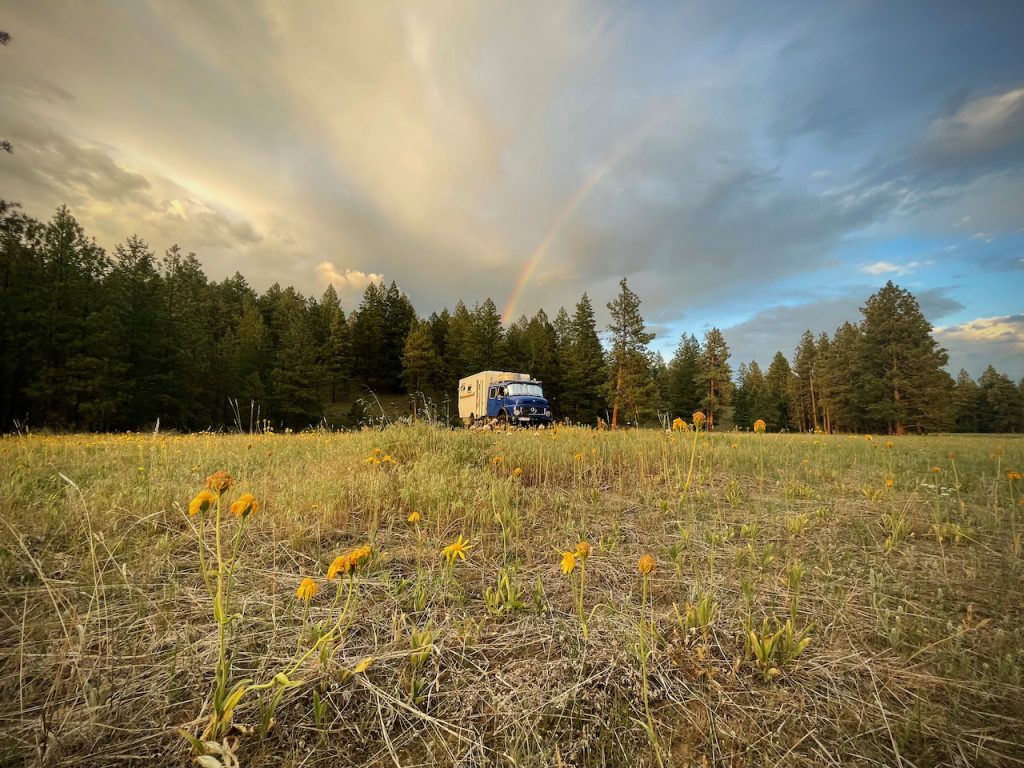
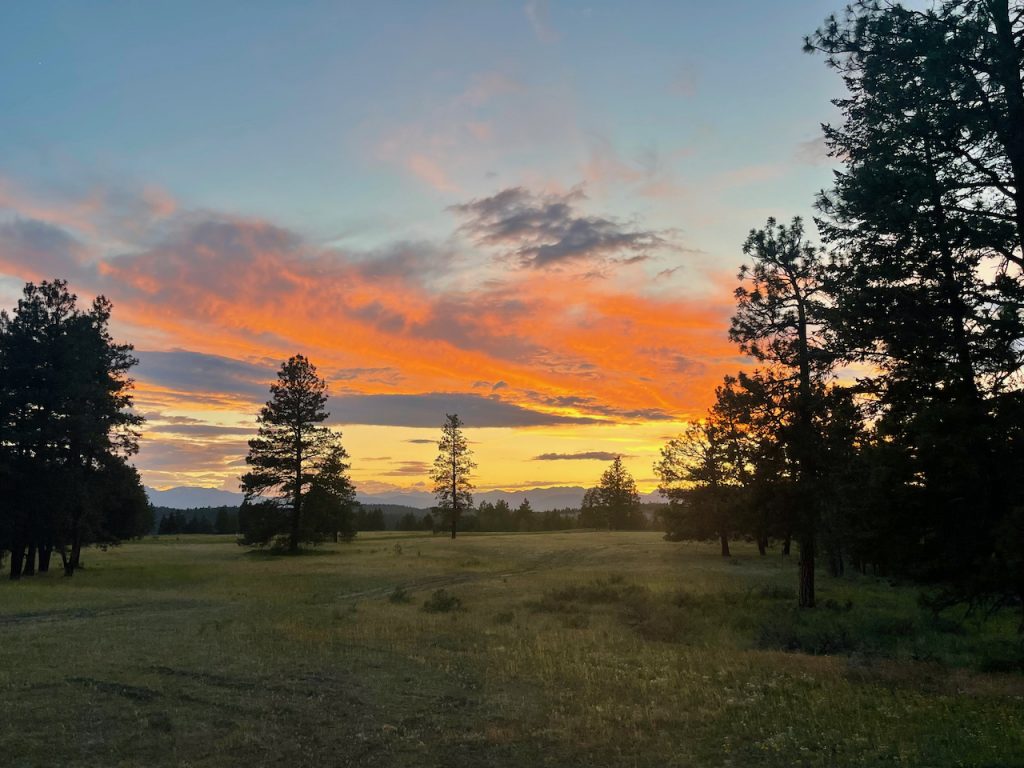
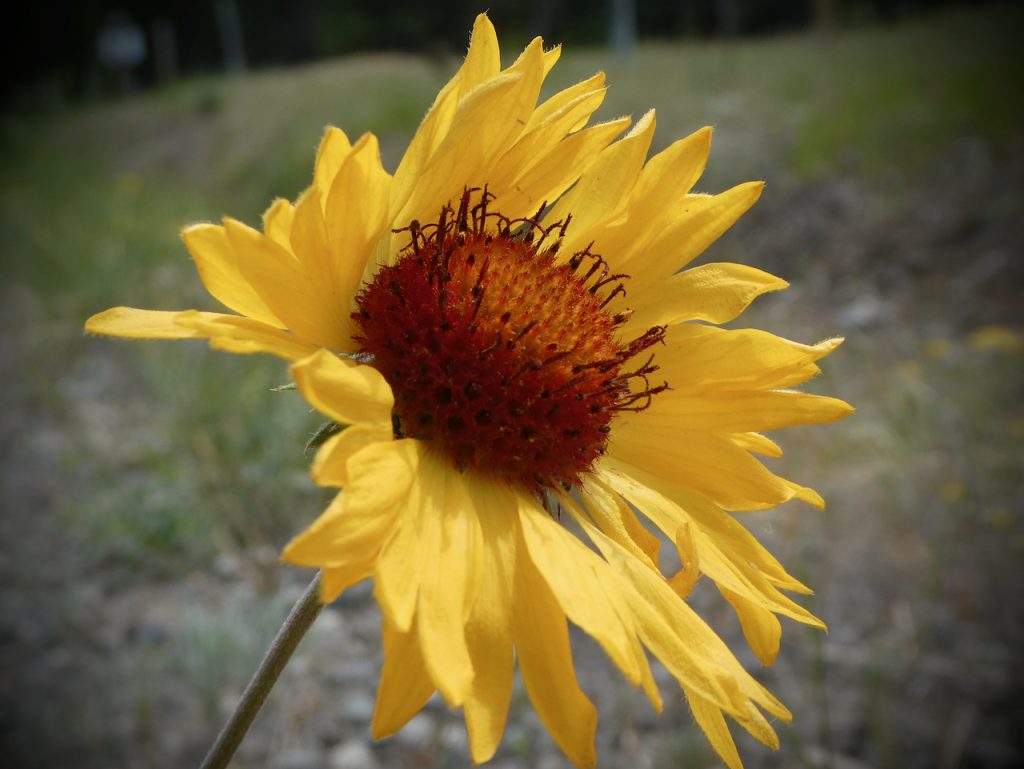
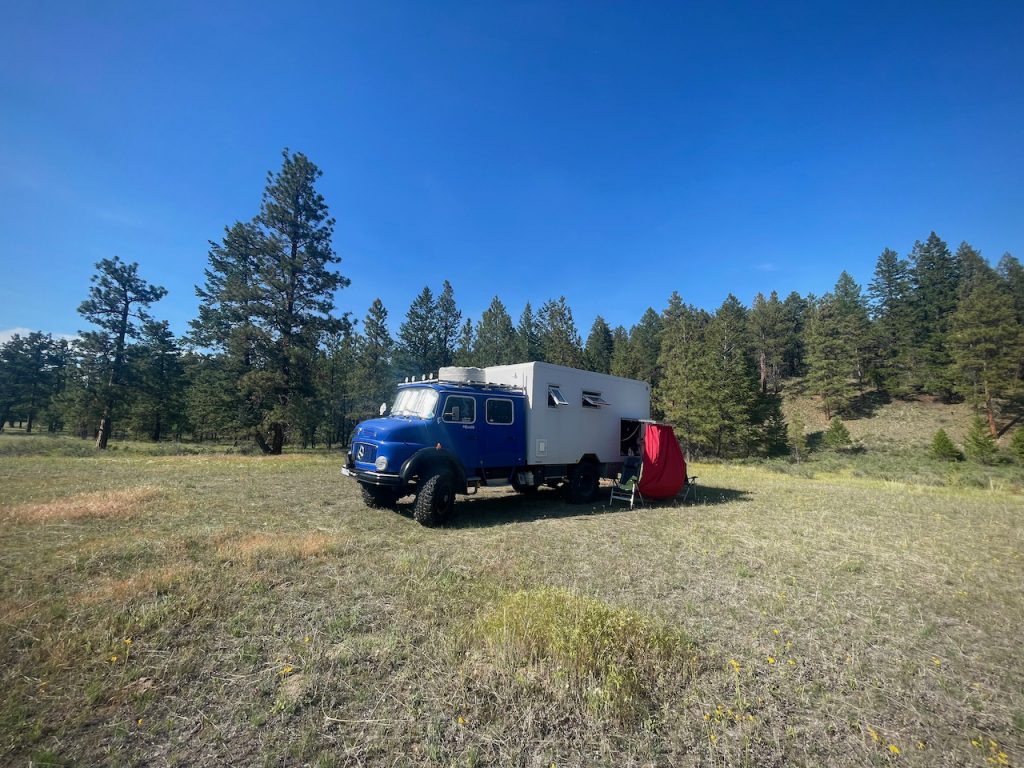
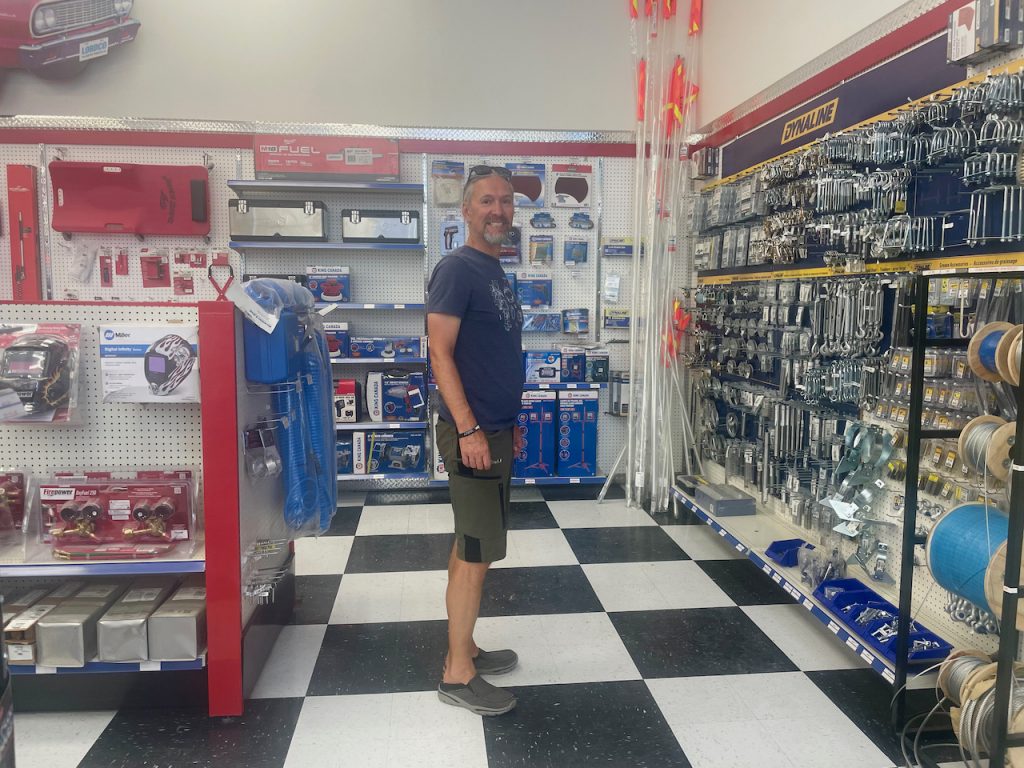
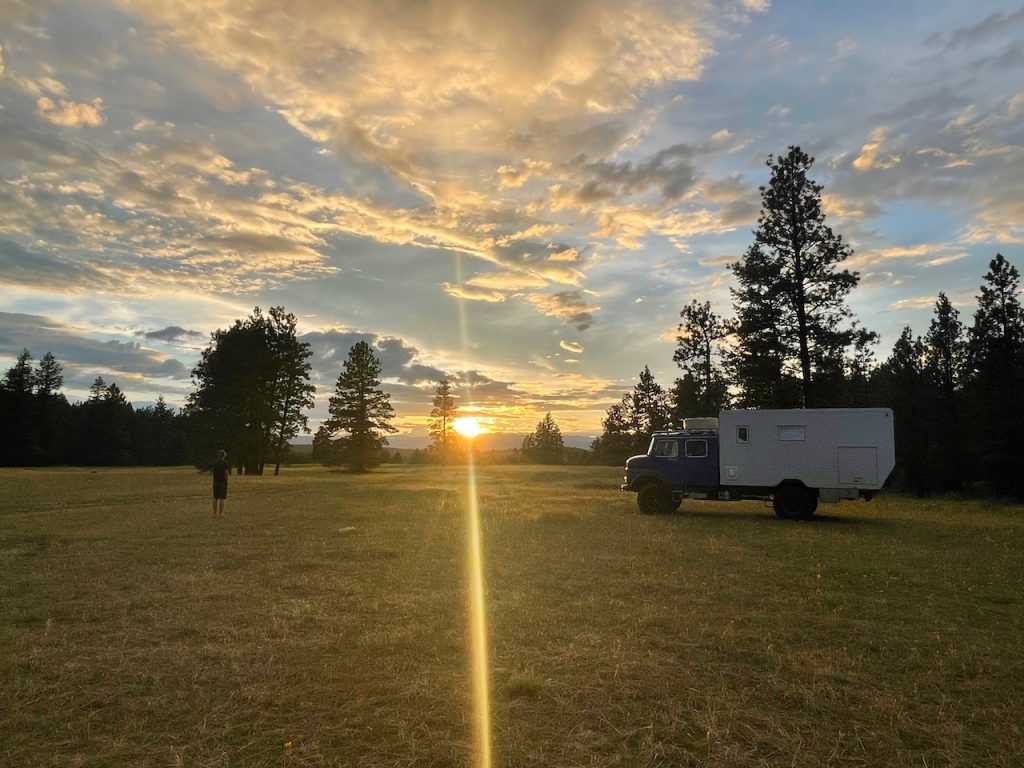
Dann ist es mal wieder soweit, wir wollen unbedingt einweichen – in heißen Quellen. Und das, obwohl es so heiß ist. Einweichen macht uns einfach immer Spass. Wir fahren weiter nördlich entlang der Rocky Mountains und biegen dann auf eine Schotterstraße in die Berge ab. Die Lussier Hot Springs am Lussier River sind herrlich und zum Glück nicht überlaufen. Die Nacht verbringen wir ganz in der Nähe auf einem Seitenweg und wir finden das Leben schön.
Then it’s time again, we really want to soak – in hot springs. And even though it’s so hot. Soaking is always fun for us. We continue north along the Rocky Mountains and then turn onto a gravel road into the mountains. The Lussier Hot Springs on the Lussier River are gorgeous and thankfully not crowded. We spend the night nearby on a side road and we think life is beautiful.
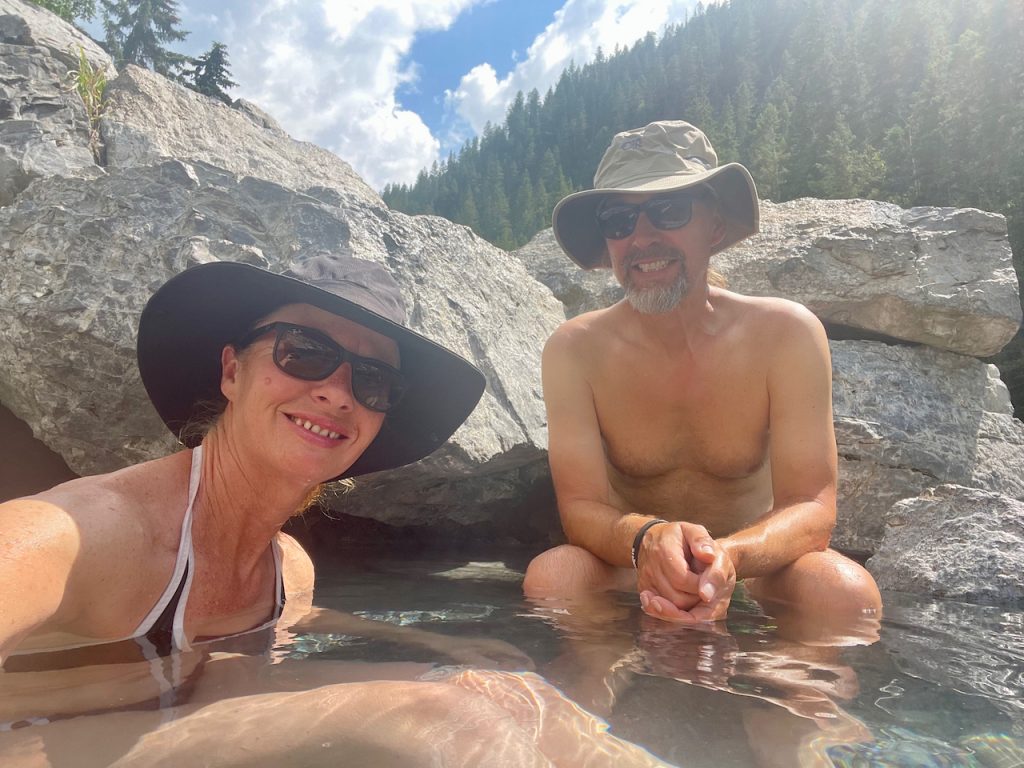
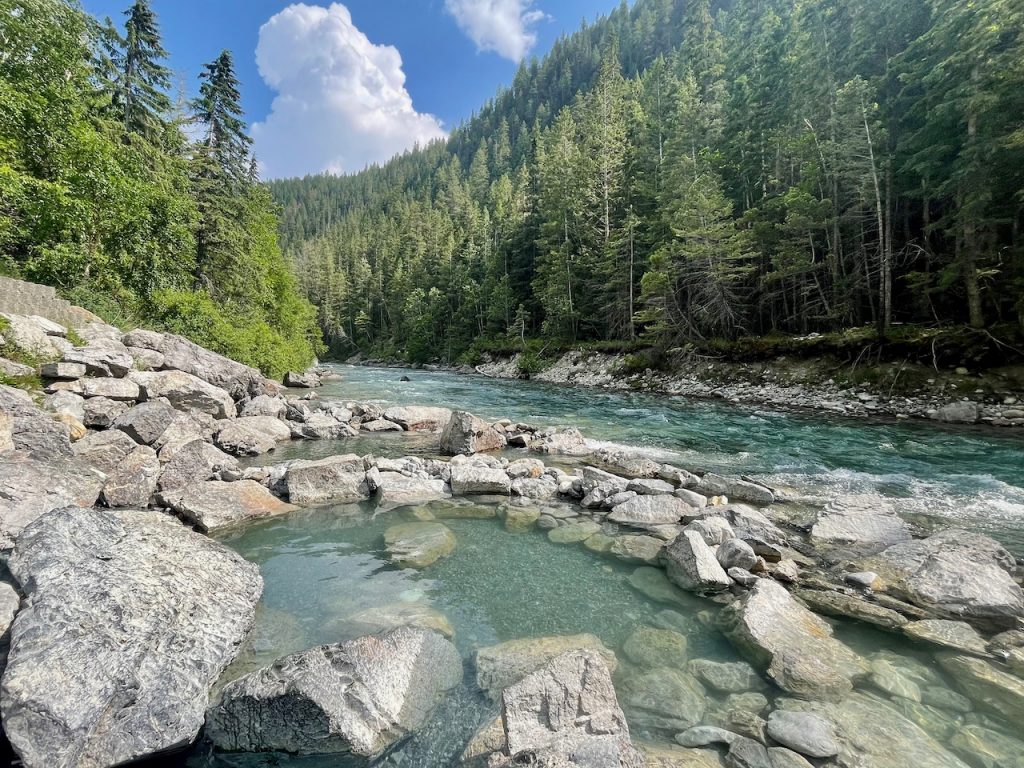
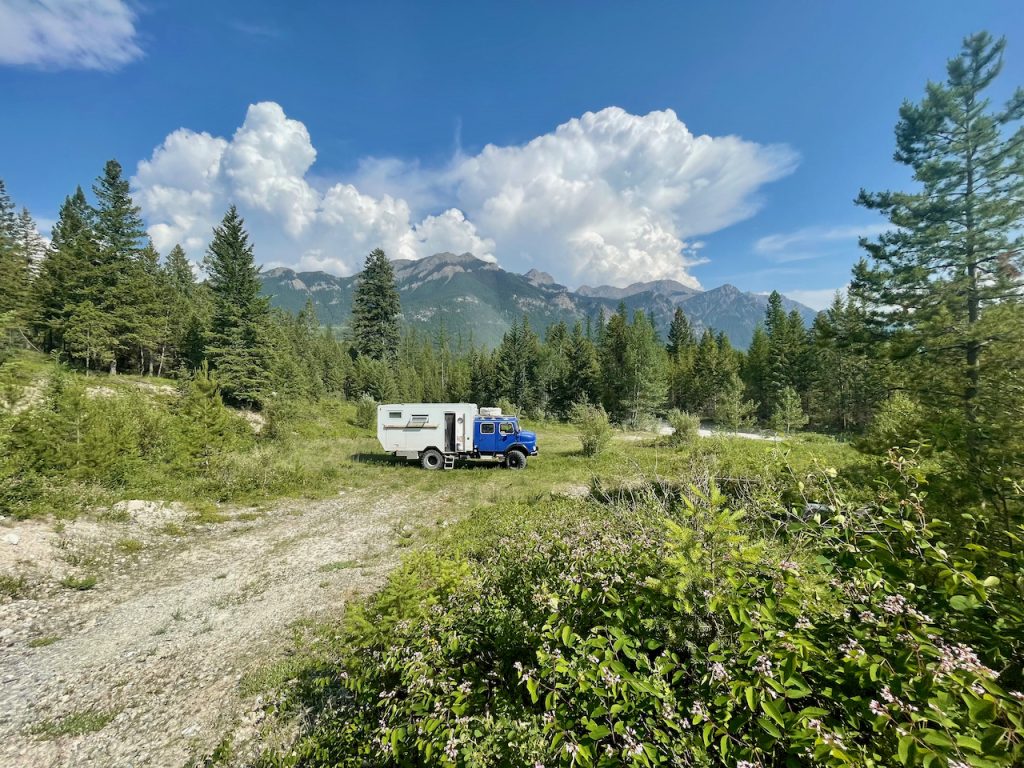
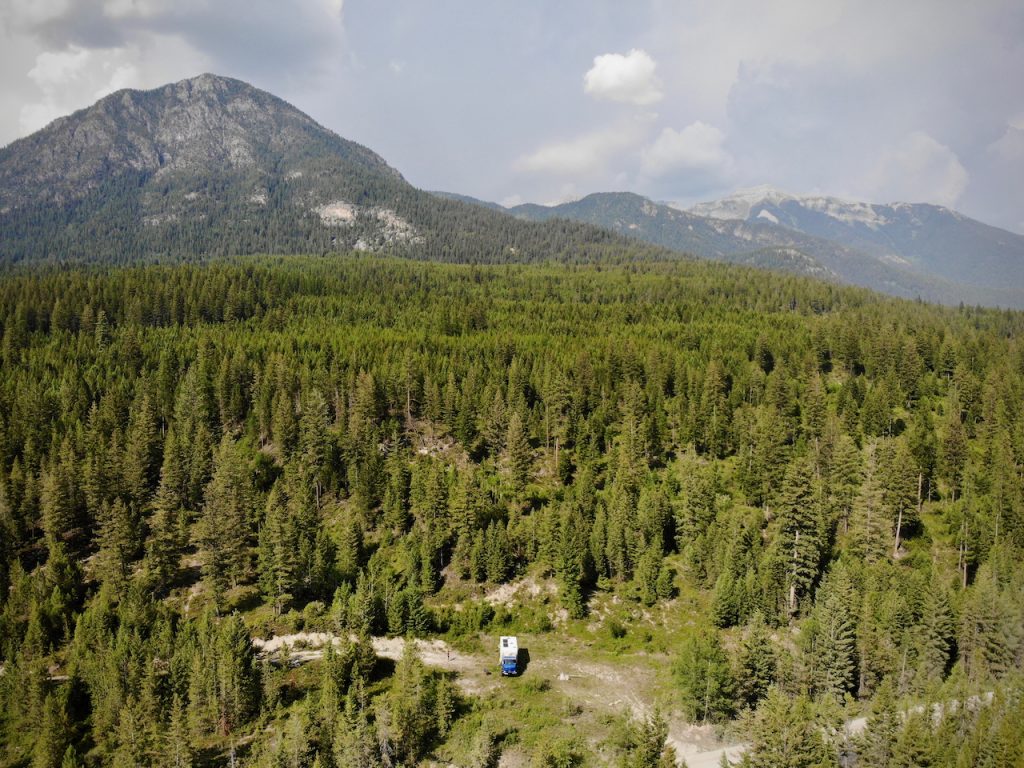
Wir fahren weiter nach Radium Hot Springs und dort ist der Name Programm. Gleich an dem recht touristischen Ort schließt der Kootenay Nationalpark an. Im Ort sind zahlreiche Anspielungen auf die Alpen, wie die Salzburger und die Tiroler Hütte, zu finden. Sehr lustig. Wir finden einen Platz auf dem fast leeren Campground (Nebensaison 🙂) und erkunden direkt mal die Gegend. Da die Erkundung etwas länger ausfällt, belohnen wir uns nicht mit Schnitzeln und Pommes, sondern beim Mexikaner mit leckeren Burritos, Margaritas und Eis. Lecker!
We continue to Radium Hot Springs and the name says it all. The Kootenay National Park is right next to this quite touristy place. There are numerous allusions to the Alps in the village, such as the Salzburger and Tiroler Hütte. Very funny. We find a spot on the almost empty campground (shoulder season 🙂) and explore the area right away. Since the exploration takes a little longer, we don’t reward ourselves with schnitzel and fries, but with delicious burritos, margaritas and ice cream at the Mexican restaurant. Yummy!
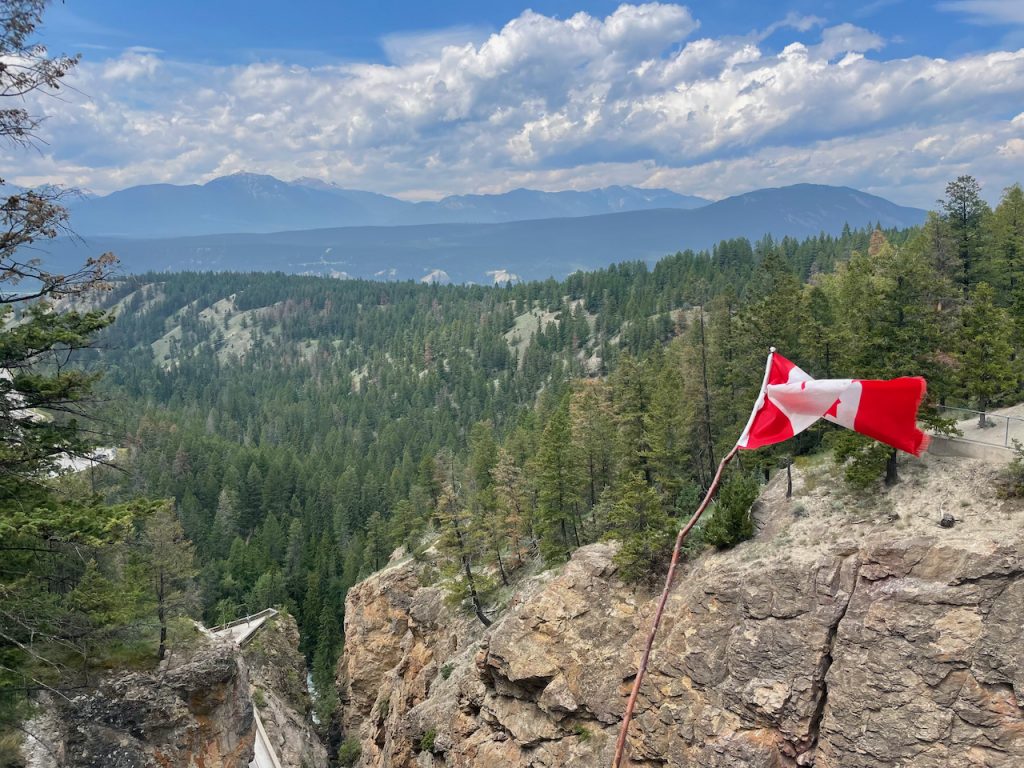
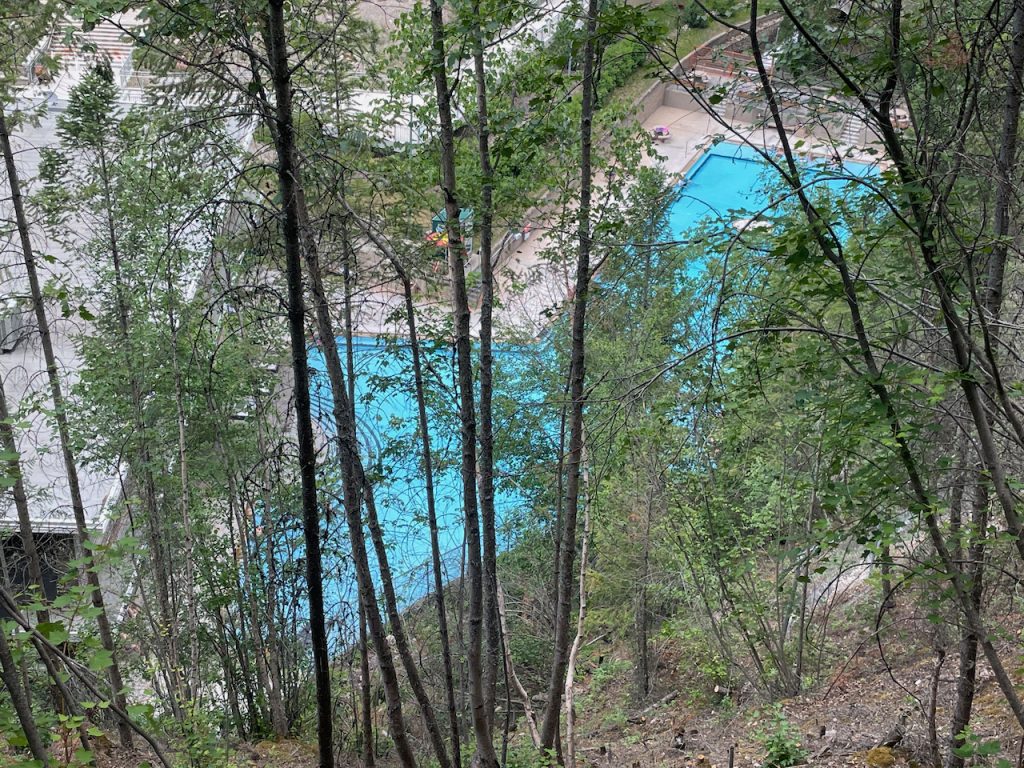
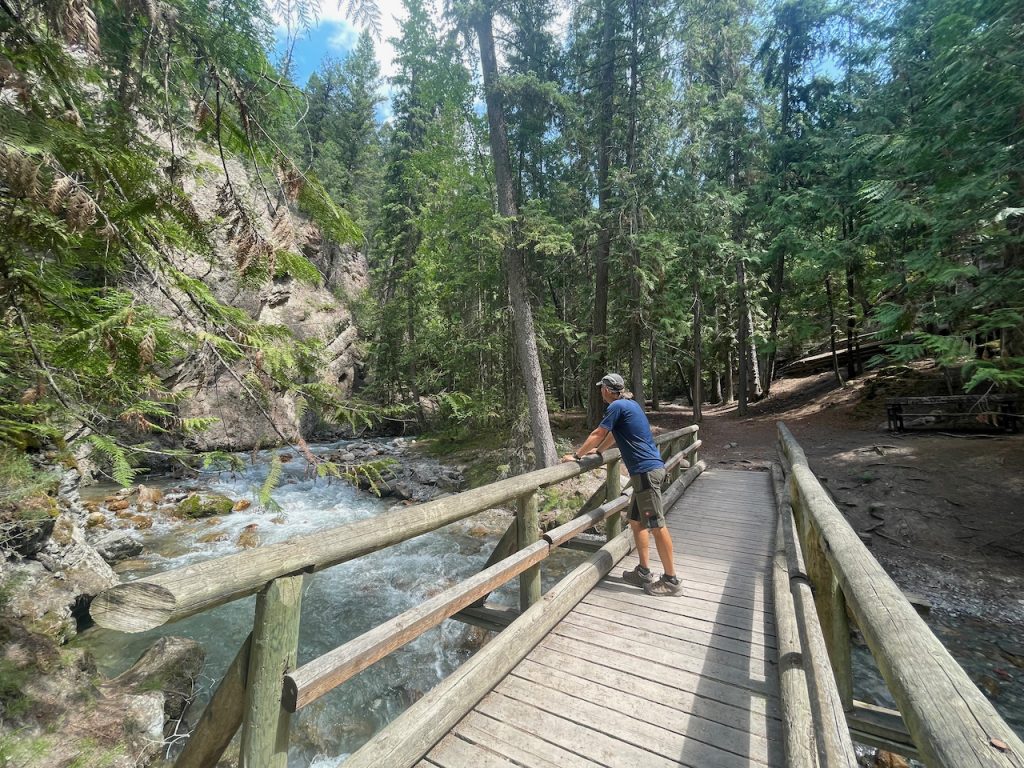
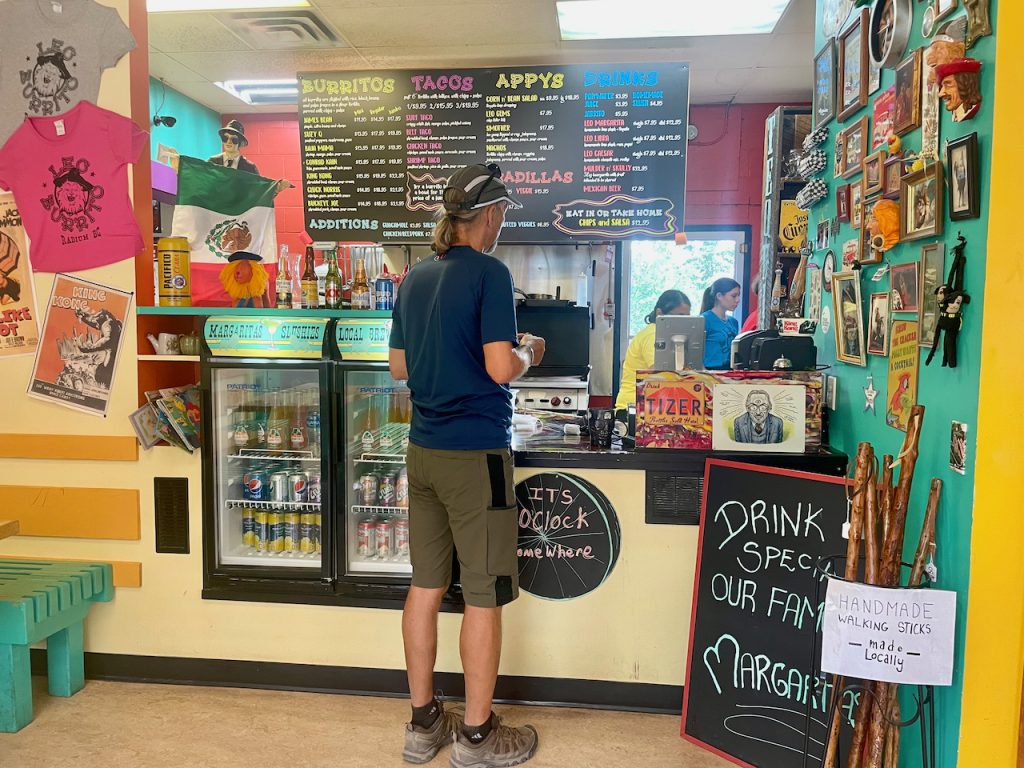
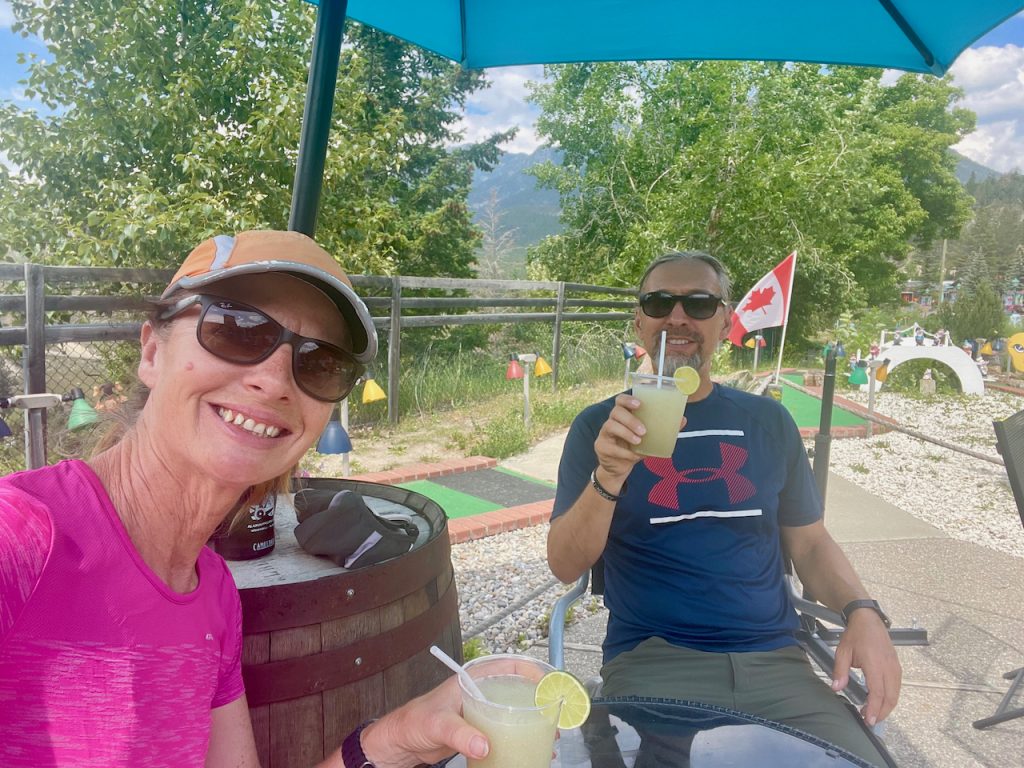
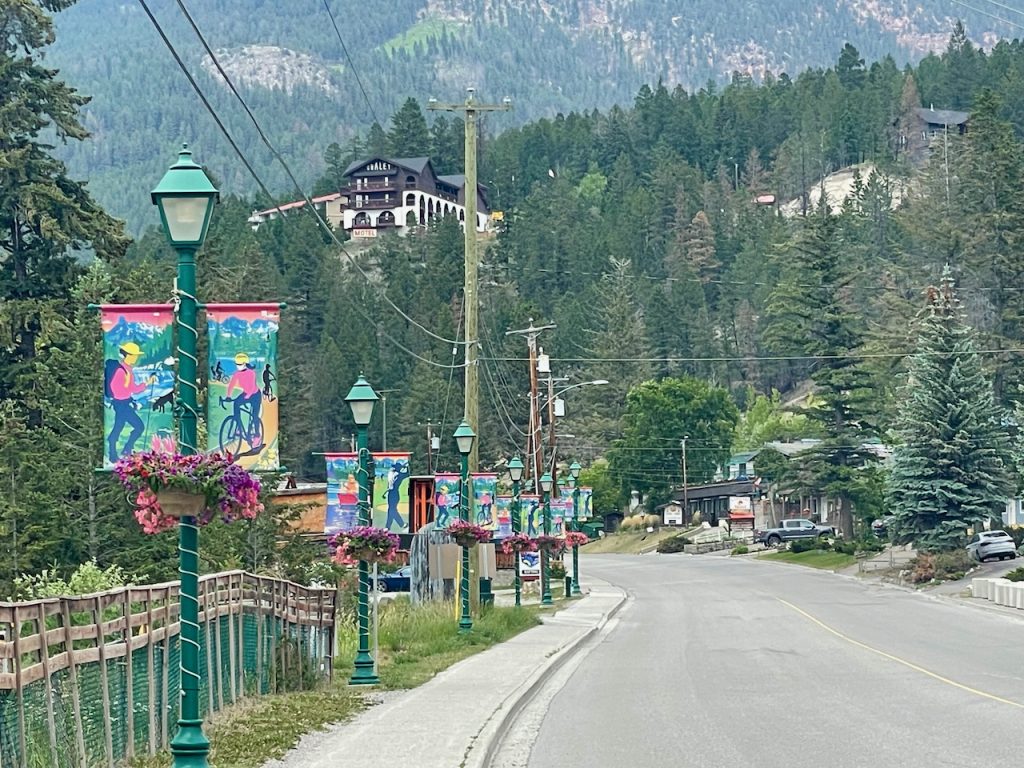
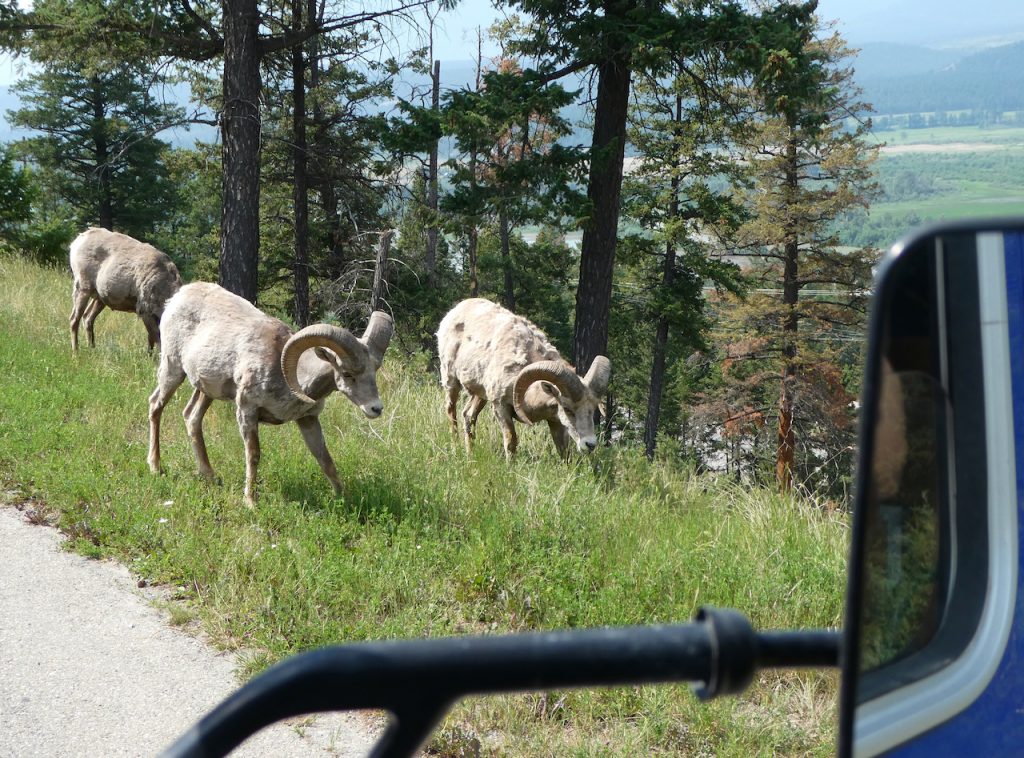
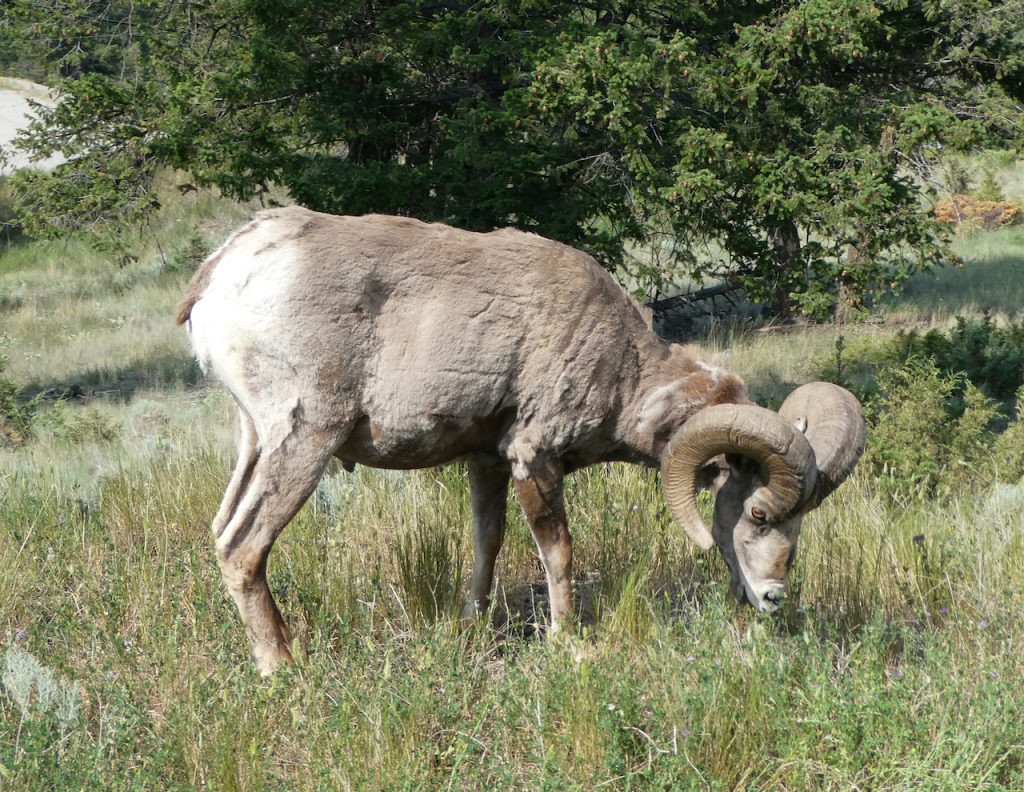
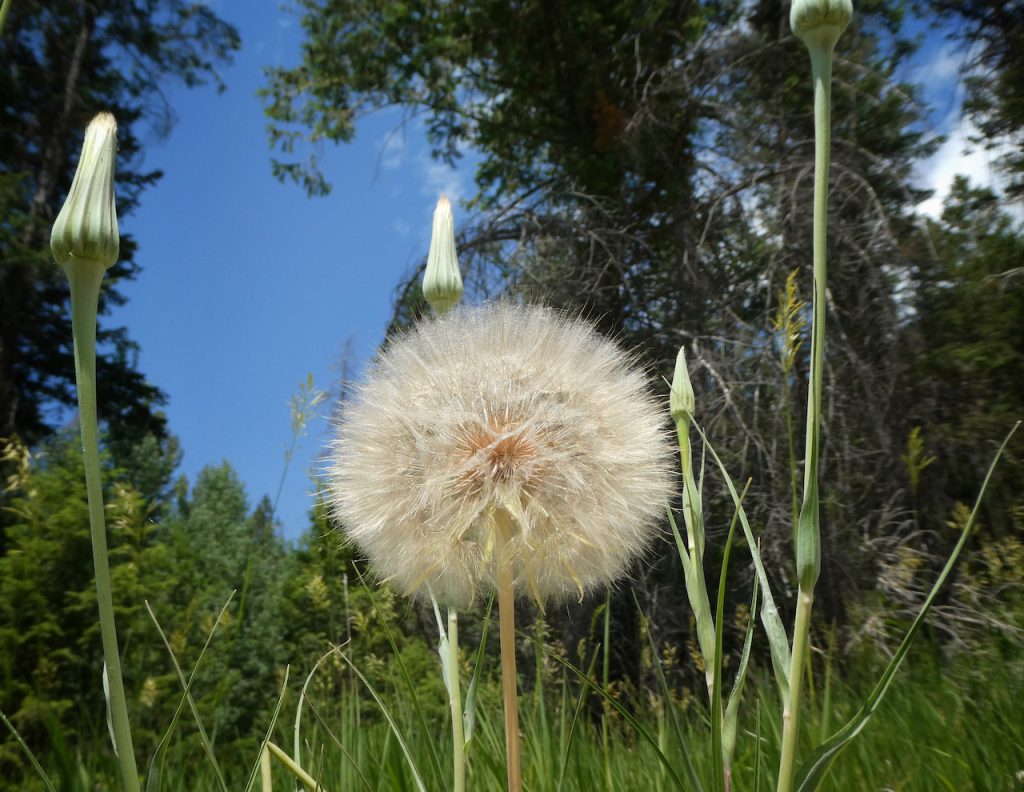
Leider geht es Sandie am nächsten Tag nicht ganz so gut und es regnet auch quasi 24 Stunden am Stück – das ist dann auch der Moment, wo wir beschließen, dass eine Antibiotikum Kur (wegen der Borreliose Gefahr nach dem Zeckenbiss) doch mal ganz angemessen wäre. Wir verschlummseln also einen ganzen Tag in Ewald und am nächsten Tag ist es zum Glück wieder trocken und nach 2 Tagen fühlt sich Sandie auch wieder besser.
Unfortunately, Sandie is not doing so well the next day and it rains for almost 24 hours straight – that’s the moment when we decide that an antibiotic cure (because of the risk of Lyme disease after the tick bite) would be quite appropriate. So we stay a whole day in Ewald and luckily it’s dry again the next day and after 2 days Sandie also feels better.
Leider hat der von uns anvisierte Campingplatz „Marble Canyon“ im Kootenay Nationalpark noch geschlossen. Somit fahren wir kurzerhand zum McLeod Meadow Campground und richten uns dort häuslich ein. Zum Glück muss man auch hier nicht reservieren – denn diese Reserverierei macht uns schon ganz verrückt. Wir können es gar nicht gut ertragen, zu detailliert zu planen und uns festlegen zu müssen. Und das muss man ja scheinbar in diesen anderen Parks wie Banff und Jasper. Furchtbar!
Unfortunately, the “Marble Canyon” campground we wanted to go to in Kootenay National Park is still closed. So we decide to go to the McLeod Meadow Campground and make ourselves at home there. Luckily you don’t have to reserve here either – because this reservation-thing drives us crazy. We can’t bear to plan too much and to have to commit ourselves. And apparently you have to in other parks like Banff and Jasper. Terrible!
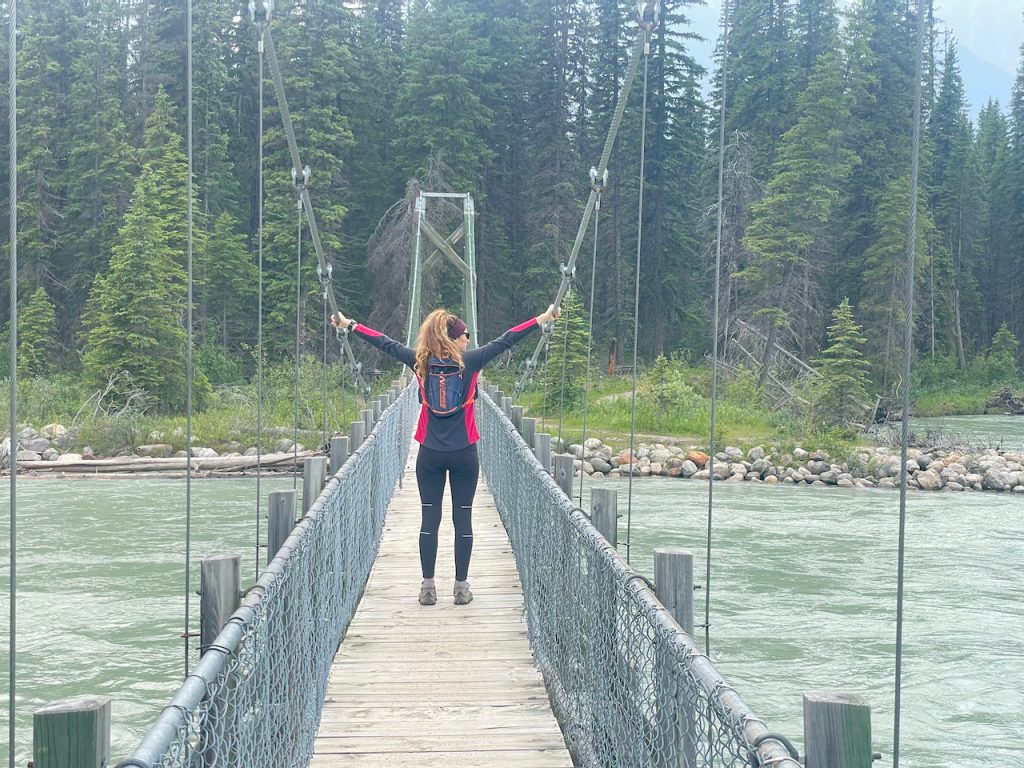
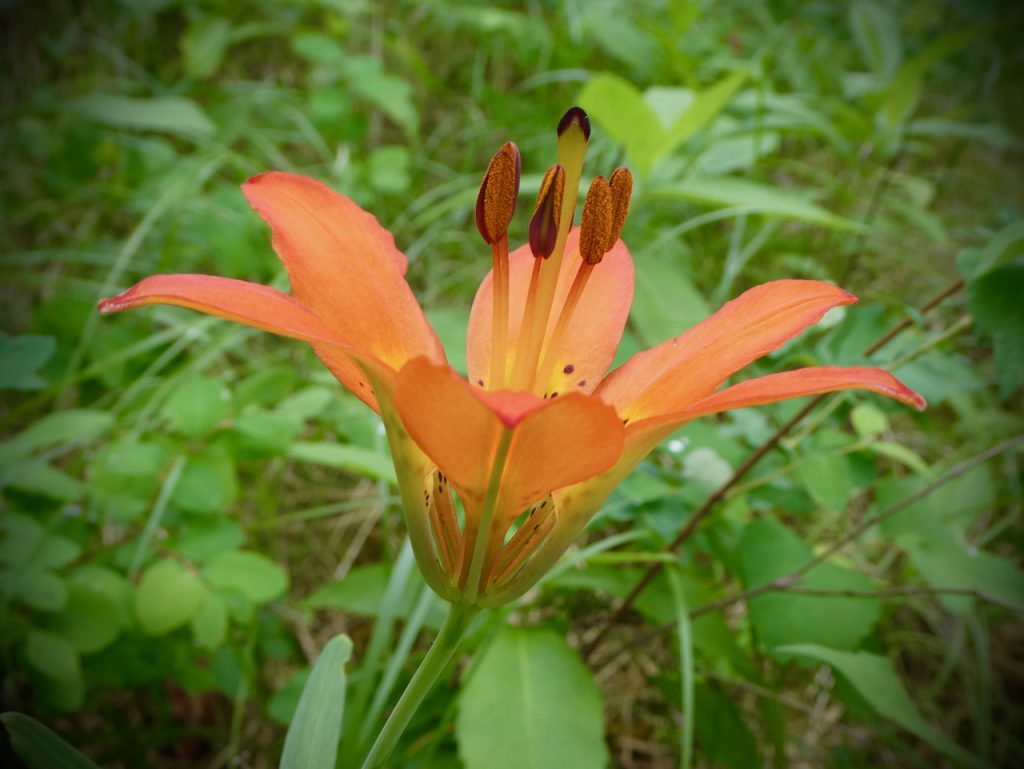
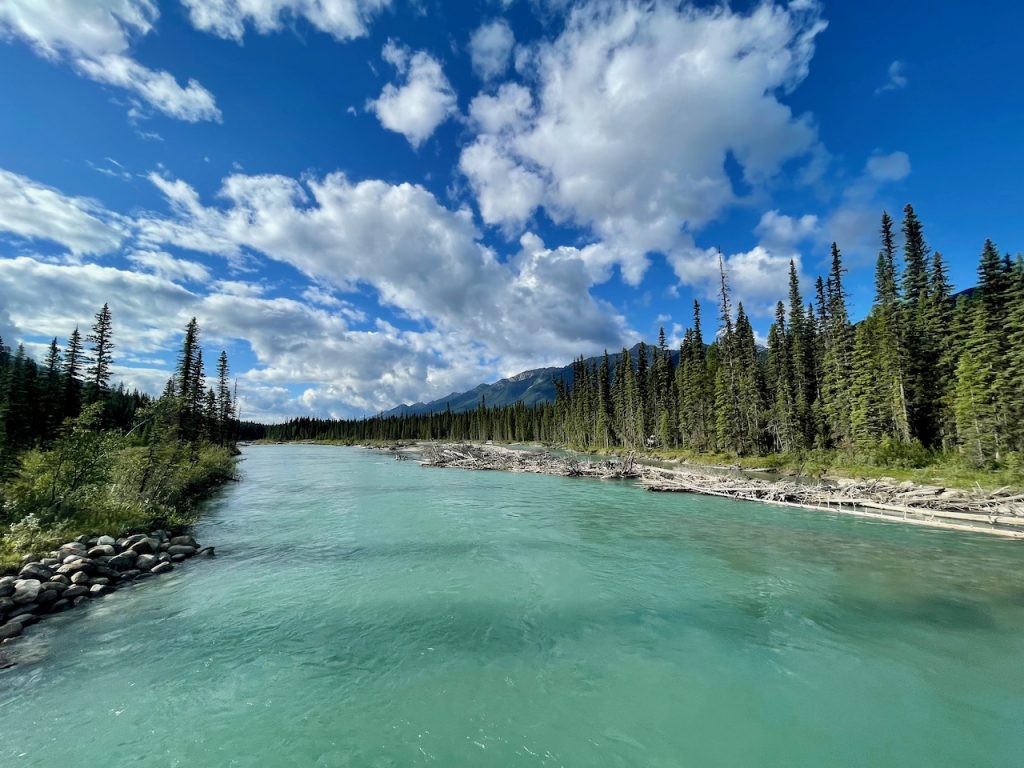
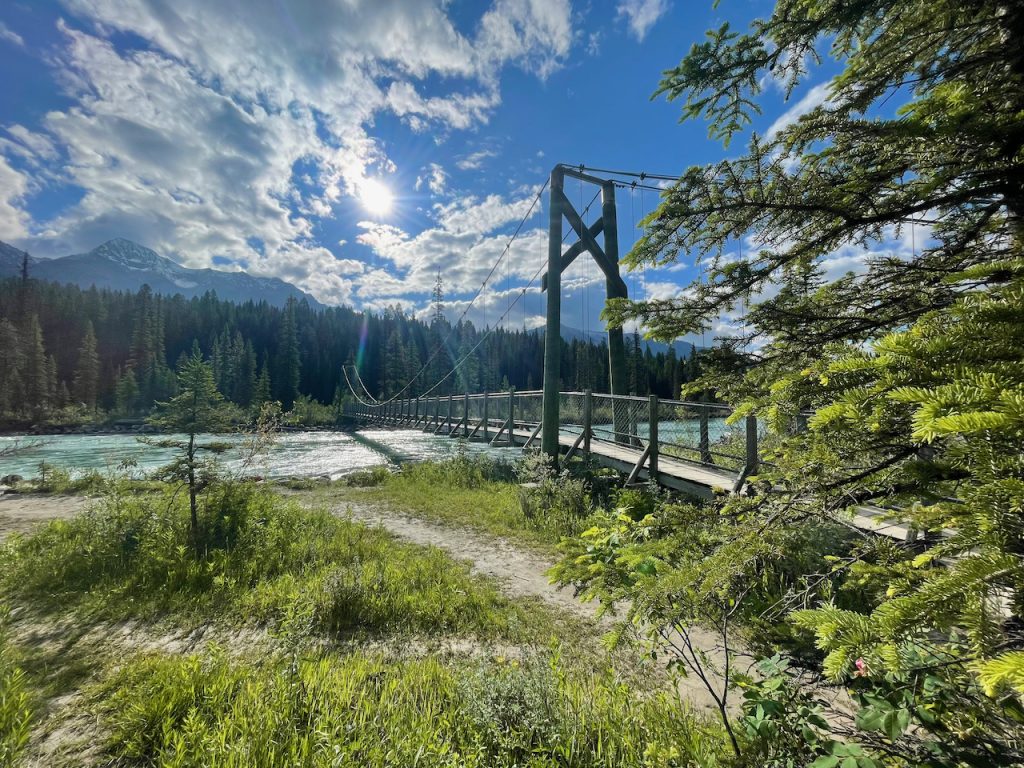
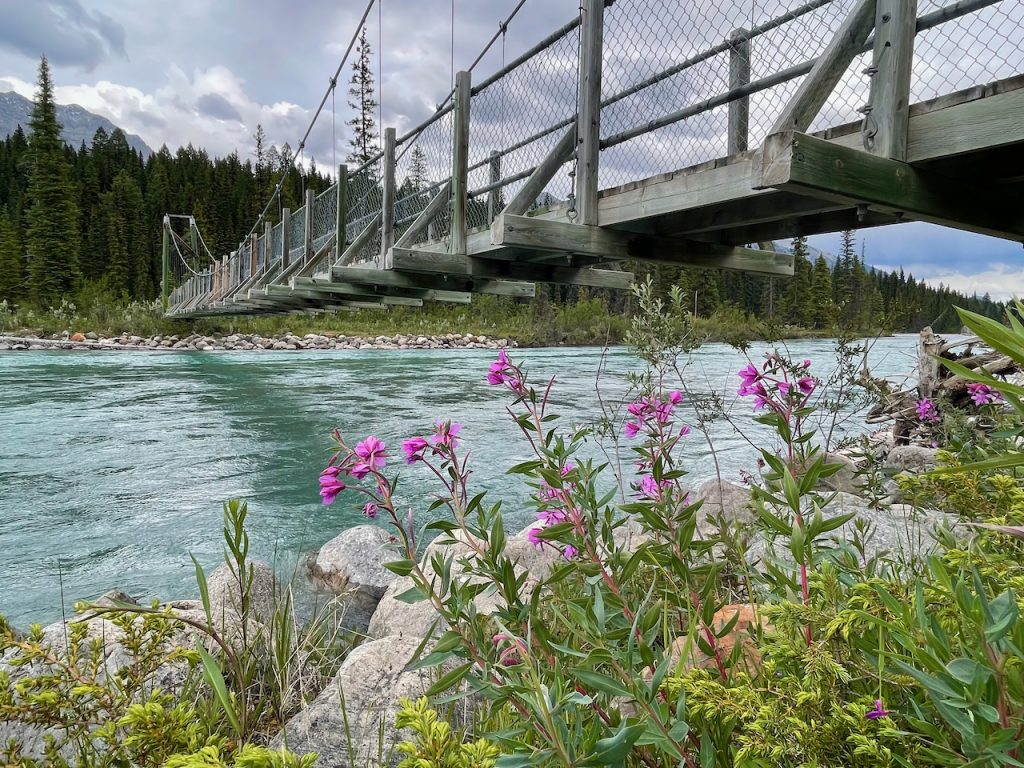
Von hier aus wandern wir zum Floe Lake. Es ist zwar nicht sehr sonnig aber recht mild und trocken und somit perfektes Wanderwetter. Nach nur einem Kilometer, kommt uns recht zügig ein Pärchen entgegen und gleich dahinter ein recht imposanter Schwarzbär. Wir drehen dann auch erst mal um und gehen wieder (zügig) Richtung Ausgangspunkt und der Bär bleibt stur auf dem Wanderweg. Doch dann verlässt er irgendwann den schmalen Pfad und wir können unsere Wanderung fortsetzen. Ist immer wieder spannend … und wir haben ordentlich Respekt. Die Wanderung ist insbesondere auf den letzten 2 Kilometern zum See hin mit insgesamt 1.100 Höhenmetern knackig. Oben ist es dann auch recht frisch und trotz schöner Aussicht machen wir nur eine kurze Vesperpause. Ein schöner, spannender und anstrengender Tag.
From here we hike to Floe Lake. Although it is not very sunny, it is quite mild and dry and therefore perfect hiking weather. After just one kilometer, a couple comes towards us quite quickly and right behind them a rather impressive black bear. We turn around as well and go back (quickly) towards the starting point and the bear follows us for quite a long time. After a while he leaves the narrow path and we can continue our hike. It’s always exciting … and we have a lot of respect. The hike is particularly challenging on the last 1.5 miles to the lake with a total gain of 3,610 feet in altitude. It’s also quite fresh at the top and despite the beautiful view, we only take a short snack break. A beautiful, exciting and exhausting day.
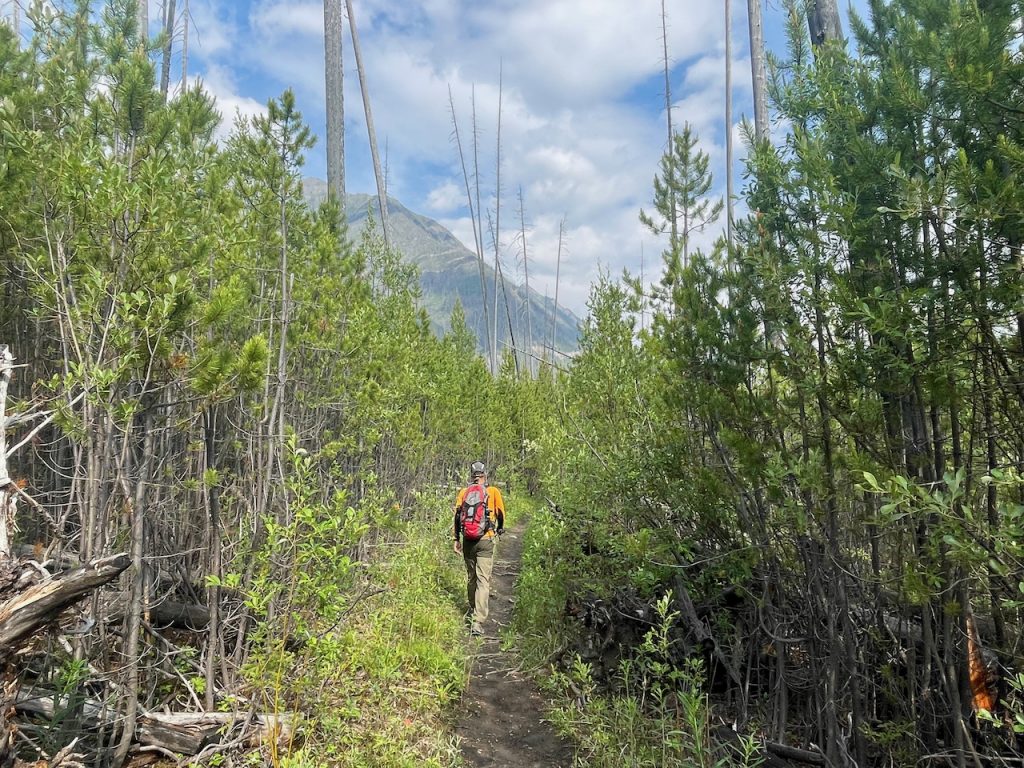
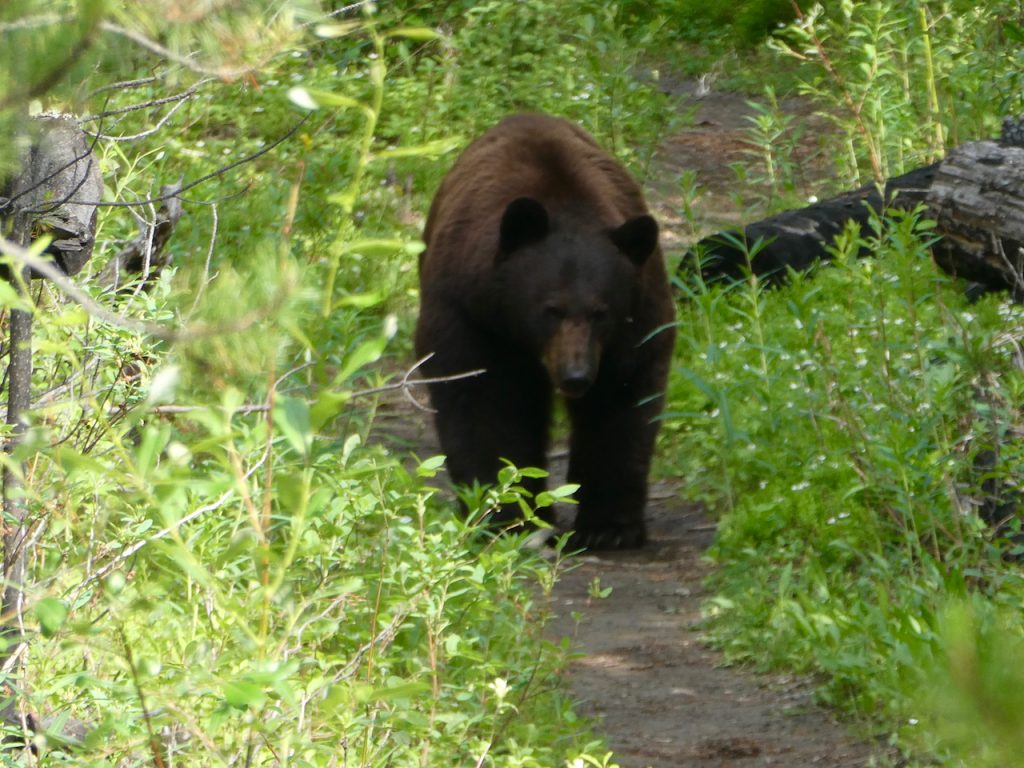
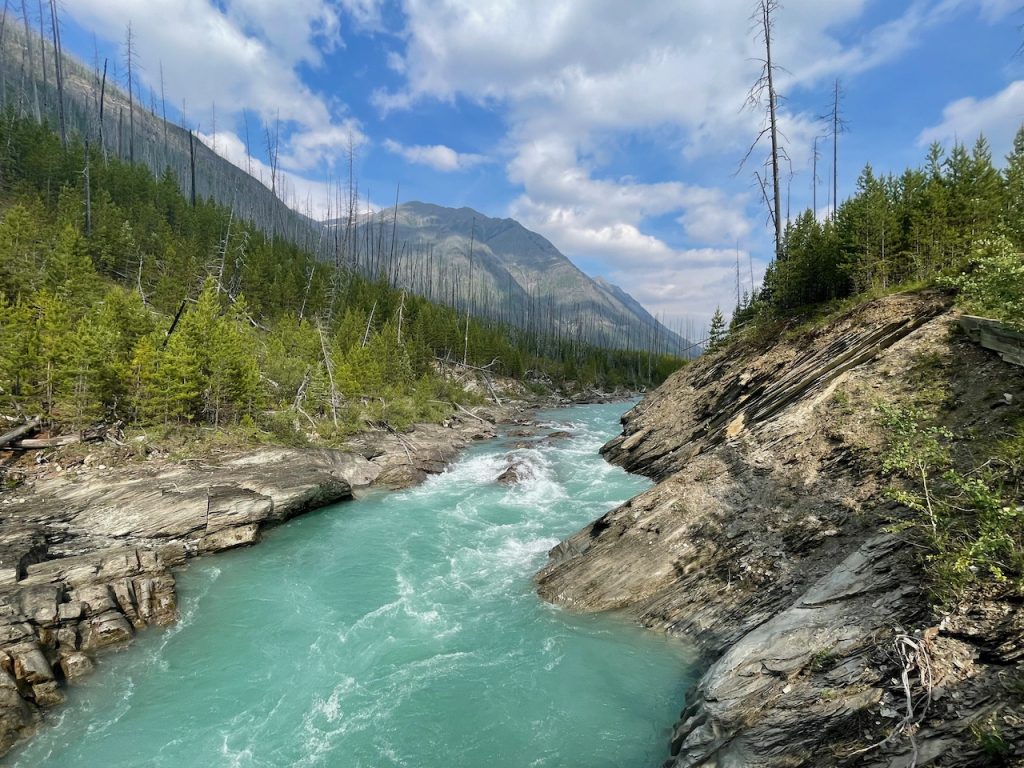
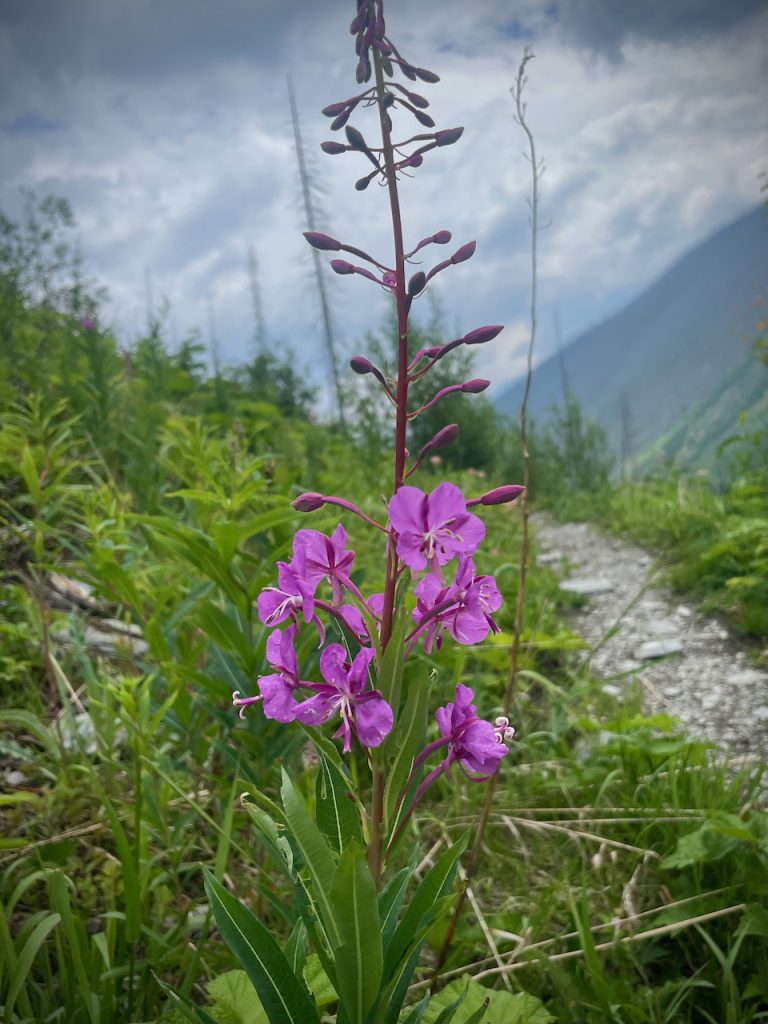
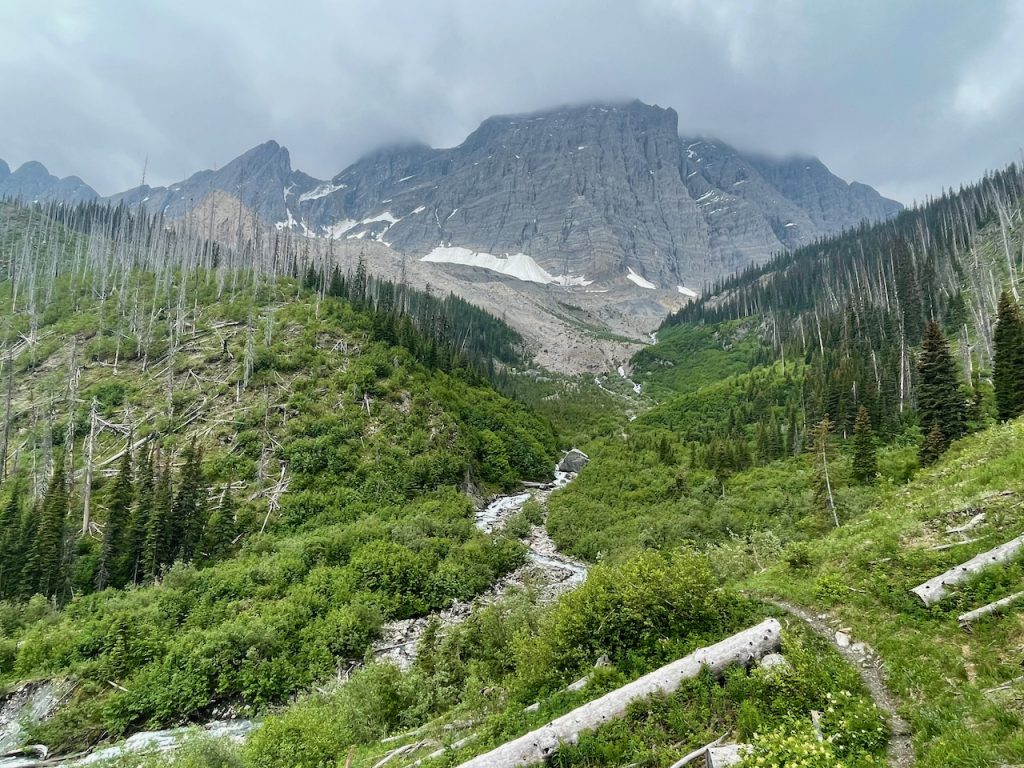
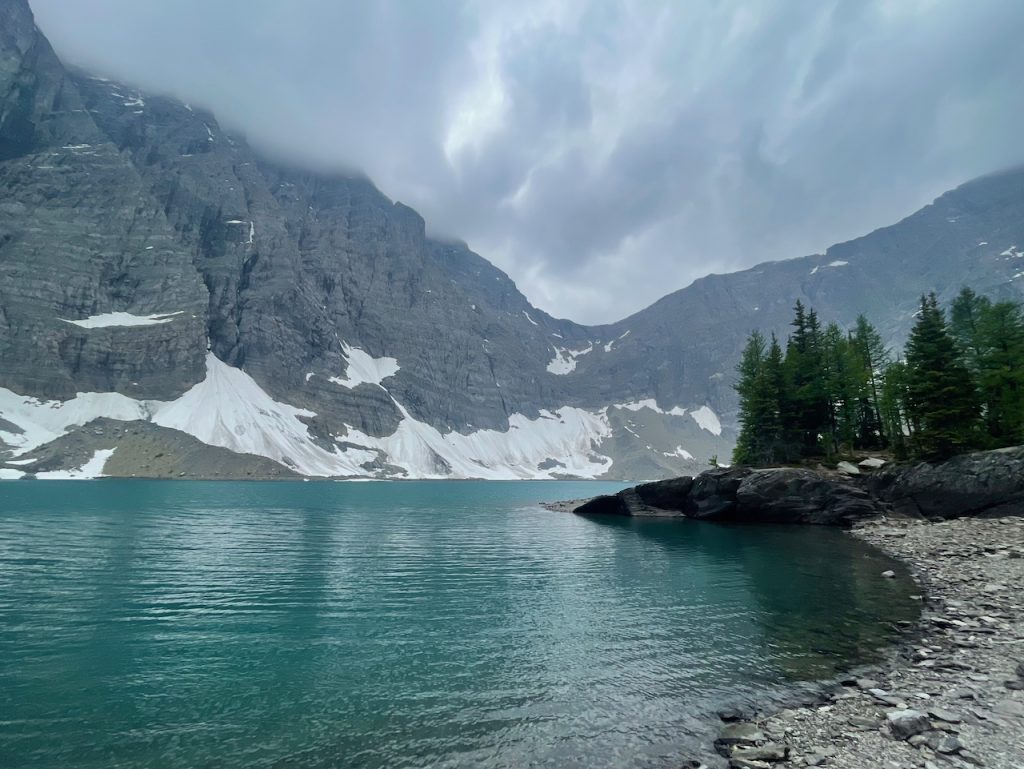
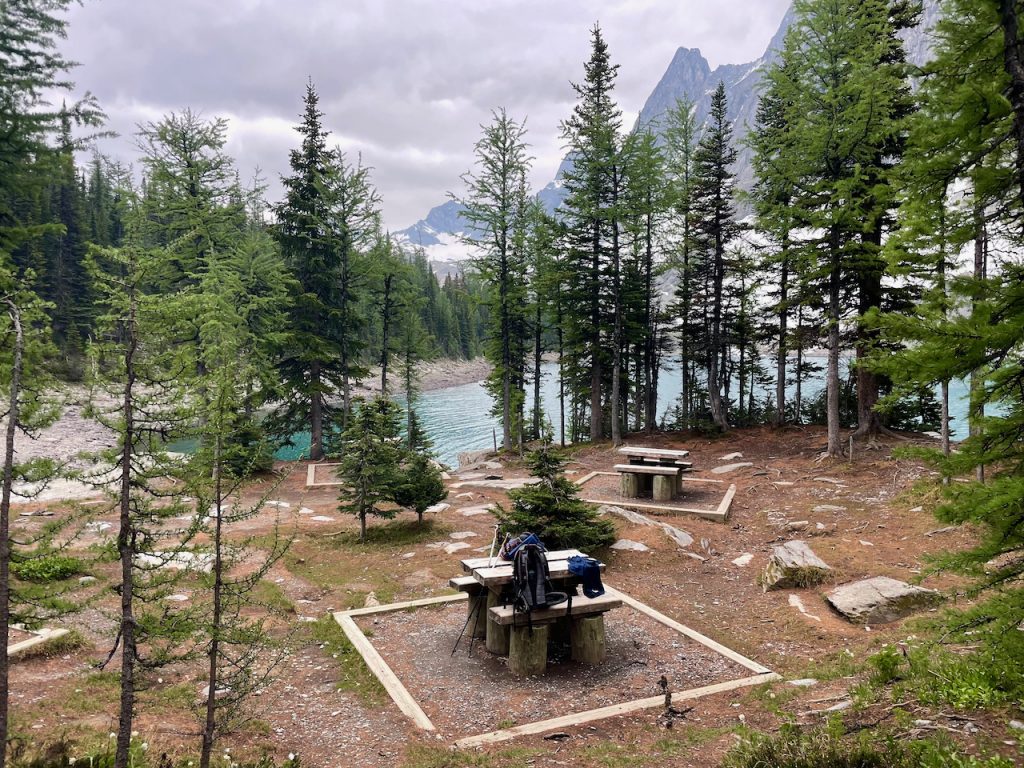
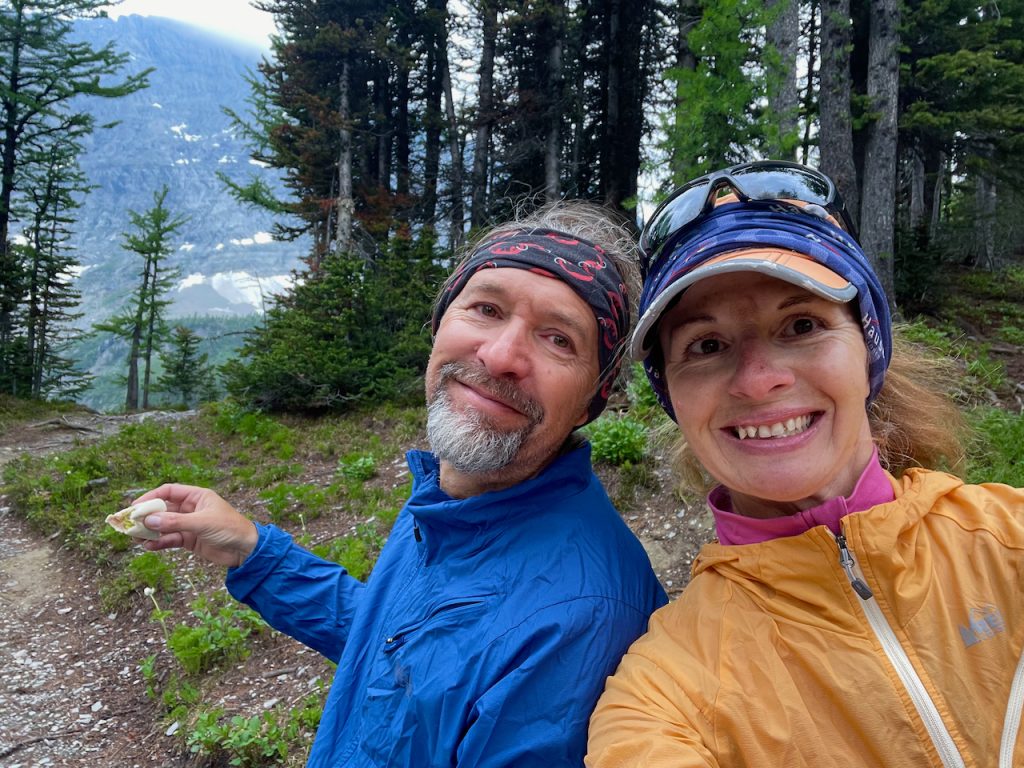
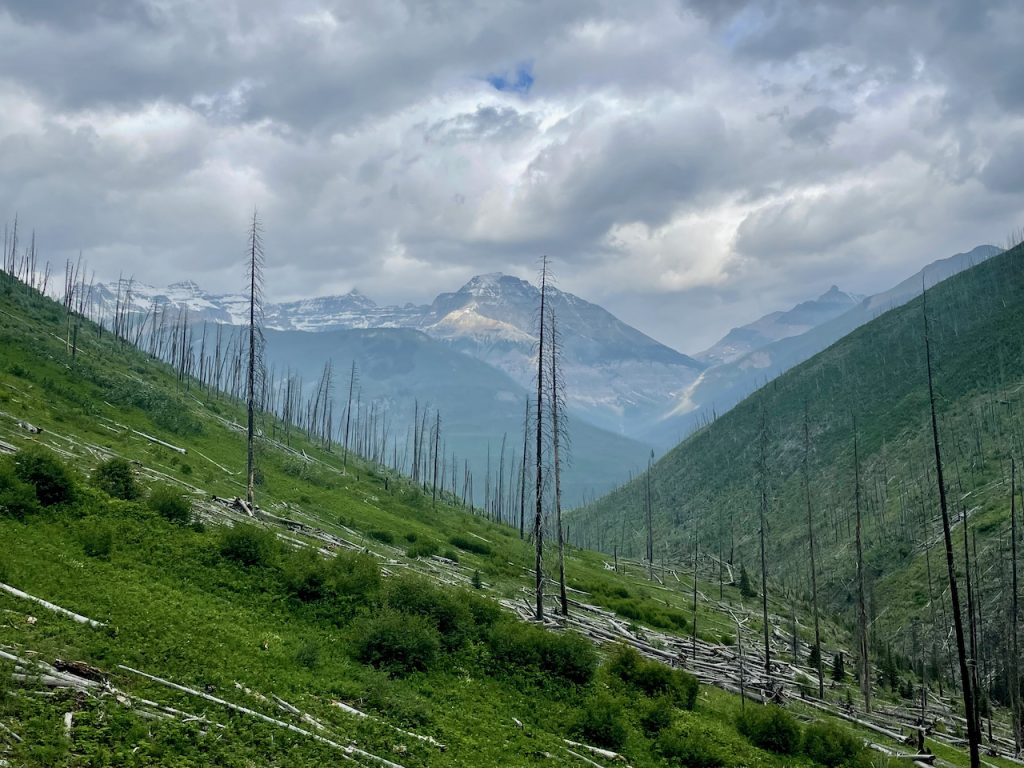
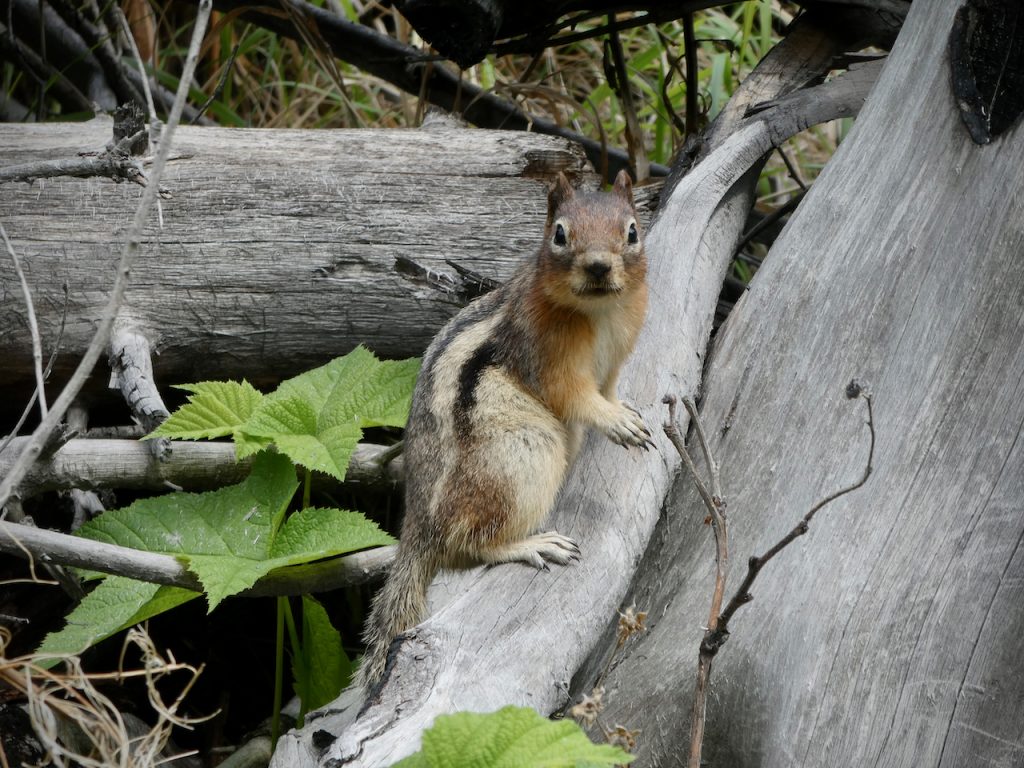
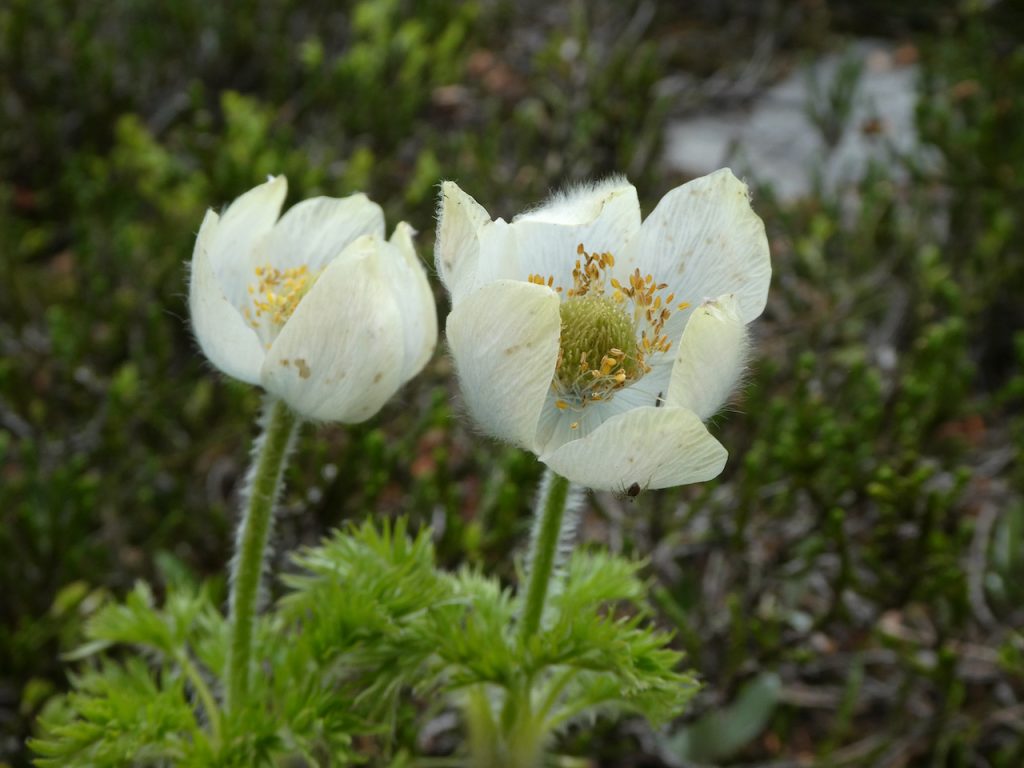
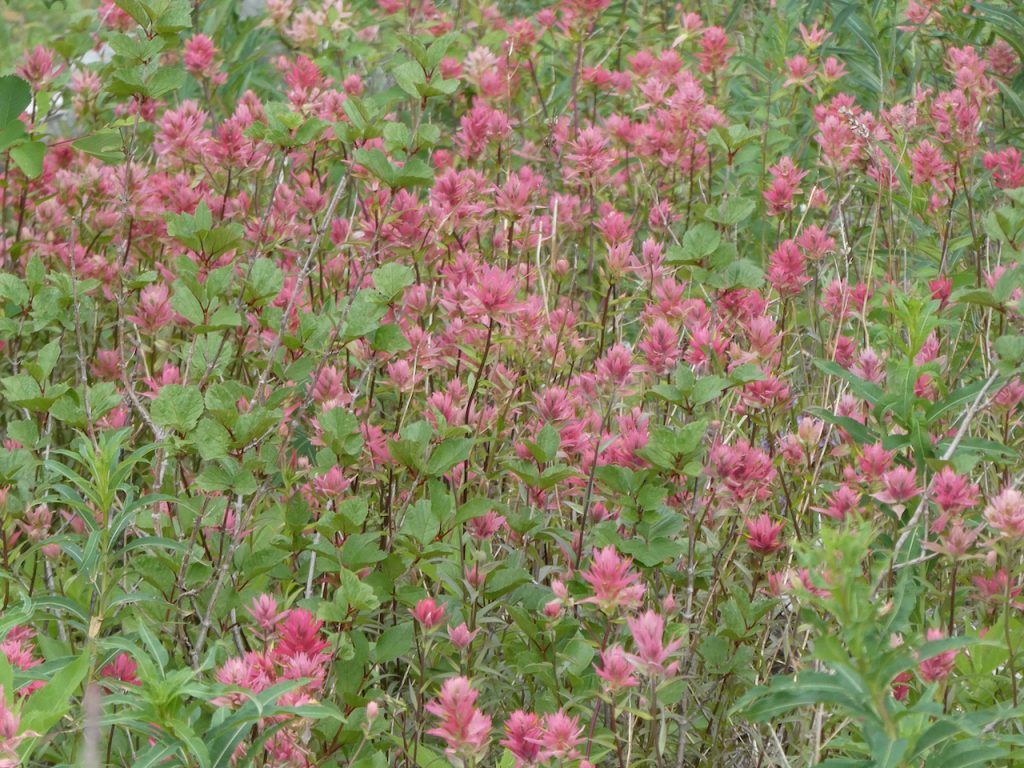
Wir unternehmen noch kleinere Märsche und Läufe um die McLeod Meadow und dann ist es auch schon an der Zeit zu unserer ersten Reservierung in Banff aufzubrechen. Das Wetter ist bescheiden. Aber wir wussten was uns klimatisch erwarten wird und hoffen, dass die 3 gemeldeten kalten und regnerischen Tage nicht ganz so schlimm werden. Auf dem Weg klart es jedoch etwas auf und wir halten spontan am Stanley Glacier Trailhead an. Ordentlich eingepackt gehen wir den 12 km Rundweg und sehen den sich zurückziehenden Gletscher aus der Ferne – das hat sich auf jeden Fall gelohnt. Und dann kommen wir in Banff an …
We do some short hikes and runs around McLeod Meadow and then it’s time to head to our first reservation in Banff. The weather is modest. But we knew what to expect in terms of climate and hope that the 3 reported cold and rainy days won’t be that bad. However, on the way it clears up a bit and we spontaneously stop at the Stanley Glacier Trailhead. Well dressed, we walk the 7 miles route with about 2,300 feet of elevation gain and see the remains of the glacier from a distance- it was definitely worth it. And then we arrive in Banff…
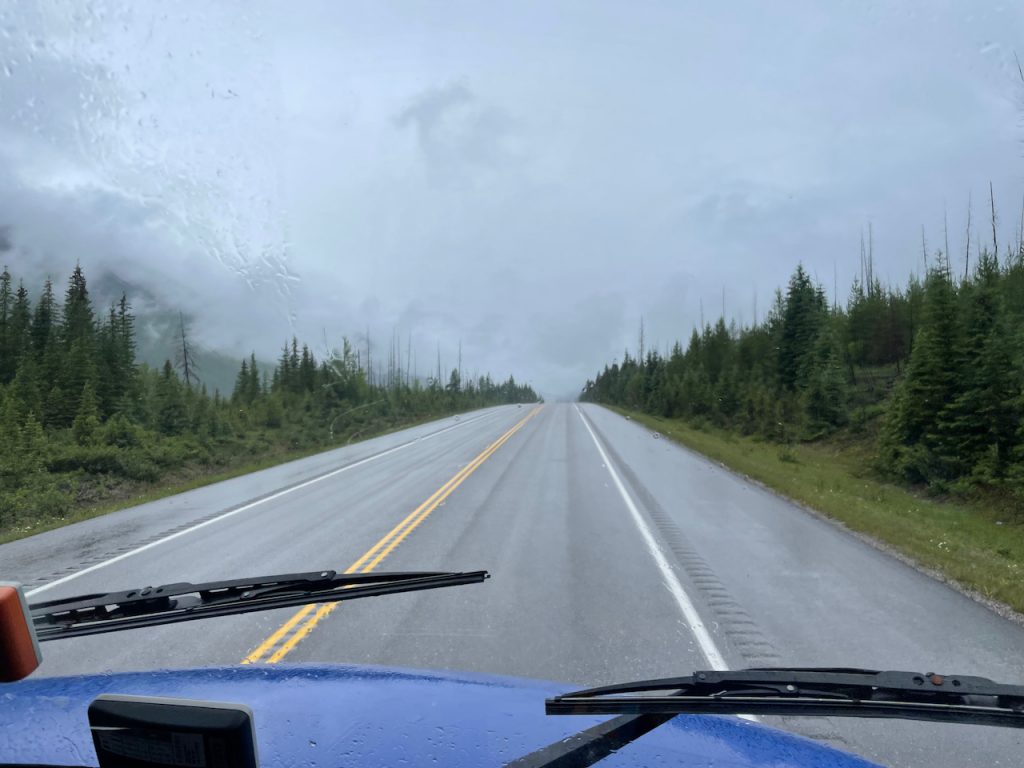
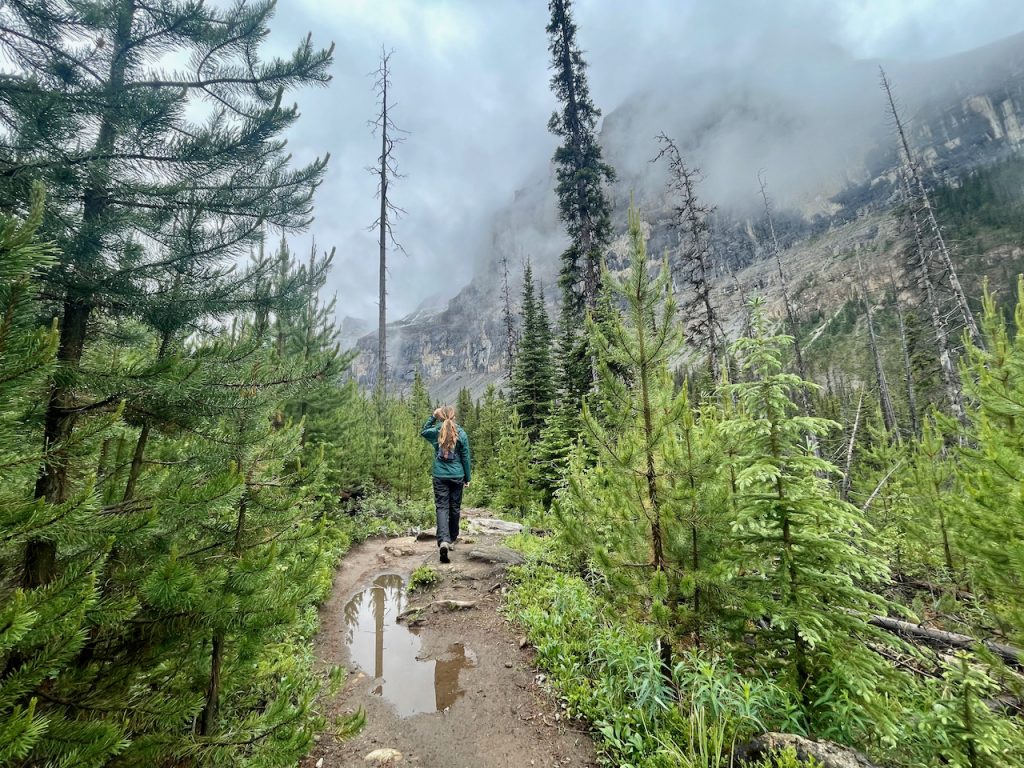
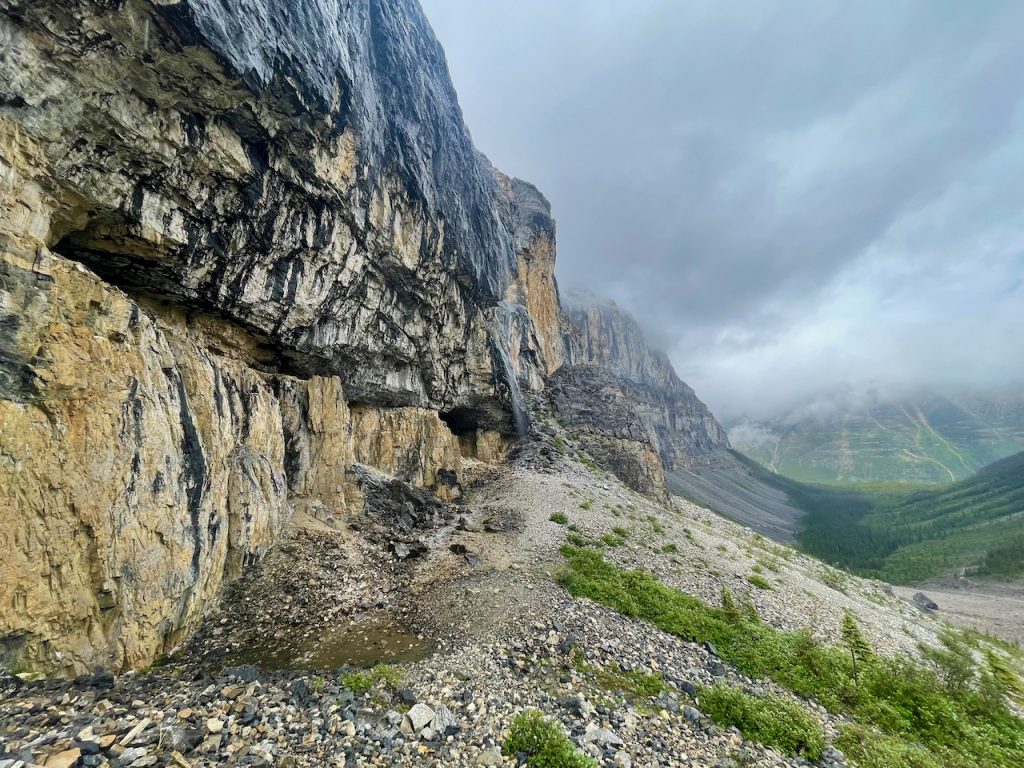
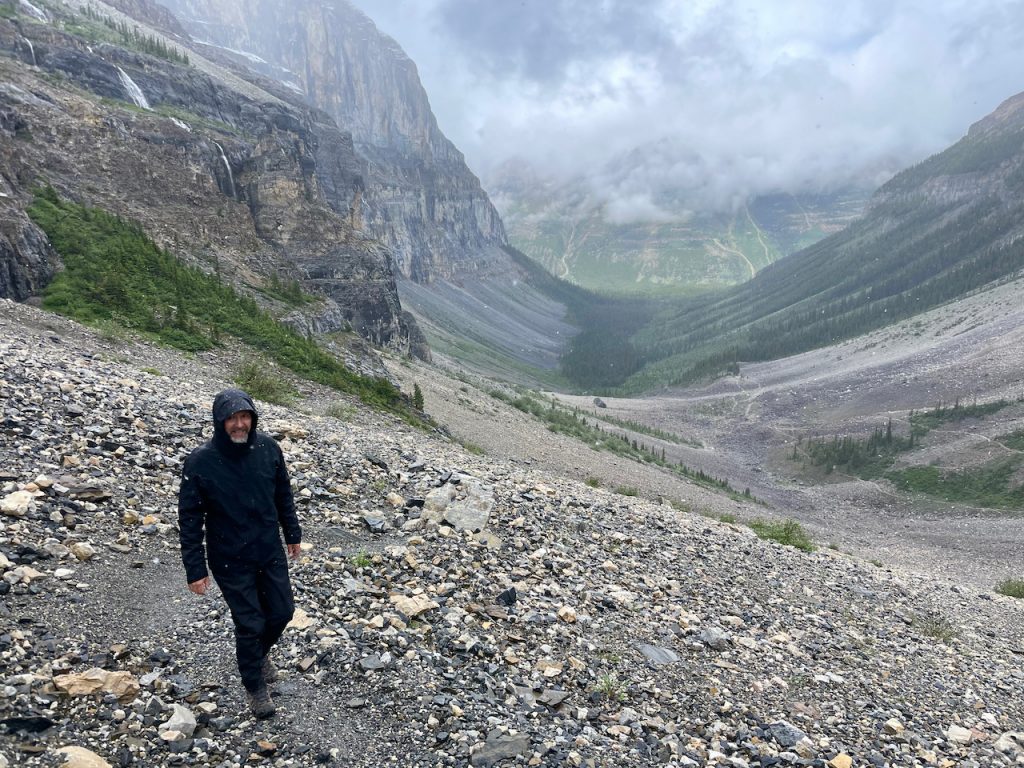
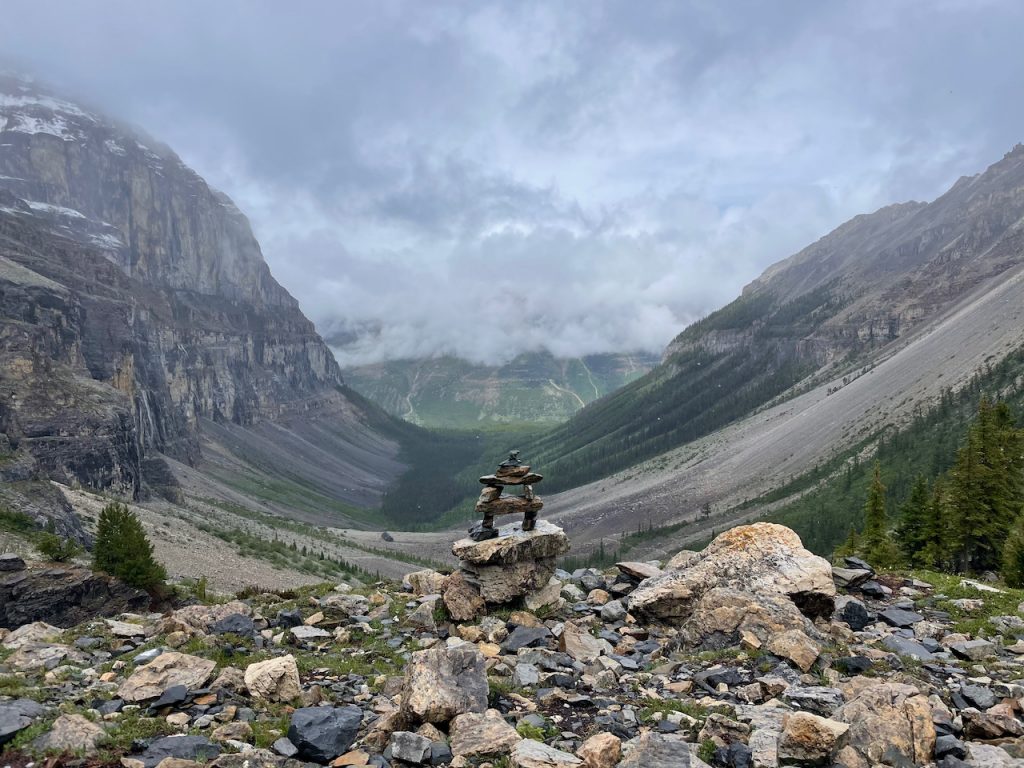
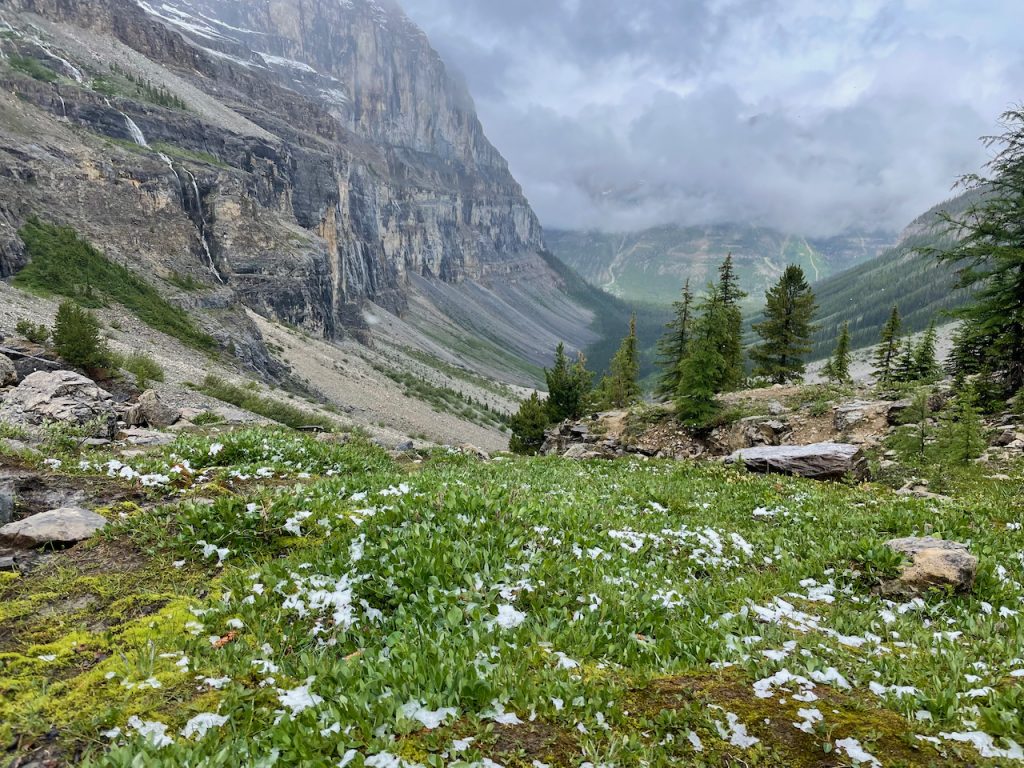
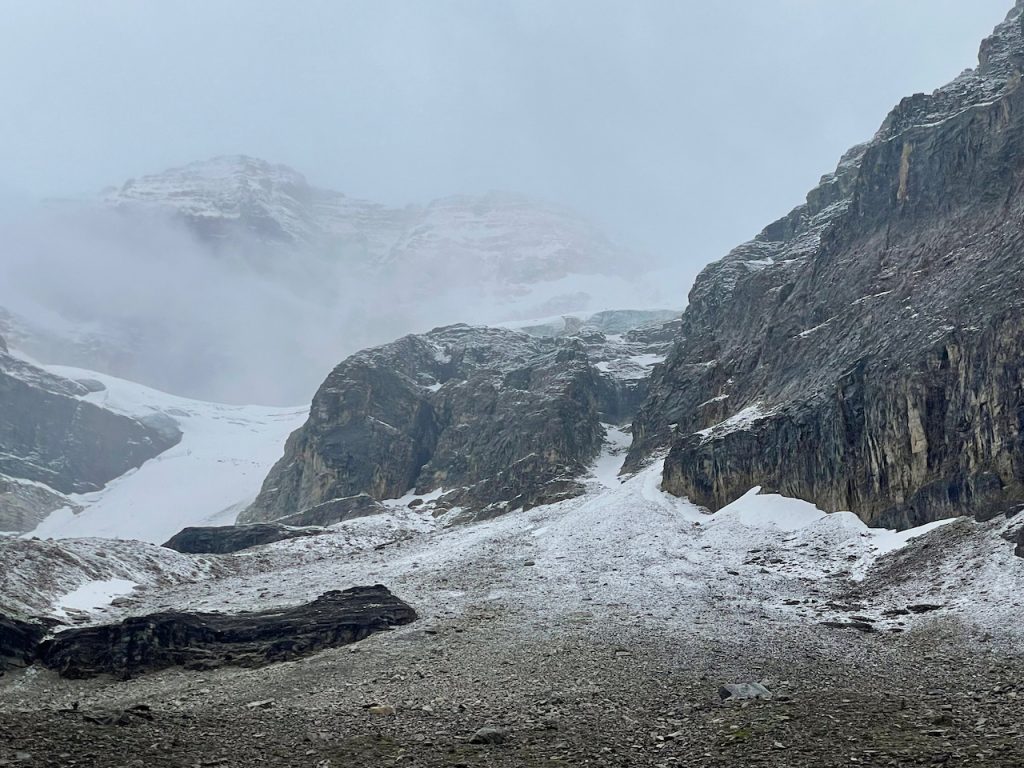
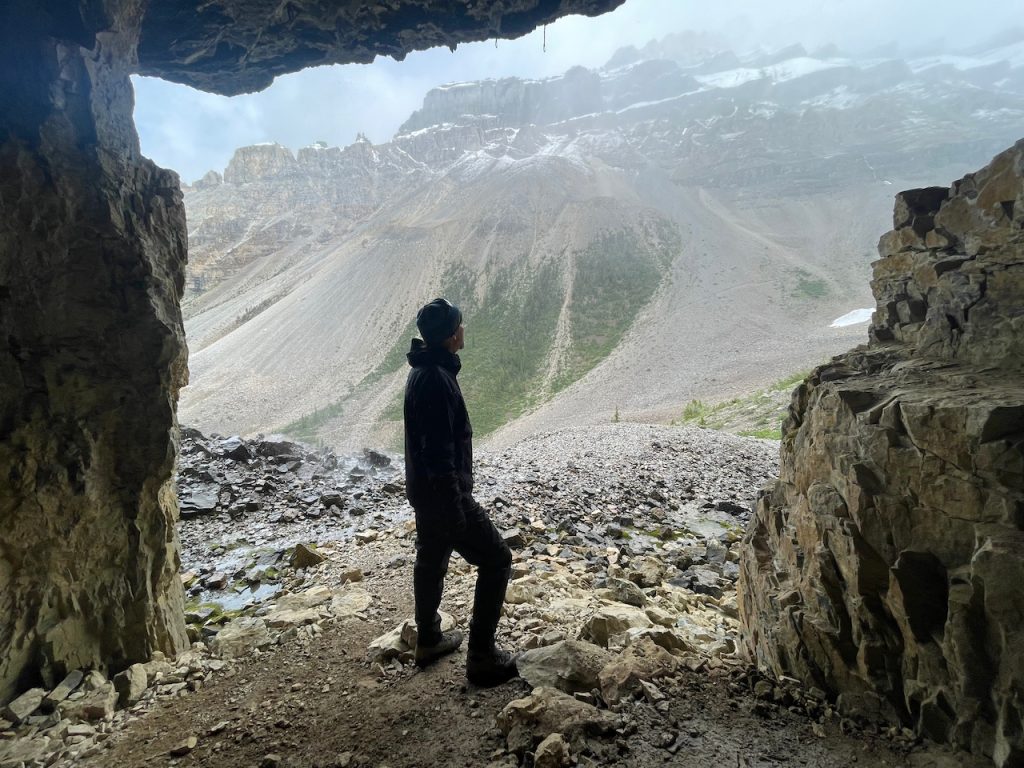
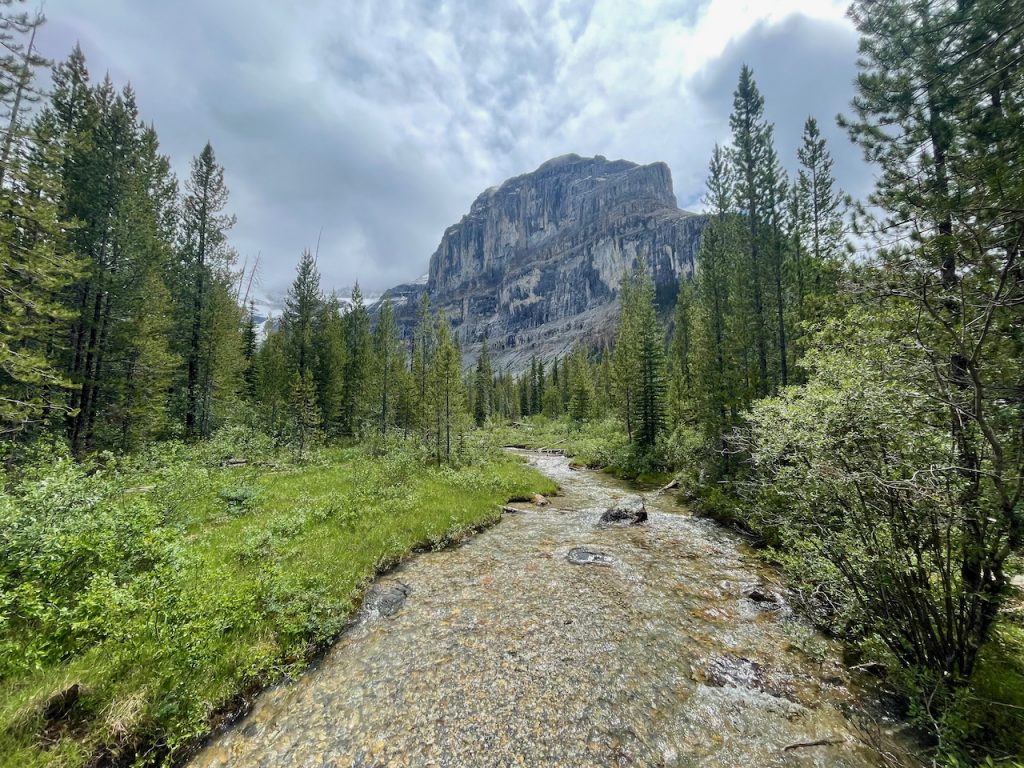
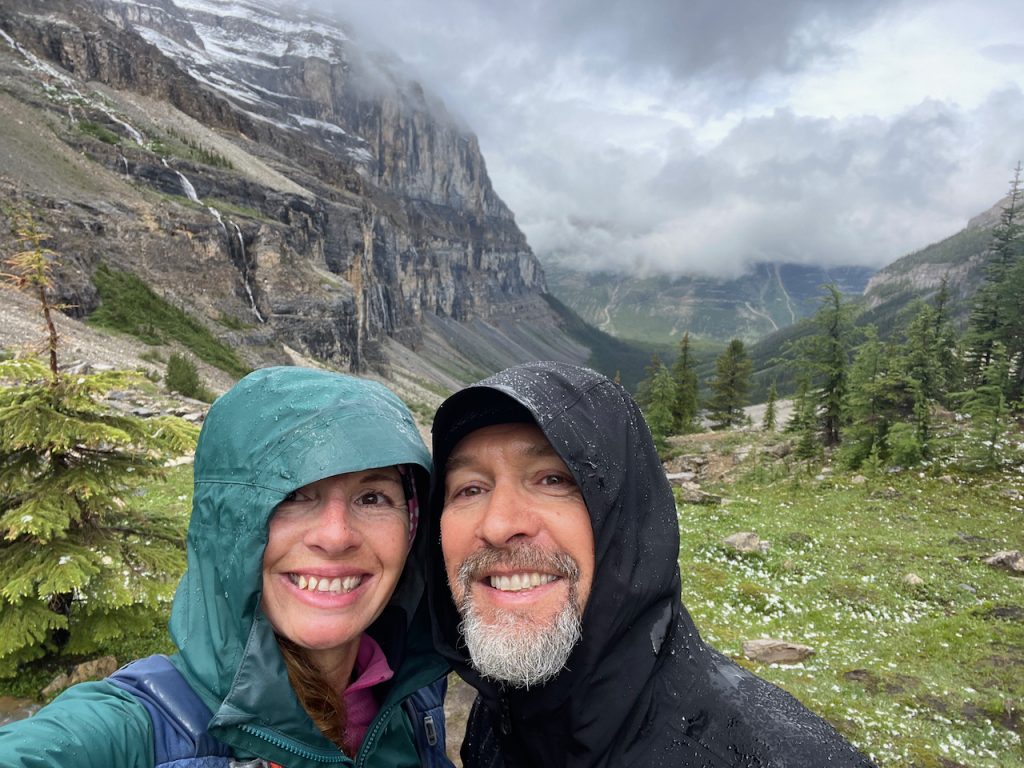
Banff – wir wissen gar nicht wo wir anfangen sollen – zunächst einmal ist Banff ein recht großer Nationalpark in Alberta. In diesem Nationalpark liegt unter anderem auch der Ort Banff. Das ist so ganz anders, als die Nationalparks, die wir von den USA her gewöhnt sind. Dort wird alles weitestgehend natürlich belassen. Und hier ist es super kommerziell mit unzähligen Läden, Restaurants, Snackbars, Einkaufszentren … scheinbar alles was das normale Touristen-Herz begehrt. Denn Banff ist auch sagenhaft überlaufen. Die 2.800 Campingplätze sind regelmäßig total ausgebucht und scheinbar auch die Hotels. Am Banff Eingangsschild stehen die Leute in Schlangen an, um sich dort fotografieren zu lassen. Alles TOTAL irre und nicht wirklich unser Ding. Die Kulisse in den Rockies ist jedoch atemberaubend, auch wenn wir wegen der Wolken nicht so viel davon sehen. Wir sehen viele Hirsche und über den Campground laufen Coyoten und Füchse und abends gehen wir im Ort äusserst lecker indisch essen. Das ist dann wiederum der Vorteil des Tourismus.
Banff – we don’t even know where to start – first of all, Banff is a fairly large national park in Alberta. The town of Banff is also located in this national park. This is so very different from all the national parks that we are used to from the USA. Everything there is left as natural as possible. And here it is super commercial with countless shops, restaurants, snack bars, shopping malls … apparently everything the normal tourist heart desires. And Banff is also fabulously overcrowded. The 2,800 campsites are regularly fully booked and apparently so are the hotels. At the Banff entrance sign, people line up to have their photos taken there. Everything is TOTALLY crazy and not really our thing. However, the backdrop in the Rockies is stunning, although we didn’t see as much of it because of the clouds. We see a lot of deer and coyotes and foxes walk across the campground and in the evening we go to the village for a delicious Indian meal, which is really nice.
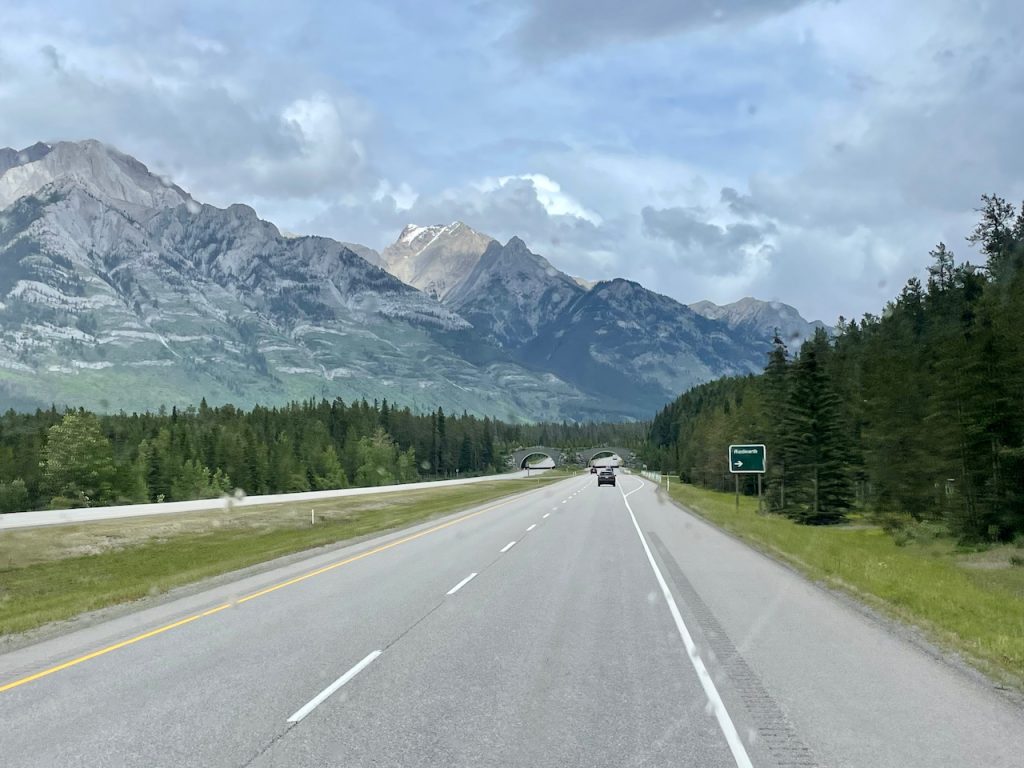
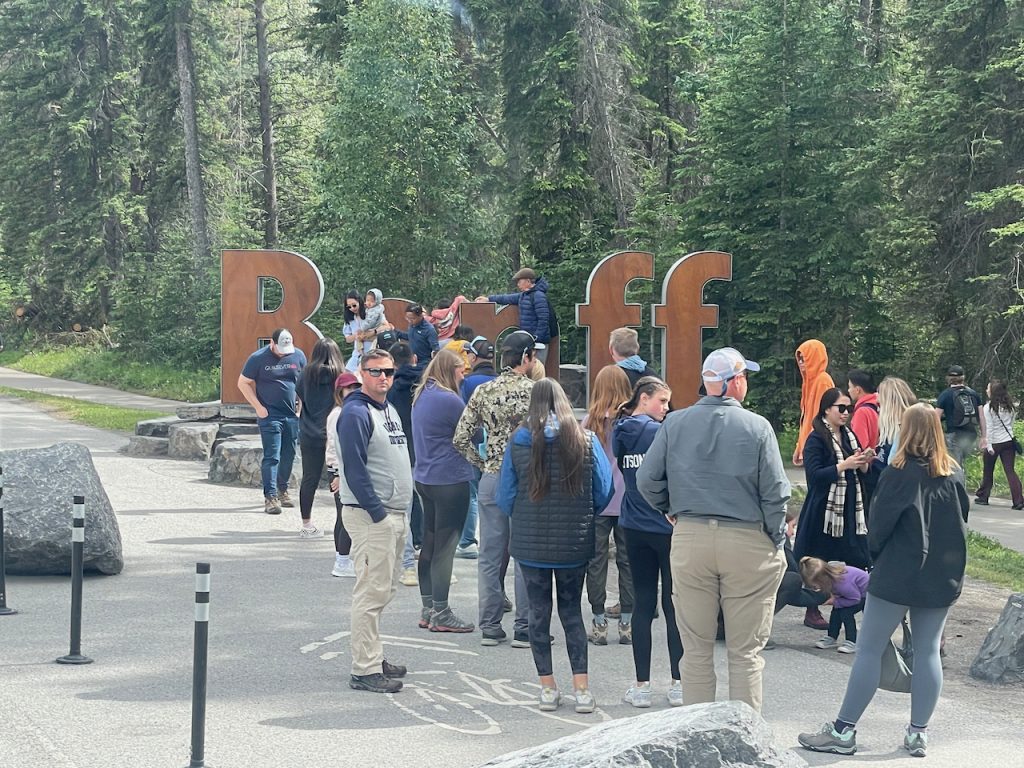
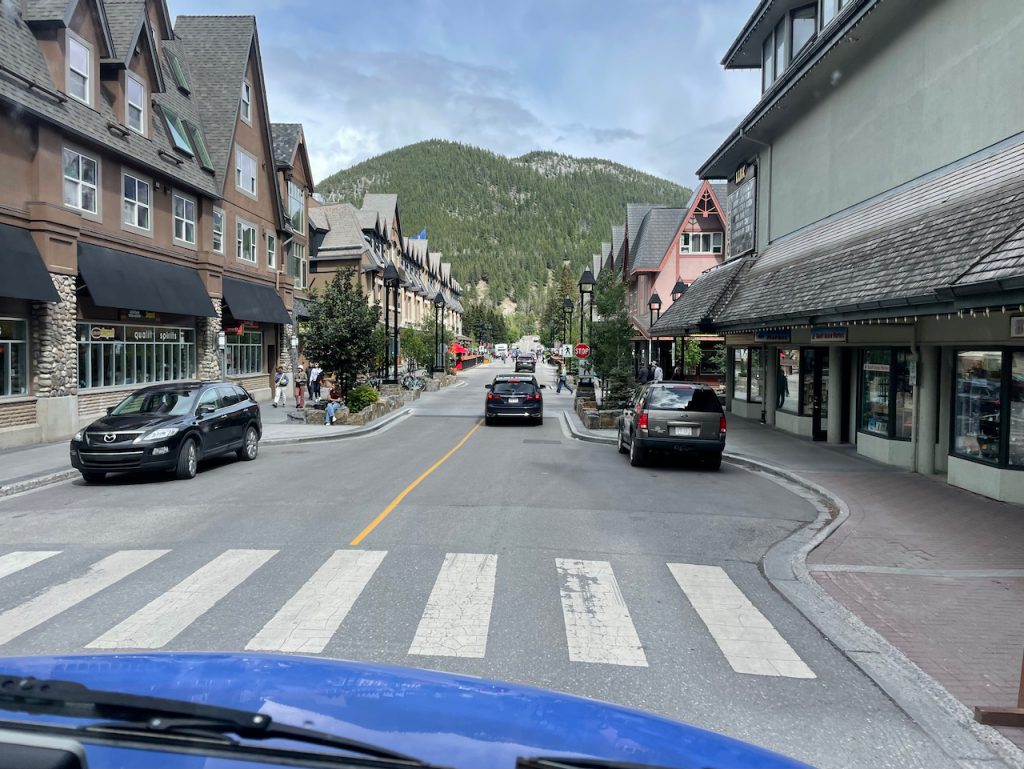
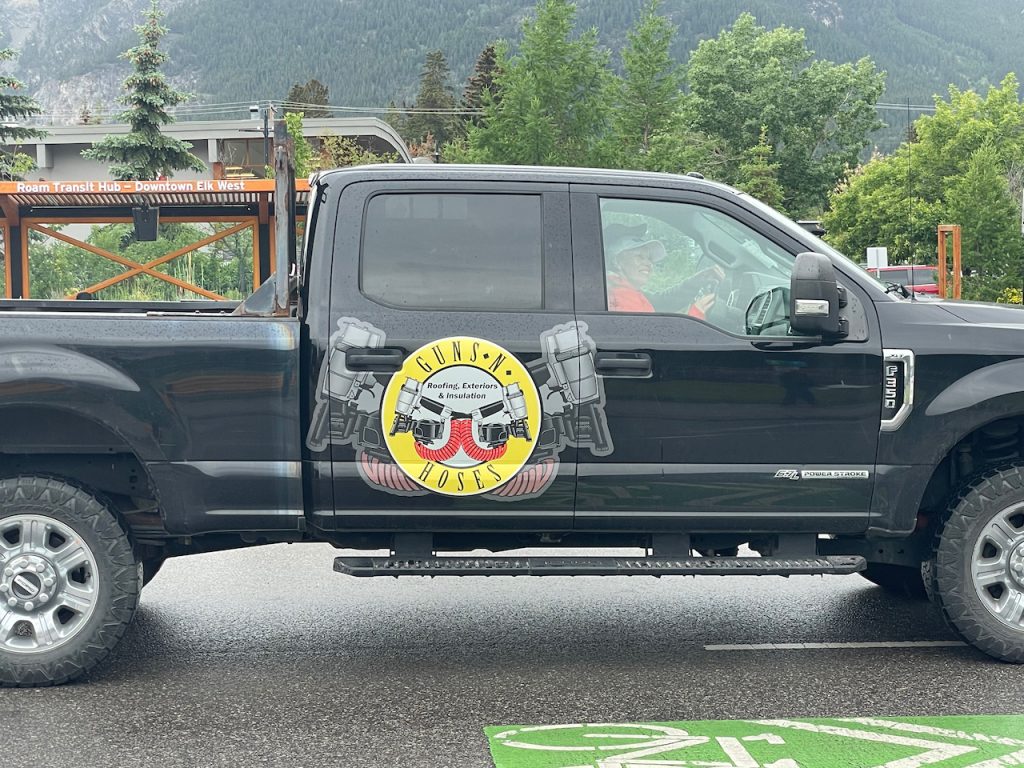
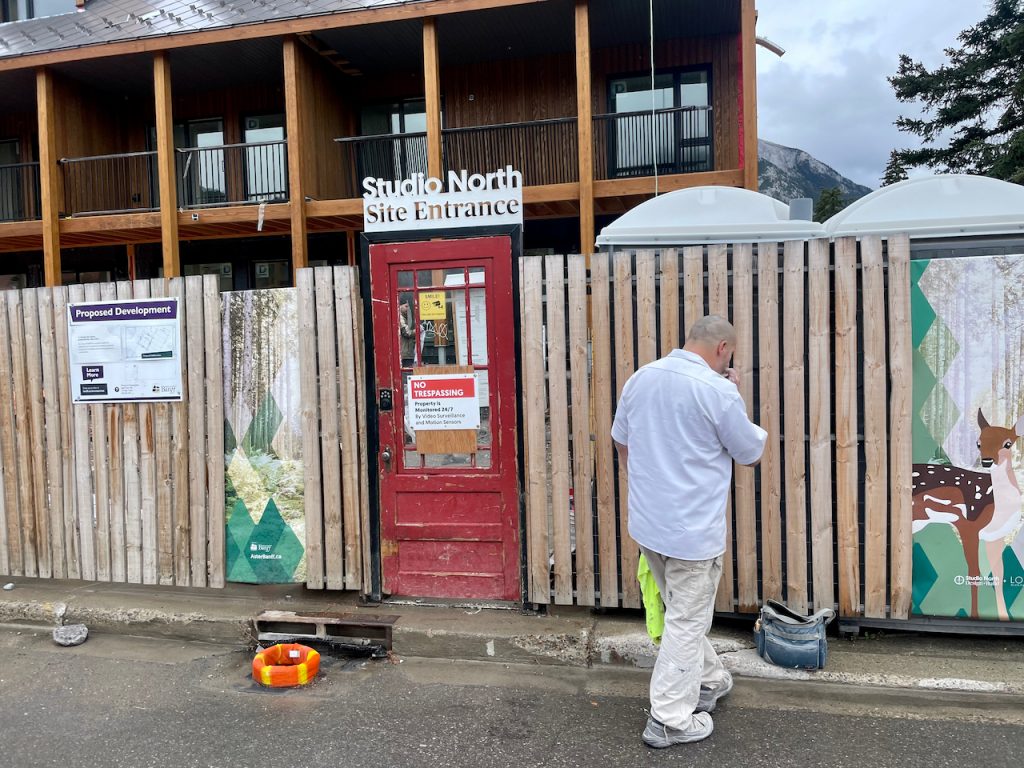
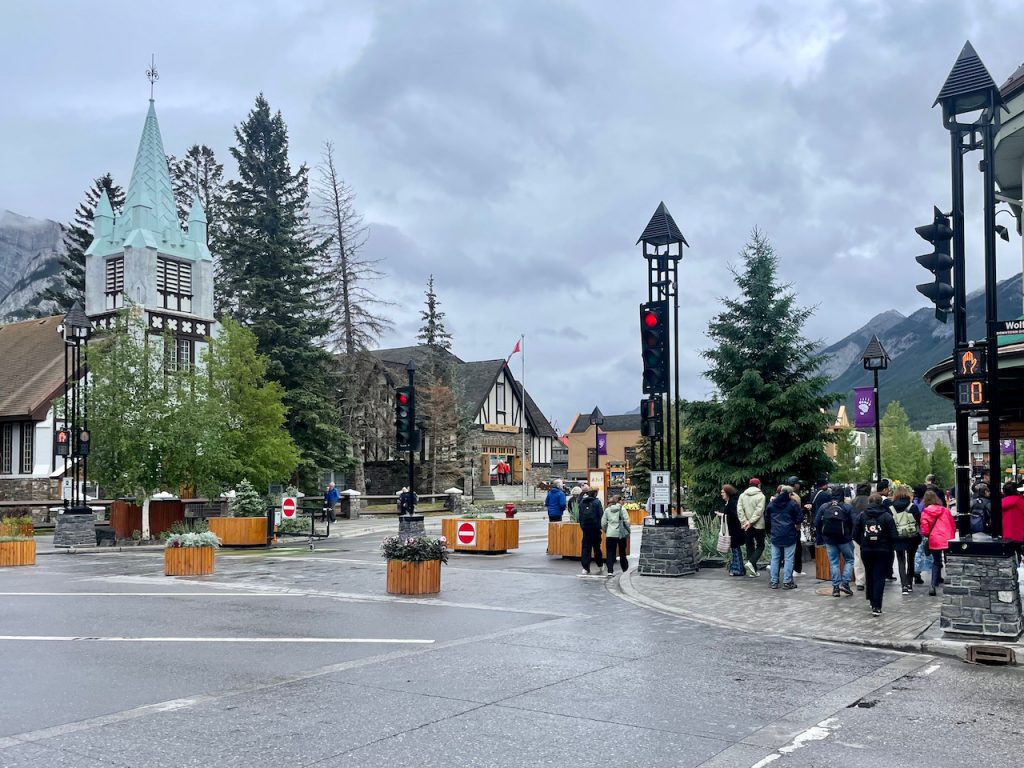
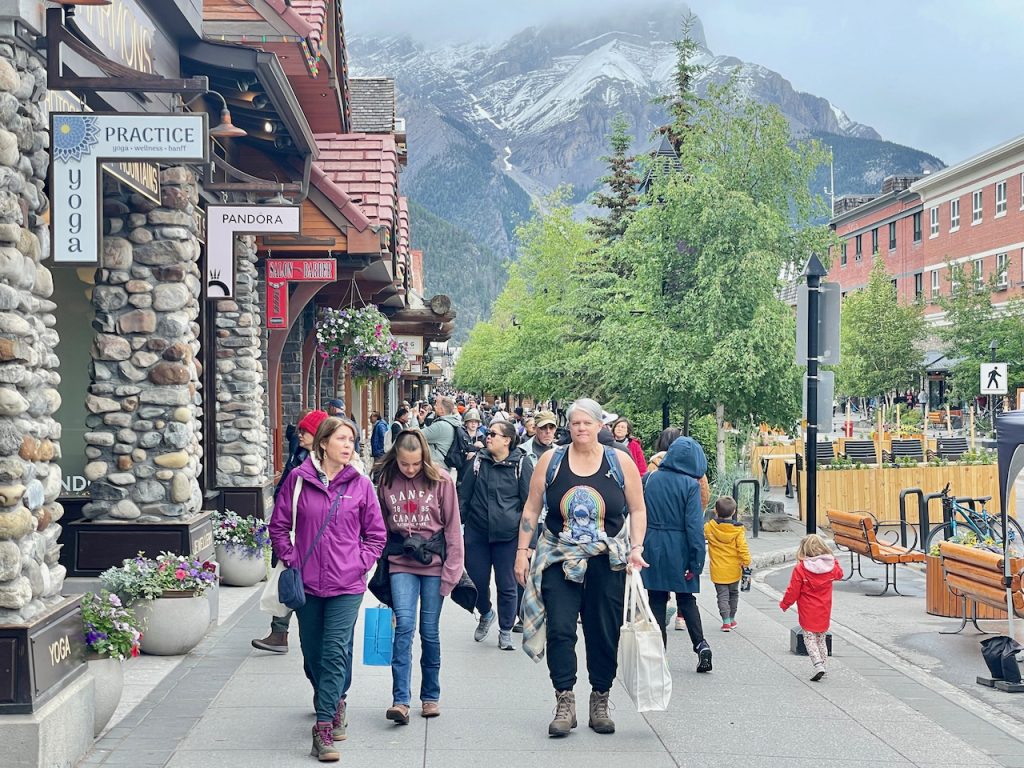
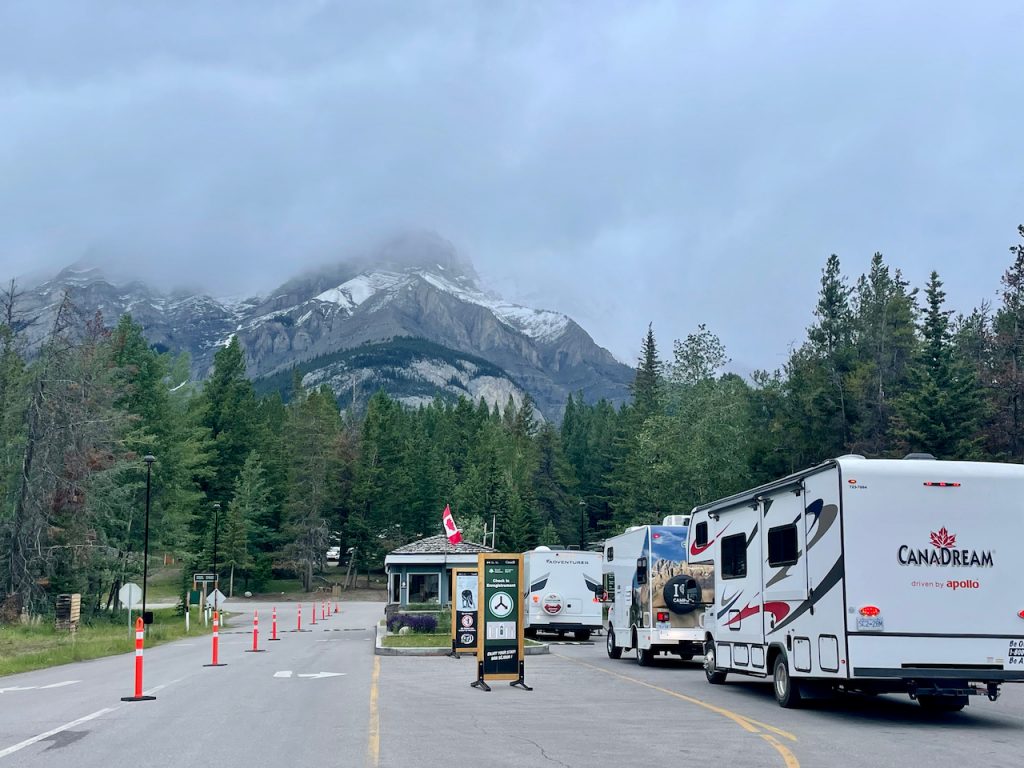
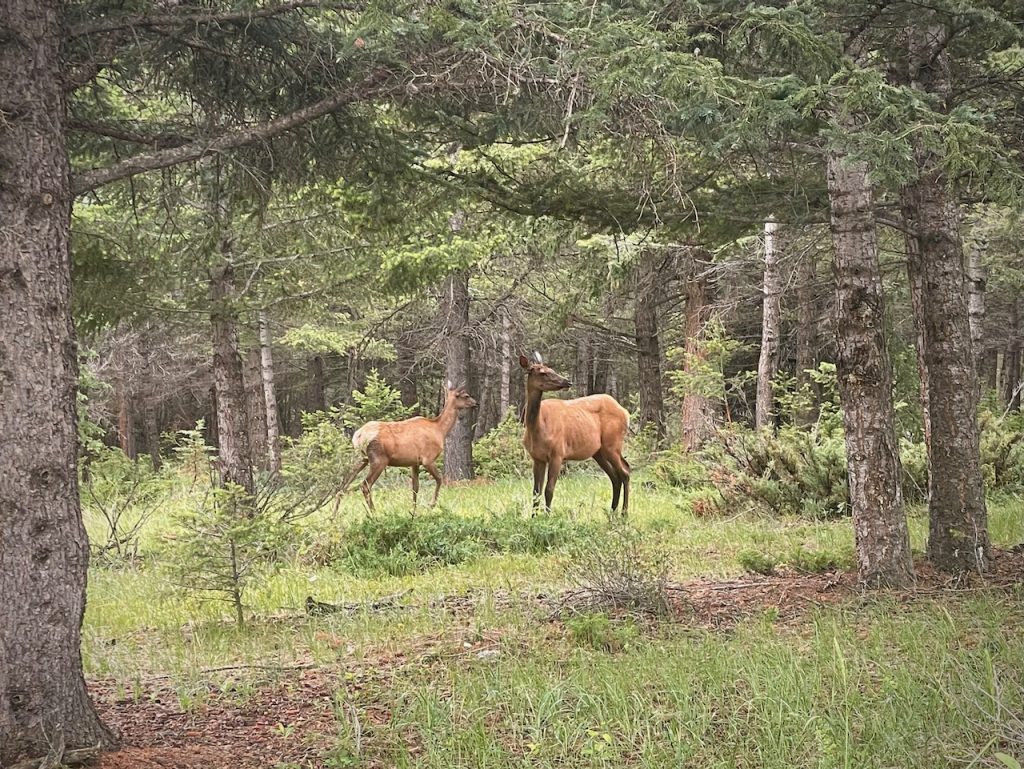
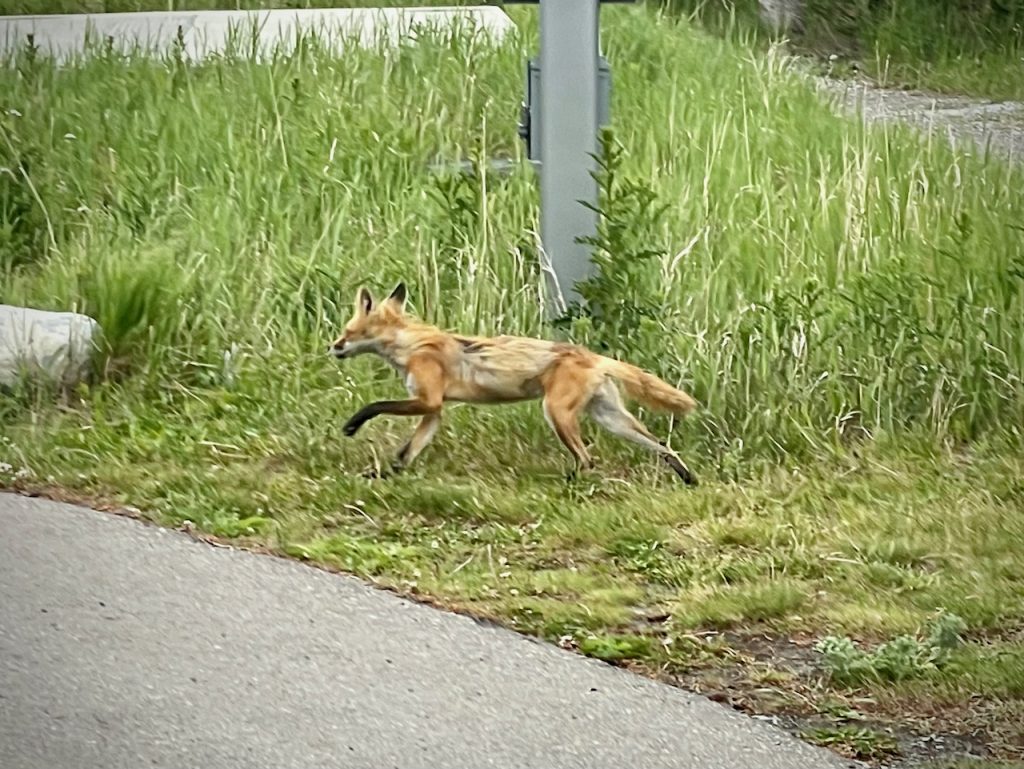
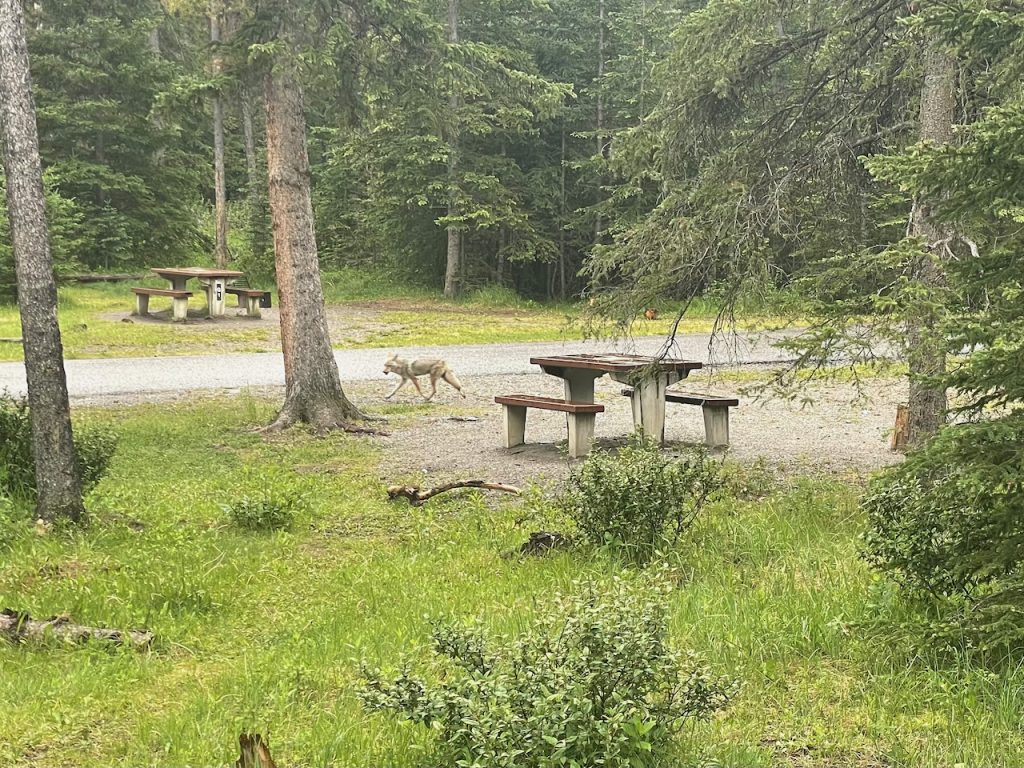
Nach 2 Nächten in Banff fahren wir etwa 60 km weiter nördlich nach Lake Louise – auch hier konnten wir uns für zwei Nächte eine Reservierung erkämpfen. Wir befinden uns noch immer im Banff Nationalpark. Der Campground, wie auch der in Banff, ist prima mit super guten heißen Duschen ausgestattet, die wir gerne nutzen.
After 2 nights in Banff we drive about 40 miles further north to Lake Louise – here too we were able to get a reservation for two nights. We are still in Banff National Park. The campground, like the one in Banff, is well equipped with super good hot showers, which we like to use.
Wir haben natürlich keinen Shuttle reserviert und somit wandern wir gerne und einsam vom Campground bis zum Lake Louise. Dort ist jedoch, an dem wirklich beeindruckend schön gelegenen See mit unglaublicher Farbe, von Einsamkeit keine Rede mehr. Es ist VOLL. Die Touristen stehen in 5er Reihen am Ufer, um DAS perfekte Bild hinzukriegen. Und dann ist da diese schreckliche RIESIGE Lodge. Karsten sagt, dass ihn die Architektur ein wenig an sozialistische Plattenbauten erinnert und da muss ich ihm zu 100 % Recht geben. Gerne kehren wir in kleinen und feinen Lodges auf ein leckeres Essen oder ein Eis ein aber diese Beleidigung für unsere Augen lädt uns gar nicht ein.
Of course we didn’t reserve a shuttle and so we hike on a lonely trail from the campground to Lake Louise. It is no longer lonely at this really impressively beautifully situated lake with an incredible colour. It is full. The tourists stand in rows of 5 on the bank to get THE perfect picture. And then there is this horrible HUGE lodge. Karsten says that the architecture reminds him a little of socialist prefabricated buildings and I have to agree with him 100%. We like to visit small and fine lodges for a delicious meal or an ice cream, but this insult to our eyes does not invite us at all.
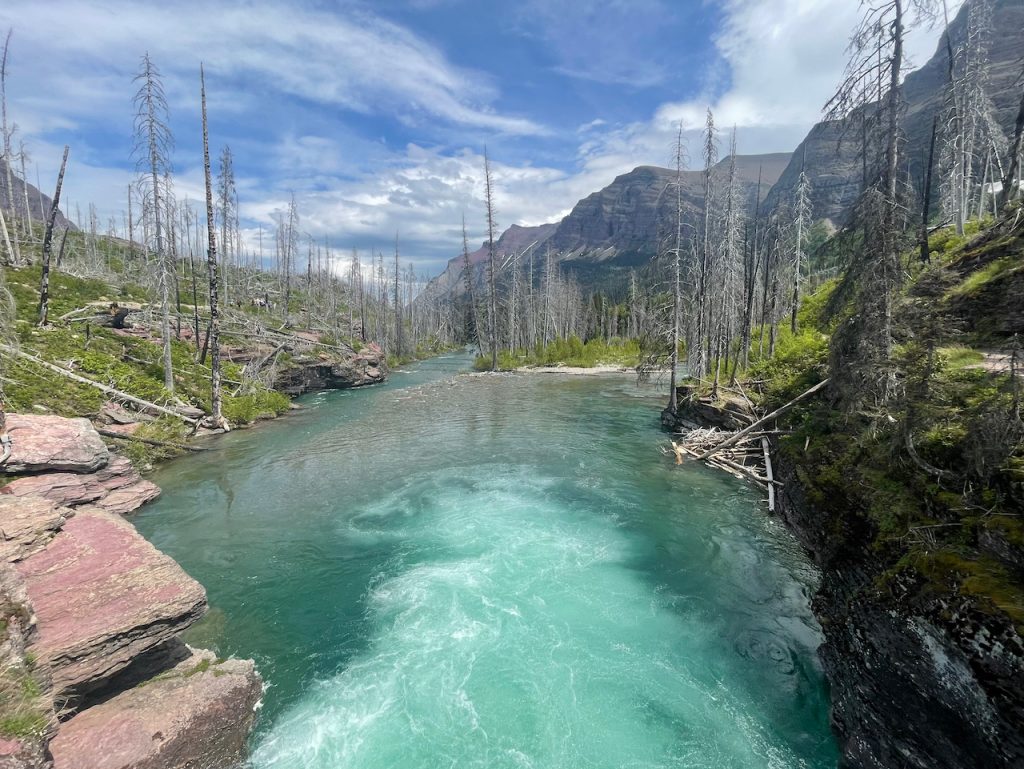
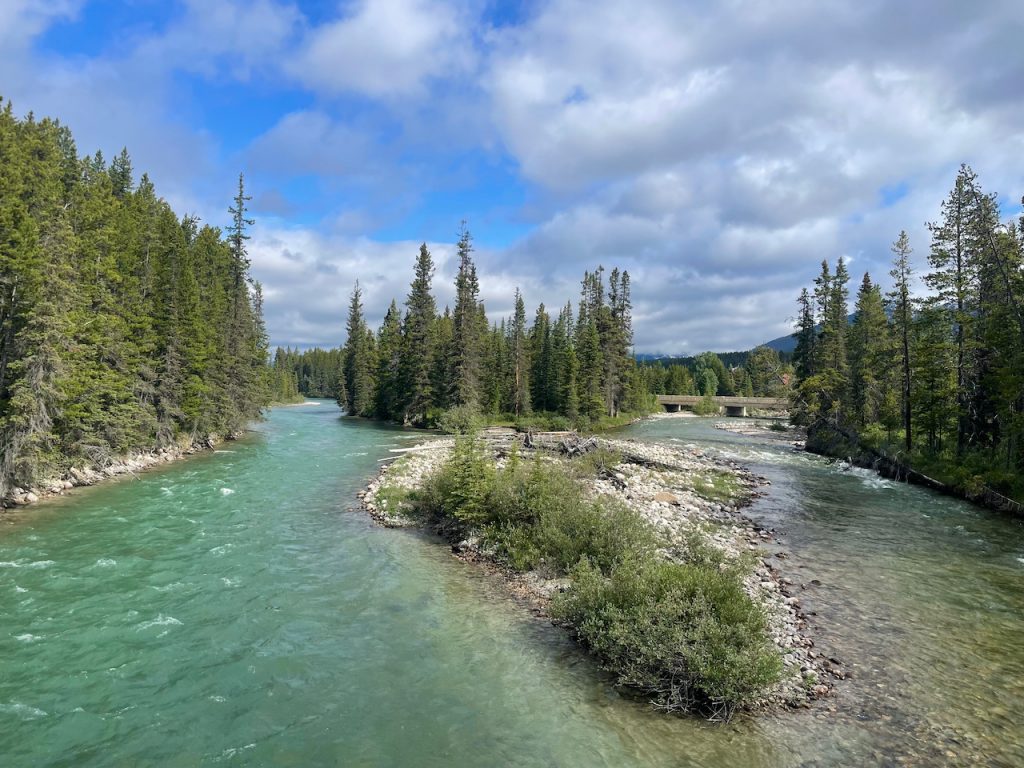
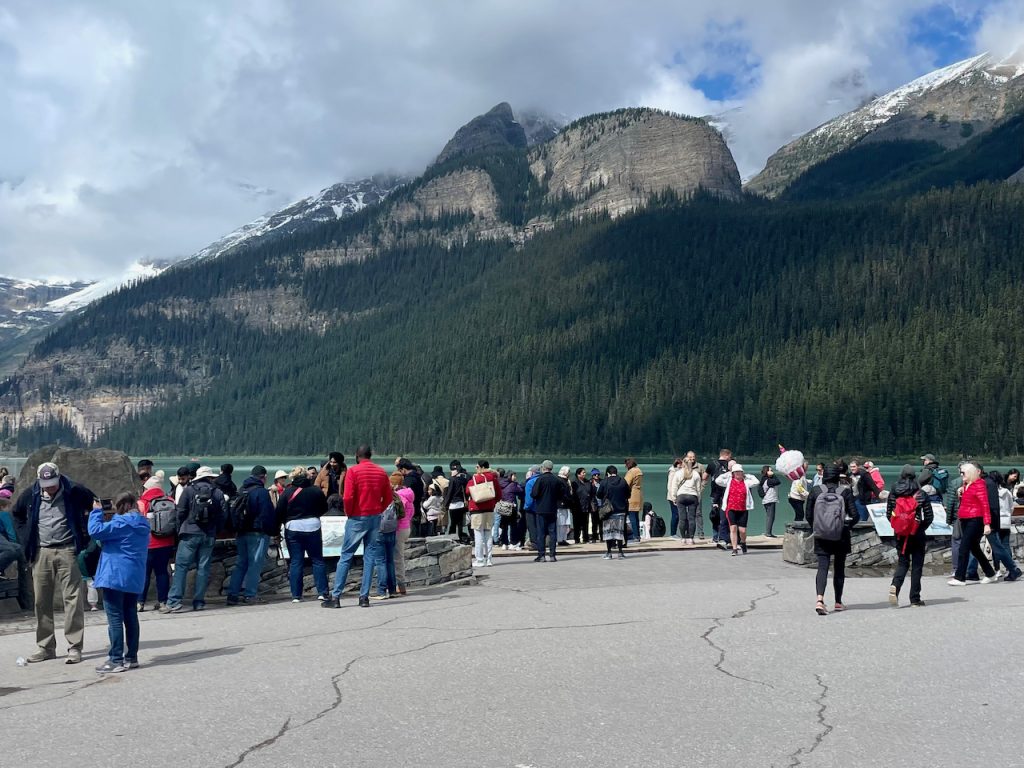
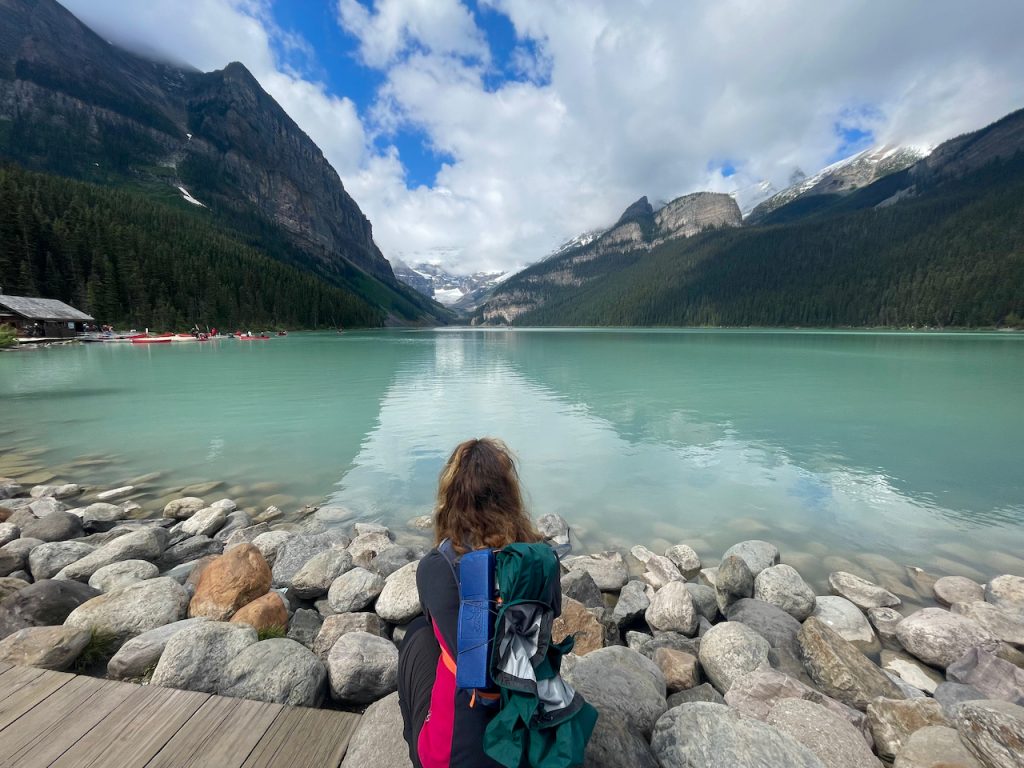
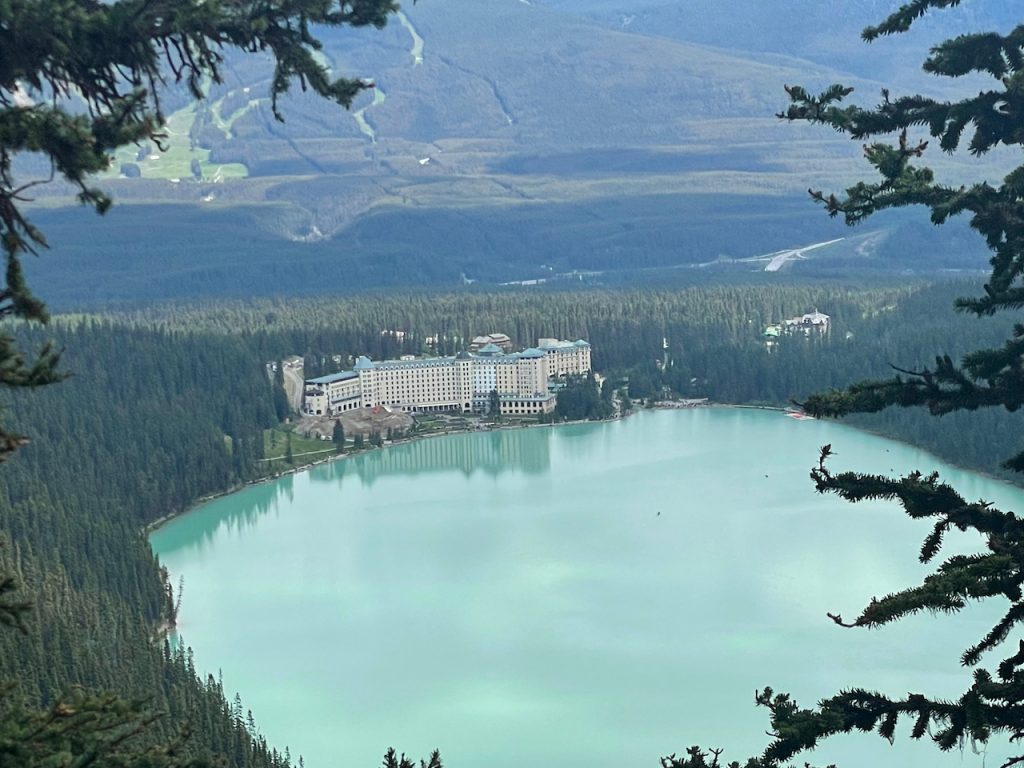
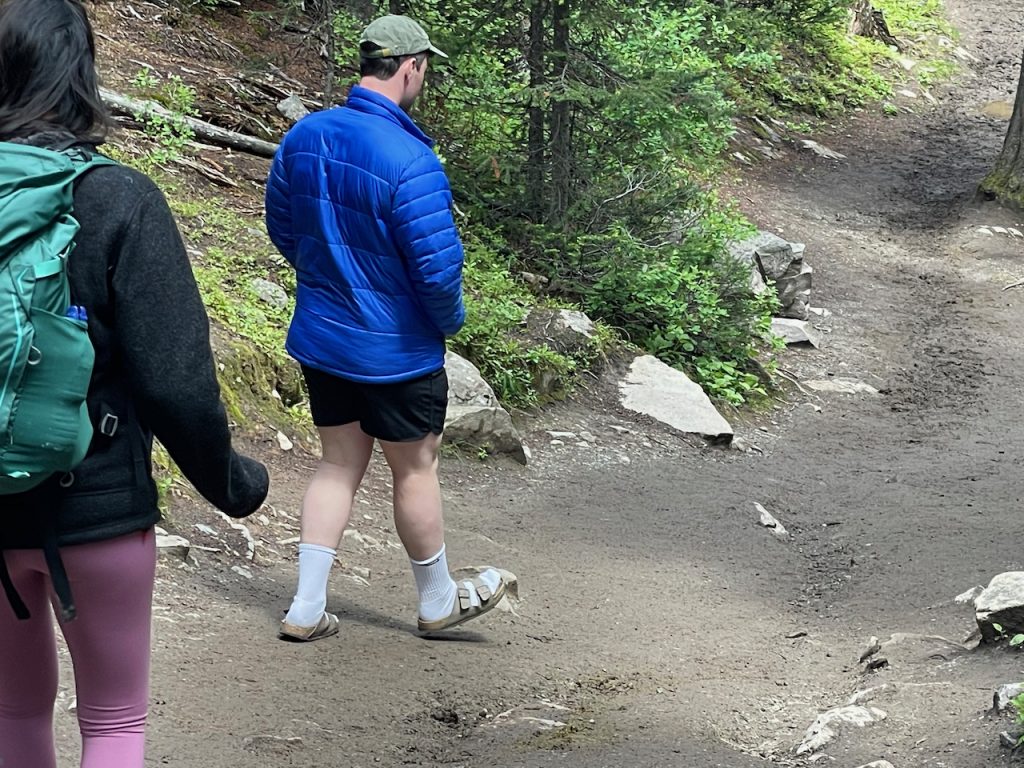
Wir marschieren vom Lake Louise etwa 500 Höhenmeter weiter zum Lake Agnes und dem dortigen Teehaus. Wir versuchen etwas von den frisch gebackenen Leckereien zu ergattern, aber die Wartezeit ist uns mit einer Stunde doch zu lange. So wandern wir weiter ein Stück entlang am Ufer und noch hoch bis zum The Big Beehive auf 2.270 m. Je höher wir kommen, desto weniger Menschen sehen wir. Am Ende hat uns diese Wanderung mit ihren schönen Aussichten sehr gut gefallen.
From Lake Louise we hike about 1,650 feet higher to Lake Agnes and the Teahouse there. We try to get hold of some of the freshly baked delicacies, but the waiting time of an hour is too long for us. So we hike a little further along the shore and up to The Big Beehive which is 7,450 feet high. The higher we get, the fewer people we see. In the end we really enjoyed this hike with its beautiful views.
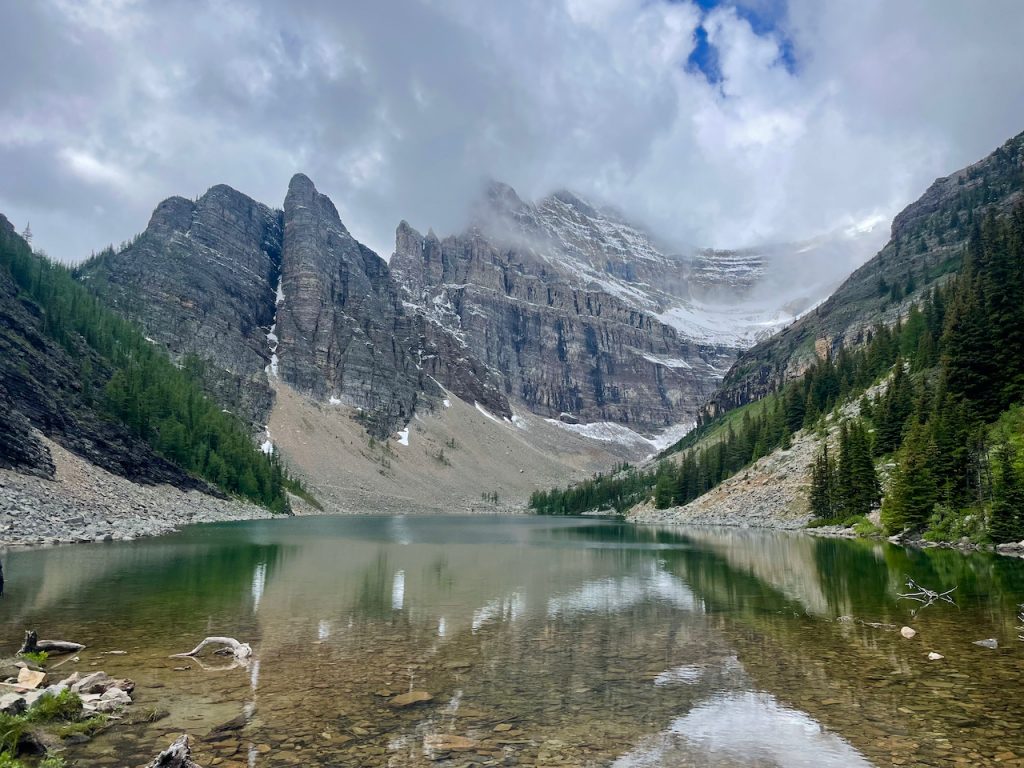
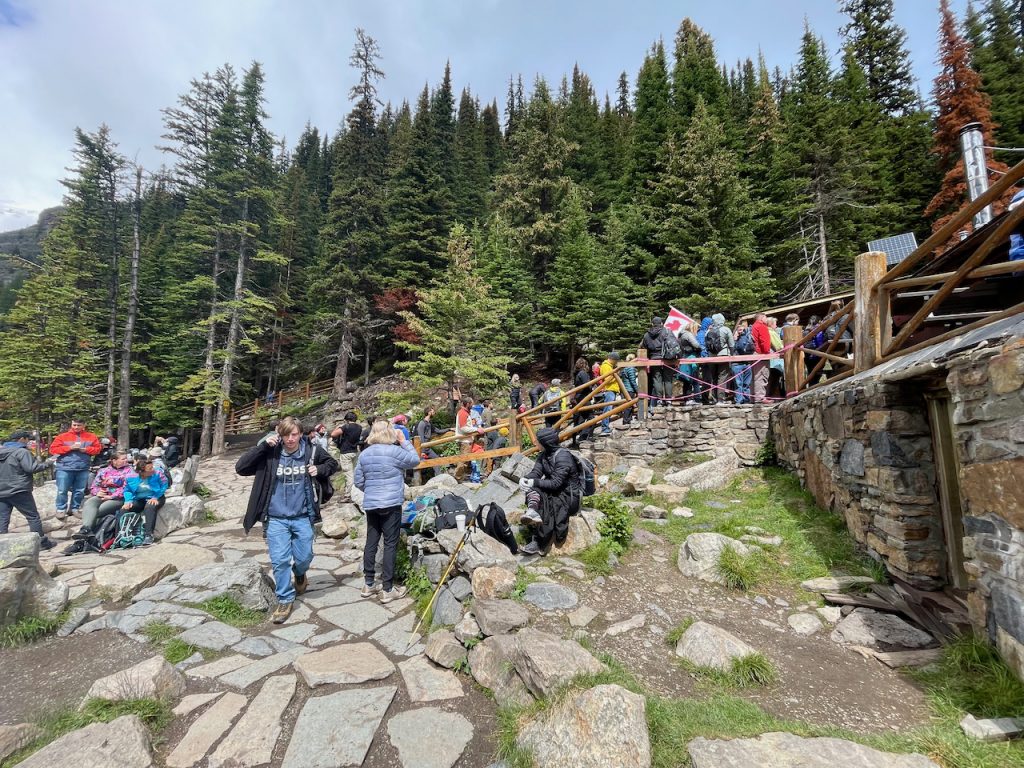
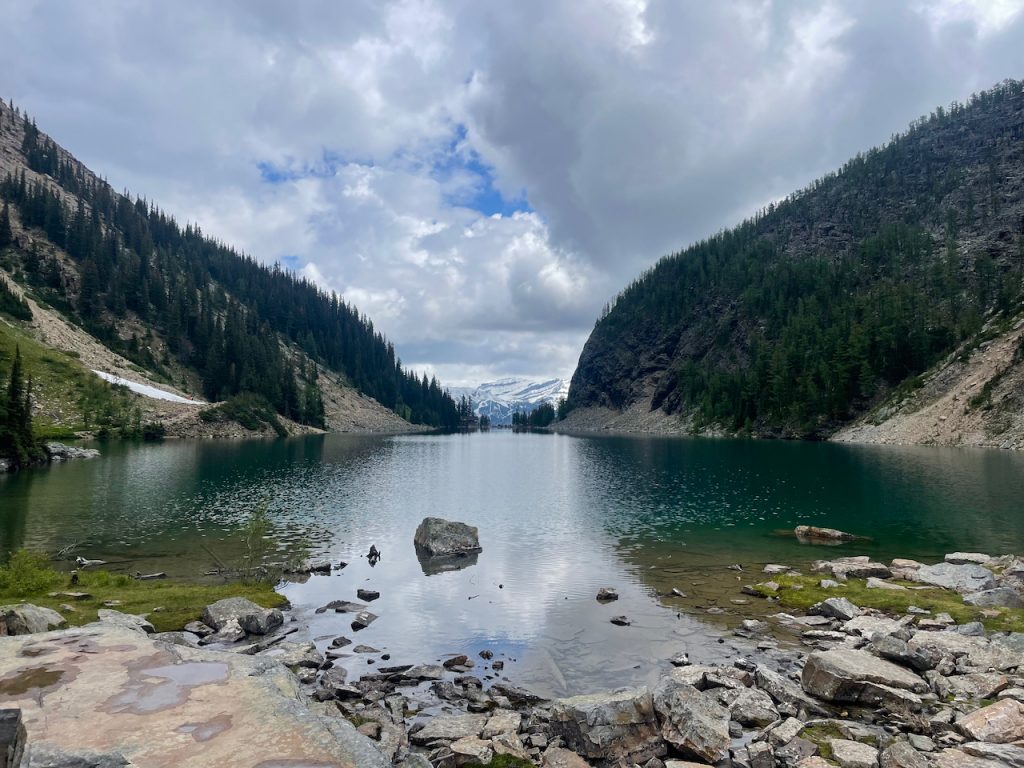
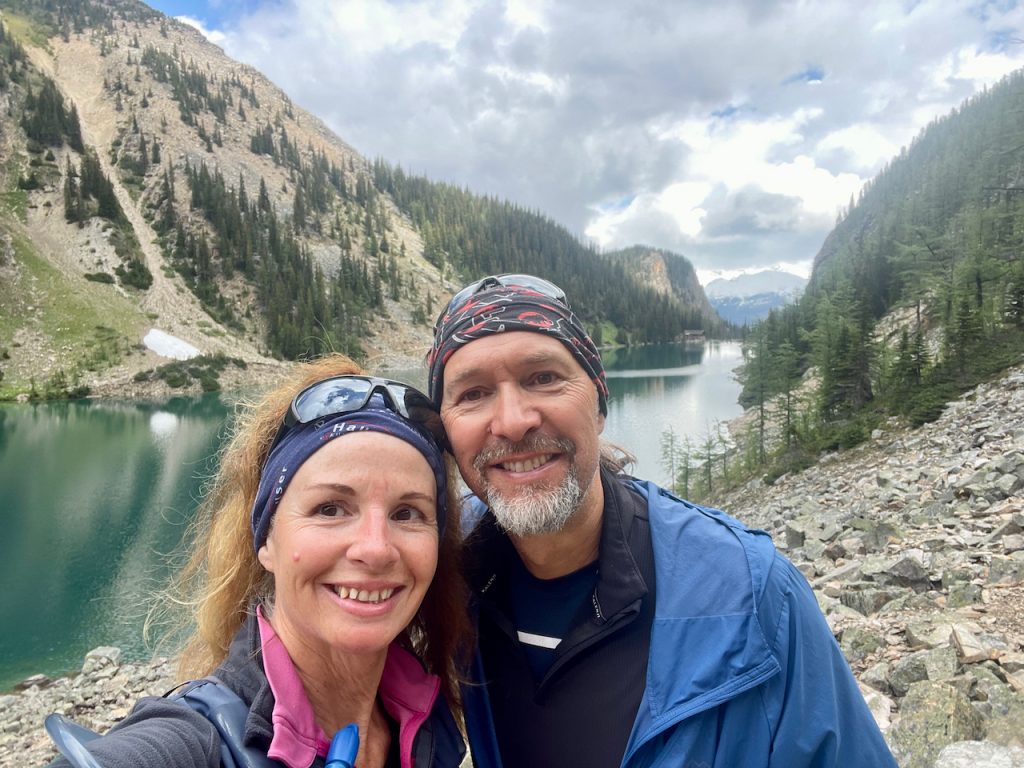
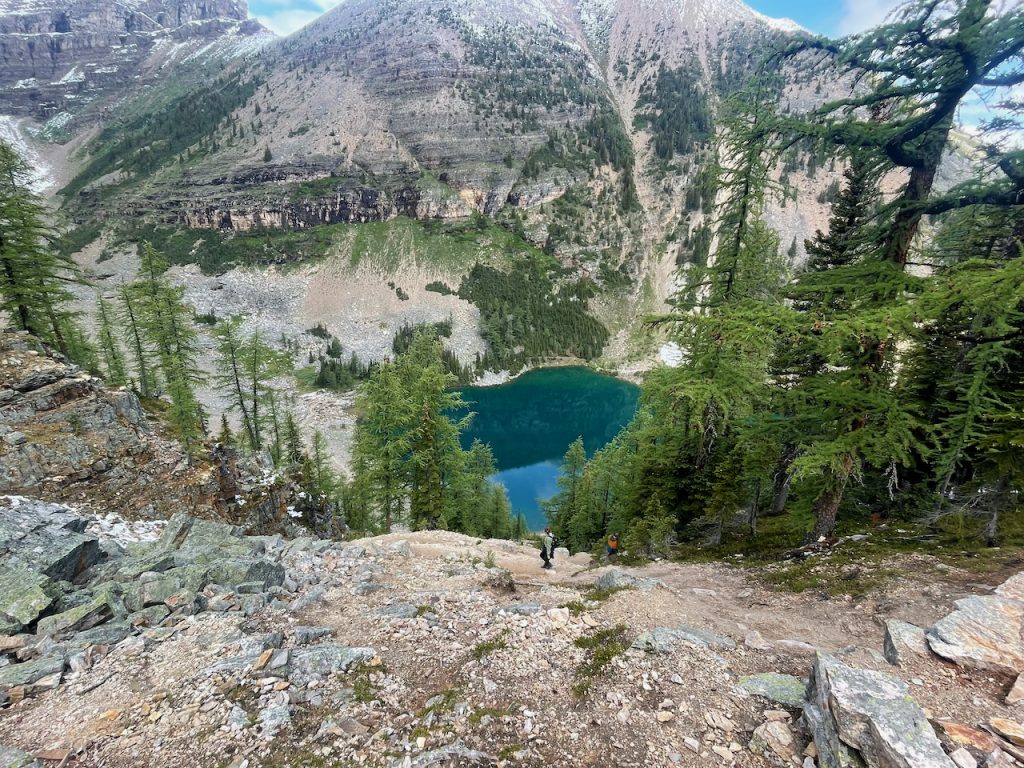
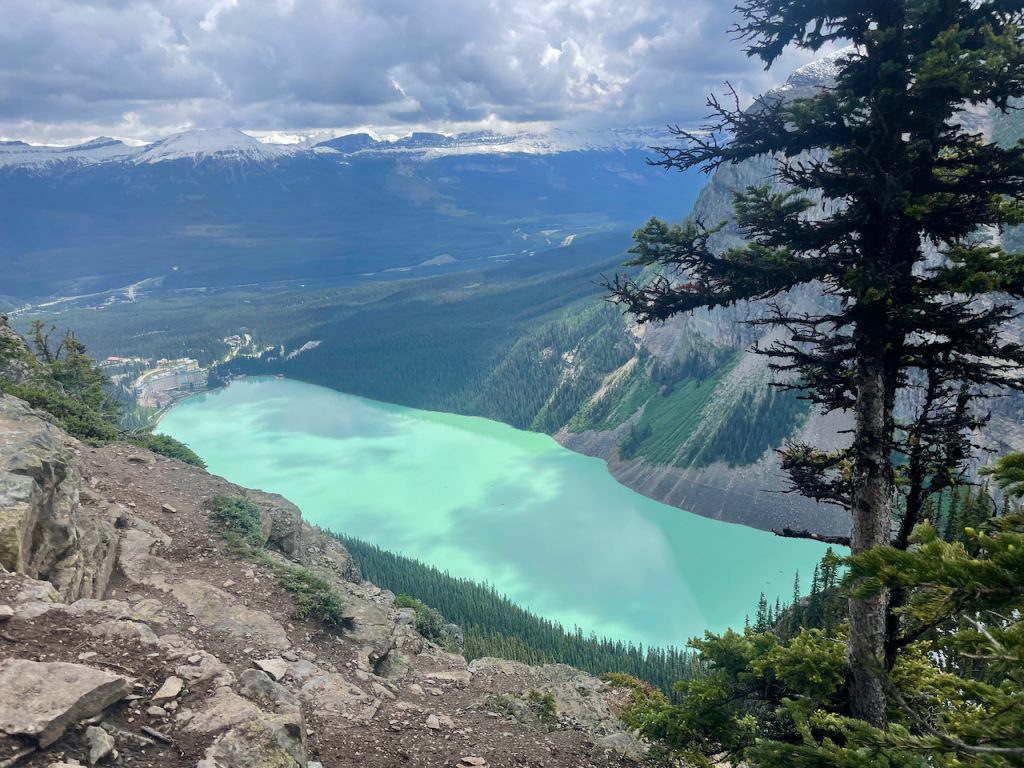
Die ganze Gegend gefällt uns so gut und wir beschließen, sie noch ein wenig intensiver zu erkunden. Doch haben wir keine Reservierungen mehr für die Campingplätze. Nach ein wenig Recherche finden wir heraus, dass im Nahe gelegenen Yoho Nationalpark ein first come first served Campground ist. Also fahren wir frühmorgens die 25 km über den Kicking Horse Pass und finden direkt einen prima Platz im Monarch Campground. Das einzige Manko, es ist laut, da wir direkt neben der Highway 1 sind, die nach Golden führt. Noch lauter sind jedoch die Züge, die sich hier durch einen Spiral-Tunnel im Schneckentempo den Berg hoch bzw. runter schrauben. Gefühlt braucht ein Zug, mit 4 Loks und 155 Waggons mit doppelt geladenen Containern, eine viertel Stunde um vorbei zu fahren. Aber nichtsdestotrotz der Platz ist ein guter Ausgangspunkt.
We like the whole area so much and we decide to explore it a little more intensively. However, we no longer have reservations for the campsites. After a little research we find out that nearby Yoho National Park offers a first come first served campground. So early in the morning we drive the 16 miles over the Kicking Horse Pass and immediately find a great place in the Monarch Campground. Only downside, it’s noisy as we are right off Highway 1 that goes to Golden. Even louder are the trains that wind their way up and down the mountain through a spiral tunnel at a snail’s pace. A train with 4 locomotives and 155 wagons with double-loaded containers needs a quarter of an hour to drive by. But nonetheless the spot is a good starting point.
Wir packen erst mal die Räder aus und fahren 15 km meist bergan zu den Takakkaw Wasserfällen. Der Name kommt von den Cree und bedeutet soviel wie „Es ist herrlich“. Er ist mit seinen 254 m einer der höchsten in Kanada und wird vom Daily Glacier gespeist, der wiederum vom Waputik Icefield gespeist wird. Ein wahrlich herrlicher Anblick.
We unpack the bikes and drive 15 km mostly uphill to the Takakkaw waterfalls. The name comes from the Cree and means something like „It is magnificent“. It is one of the tallest in Canada with 833 feet and is fed by the Daily Glacier, which in turn is fed by the Waputik Icefield. A truly magnificent sight.
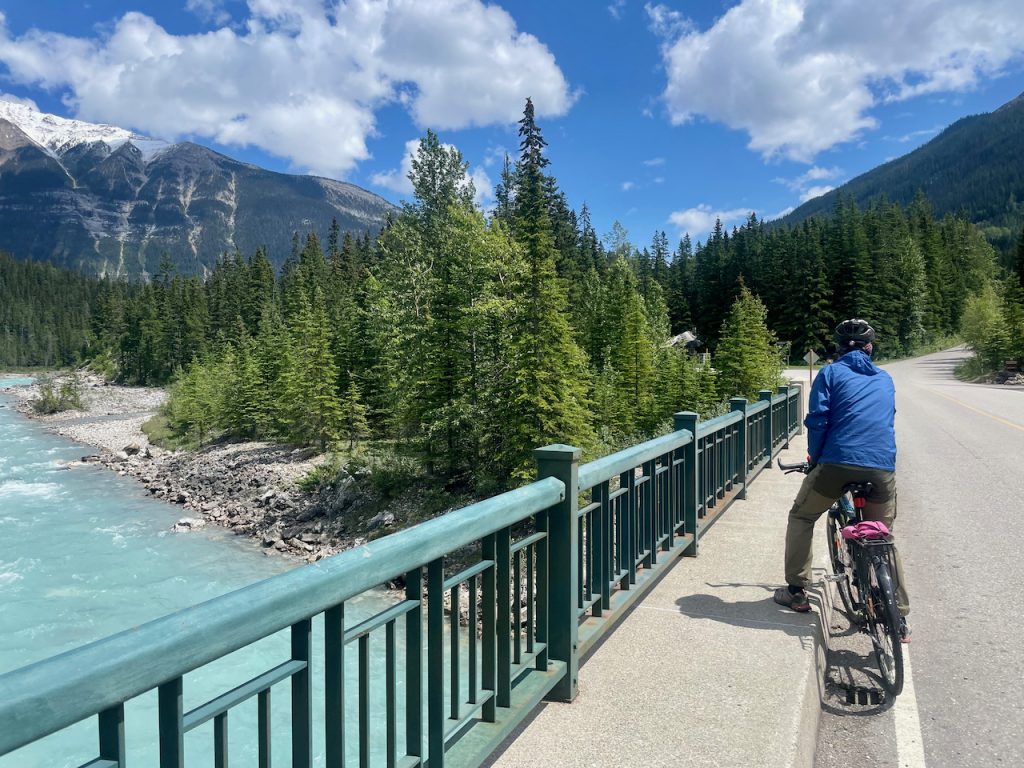
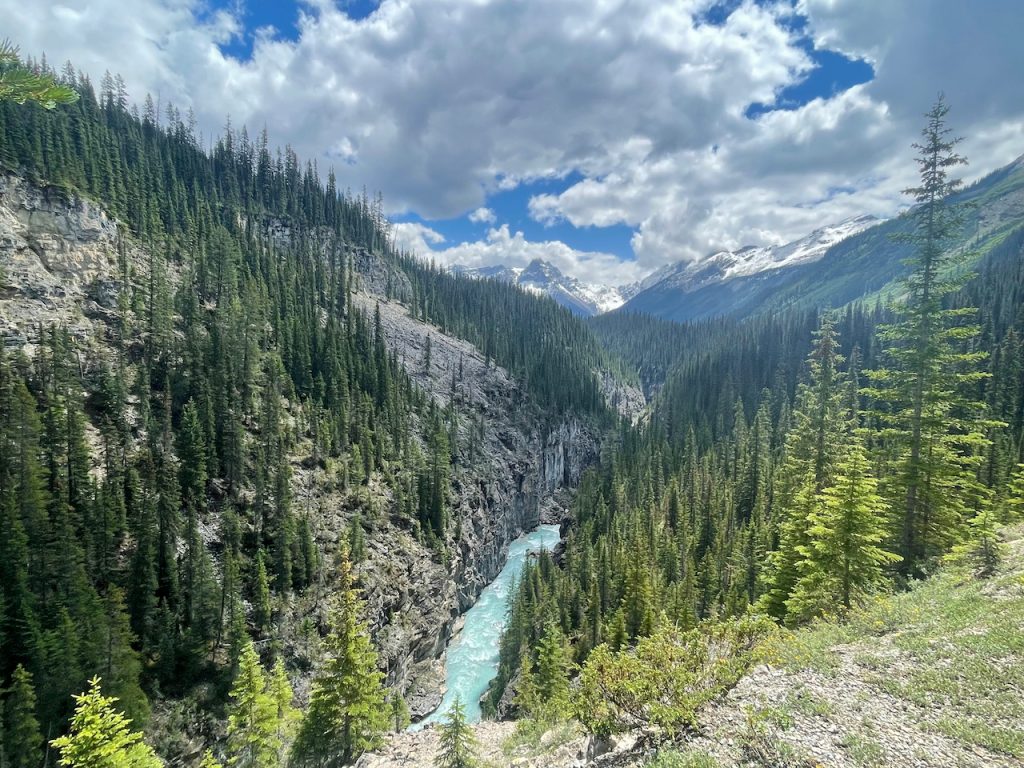
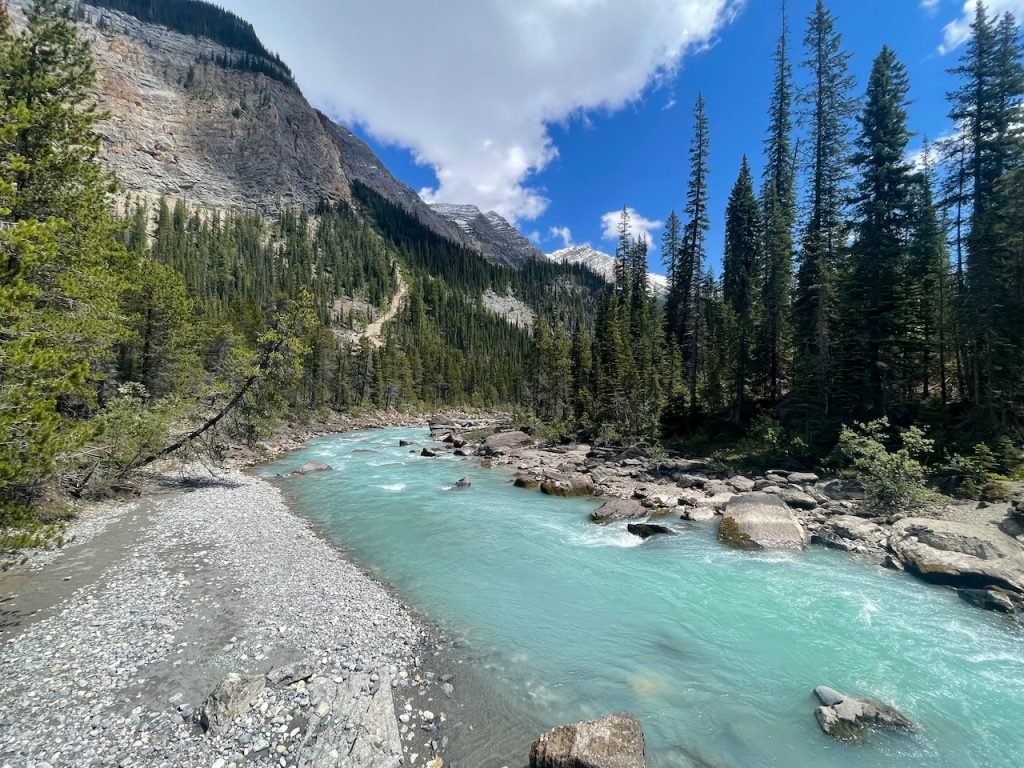
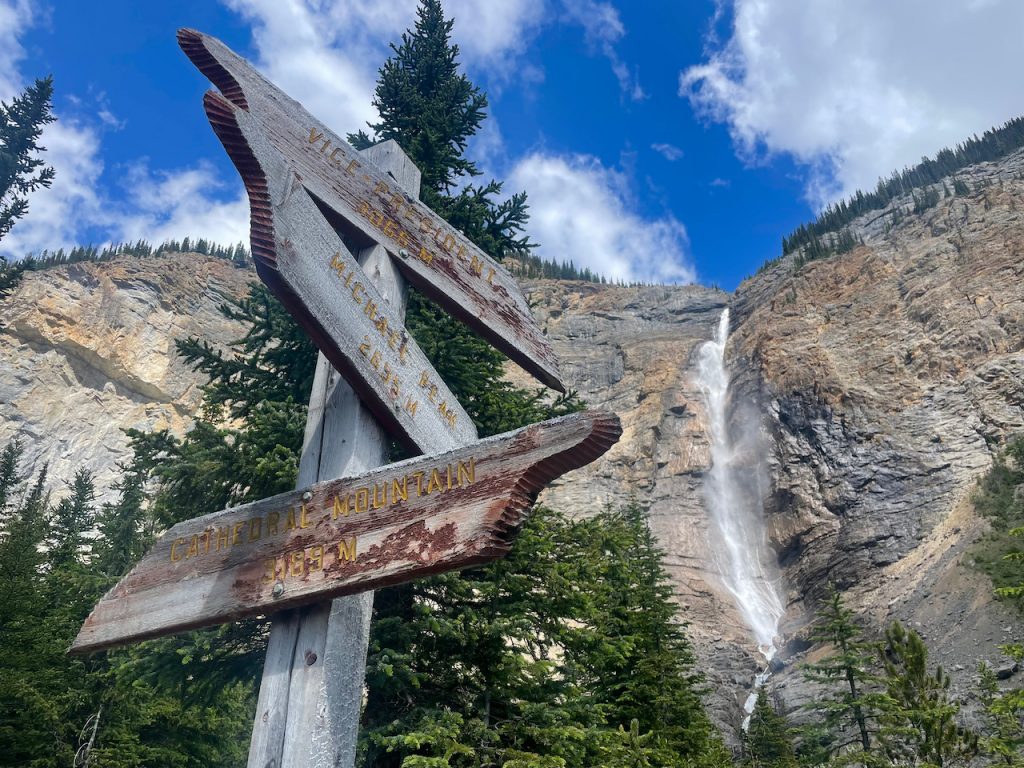
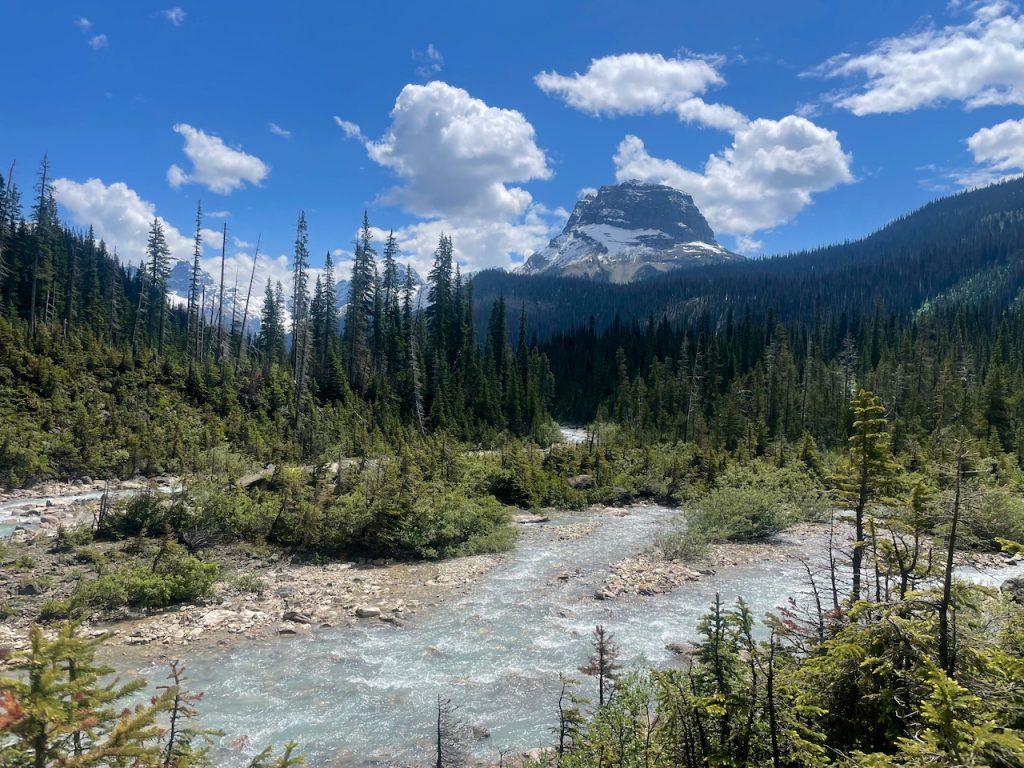
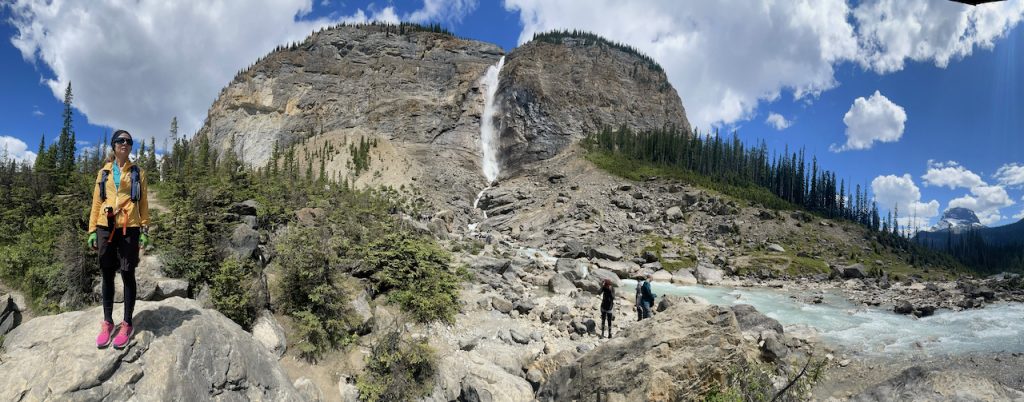
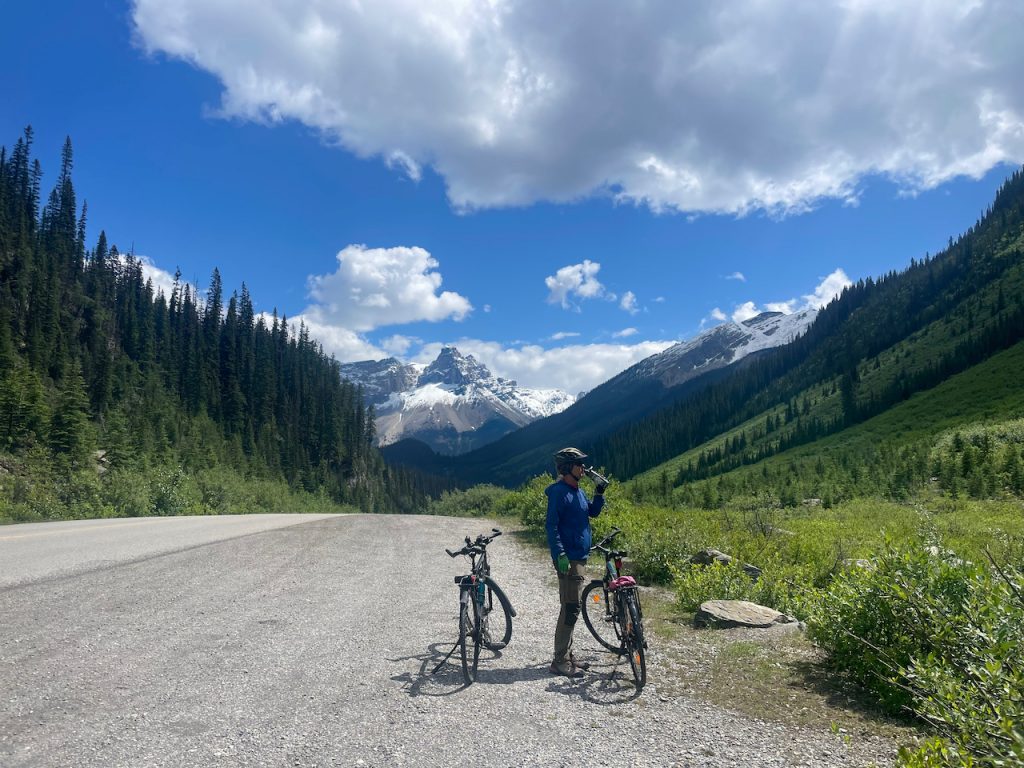
Heute, der 22. Juni 2023, ist ein ganz ganz besonderer Tag. Ewald wird am heutigen Tag 40 Jahre alt. Ewald ist seit 14 Jahren unser treuer Begleiter und wir verdanken ihm einmalige Erlebnisse, denn er bringt uns fast überall ohne murren hin. Wir stoßen auf ihn an und freuen uns auf die kommenden vielen Jahre mit unserem Ewald.
Today, June 22, 2023, is a very, very special day. Ewald turns 40 today. Ewald has been our faithful companion for 14 years and we owe him unique experiences, because he takes us almost everywhere without a murmur. We toast to him and look forward to the many years to come with our Ewald.
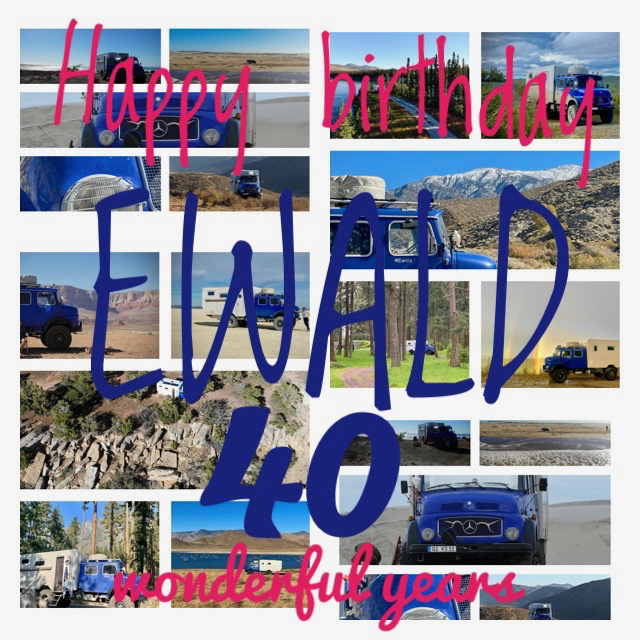
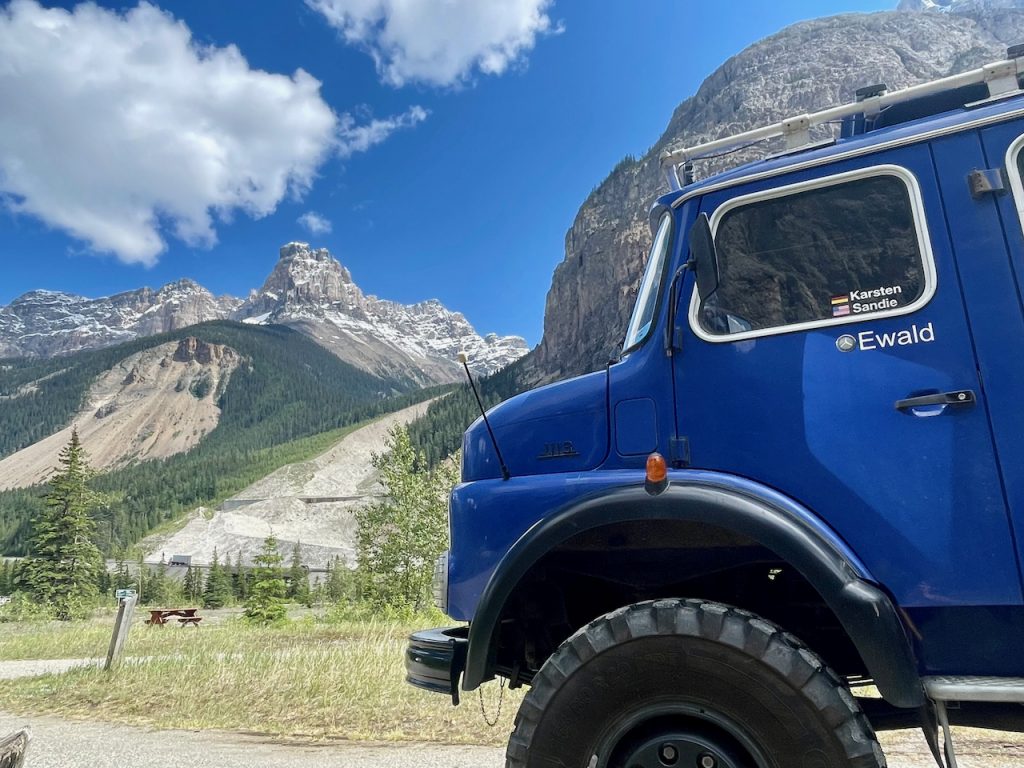
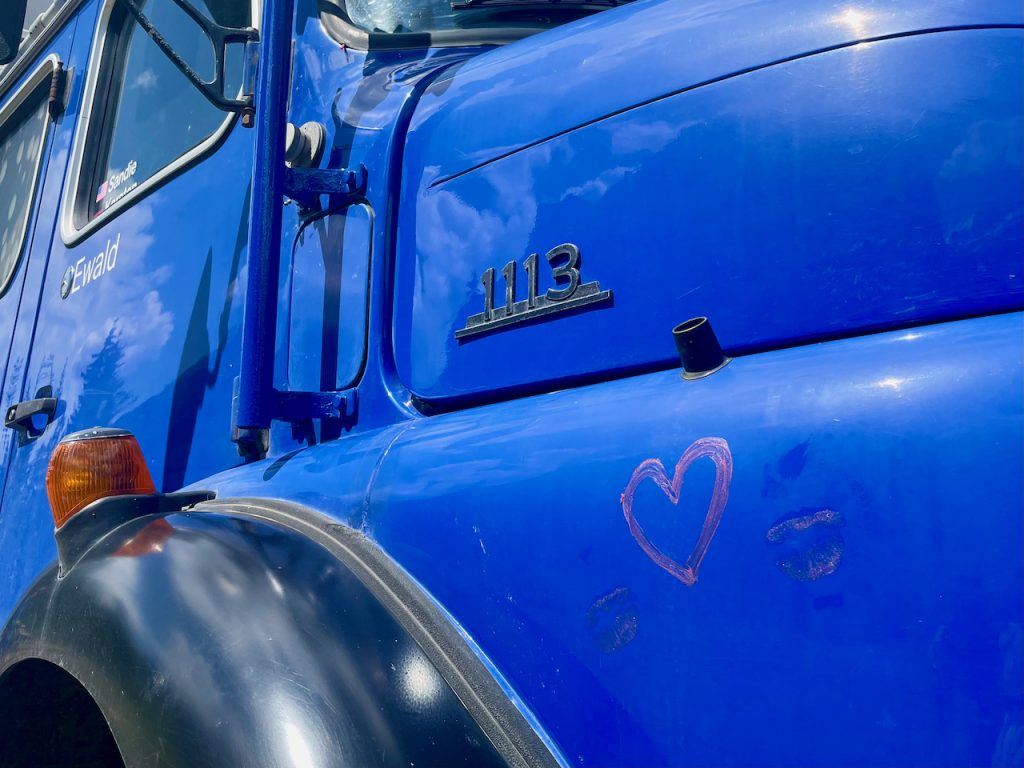
Vom Monarch Campground fahren wir noch mal zum Lake Luise Village, packen die Räder aus und radeln 15km hoch zum Moraine Lake. Die Fahrradtour ist herrlich, da auf der Straße keine Privatfahrzeuge erlaubt sind. Am Moraine Lake angekommen sind wir sehr positiv überrascht, da es lange nicht so überlaufen ist, wie am Lake Louise. Der See hat eine fast unglaubliche Farbe, die Kanus sehen aus, als wenn sie im Nichts schweben würden. Irre! Wir marschieren noch bergan durch das Larch Valley bis fast hoch zum Sentinel Pass. Die Landschaft öffnet sich nach 4 km und die Aussichten unter anderem auf zehn 3000er Gipfel und diverse Seen ist einfach der Hammer. Leider können wir nicht ganz hoch, da wir weder unsere Stöcke noch unsere Spikes dabei haben und sich kurz vorm Pass 2 große Schneefelder befinden. Wir denken, wir werden das aber noch mal in Angriff nehmen. Ein großartiger Tag und ganz besonders gut schmecken die Muffins am Ende der Wanderung und auf der Rückfahrt lassen wir es mit unseren Rädern ordentlich fliegen. COOOOOOL!
From Monarch campground we drive again to Lake Luise Village, unpack the bikes and cycle 9 miles up to Moraine Lake. The bike ride is lovely as no private vehicles are allowed on this road. Arriving at Moraine Lake we are very positively surprised, as it is not nearly as crowded as Lake Louise. The lake has an almost unbelievable color, the canoes look like they are floating in space. Crazy! We march uphill through the Larch Valley almost up to the Sentinel Pass. The landscape opens up after 2.5 miles and the views of ten 10,000 feet high peaks and various lakes are simply amazing. Unfortunately we can’t go all the way up because we are not equipped well with poles and crampons and there are 2 large snowfields just before the pass. We think we’ll give it a try next time. A great day and the muffins at the lodge taste particularly good after o long hike. On the way back we let our bikes fly downhill. COOOOOOOL!
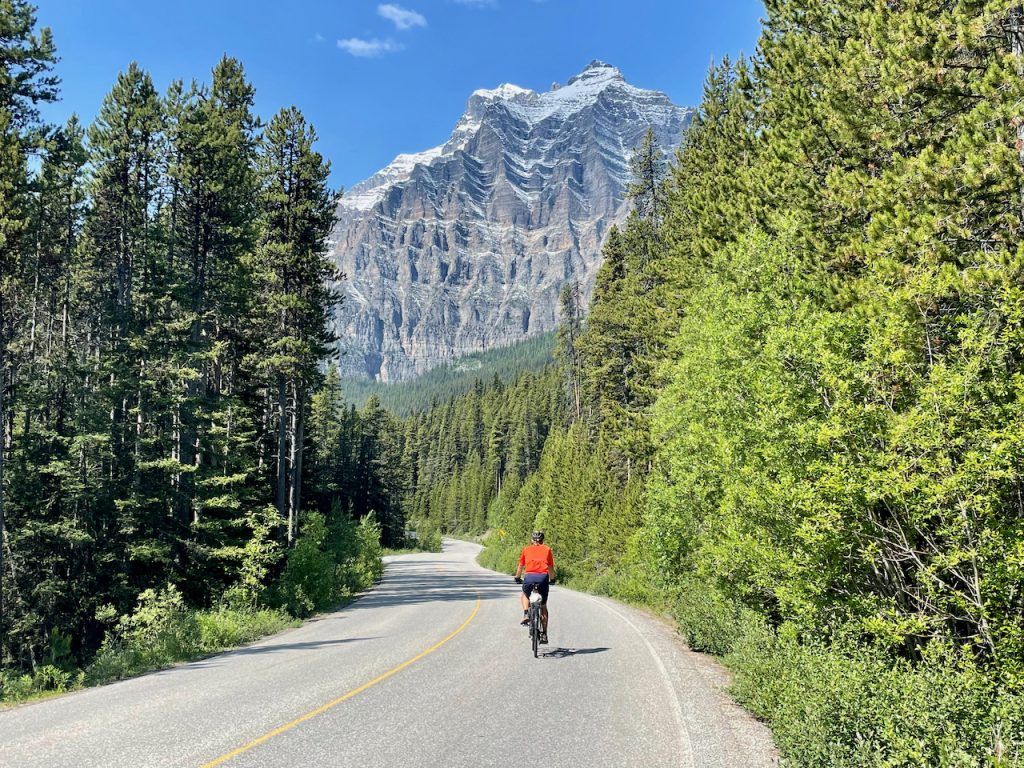
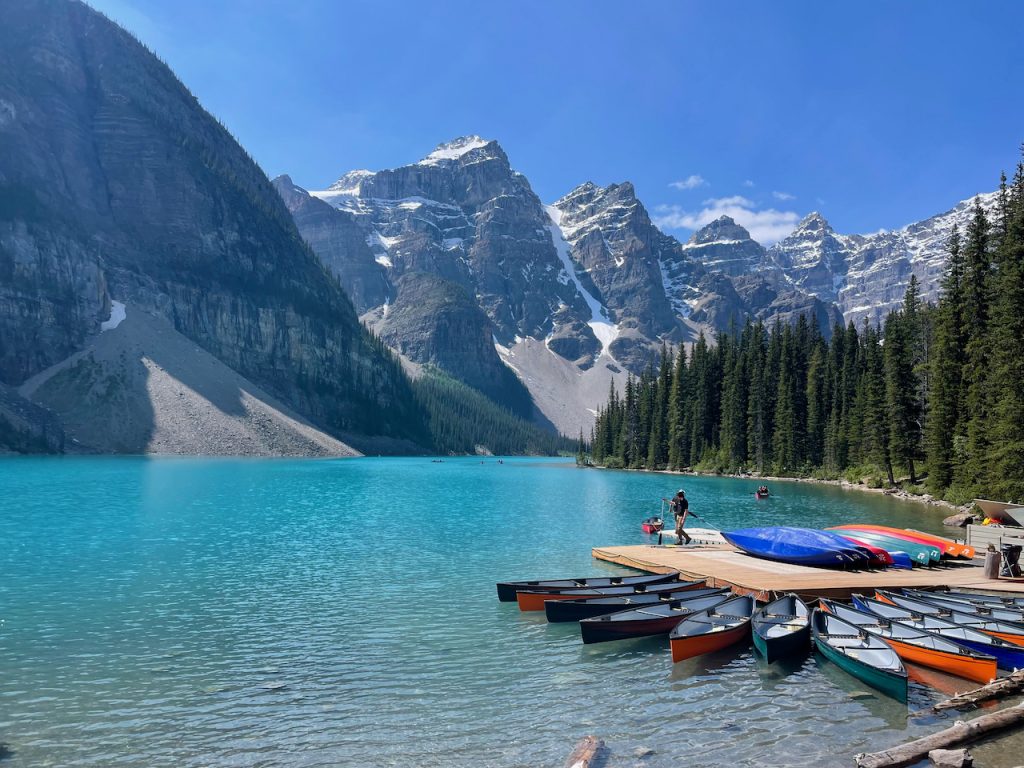
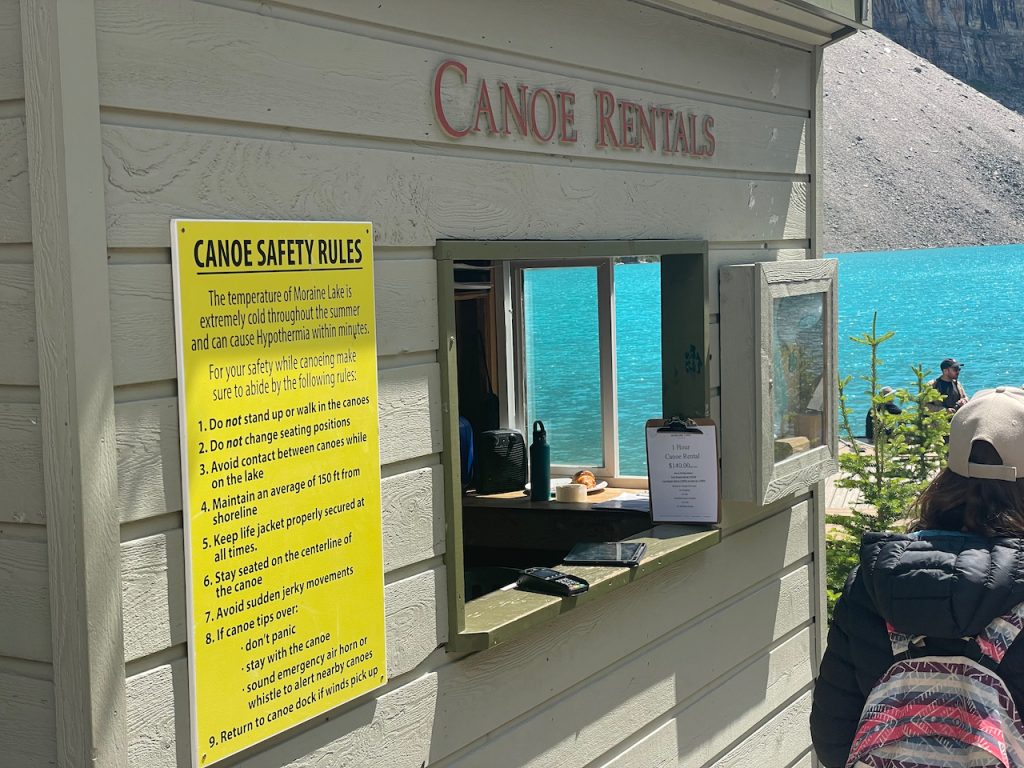
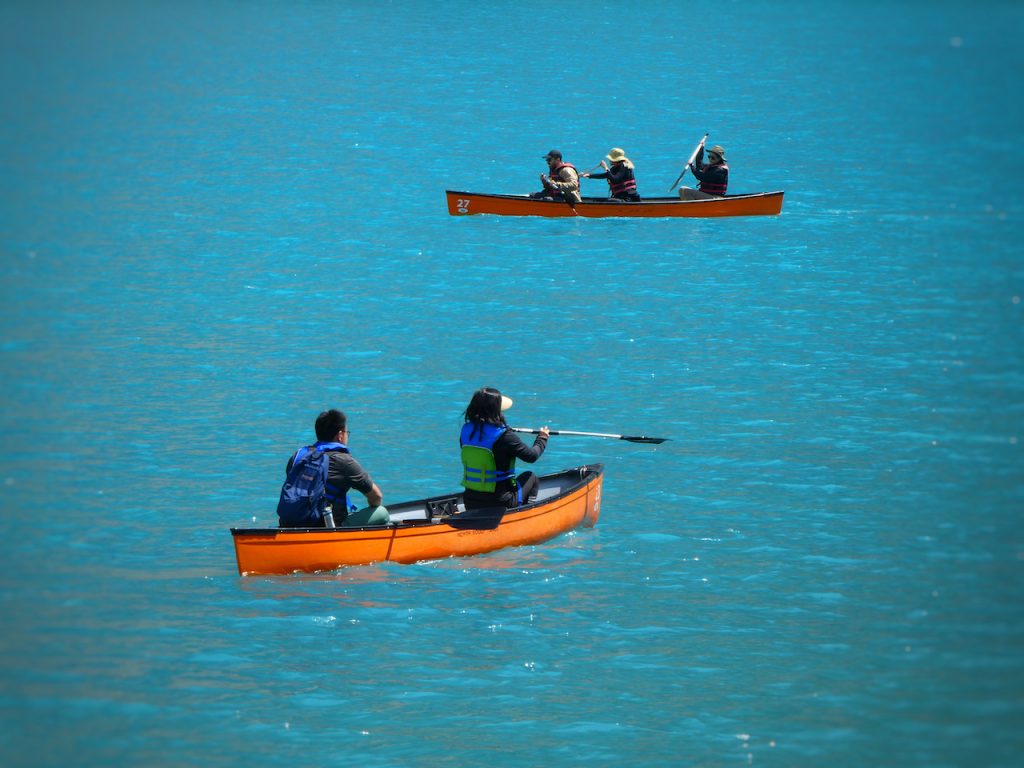
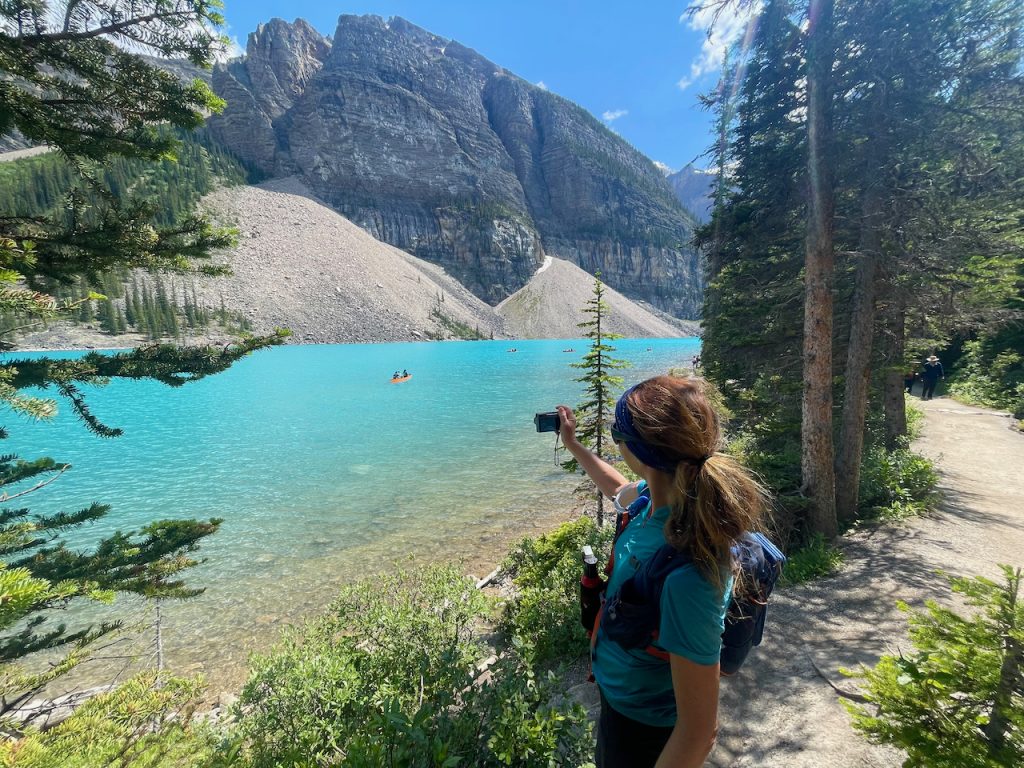
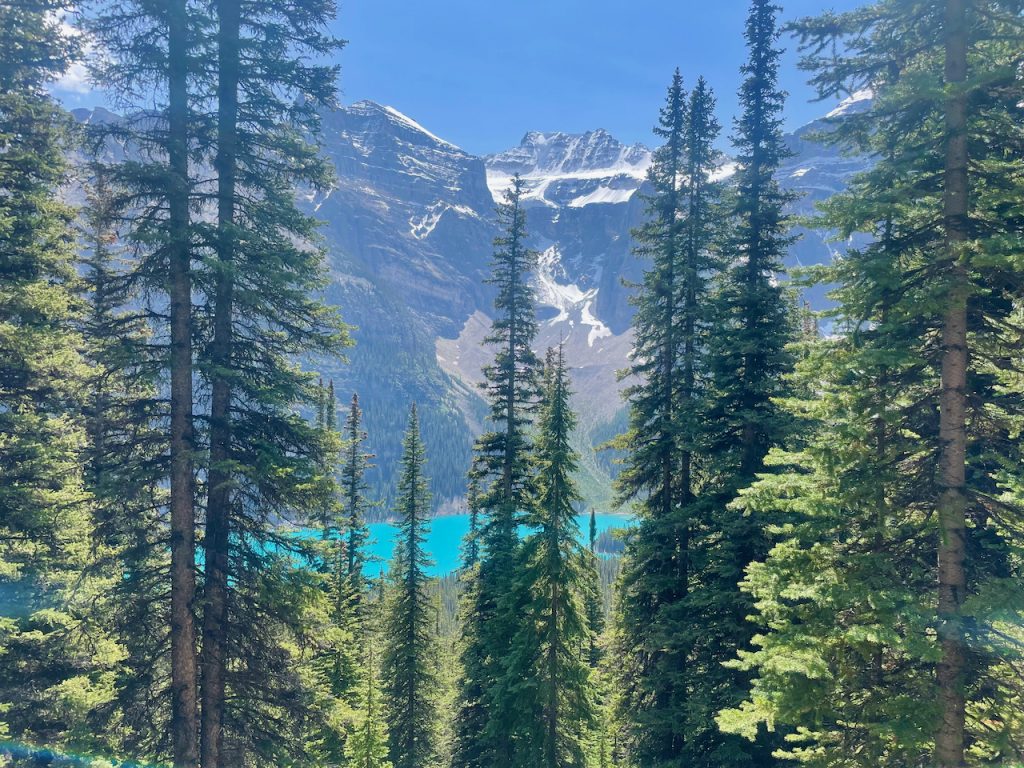

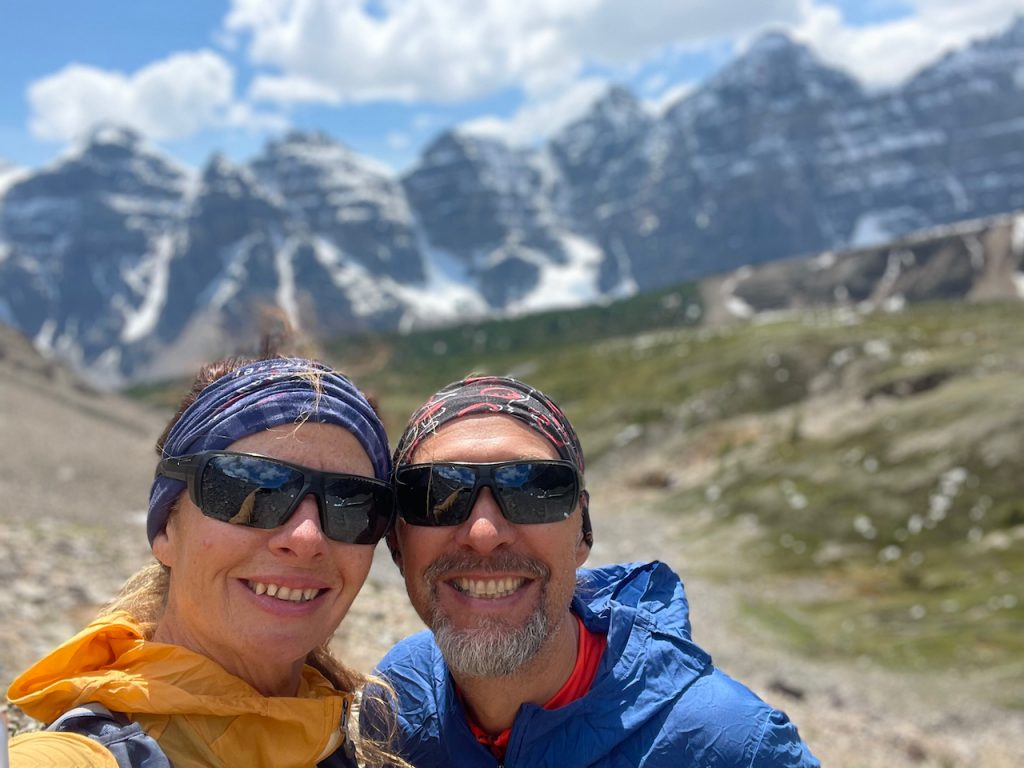
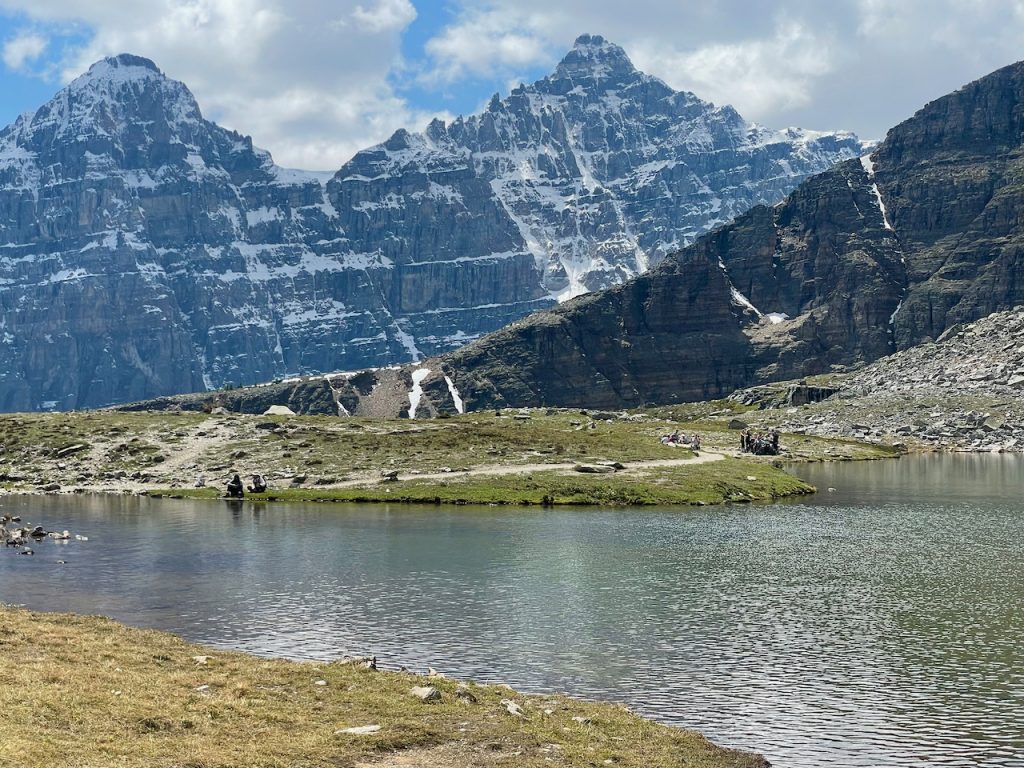
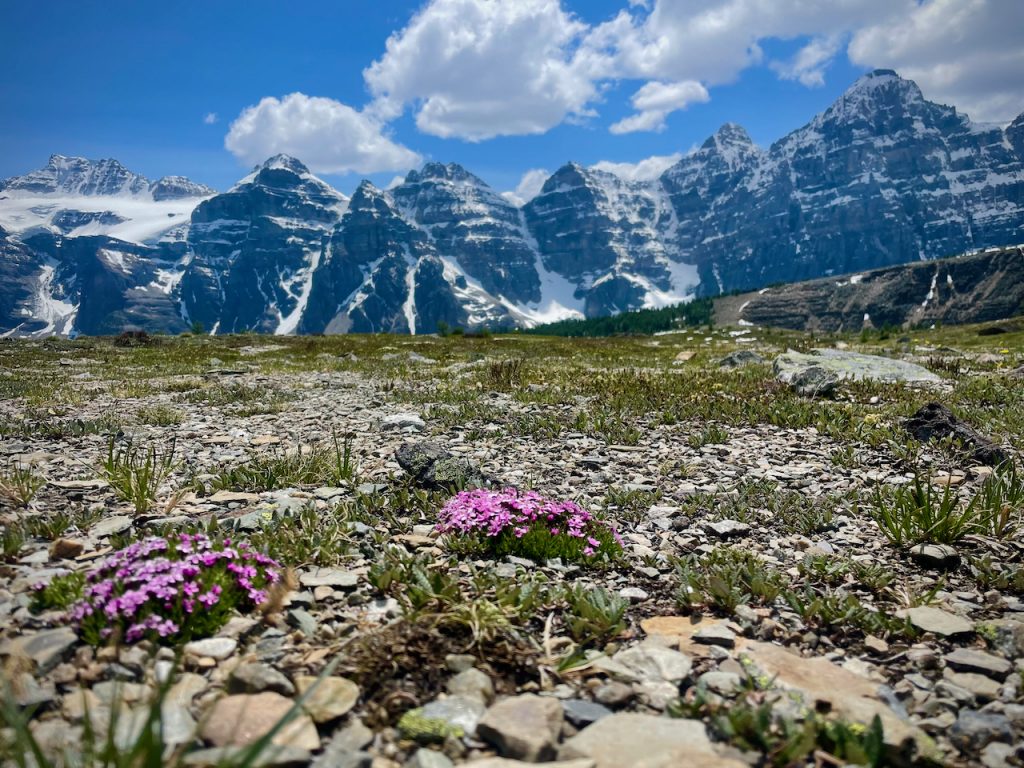
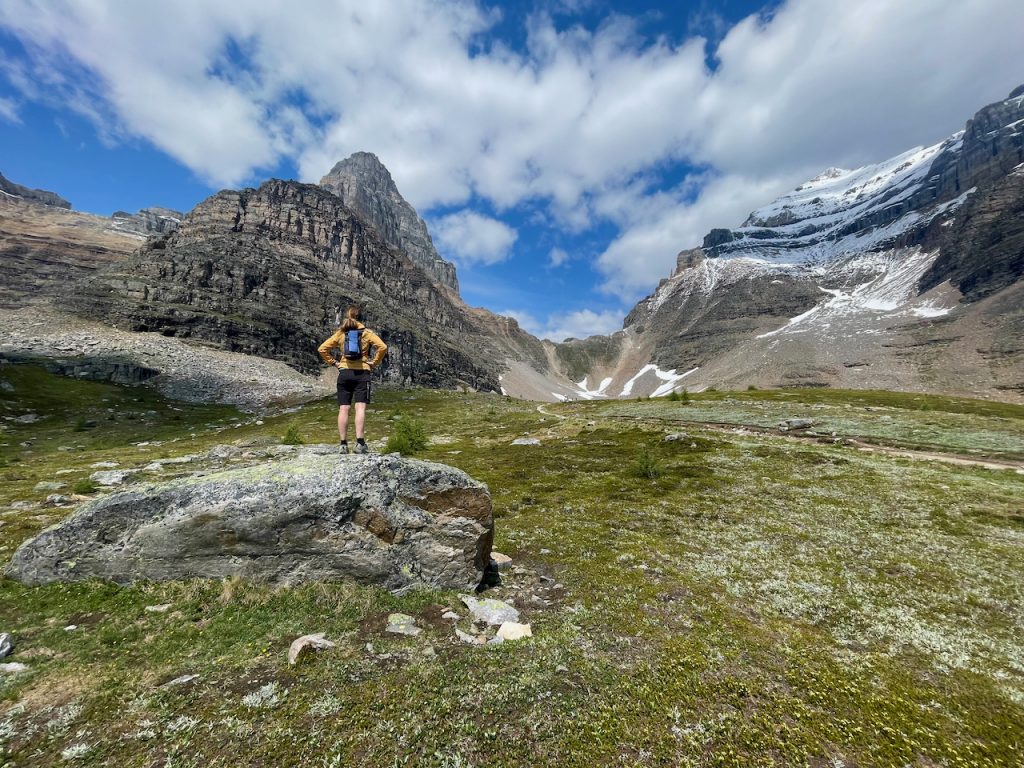
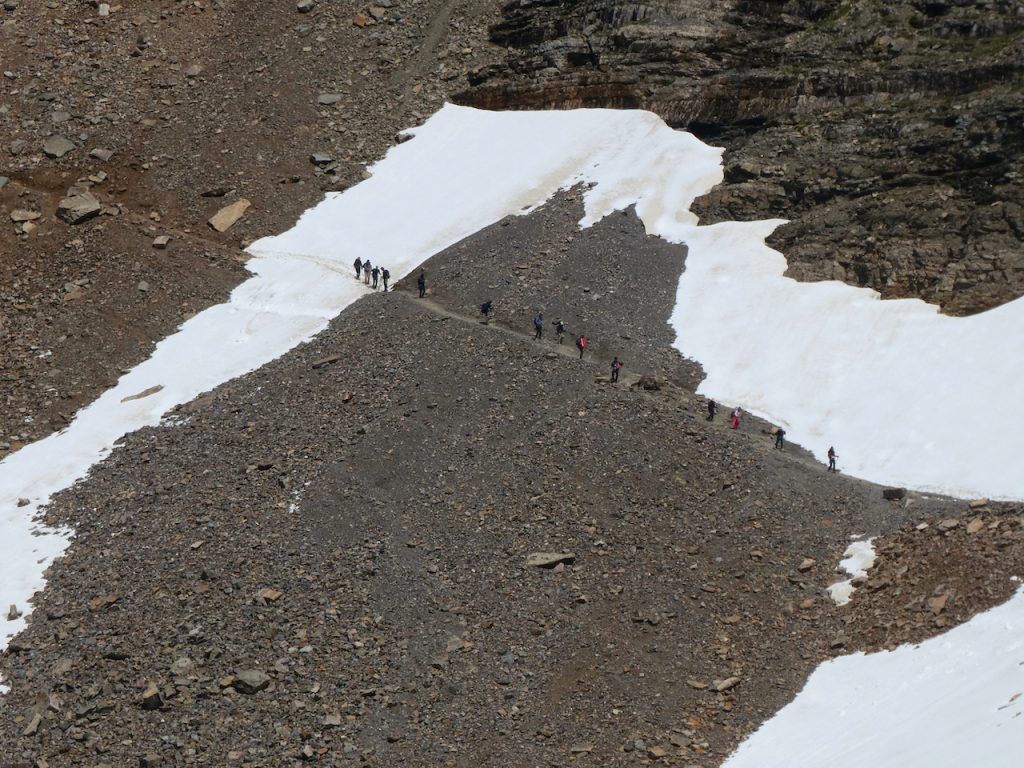
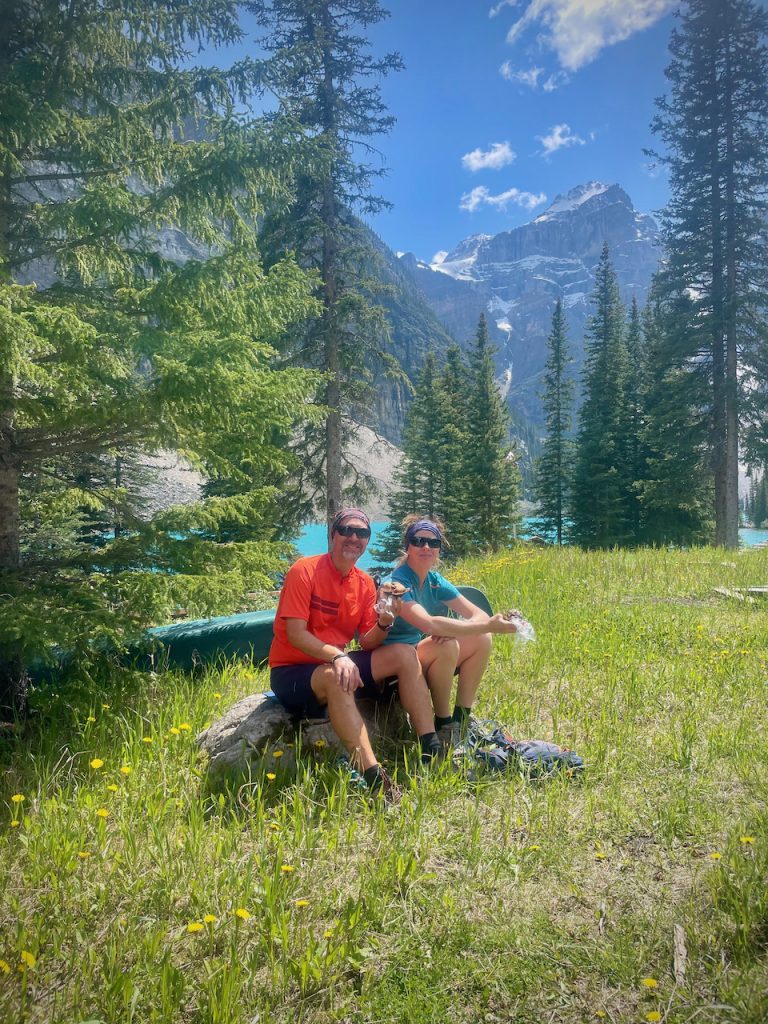
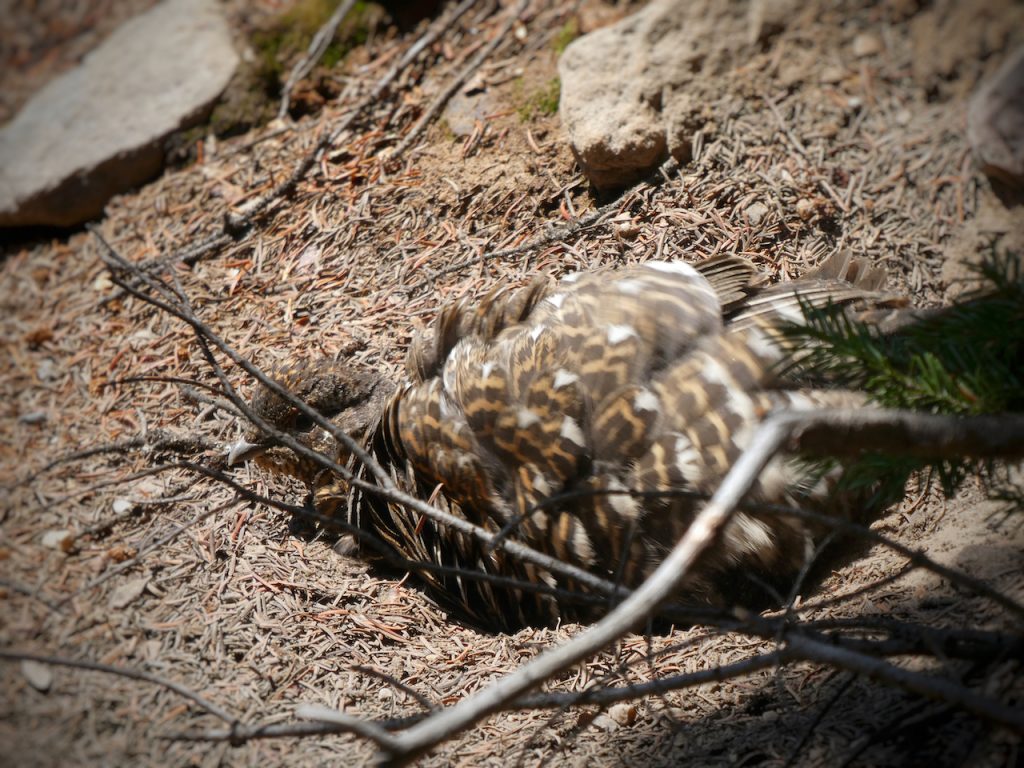
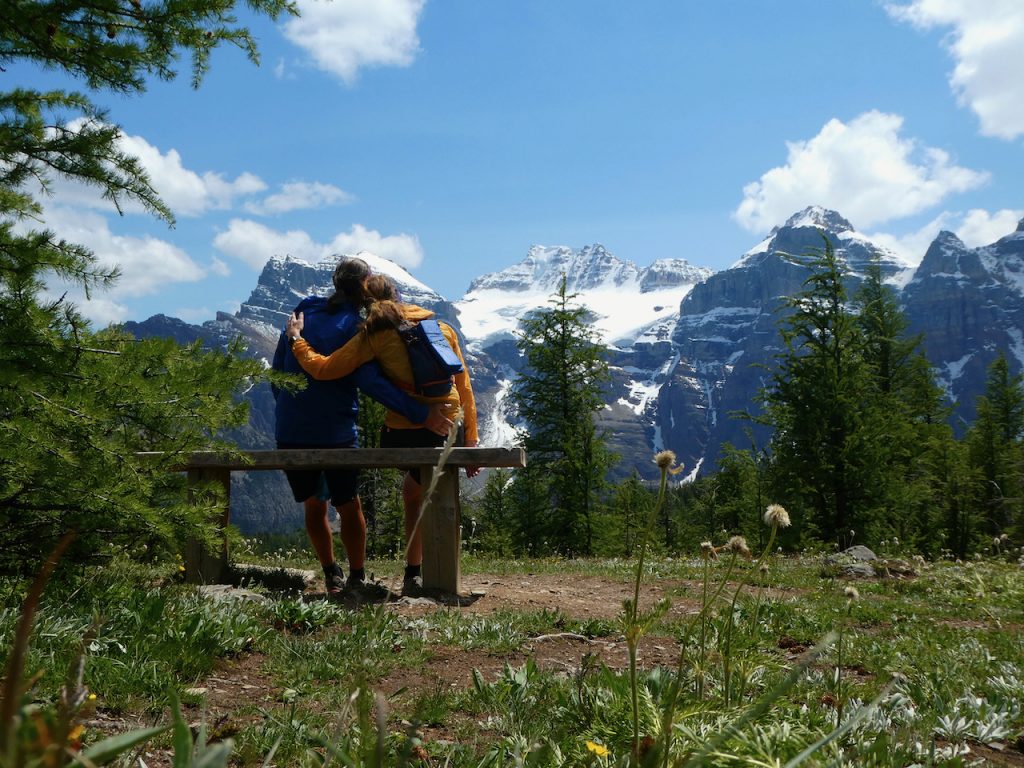
Weiter geht es über den weltberühmten Icefields Parkway, eine in der Tat beeindruckend schöne Strecke durch die Rockies. Ewald rollt zügig über die meist nicht zu steilen Pässe, nur hoch zum Wilcox Pass werden wir mal kurz zum Stauanfang. Wir bremsen am Columbia Icefield an und hier werden wir auch die Nacht verbringen. Gar nicht so schlecht, obwohl es einfach nur ein geteerter Parkplatz ist, jedoch in der Nacht ist es schön ruhig.
We continue on the world-famous Icefields Parkway, a truly impressive route through the Rockies. Ewald rolls quickly over the mostly not too steep mountains, only up to the Wilcox Pass we are the beginning of a traffic jam. We stop at the Columbia Icefield and this is where we spend the night. Not bad at all, although it’s just a paved parking lot, but it’s nice and quiet at night.
Wir wollen noch den Athabasca Gletscher erkunden und packen unsere Ausrüstung ein. Wir finden dann heraus, dass es nur geführt erlaubt ist, auf den Gletscher zu gehen. Ist vielleicht auch besser so, denn sonst würden mit Sicherheit einige mit Turnschuhen drauf gehen. Was wir jedoch überhaupt NICHT verstehen können und auch wirklich nicht gut heißen, sind die Gletscher Fahrten mit diesen Monster 6×6 Bussen. Das ist so eine Sache, die wir überhaupt nicht begreifen können – wir sind hier in einem Nationalpark, da sollten die Gletscher doch geschützt werden und nicht noch befahren werden. Nach jeder Fahrt der schweren Gefährte muss ein Grater die Spur im weichen Eis wieder begradigen. Wir haben Mitgefühl mit dem eh schon sehr geschrumpften, sterbenden Gletscher.
We want to explore the Athabasca Glacier and pack our equipment. We then find out that it is only allowed to go on the glacier with a guide. Maybe it’s better that way, because otherwise some would certainly walk on it with sneakers. However, what we do NOT understand at all and really do not appreciate are the glacier trips with these monster 6×6 tour buses. It’s one of those things that we can’t understand at all – we’re in a national park here, so the glaciers should be protected and shouldn’t be driven on. After each trip of the heavy vehicle, a grater has to straighten the track in the soft ice. We feel sorry for the already very shrunken dying glacier.
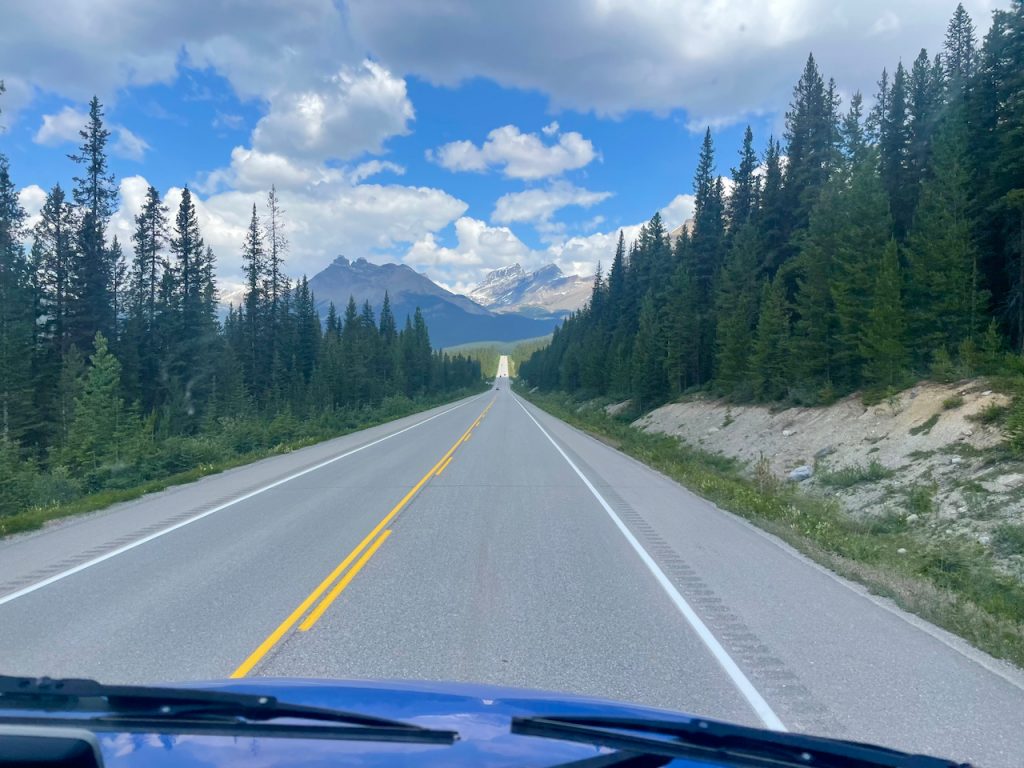
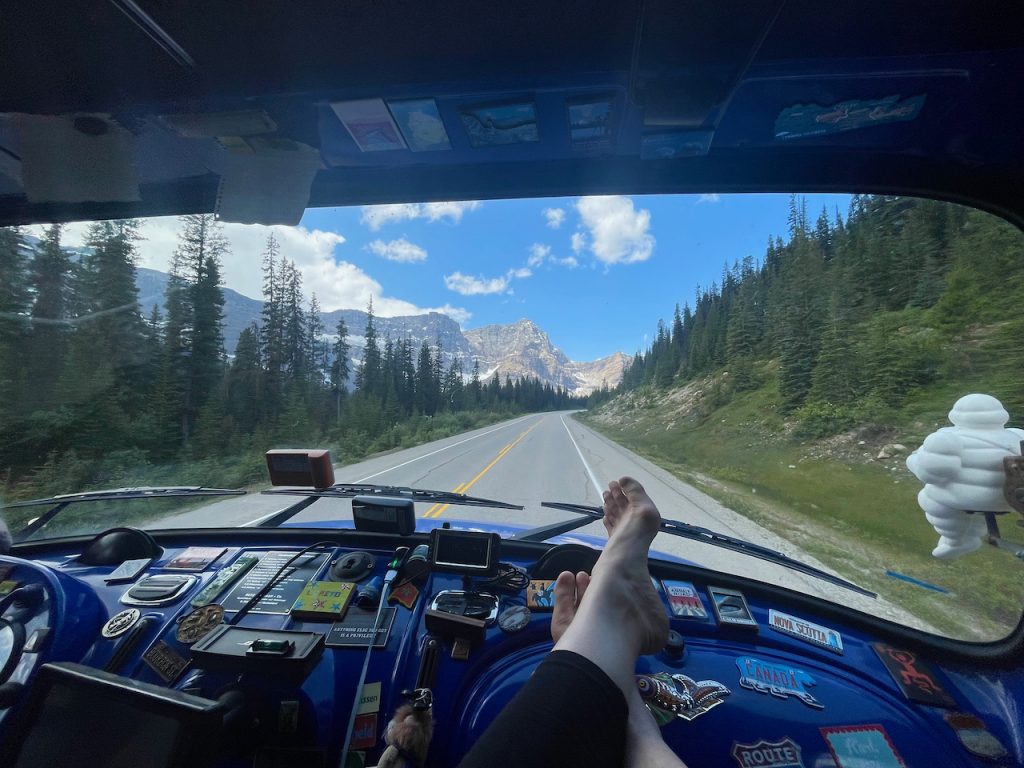
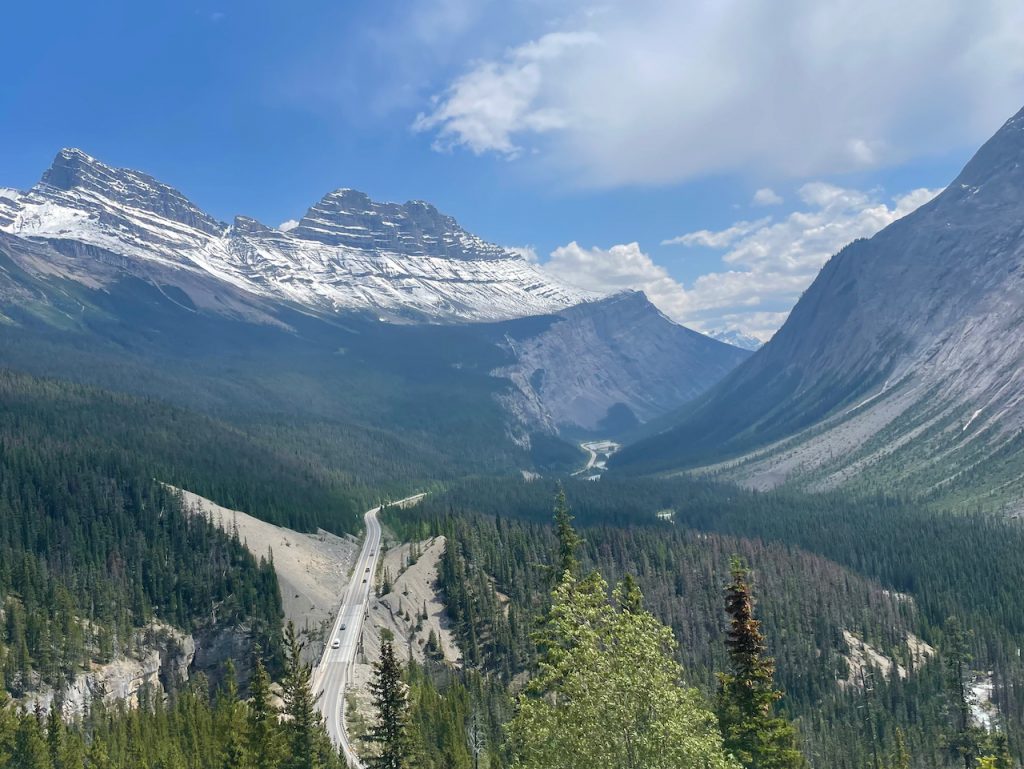
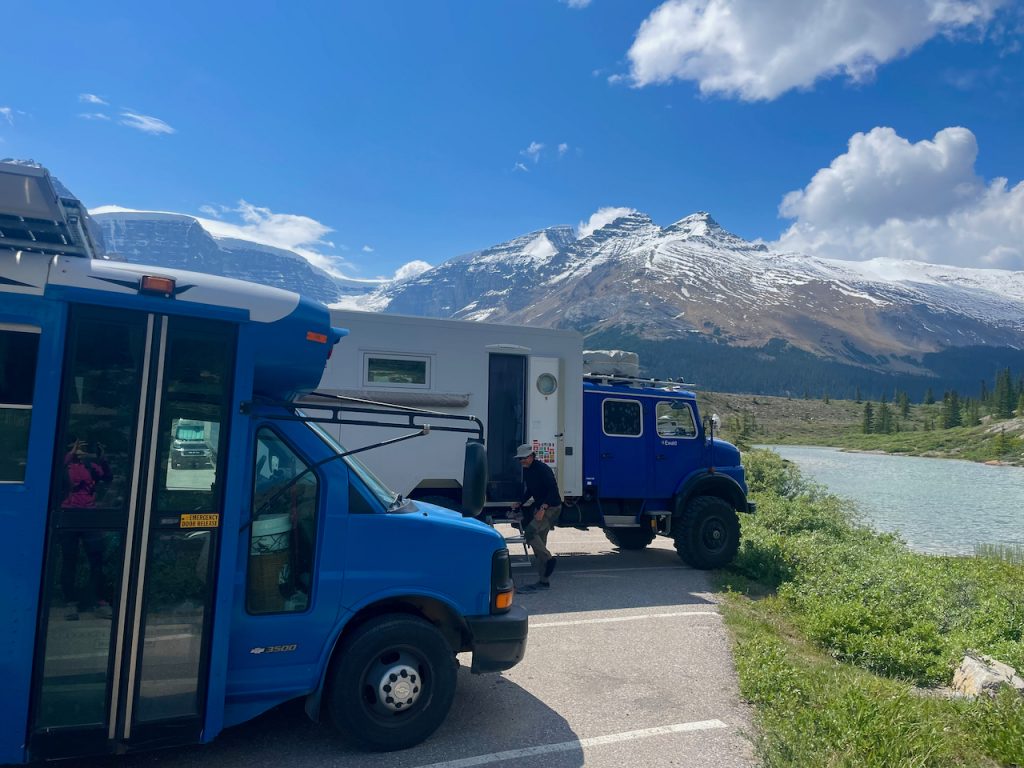
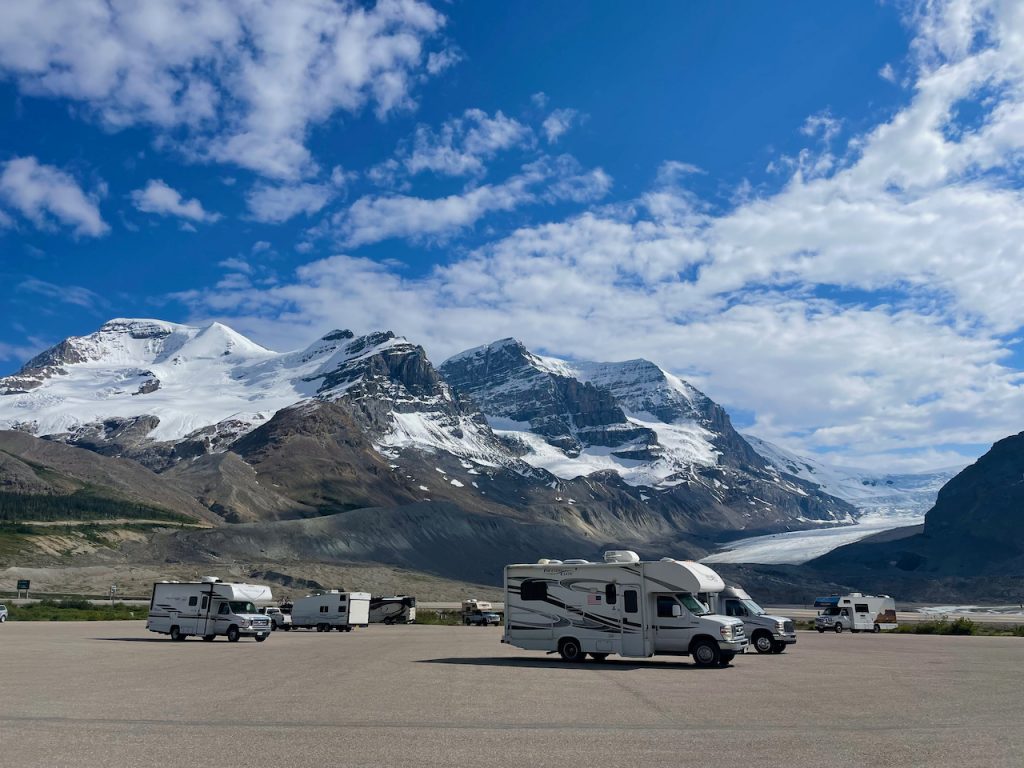
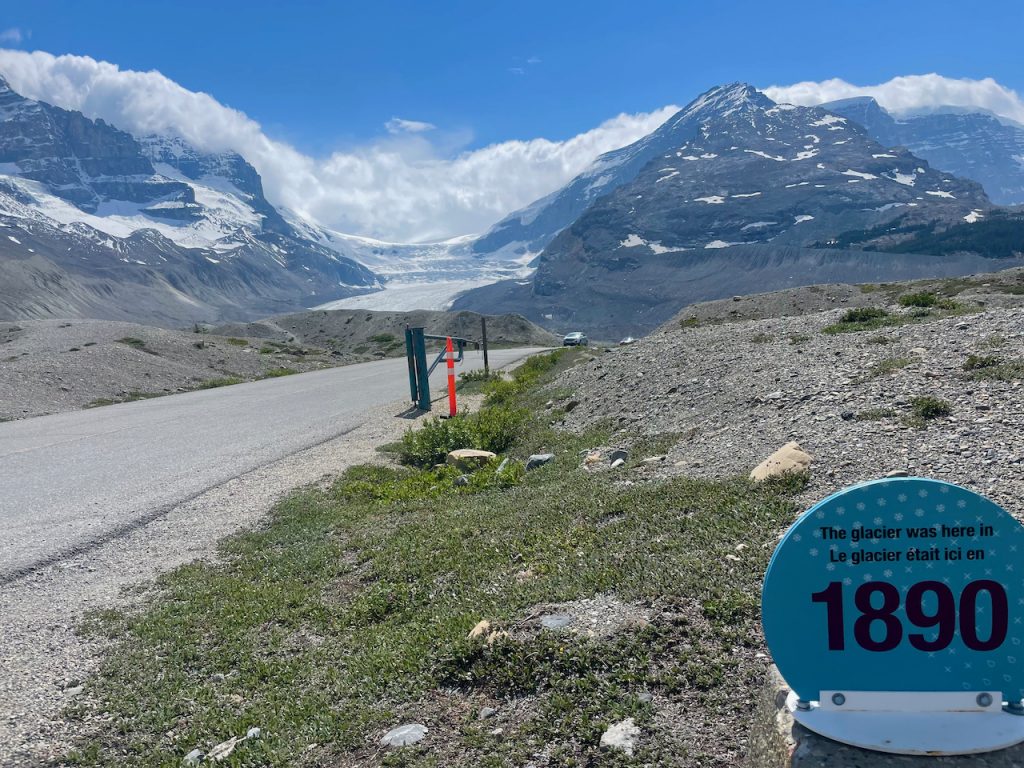
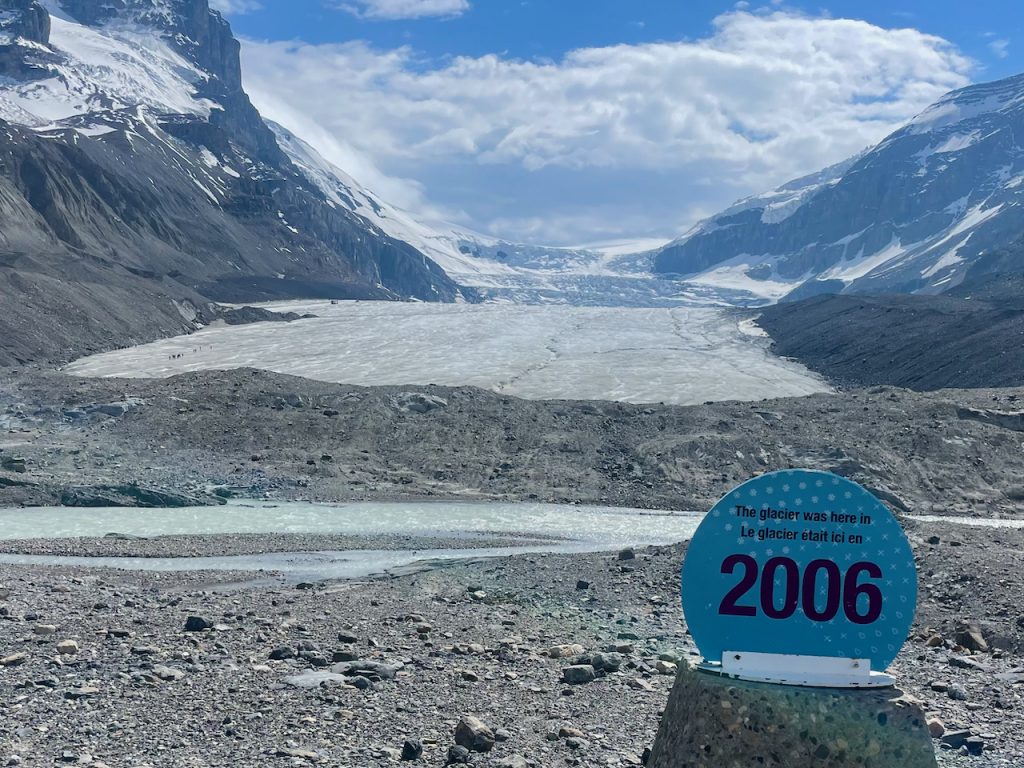
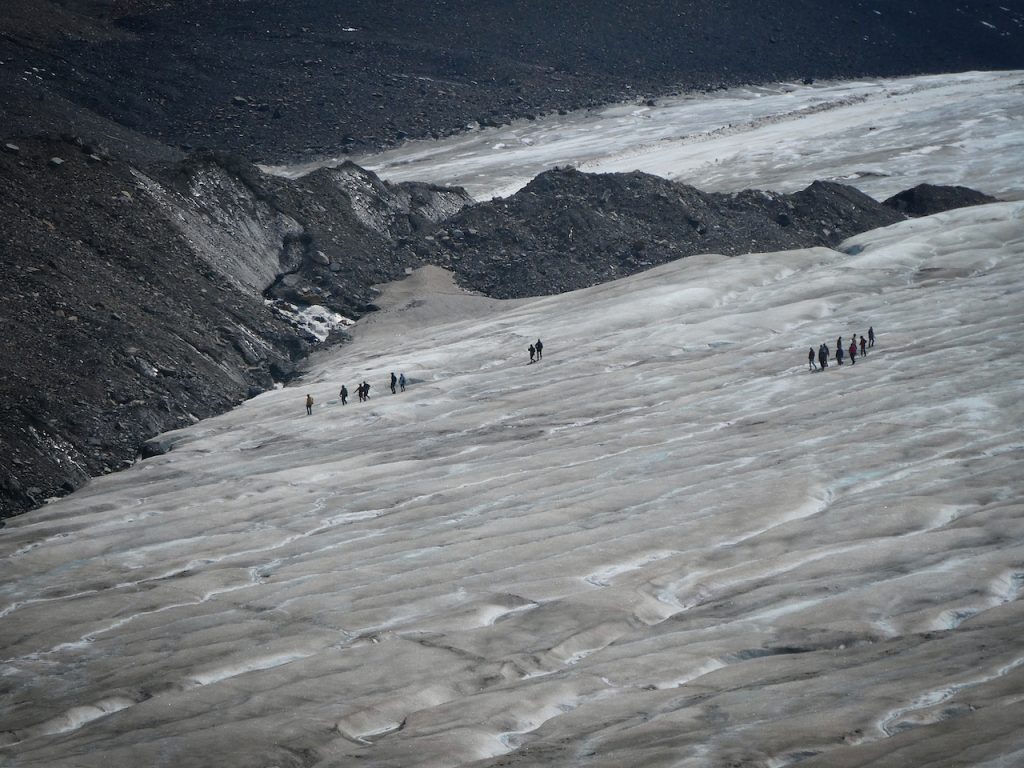
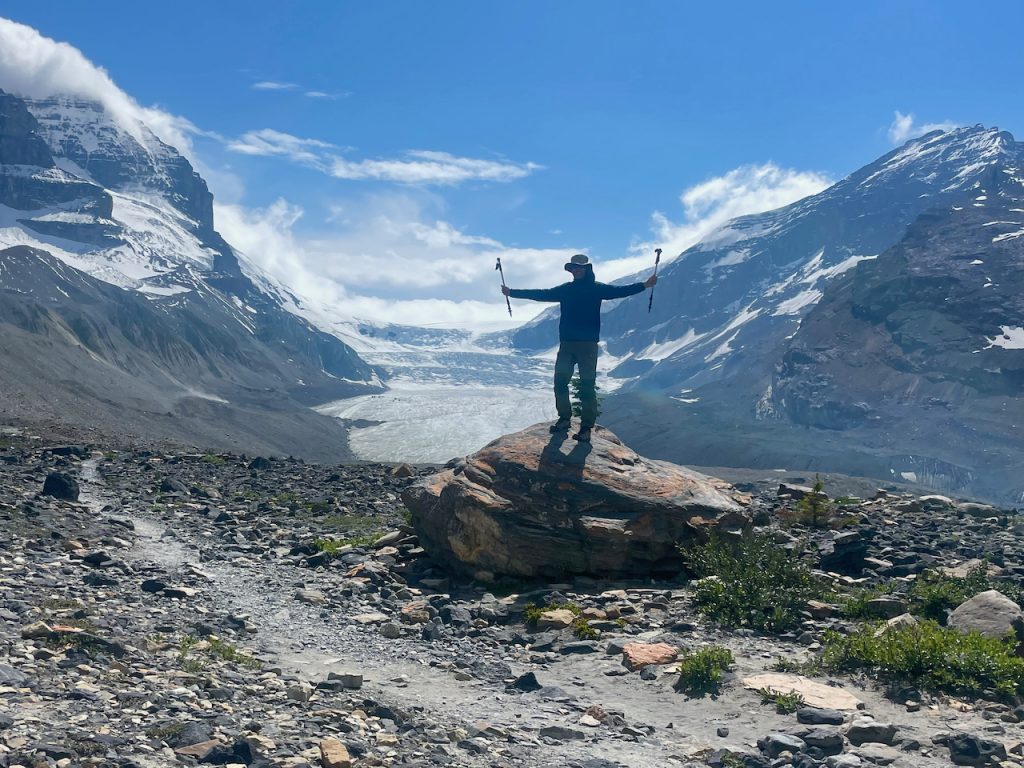
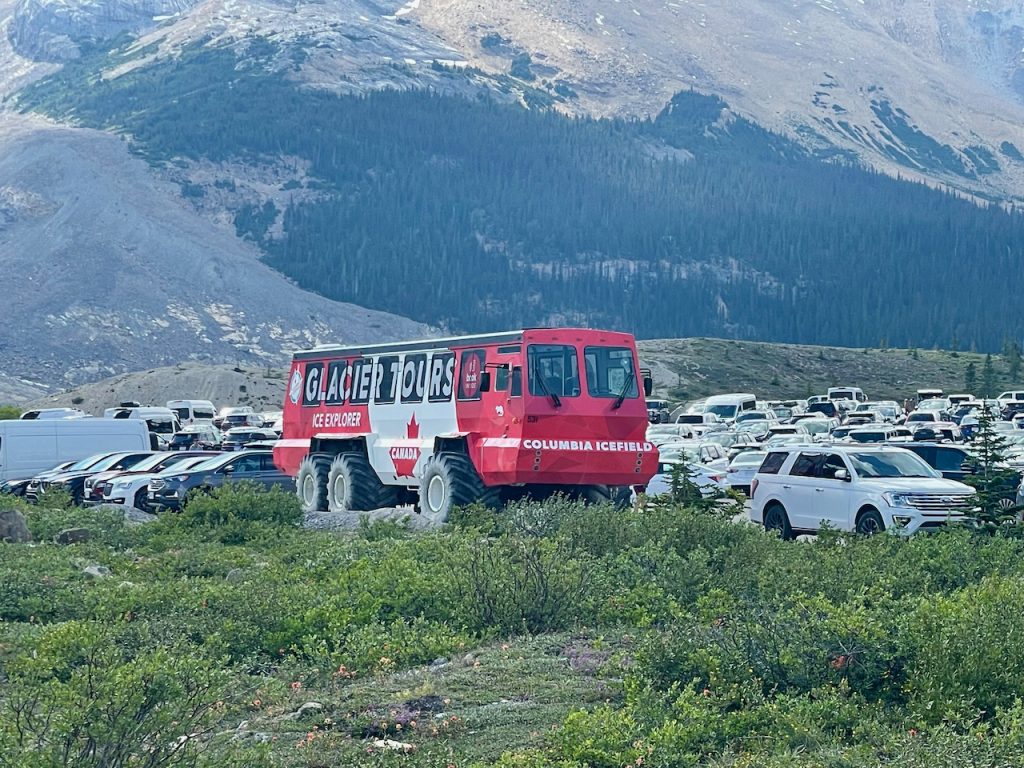
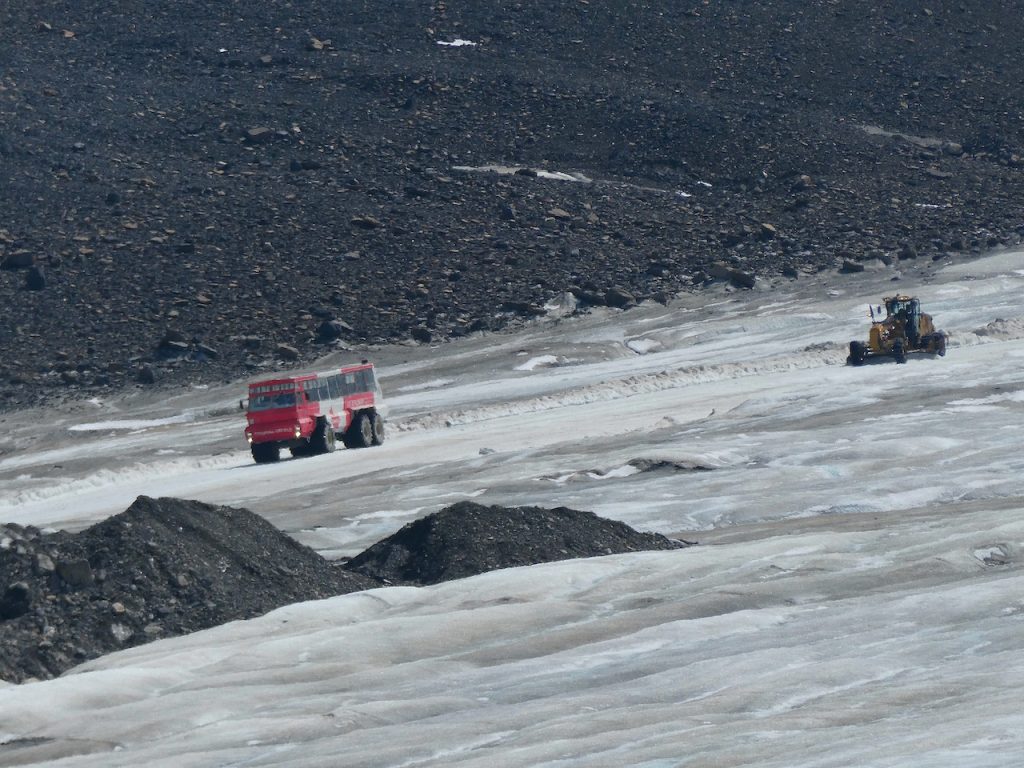
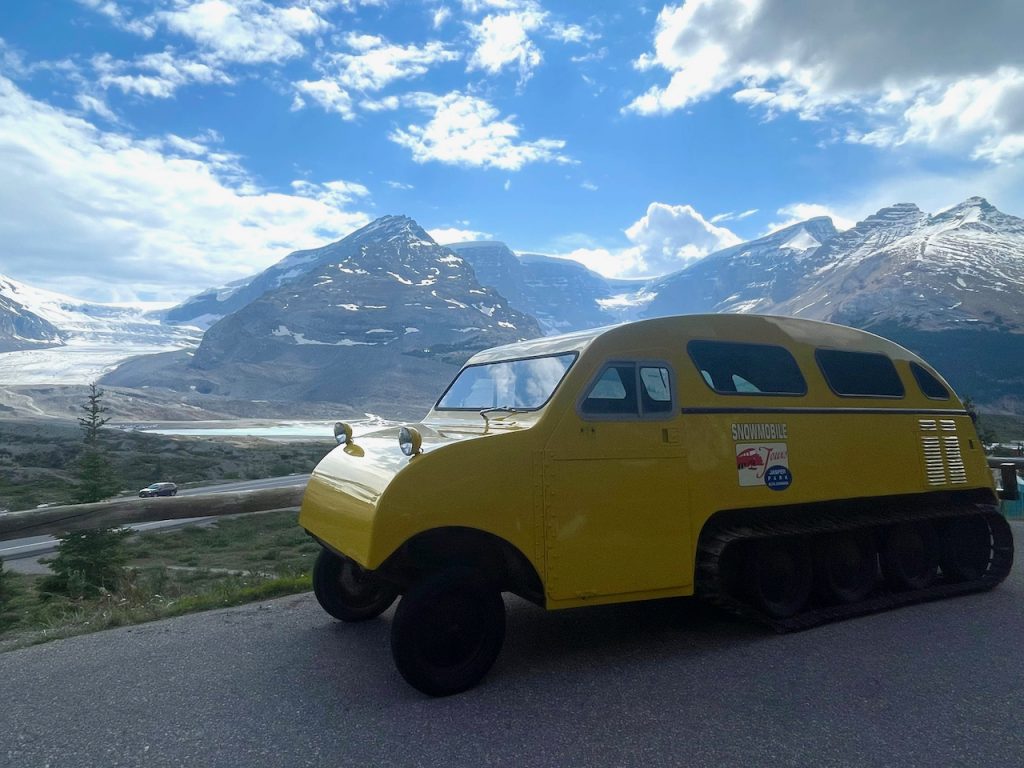
Nun sind wir in Jasper und davon werden wir im nächsten Bericht schreiben. Wir können uns immer besser vorstellen, den ganzen Sommer hier in den Rockies zu verbringen und freuen uns aber auch schon auf die eher untouristischen Gegenden, die wir demnächst erkunden wollen. Mitte Juli werden wir dann mal kurz zur Familie nach Indiana fliegen und dort ein Familien-Treffen feiern. Turbulente Zeiten – gerade davor und danach freuen wir uns auf die Wildnis. Wir halten Euch auf dem Laufenden.
Now we are in Jasper and we will write about that in the next report. It’s getting better and better for us to imagine spending the whole summer here in the Rockies, but we’re also looking forward to the less touristy areas that we want to explore in the near future. In mid-July we will fly to Indiana to visit our family and celebrate a family reunion there. Turbulent times – just before and after we look forward to the wilderness. We will keep you up to date.
Bleibt glücklich, gelassen und gesund.
Stay happy, calm and healthy.

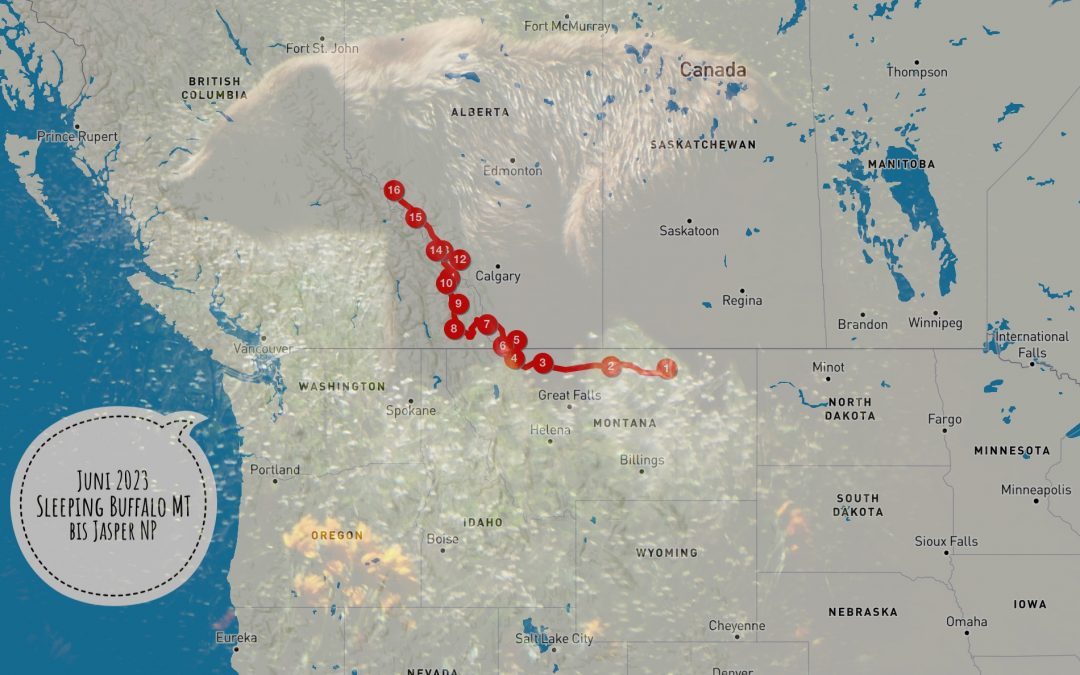
Hallo Ihr Lieben, herrlich – da kommen ganz viele tolle Erinnerungen hoch. Die Gegend ist einfach traumhaft und echt macht Spaß das mit Euch nochmal zu erleben.
Lasst es Euch gut gehen, dickes Bussi von M&P
Hallo Ihr Lieben, es ist schon bewundernswert, wie Ihr es schafft, nach so langer Zeit in der Einsamkeit, immer wieder mit so viel Lust und Engagement von Euren Erlebnissen zu berichten. Sehr schön, weiter so. Liebe Grüße 👩❤️👨